a good reference:
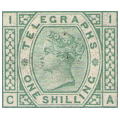
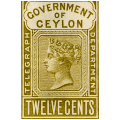
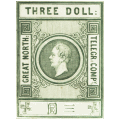

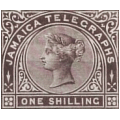
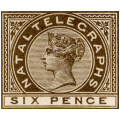
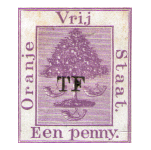
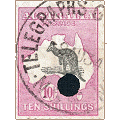
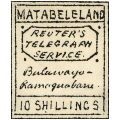
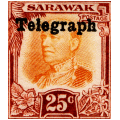
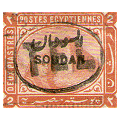
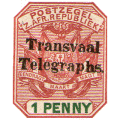
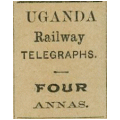
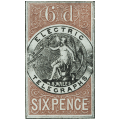
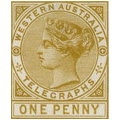
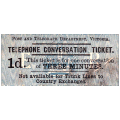
| Up a level | Not my site, but a good reference: |
||||||
 |
 |
 |
 |
 |
 |
 |
 |
| GB | Ceylon | Hong Kong | India | Jamaica | Natal | OFS | Australia and states |
| Up a level | by Dave Elsmore. | ||||||
 |
 |
 |
 |
 |
 |
 |
 |
| Other Africa | Sarawak | Sudan | Transvaal | Uganda | New South Wales | Western Australia | Other Australia |
I have brought these prices up to date and added currency selection. New designations have 'RH' numbers (Revised Hiscocks) to avoid confusion. CheckList Setup |
| Shortcuts to different sections | ||||||
| Control Letters. | Map | Great Northern Stationery | Wireless Telegraph | Cable & Wireless | Notes | Chinese Telegraph Forms |
Steve Hiscocks wrote of the Great Northern Telegraph Company :
The above company is in fact Danish but the stamps listed below were intended for use on lines linking Hong Kong, Shanghai (China) and Nagasaki (Japan).
According to one source a link with Europe was also intended. The stamps appear not to have been used although the company has in its archives
an unused account book entitled "Accounts of Telegraph Stamps at the Great Northern Telegraph Station at Amoy" which would suggest that all
preparations had been made. The book is arranged to keep account of the four values listed below. The assignment of these stamps to Hong Kong
is traditional and corresponds to the currency used on the stamps but is somewhat arbitrary.
The stamps were printed from copper plates, probably by Waterlow and Sons (UK) and depict Professor H. C. Ørsted — the Danish pioneer of
electromagnetism. The four values have been observed in various states and shades listed below. Their date is usually quoted as 1877 but they were
clearly earlier since a letter of March 1875 in the company archives refers to them as already printed. A date of 1874(?) has been assumed pending
further information. Curiously, forged copies of these stamps are known.
One can deduce a possible total printing from the control letters. Those known are 25c-'L', $1-'A', #3-'F' and $10-'C'. 'B' has also been reported
but for which value is unstated. Each series was reported to be numbered from 0001 to 2,500. This gives us a minimum printing of 12,500 for all
values, or, if we assume that all letters were used up to 'L', 30,000. The stamps should, in that case be much more common than they appear to be.
The stamps are known imperforate (without controls) both with and without small punched holes in groups of seven.
My notes:
According to Di plo, in 1876 China's first telegraph school was opened, and in 1881 the government established the Imperial Chinese Telegraph Administration
(see the seal at the bottom of the page).
A link with Europe could easily have been by a connection with the Russian rail network at Harbin, or via the Eastern Extension Telegraph Co. at Hongkong or Shanghai.
The Great Northern and Eastern Extension both had offices on the Bund in Shanghai.
Amoy is the old Hokkien name for what is now Xiamen (厦门) on the southeast coast of China opposite Taiwan.
Hong Kong was connected to Singapore via Saigon by submarine cable in 1871. They were part of the Eastern Extension network.
It would be interesting to know how to recognize these forgeries, anyone know? Anyone have images?
I have added three more control letters to the list (see below). Still no letter 'B' though.
Great Northern Telegraph Company.
This was a Danish company, founded June 1869, using lines linking Hong Kong, Xiamen(Amoy), Shanghai(China), Nagasaki(Japan) and
Busan (Korea then under Japanese control).
They also won a contract with the Russians to connect to Vladivostok. A link with Europe may also have been planned.
More information and an image of a sheet of $1 stamps and 1880 forms, can be seen at GreatNorthern.
An apparently unbiased account of telegraphic development in China can be found (in Chinese) below http://forum.home.news.cn (comment 32 onwards).
This gives Tongzhi dates that start when the Tongzhi Emperor began his reign in 1861.
The Chinese Government now retrospectively considers this to have been an act of aggression (see sogou.com)
In 1961, by agreement of all parties, the assets of The Great Northern Telegraph Company in Shanghai were transferred to the
Shanghai Post and Telecommunications Authority for 100,000 yuan. The assets included buildings, communications equipment and archives.
The stamps depict the Danish professor Hans Christian Oersted (pioneer of electromagnetism).
Printed by Waterlow & Sons on white wove paper. The head is embossed. No watermark, perf. 11½.
Printed in sheets of 25 (5 x 5).
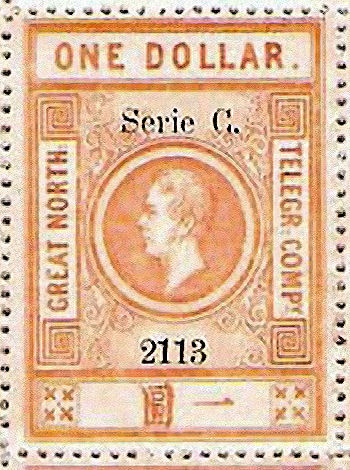 |
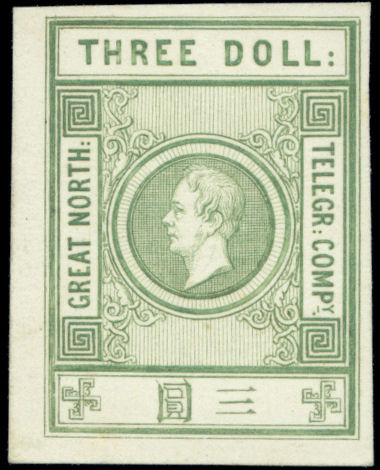 |
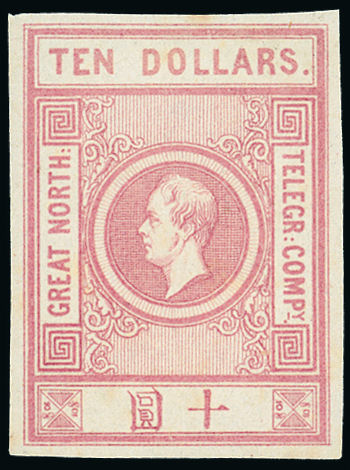 |
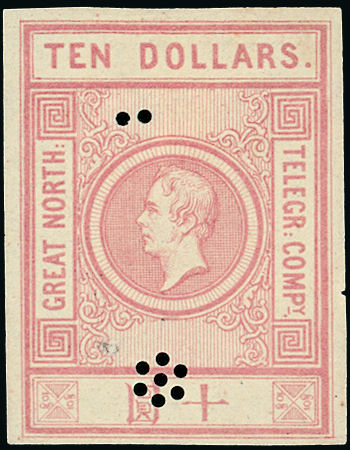 |
| H2 | H3a | H4a | H4b |
| Courtesy of John-Tofte Joergensen. | Courtesy of Grosvenor Auctions. | ||
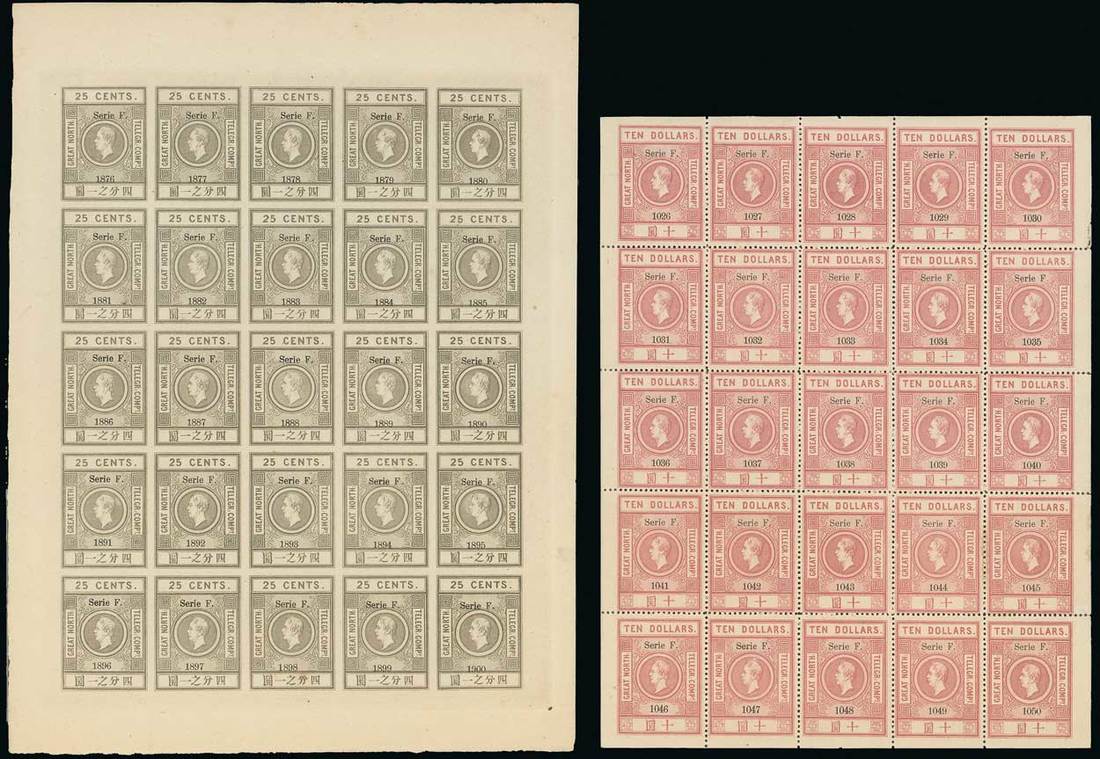
An imperforate sheet of the 25c Series F and a perforated $10 Series F, courtesy of Spink and Son.
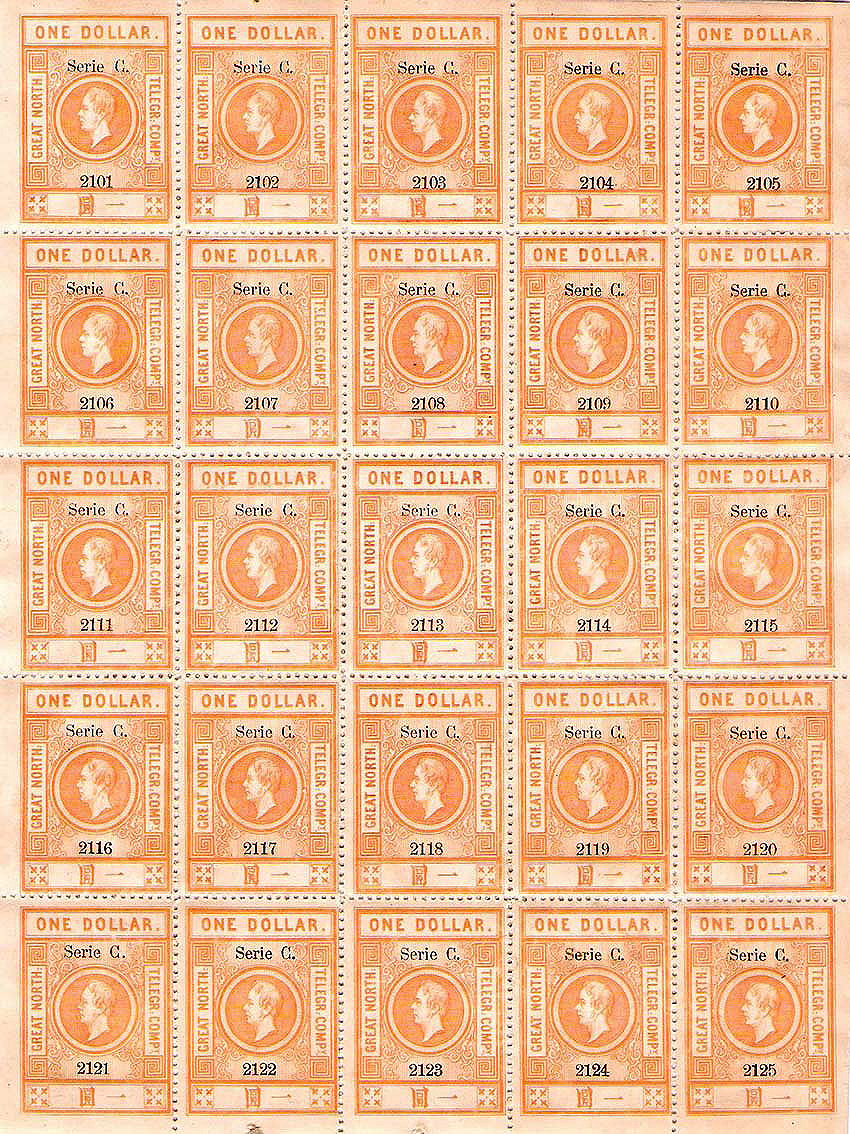
A sheet of the $1 Series C, as seen at GreatNorthern, courtesy of John-Tofte Joergensen.
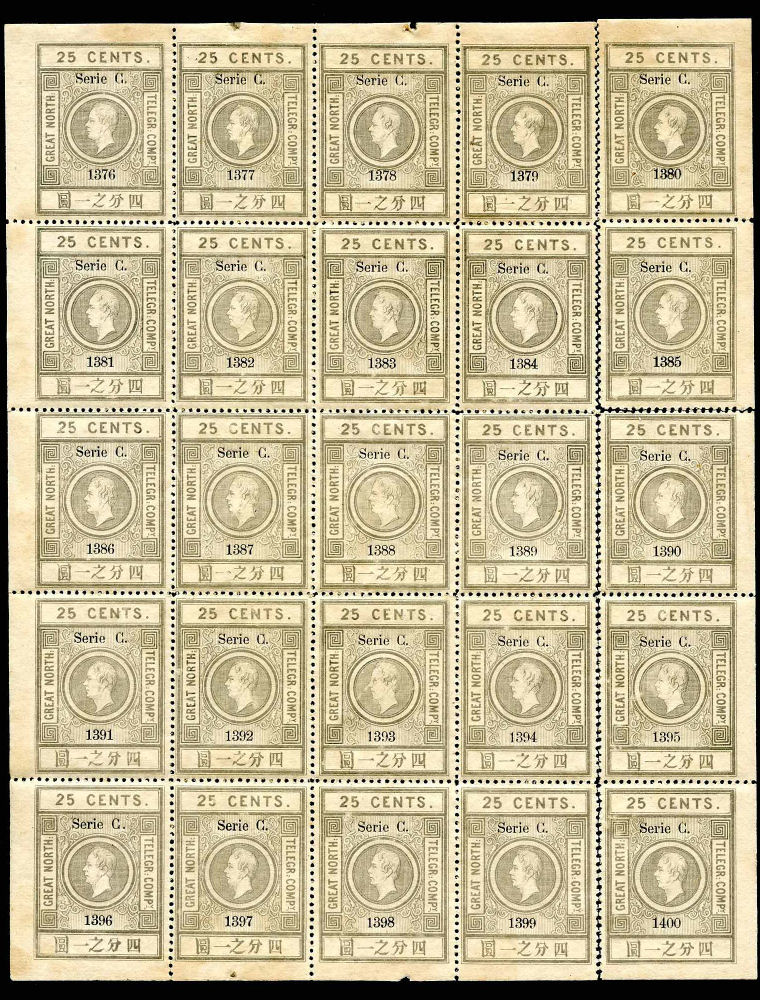 |
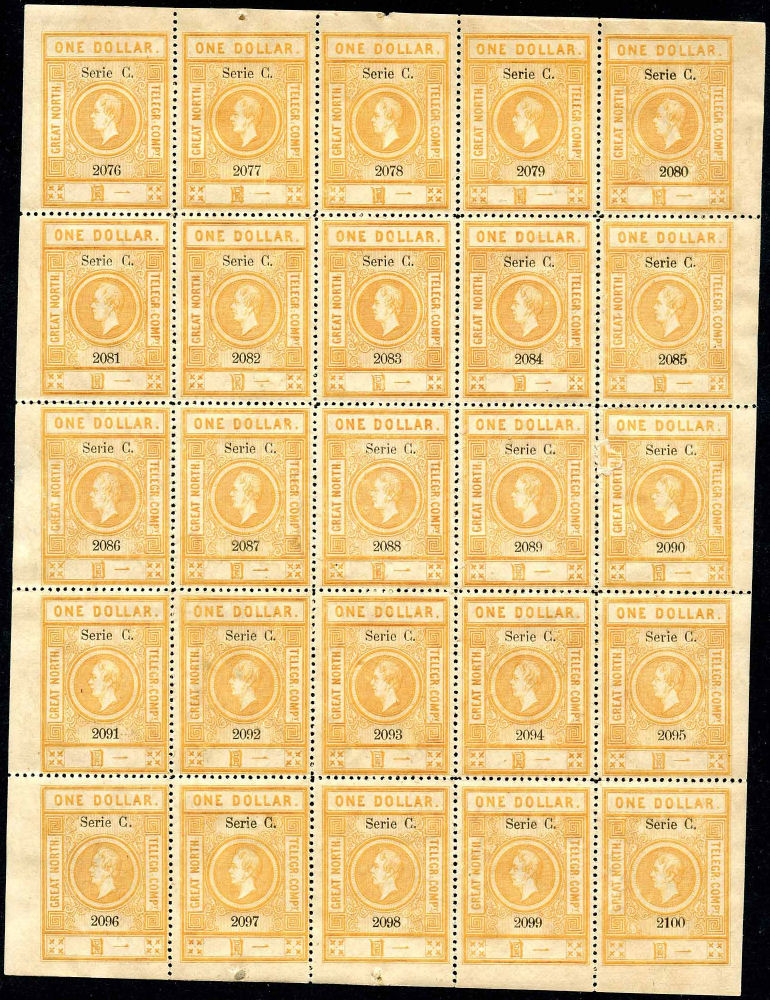 |
| A sheet of 25c Series C, (H1) courtesy of Ray Petersen - Click image for larger version. | A sheet of $1 Series C, (H2) courtesy of Ray Petersen - Click image for larger version. |
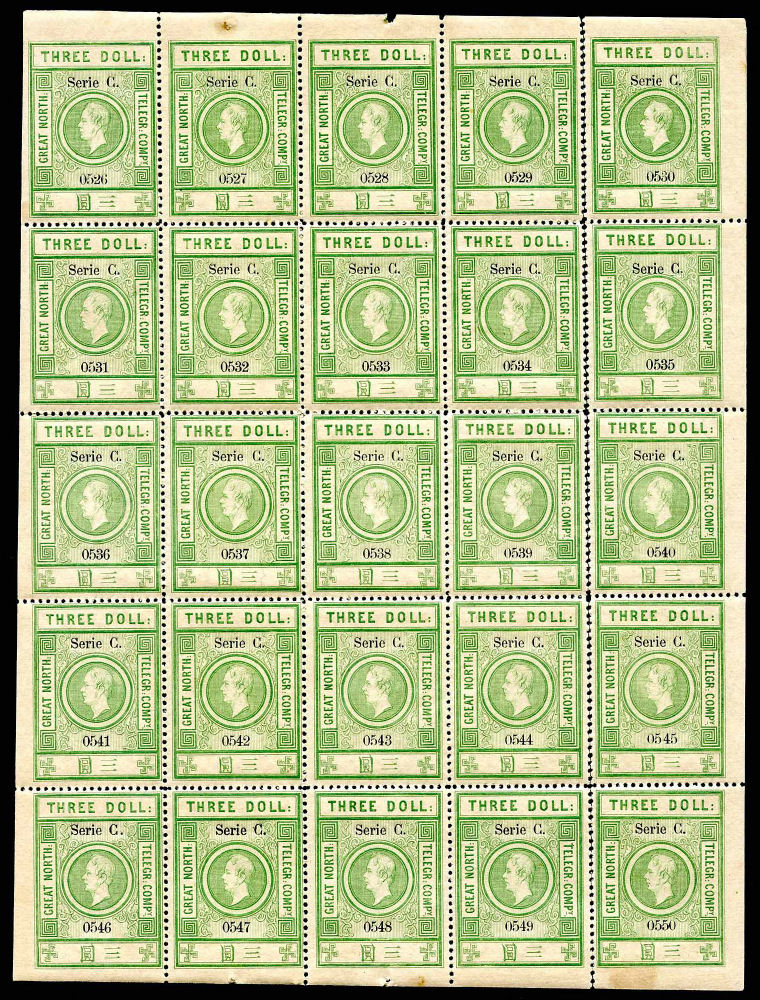 |
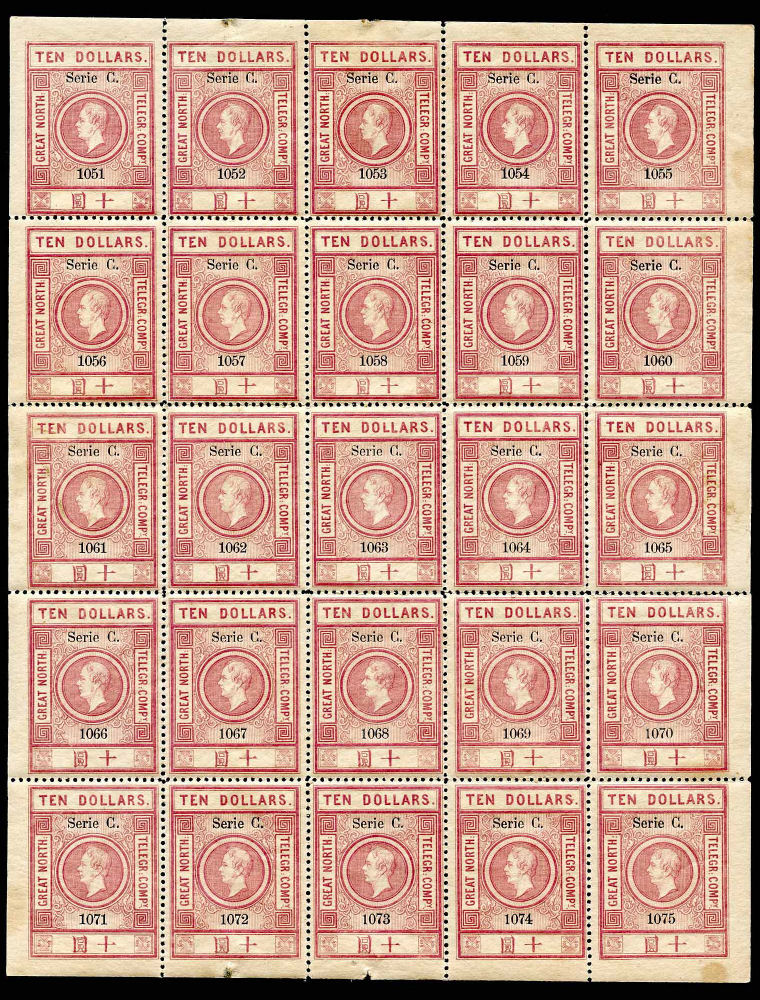 |
| A sheet of $3 Series C, (H3) courtesy of Ray Petersen - Click image for larger version. | A sheet of $10 Series C, (H4) courtesy of Ray Petersen - Click image for larger version. |
The Argyll Elkin sale of March 2021 sale had a couple of lots containing these items, Lot 1101 and Lot 1102.
The examples illustrated comprised the following:
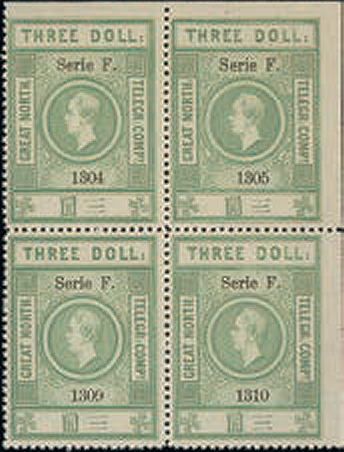
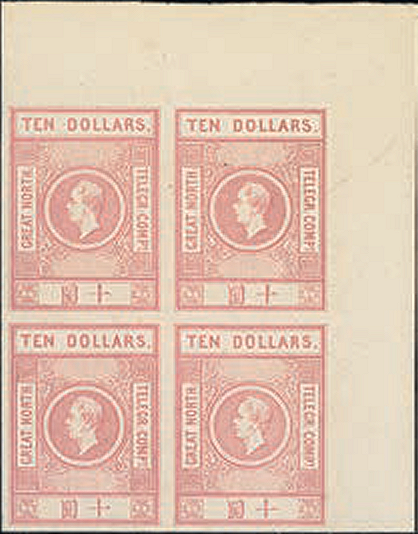
Blocks of four of $3, H3 Series F and imperf. $10 H4a, courtesy of Argyll Elkin.

Marginal imperf. singles, 25c series F (H1c), #1 (H2a), $3 (H3a) and $10 (H4a), courtesy of Argyll Elkin.

Marginal singles, Series F of 25c (H1), $1 (H2), $3 (H3) and $10 (H4), courtesy of Argyll Elkin.
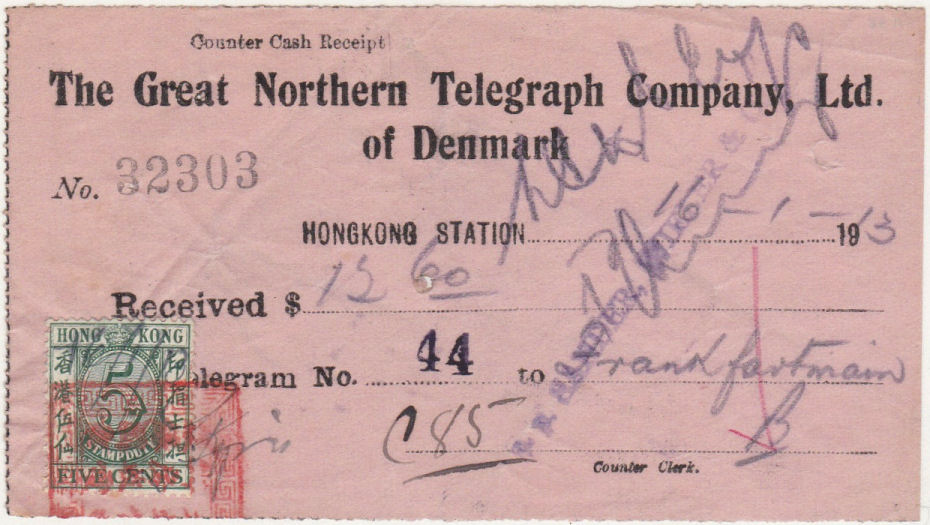
Great Northern Receipt for $12.60 used in Hong Kong 16 January 1913. This ha a 5c Stamp Duty stamp to cover a receipt tax.
This was eBay lot 303146429895 (May 2019). If this is yours, please get in contact.
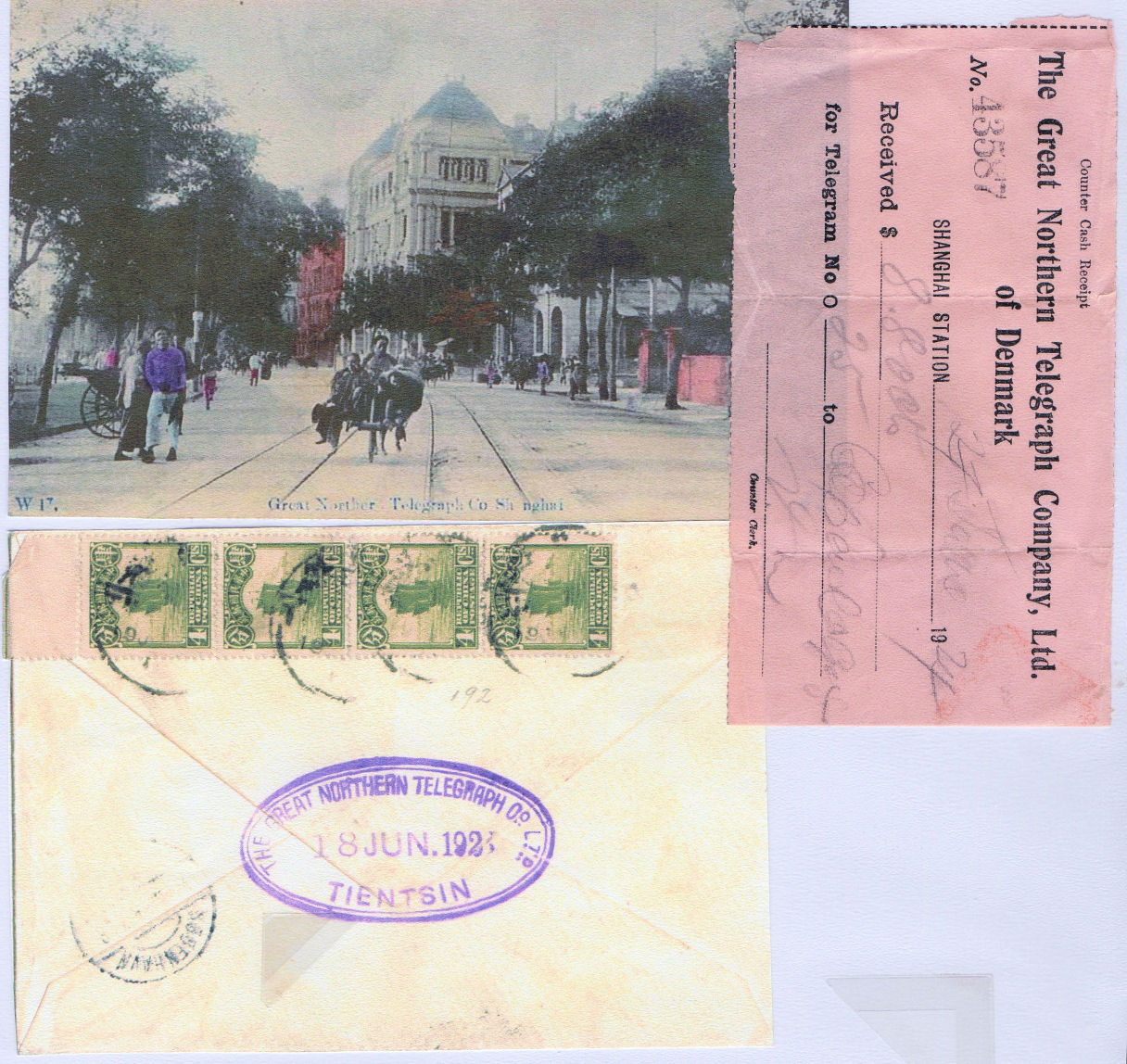
The above shows a number of items related to the Great Northern in China. The top is a hand coloured postcard showing their office in Shanghai. It looks like the north end of the Bund, with the river over to the left.
Top-right is a Shanghai Counter Cash Receipt for 1924. At the bottom is the back of an envelope with a Great Northern, Tientsin (was Tianjin, 7) cachet, 16c worth of stamps, and a backstamp for KØBENHAVN.
The Bund is still the heart of the Financial District. Image courtesy of Les Bottomley.
Great Northern telegram received at Hong Kong from Portland, Maine, U.S.A.
The imprint at top-left reads "Hk. C. 1027 (1925—500,000) Ldn." which I take to imply 500,000 printed in 1925, perhaps in London.
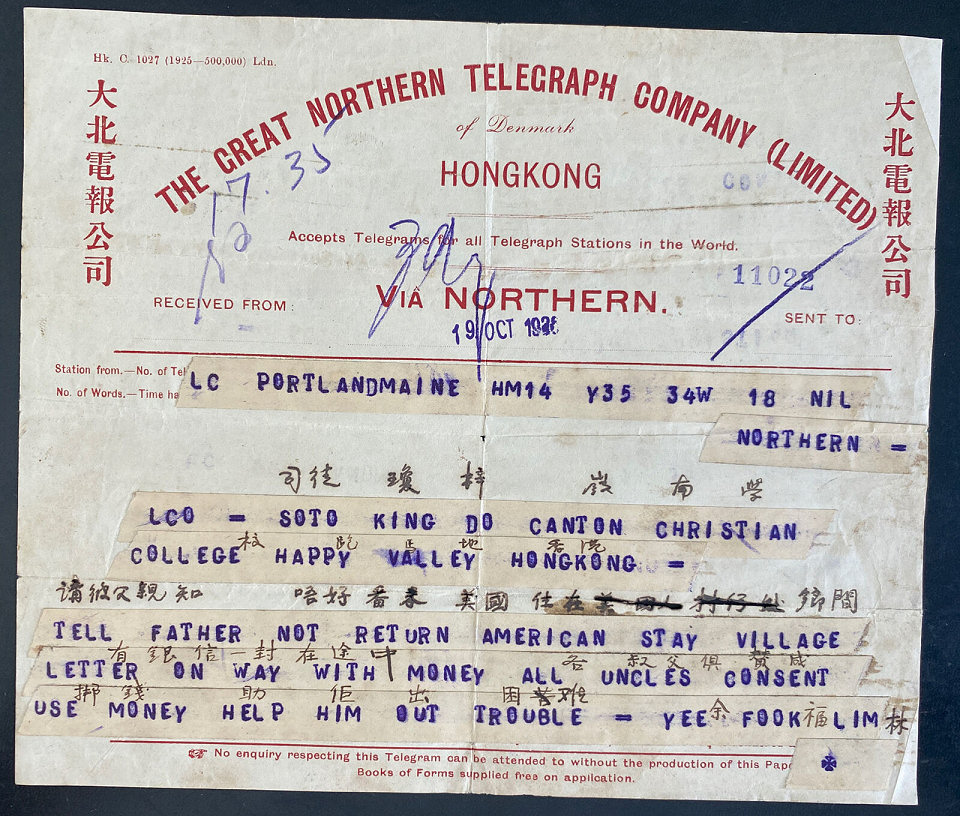
This was sent in English with Chinese translation added by hand. Photo courtesy of Aztec Collectables, click on it for the listing.
Given the size of China, wireless telegraph must have been important from early days.
Helpfully, the U.S. Department of the Navy provided listings of (known) Wireless Telegraph Stations of the World, for at least 1906 to 1912 every 2 years.
They list many aboard ships as well as land-based stations.
| 1906 | 1908 | 1910 | 1912 |
|---|---|---|---|
| Italian Government: Marconi at embassy in Beijing(北京), and Tientsin(天津). Arnhold, Karberg & Co (Banking): Telefunken, two at Shanghai(上海) and one at Canton (广州城). ?: Station at Taku(大沽, near Tientsin.). No other information. |
Chinese Government: Telefunken at Hoihow(霍霍), Chu weu(朱伟), Canton, and Kongman(孔曼). Telefunken: Telefunken at Shanghai. German Navy: Telefunken at Tsingtau(青岛市), Kiaotschou(九寨沟). Italian Government: Marconi at embassy in Beijing, and Tientsin. Projected Japanese Teishinsho at Tai Lien Wan (Dalian Bay, 大连湾). |
Chinese Government: Hoihow, Chu weu, Canton, and Kongmoon (孔月). Commercial at Shanghai. German Government: Tsingtau, Kiaotschou. Italian Government: Embassy in Beijing, and Tientsin. Japanese Government: Tai Lien Wan. |
Chinese Government: Hoihow, Chu weu, Canton, Kongmoon, and Shanghai. Commercial at Shanghai. German Government: Tsingtau, Kiaotschou. Italian Government: Embassy in Beijing, and Tientsin. Japanese Government: Tai Lien Wan. |
Separately, Hong Kong is listed for all those years as having a British Admiralty station at Cape d'Aguilar(Island East).
A later form used 31 August 1939, but now Cable & Wireless, associated with "The Eastern Extension Australia & China Telegraph Co. Ltd"
The imprint at top-left reads "No. 31 (1939-800) Hk." which I take to imply 800 pads printed in 1939.
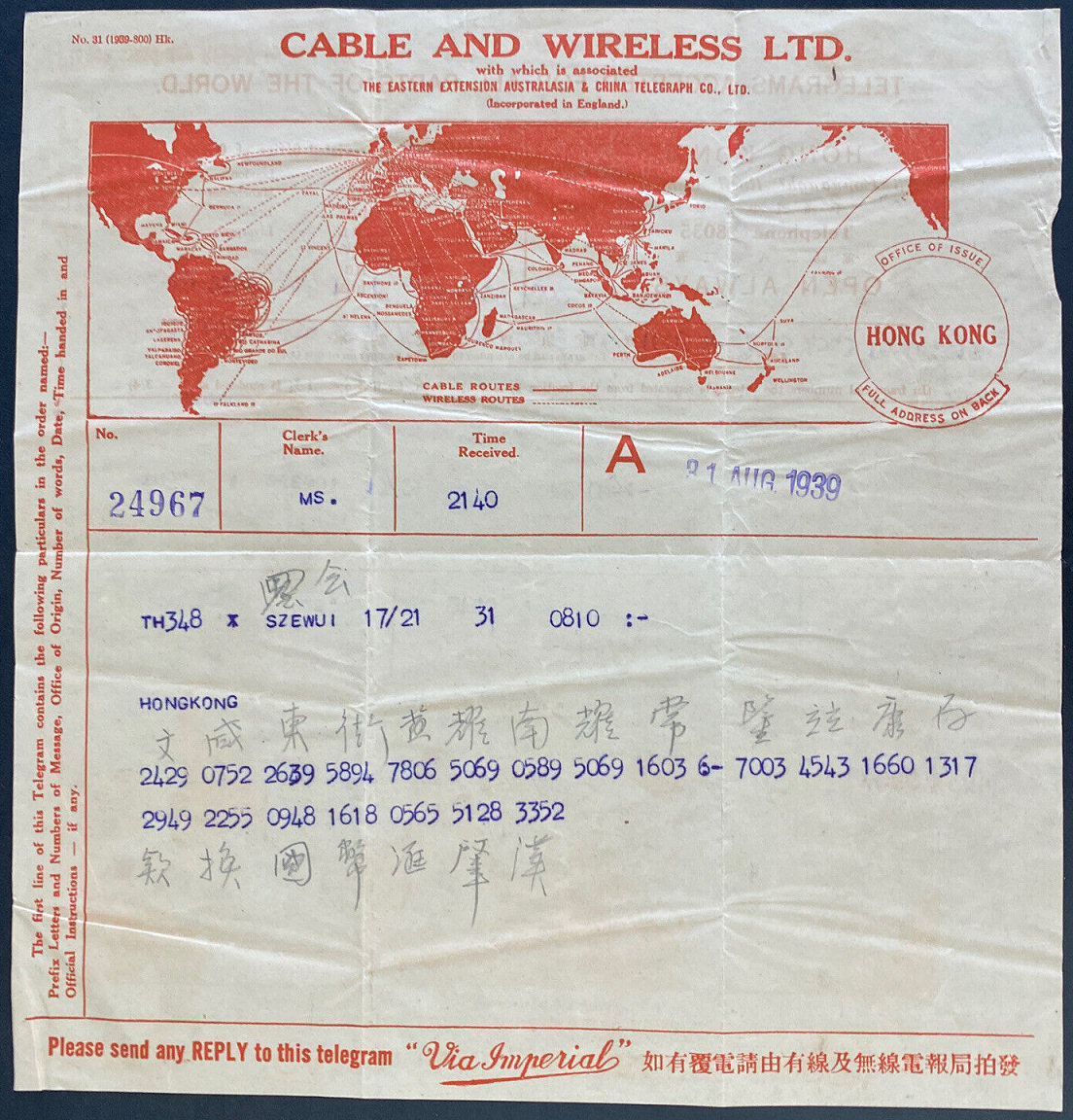
This was sent as 4-digit codes from Guangdong(formerly called Szewui), with Chinese translation added by hand.
Photo courtesy of Aztec Collectables, click on it for the listing.
A later form used 20 September 1947, but now with a Cable & Wireless logo and printed in England.
The imprint at top-left reads simply "Nov. 1945. (3,000 pads)." which is pretty self-explanatory.
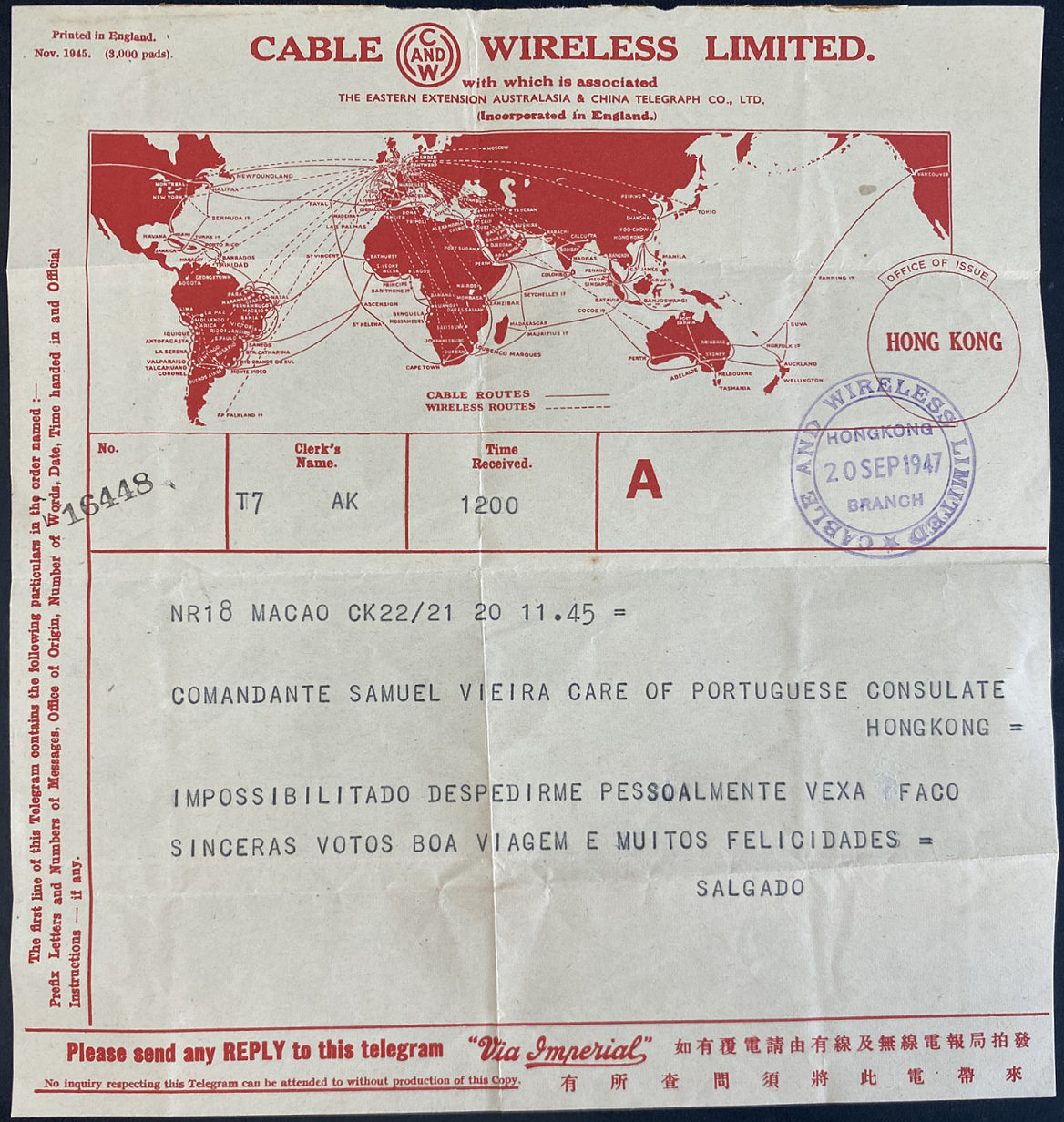
This was sent in Portuguese from nearby Macau. The bottom now has a Chinese translation of the text.
Photo courtesy of Aztec Collectables, click on it for the listing.
A later form used 20 October 1949, but without Cable & Wireless logo and clearly marked "Via Imperial".
The imprint at top-left now reads "No. 39. 1949. (4,000 pads)". It has an explanation of the first line of the telegram.
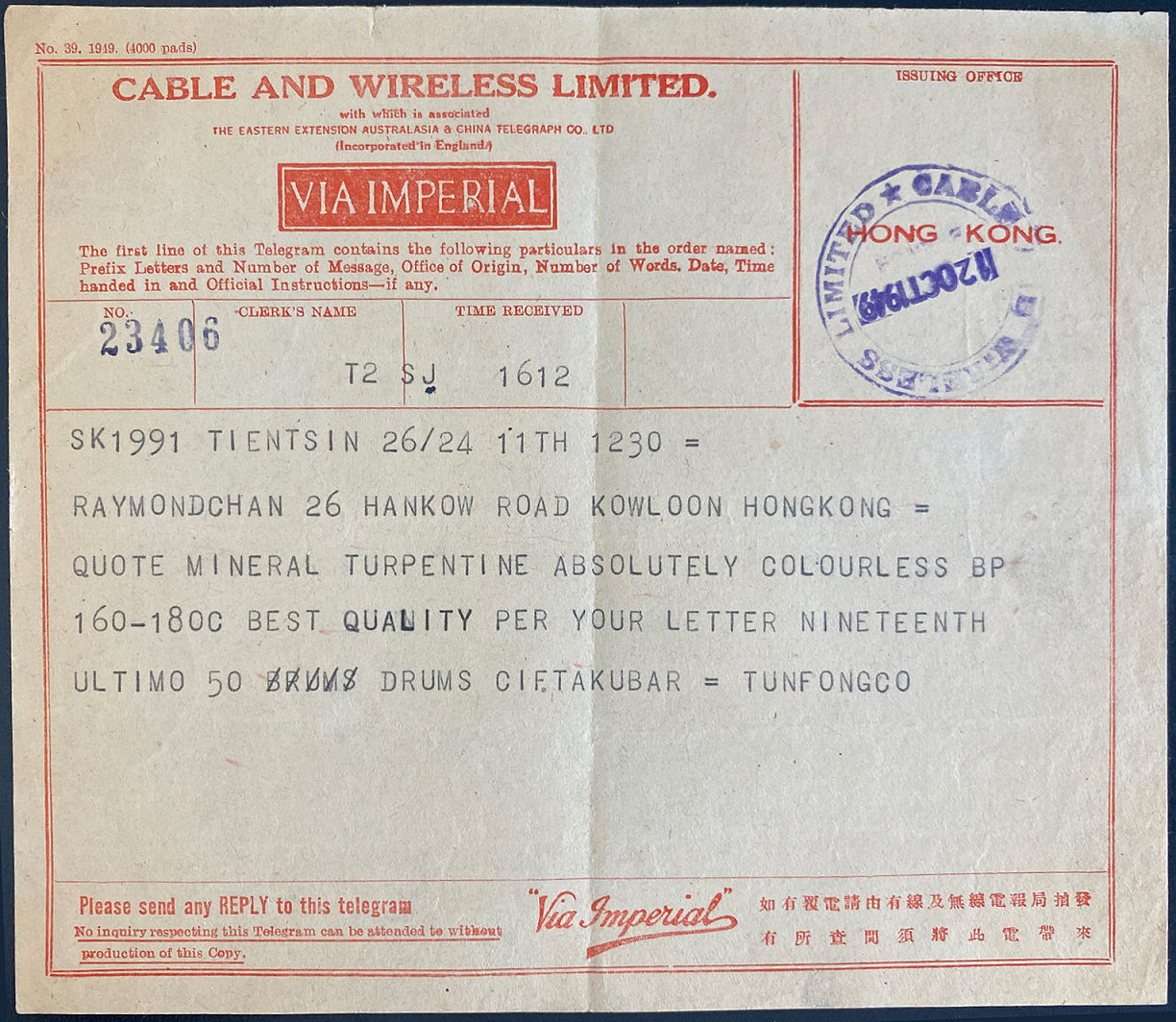
This was sent from Tientsin to Kowloon, Hongkong. The bottom still has a Chinese translation of the text.
Photo courtesy of Aztec Collectables, click on it for the listing.
The British Post Office Circular(PDF) of May 13, 1878 says under "Telegrams for Foochow":
'Notice has been received that a special courier service has been established between Amoy and Foochow for the conveyance of telegrams between those places.
The courier will leave Amoy at 2 p.m. every day, and Foochow at the same hour, taking about 45 hours to perform the journey. Telegrams for Foochow to be sent by
courier from Amoy must contain the words "Foochow courier Amoy", in the address, and must be charged 1s 8d. each, in addition to the rate to Amoy.'
| Wiki has an overview of Telecommunications in China. Below there is a machine translation of a mainland Chinese article on the subject (from the google output of this URL) : As early as 1871, the Danish Great Northern Telegraph Company without the laying on Nagasaki ( Japan ) to international submarine telegraph cable between Shanghai Wusong estuary connected to the big Island , and is connected with Shanghai Cable and Wireless British concession , send and receive. Since then, the United States and British Telecom companies are also entering the Chinese sea lines . In 1873, Great Northern Telegraph Company had at Wusong waterline private overhead land line to Shanghai . All these acts of aggression aroused great attention of the Qing government , recognizing the seriousness of the foreign telegraph service opened up in our country . In 1877, the city located between Tianjin and Shanghai trial telegraph , and have been built to manufacture Bureau Shanghai Xing Yuan Tianjin Government House telegraph lines and telegraph lines to Machinery Bureau , which is the beginning of running the telegraph business . May 1879 , China's first military telegraph line in Tianjin Dagu and Beitang also declared to be built. September 1880 , the telegraph line between Tianjin to Shanghai opened with wire erected along the canal , a total length of 1,771 km, was completed in the following year. In 1884 , the Qing government set up to send and receive official specializing in inner-city electric telegraph , telegraph office to send and receive business people outside the city telegraph , and to create your own first telegraph trunk extends through the suburbs of Beijing Tongzhou introduced in the capital. Since then, Beijing before beginning telegram was also used imported artificial Morse telegraph . By 1899 , the country had built several telegraph lines , the basic structure of our trunk communications network. Early 20th century, the country began a busy line widespread use of imported automatic Morse telegraph , in order to improve the speed and quality of their communications . In time, the current situation became more chaotic , telegraph this means of communication development is extremely slow. Late 1920s teletype machine were introduced to China , from 1927 to 1937 in this decade , the state focused on refurbishing old converted telegraph lines, 5,000 km of new lines frame , a total of 1500 by Cable & Wireless . During the Sino-Japanese War , the telegraph office Mainland also suffered varying degrees of damage until after the war, major cities began to recover and start express telegram , international telex, telegraph night letter business. Before liberation , there are only two lines: domestic trunk line is Huning , international routes to San Francisco to Shanghai photo fax circuits. After the liberation in 1949 , telegraph communication got some development . Put to use a number of countries the Soviet Union and the German production of telex machines were installed in Beijing , Shenyang, Wuhan and other cities , and have launched authentic fax service . In order to strengthen the links between international , February 7, 1950 , China and the Soviet Union signed the " Agreement on the establishment of telegraph and telephone contact " on January 2, 1959 opening of the Beijing- Moscow international telex circuits. At that time the country attach great importance to carry out telegraph services , especially in border areas of the telegraph building , in April 1951 , the Xinjiang Uighur pilot telegraph service . The earliest development of telex production came in 1955, when the number of 55 -type telex ; 1959 and produce carrier telegraph. 1964 to come up with double- head automatic transmitter ; following year launched transistor carrier telegraph. Around the telegraph was used tear strip semi-automatic message switching device , consisting of a relatively large domestic telegraph communications network. So far , domestic telegraph gradually become the mainstream of the mainland market . In early 1967 , the telex communications all use digital protection codes , thereby greatly improving the quality of telegraph communication . In 1969, the postal department developed a more advanced Chinese telegraph decoding machine , the machine by the optical input , hosts , printing machines and other components , its effectiveness lies in the five units can telex code is automatically translated into the perforated paper Chinese characters, it saves the power of translation procedures telegraph employees . Fax telegram referred to fax. Use the fax can be sent directly to the subscriber ' files, graphics, tables , photos, etc. The reason it was welcomed, mainly in communication speed, simple operation , the other just a fax machine will be able to receive the same as a copy . DC newspaper of its transmission and carrier fax transmission. If the implementation of the telegraph , the device must not be missing in two parts . The first telegraph communications terminal equipment , such as artificial telegraph , teletype , five units of automatic transmission , etc. ; Second telegraph communications transmission equipment , such as communication lines , carrier telegraph , radio transceiver and so on. Teletypewriter include two categories. First, the mechanical teletype , relying on such a typewriter motor driven mechanical movement to complete a series of receiving or transmitting signals ; other is electronic teletype , its transmission , to close at coordinating action by each part electronic logic circuit control is completed. Common authentic facsimile include fax machines, photo fax machine, fax machine user , fax correspondence , electronic telex , computer automatically forwarded to the machine. Early seventies, the country opened in Beijing - Washington wireless telegraphy and fax service , newspapers, fax machines use 60 channels offered Beijing - Chengdu Transfer " People's Daily" , three newspapers, fax business ; 1975 , authorities developed a single authentic facsimile , Shijiazhuang, Beijing-Guangzhou trunk on the microwave , Zhengzhou , Wuhan, Changsha , Guangzhou, five cities were authentic facsimile telegraph network ; February 7, 1979 , telecommunications systems open to Taiwan telegraph service . The early eighties , the Ministry of Posts and Telecommunications decided to resume the use of artificial telegraph code symbols, terminology and international public notification electric passphrase. In 1982, some domestic cities offer authentic international fax service , the main targets being Japan, Singapore, Hong Kong and other countries and regions. June 1984 , the Tibet Autonomous Region pilot Tibetan telegraph service , the same year on August 1 , our own design and manufacture of 256 programmable system runs automatically forwarded to the telegraph office in Shanghai . The following year, the Ministry of Posts and Telecommunications plant successfully launched 524 characters telex machine has an automatic power- Kanji translation function . The following year in December , the country's first provincial public fast fax communication network built in Jiangsu Province , after the development of 18 provincial capital cities offer authentic fax service . January 6, 1988 , the Ministry of Posts and Telecommunications decided since February 1 , 33 cities in the country launched the " etiquette telegram " new business, adapted to the needs of the people at that time . In the 1990s, the rapid development of China's telecom industry . Telegraph service also has a new pioneering telegraph service opened invitations . November 7, 1990 , Xining public telegraph Automatic Switching System is officially put into operation. In addition to the provincial capital city of Lhasa is automatically forwarded to the public telex network declared completed . But with cable telephone and mobile telephone and wireless paging business users is growing, diversified telecommunication services development situation . Thus , the traditional telegraph services were greatly affected. Nowadays, people go to the post office telegram has little stead of a large number of the fax machine into the homes of ordinary people . "There is urgent , telegram ," the situation can only become people's memories. Google: "Translation (Enterprise Edition): Translator Toolkit Market Finder Website Translator" |
Though everyone agrees with "there is only one China", interpretations vary. Without wishing to get political, I do need to cover the subject within the bounds of telegraph stamps and stationery.
At the moment, due to to a combination of historical and conventional segregation, my relevant content is a bit fragmented.
I will list here the "fragments" that I have, some are probably missing some relevant content. - I would welcome help with that!
| Xinjiang (新疆) meaning "new border". | Despite the name, on and off it has been part of China for centuries. I only have recent bilingual forms shown at Bi-Lingual Forms |
| Hong Kong (香港) meaning "incense port". | Only a couple of definitively Hong Kong items are shown above. A few more can be seen on the Eastern page. No Chinese items. |
| Macao (Ao-men 澳门) meaning "Australia gateway ?!" | What little I have is under Portuguese Colonies at Macao page. No Chinese items. |
| Tibet (西藏) meaning "West hidden". | I know of dubious stamps shown at Tibet, but no stationery. |
| Mongolia (蒙古) meaning "ancient deception ?" | The north part (outer) would come under Russia or Russian_Seals, and the southern part (inner) used Chinese forms, see form 6-3011A below. |
| Taiwan (台湾) meaning "platform bay ?" | I only have 1890's Japanese training stamps, some of which were for use in Taiwan. No Chinese items. |
| Shortcuts to known Form Numbers | ||||||||||||
| 信221 | 信121 | 業報2302 | 6-3011 | 6-3012 | 6-3013 | 6-5012 | 电統3-A | 电1002 | 电1010 | Receipts | Radiograms | Bi-Lingual Forms |
| Shortcuts to Envelope Form Numbers | ||||||||
| Envelope list | 1015 | 1016 | 1201 | 2019 | 3016 | Beijing | Shanghai | Guangzou |
It seems difficult to find information on the internet regarding the different telegram forms used in China.
Since I now live in Shanghai, I thought it might be a worthwhile exercise to try to list the ones I manage to obtain (at 150dpi).
Some useful background information may be found at Tales of old Shanghai.
First a note about how telegrams were sent. Chinese Characters were represented by 4-digit numbers allowing for 10,000 different characters.
It is generally considered that 2,000 to 5,000 is sufficient for most people.
The process of encoding these was difficult and time consuming since the dictionaries were arranged by radical and number of strokes.
Interpreting back into Chinese was relatively quick and easy. A very useful description of the details can be found at Chinese Telegraph Code (CTC).
Notes on problems faced on putting this together :
From the beginning, telegraphy in China was organised, run by and primarily for, non-Chinese companies.
Whilst that created resentment from some Chinese quarters, it did provide a useful service, as well as local employment and some education.
That of course applied also to many other countries when first introduced to the telegraph.
Many companies vied for a slice of the cake, as did successive governments.
I therefore start with the different companies, but eventually it was mostly the government interfacing with a few cable companies.
Language has been a problem, as simplification of the Chinese characters used has been progressive and modern fonts do not support some of them. I have used Japanese fonts on occasion.
In some, few cases, characters were used that were only used in certain areas, like Shanghai, and now deprecated and not in current fonts.
As with telegraphy in many, if not most other countries, dating items can be difficult unless there is a nice date-stamp on an item. Imprints on these are not often helpful.
One interesting difference is that postage stamps never seem to have been useable to pay for telegraphic services.
Form numbers also are not very helpful. Form 电1002 can be a telegram or a receipt. Also many forms do not have numbers.
Here is a table of the forms that I show :
| North China Telegraph and Telephone Company Ltd | A5 ? | 4/7/1931 | green | - | Beijing | - | CN-NCTTC-A5-17-3 |
| Central Telegraph Company Limited | 信221 | 15/11/1934 | blue | - | Shanghai | Overprinted "Shanghai Tele-Communication Administration" | CN-CTC-221-34-11 |
| Central Telegraph Company Limited | 信121 | 20/6/1946 | red | - | Shanghai | - | CN-CTC-121-46-6 |
| Central Telegraph Company Limited | 信第九號 | 2/4/1946 | red on green | - | Shanghai | Printed by Shanghai Press Ltd. Slogan at top. | CN-CTC-9-46-4 |
| Resources Committee Telegraph firm,Shanghai Station | - | 11/3/1938 | blue | - | Shanghai | Radiotelegraph from Japan | CN-RCTF-SH-38-3 |
| Huazhong Electric Communication Co., Ltd | - | 1939-41 | black | Hangzhou Office | Hangzhou | Sun Yat-Sen stamp | CN-HECC-HO-39-1 |
| Huazhong Electric Communication Co., Ltd | - | 1940-41 | black | Shanghai | Shanghai | Sun Yat-Sen stamp | CN-HECC-SH-40-1 |
| Huazhong Electric Communication Co., Ltd | - | 1941? | black | Shanghai | Shanghai | Sun Yat-Sen stamp | CN-HECC-SH-41-1 |
| Huazhong Electric Communication Co., Ltd | - | 1940 | black | Hangzhou Office | Hangzhou | Sun Yat-Sen stamp | CN-HECC-HO-40-1 |
| Shanghai Telegraph Administration | - | 7/2/1946 | dark blue | Shanghai | Shanghai | - | CN-STCA-SH-46-2 |
| Shanghai Telegraph Administration | 業報2302 | 18/4/1947 | dark blue | Shanghai | Shanghai | imprint "36-3-1,200,000發" | CN-STCA-2302-36-3 |
| Shanghai Telegraph Administration | 業報2302 | 16/12/1947 | dark blue | Shanghai | Shanghai | imprint "36-7-1,600,000" | CN-STCA-2302-47-12 |
| Shanghai Telegraph Administration | 業報2302 | 20/7/1951 | dark blue | - | Peng Pu | imprint "1951.3.20/240,000" | CN-STCA-2302-51-3 |
| Shanghai International Radio | - | 30/9/1950 | dark blue | Shanghai | Shanghai | Purple slogan 1 | CN-SIR-Slog1-50-9 |
| Chinese Telegraph Administration | - | 1909? | tan | - | Changshan | Receiving Form in English | CN-CTA-RF-1 |
| Chinese Telegraph Administration | - | ? | dark blue | - | ? | Receiving Form in English and Chinese | CN-CTA-RF-2 |
| Chinese Telegraphs | - | ? | black | - | ? | Envelope in English and Chinese | CN_CT_Env-1 |
| The Chinese Telegraph Co. | - | ? | black | - | Tientsin | Envelope in English and Chinese | CN_CTCo_Env-1 |
| Ministry of Posts and Telegraphs of the P.R.C. | 6-3012 | ? | green | Wuhan ? | XinZhou, Wuhan | Has telephone number | My Ref. CN-MPT-3012-Wu-1 |
| Chinese People's Telegraphs | 6-3012B | 11/6/1954 | green | - | Jiujiang | Has telephone number | My Ref. CN-CPT-3012-54-6 |
| China People's Posts and Telegraphs | 6-3011A | 20/3/1967 | green | - | Jiangxi | imprint "17.8 x 19.3=24K" | My Ref. CN-CPPT-3011-67-3 |
| Shanghai Telegraph Bureau | - | 27/9/1954 | black | ACS | Shanghai | On ACS U.S. paper | My Ref. CN-STB-ACSSC-1954 |
| China People's Posts and Telegraphs | 6-3011A | ? | green | - | Zhengxianbai | Red 報房 handstamp | My Ref. CN-CPPT-3011A-XB |
| China People's Posts and Telegraphs | 6-3011B | ? | green | - | Zhengxianbai | Red 報房 handstamp | My Ref. CN-CPPT-3011B-XB |
| Ministry of Posts and Telegraphs of the P.R.C. | 6-3013B | ? | blue | - | ? | poorish paper | My Ref. CN-MPT-3013B-blue |
| Ministry of Posts and Telegraphs of the P.R.C. | 6-5012 | 21-6-1963 | green | - | Jianhe, Yuanzhou | Very poor paper | My Ref. CN-MPT-5012-63-6 |
| Ministry of Posts and Telegraphs of the P.R.C. | 6-5012 | 21-11-1963 | green | - | Jianhe, Yuanzhou | imprint "(黔)63.3./5000x100" | My Ref. CN-MPT-5012-63-11 |
| Ministry of Railways | 电統3-A | 12-12-1969 | green | - | Shenlou | Railway Telegraph | My Ref. CN-MR-3-69-12 |
| Ministry of Posts and Telegraphs of the P.R.C. | 电-1002 | ? | green | Guangzhou | Guangzhou | Sending Form | My Ref. CN-MPT-1002-GZ |
| Ministry of Posts and Telegraphs of the P.R.C. | (电1010)甲 | 29-4-1970 | black | - | Guangdong | For war preparations and natural disasters | My Ref. CN-MPT-1010-70-4 |
| Ministry of Posts and Telegraphs of the P.R.C. | (电1010)乚 | ? | black | - | Guangdong | Has chairman Mao quotation | My Ref. CN-MPT-1010-426 |
4-7-1931 a telegram of the North China Telegraph and Telephone Company Ltd - My Ref. CN-NCTTC-A5-17-3
Some of the characters are in Traditional Chinese.
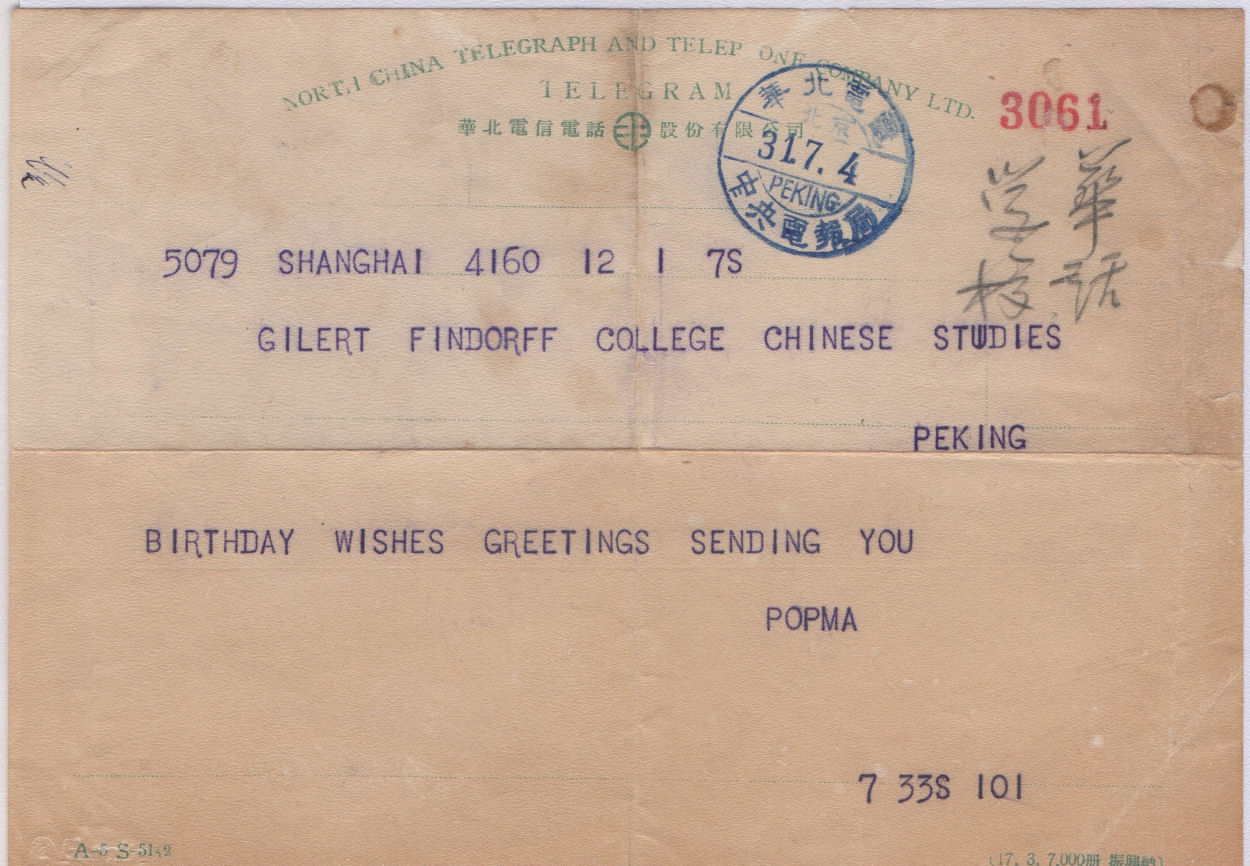
On the cancel, 莘北電電 = Xinbei Electric ; 北京 = Beijing; 中央電報局 = Central Telegraph Office. Image courtesy of Les Bottomley.
At the bottom left is "A—5 S—51 - 2", and on the right is "(17. 3. 7,000册 振興納 )", indicating 7,000 books (册 = books). 振興納 = revitalize (興 is now 兴) .
(Form 信221) in blue 15-11-34 信通 Logo. - My Ref. CN-STC-221-34-11
In blue: 電報 = Telegraph, 華中電氣通信股份有限公司 = Central Telegraph Company Limited
In magenta: "交通部上海電信局" reading right to left ("Shanghai Telegraph Administration").
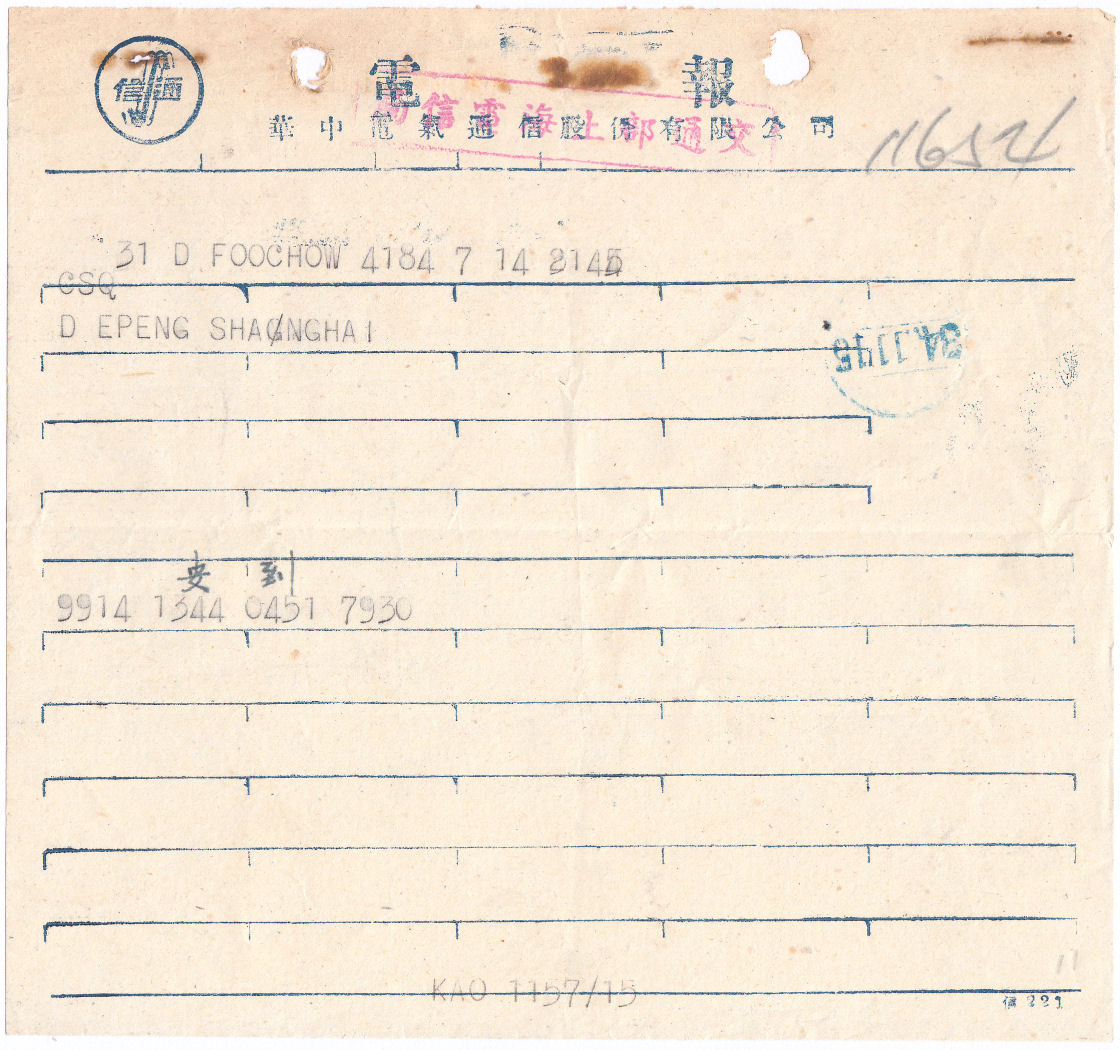
(Form 信221)
(Form 信121) in red 20-6-46 信通 Logo - My Ref. CN-CTC-121-46-6
發電紙 = Telegraph Form (Shanghai to London)
華中電氣通信股份有限公司 = Central Telegraph Company Limited.
收報人住址姓名 = Recipient's address and name
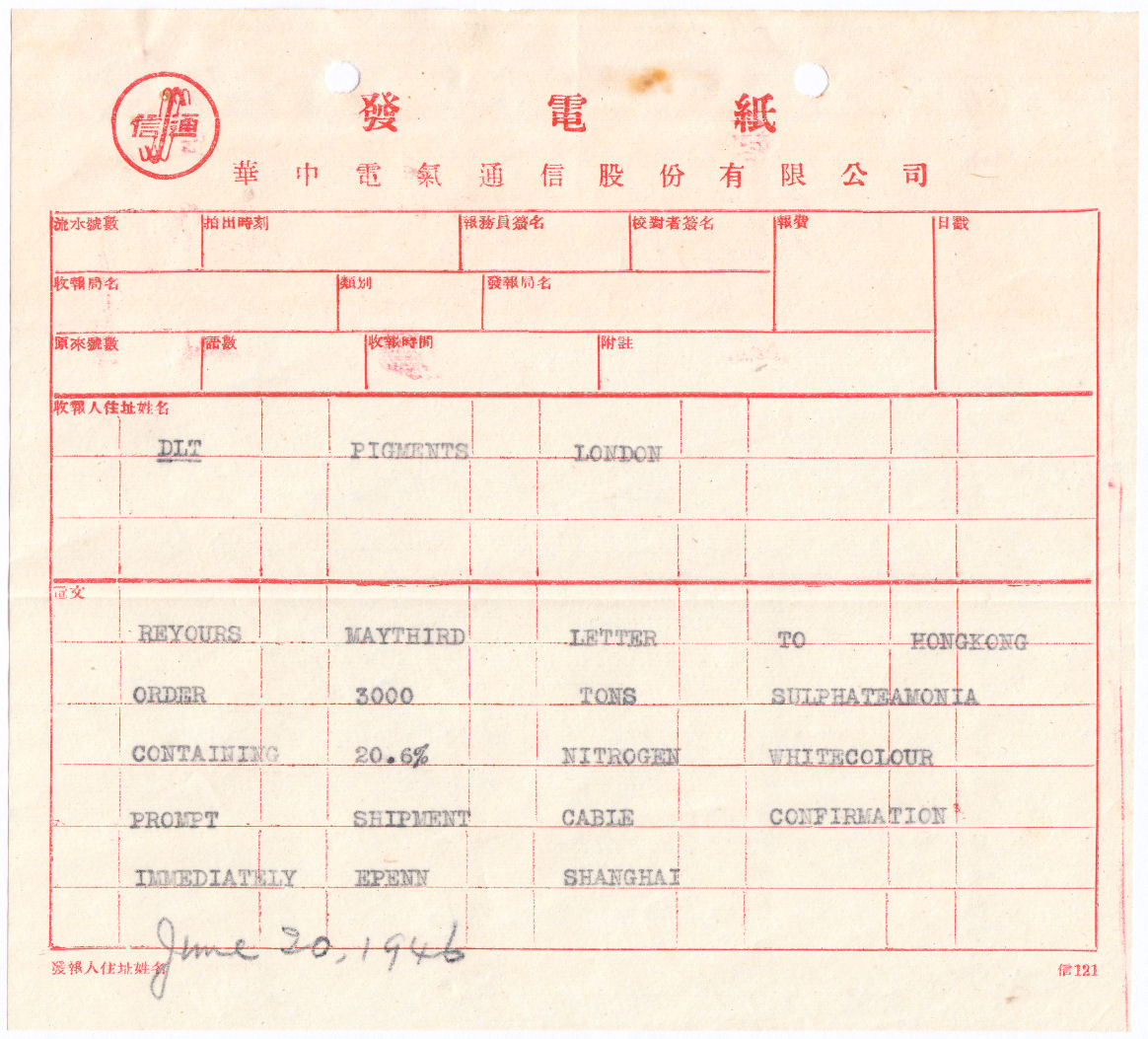
Bottom-left is 發報人住址姓名 = Sender's address and name; On the right is 信121 , the form number.
2-4-46 At the top: 訐送電報賴信粈 which appears to be a slogan. The company name is at the bottom. - My Ref. CN-CTC-9-46-4
This is a sending form from a registered user "EPENN" who, from other examples is known to have been in Shanghai. He is sending to New York.
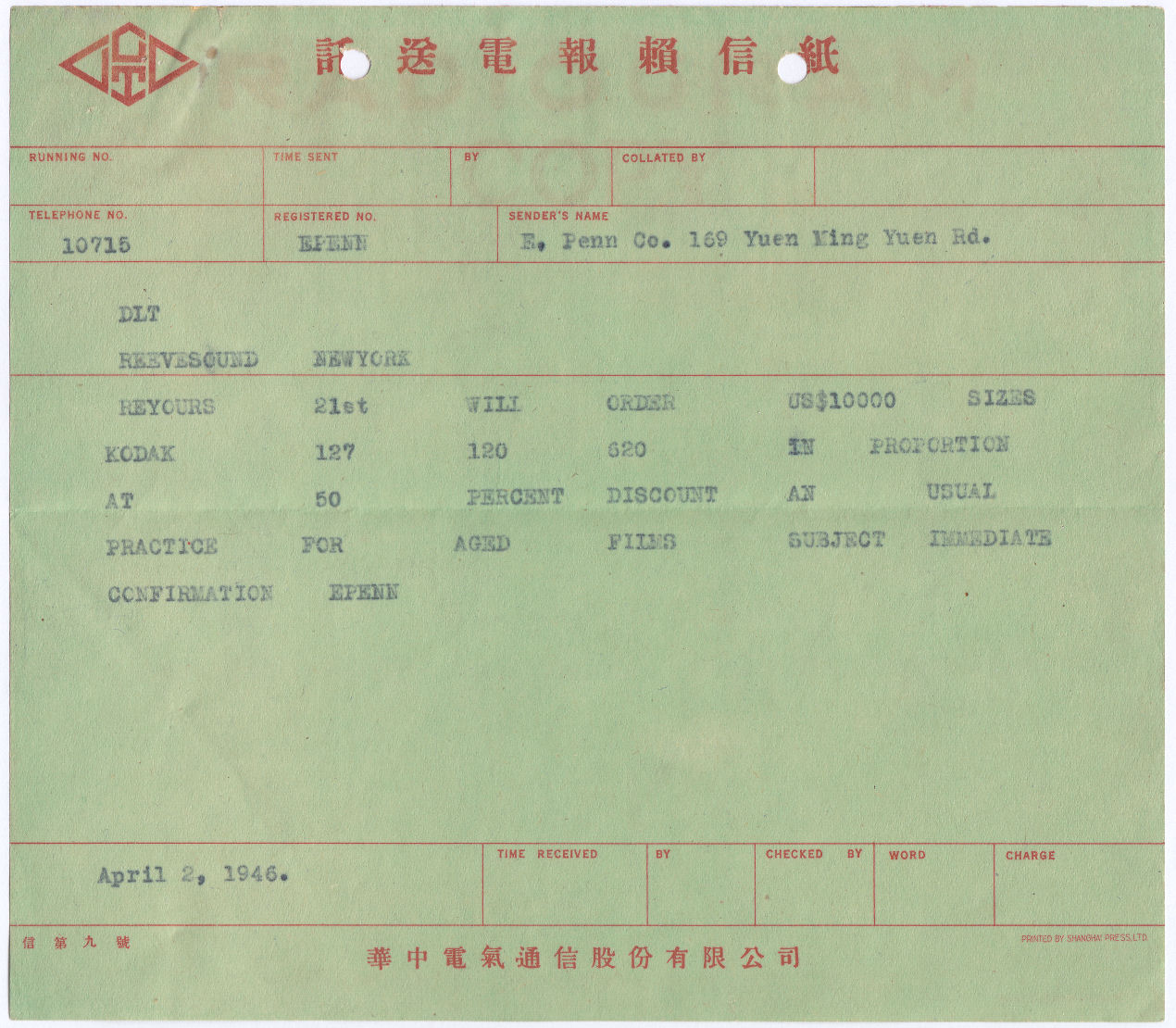
At the bottom left is "信第九號" or " Letter No. 9", Central is : 華中電氣通信股份有限公司 = "Central Telegraph Company Limited" and on the right :- "Printed by Shanghai Press Ltd".
This has a large red offset on the back at the top with "RADIOGRAM / COPY". It shows through to the front.
No form number - 11-3-38 電信 (Telegram) in circles Logo - My Ref. CN-RCTF-SH-38-3
資源委員會電信事務所上海電台 (Resources Committee telegraph firm,Shanghai Station)
無線電報 = Radiotelegraph
The "發報地名" (Report place name) is given as 高碓(gāo guī) in Japan.
This was during the Second_Sino-Japanese_War, though neither side had declared war.
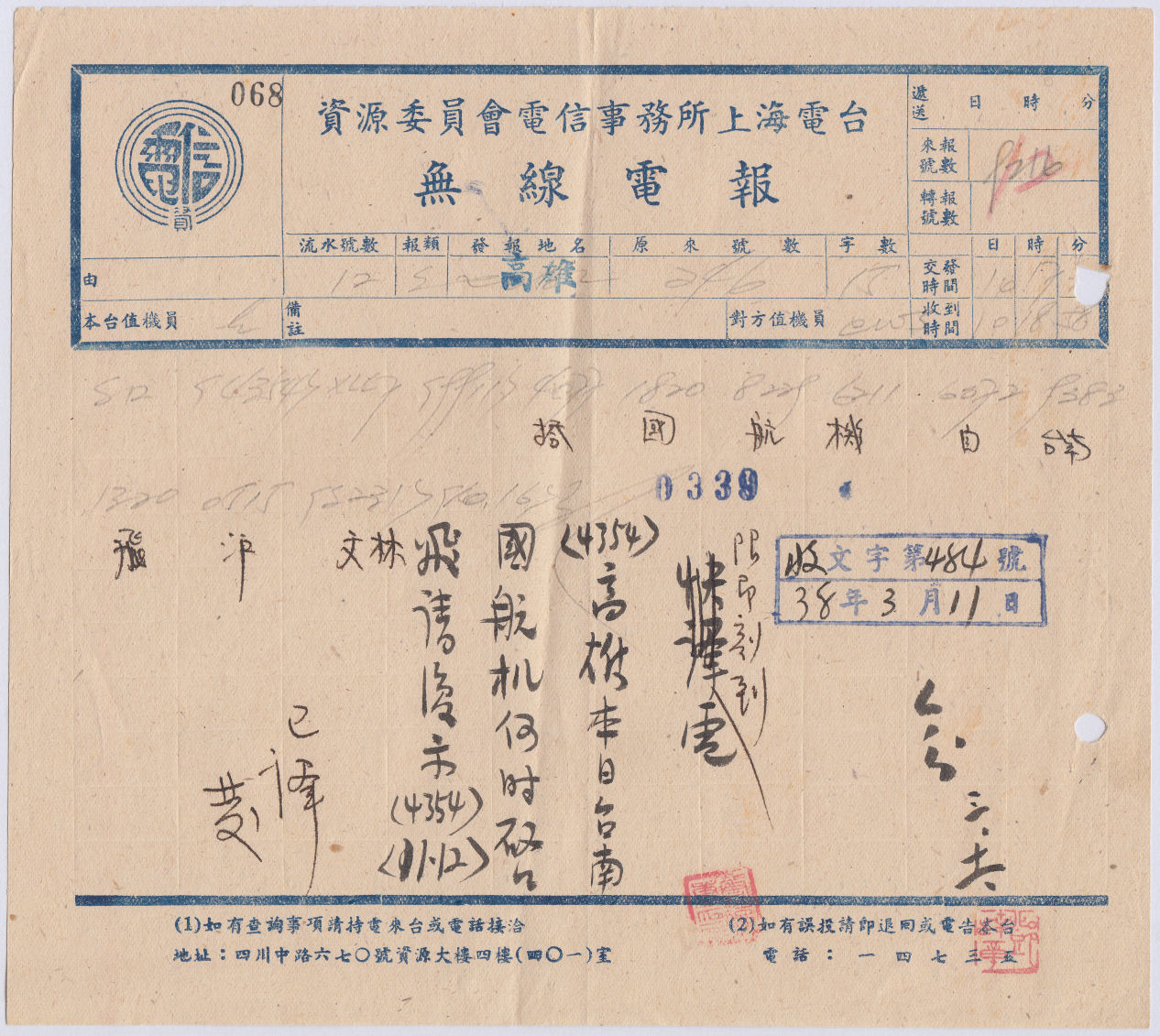
Telephone: 14735
1939-41 - My Ref. CN-HECC-HO-39-1
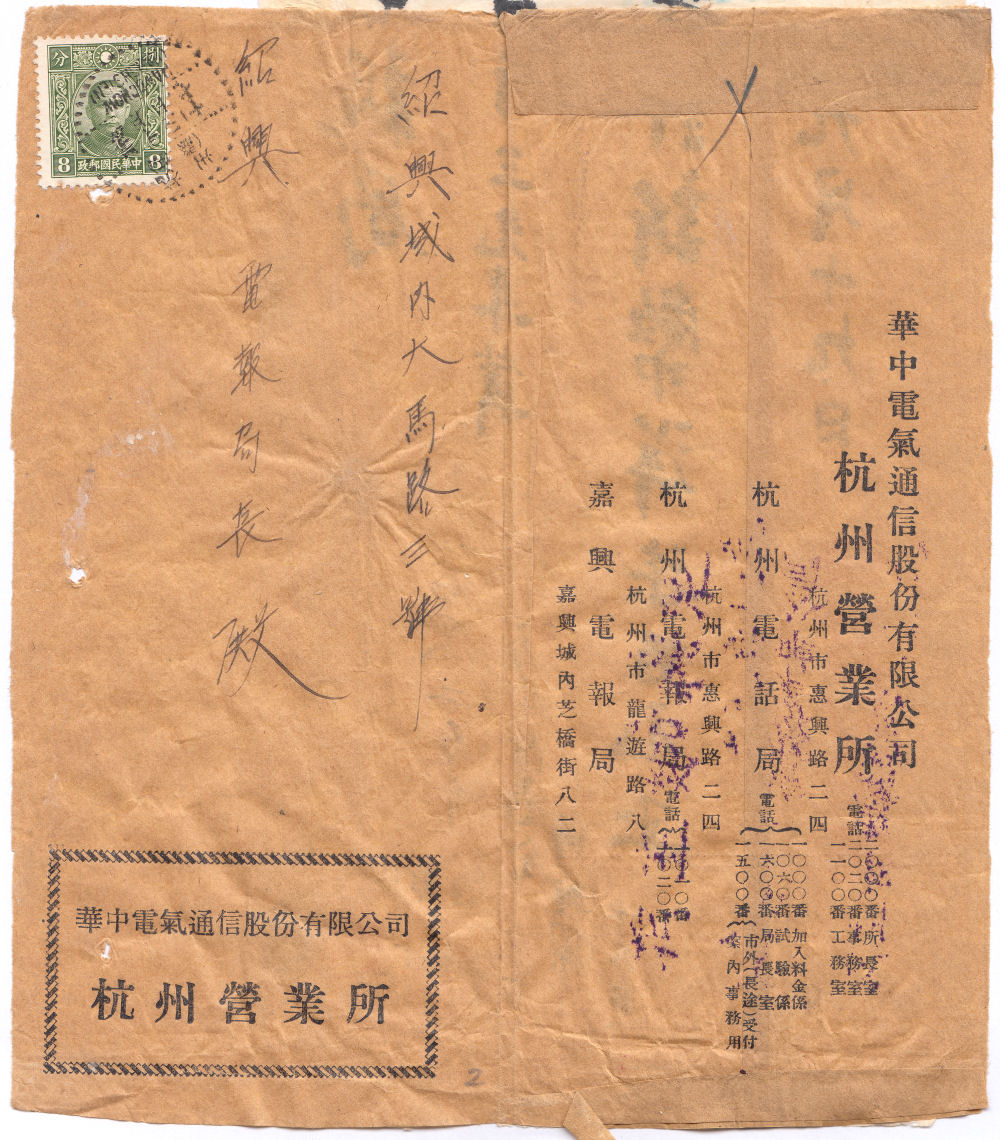 In the bottom-left box, 華中電氣通信股份有限公司 / 杭州營業所 = Huazhong Electric Communication Co., Ltd. / Hangzhou Office. This is repeated vertically on the right. On the right is also a list of different services offered with phone numbers at the bottom. That first character 華, would now be rendered as 华. |
Like the cancels, the contents give day and month, but not the year.
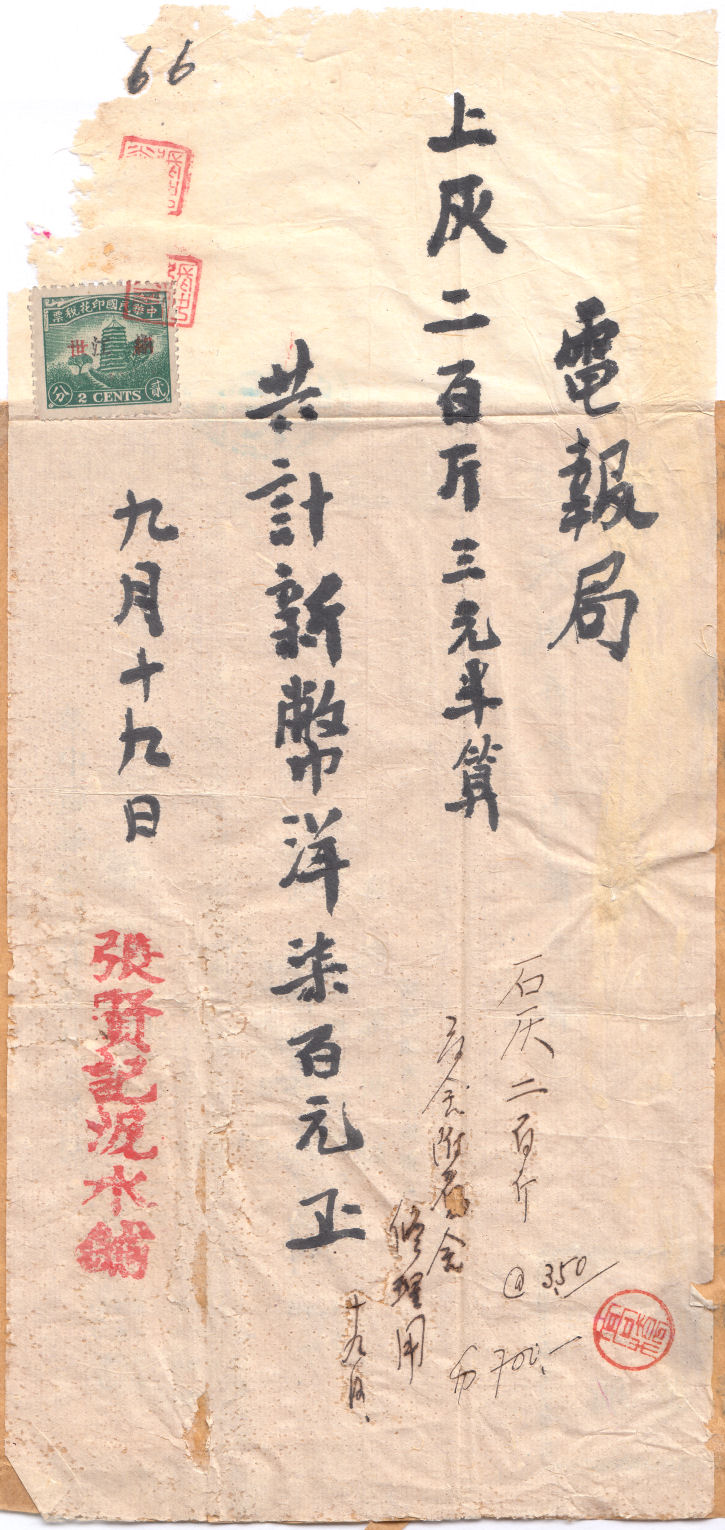 |
19 September, but there is no clear indication of the year on this. The enclosure appears to be made of a kind of 'rice paper'. Probably Xuan paper (宣纸). which got glued to the seam down the back. In places at the bottom-right, the ink has burned through the paper. The fiscal stamps fell off, but one remained in the envelope and I have (digitally) replaced it. 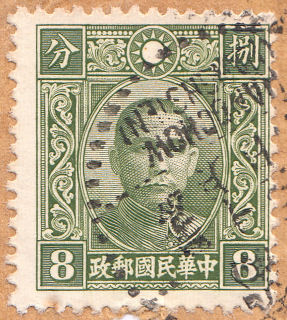 Luckily the Scott catalogue comes to the rescue, The guy on the stamp is known as Sun Yat-Sen (孫逸仙) in the west, but as Sun Zhong Shan (孫中山 - Sun Middle mountain) in China, He has the distinction of being respected by both China and Taiwan 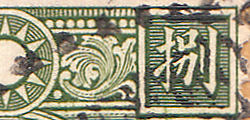 This issue is apparently quite complicated and this part of the design showing large pearls tells us that it was used from 1939-41. This was used in Hangzhou (杭州). (referred to as Hangchow at that time) It is a bit to the south of Shanghai (上海). |
1940 - My Ref. CN-HECC-SH-40-1
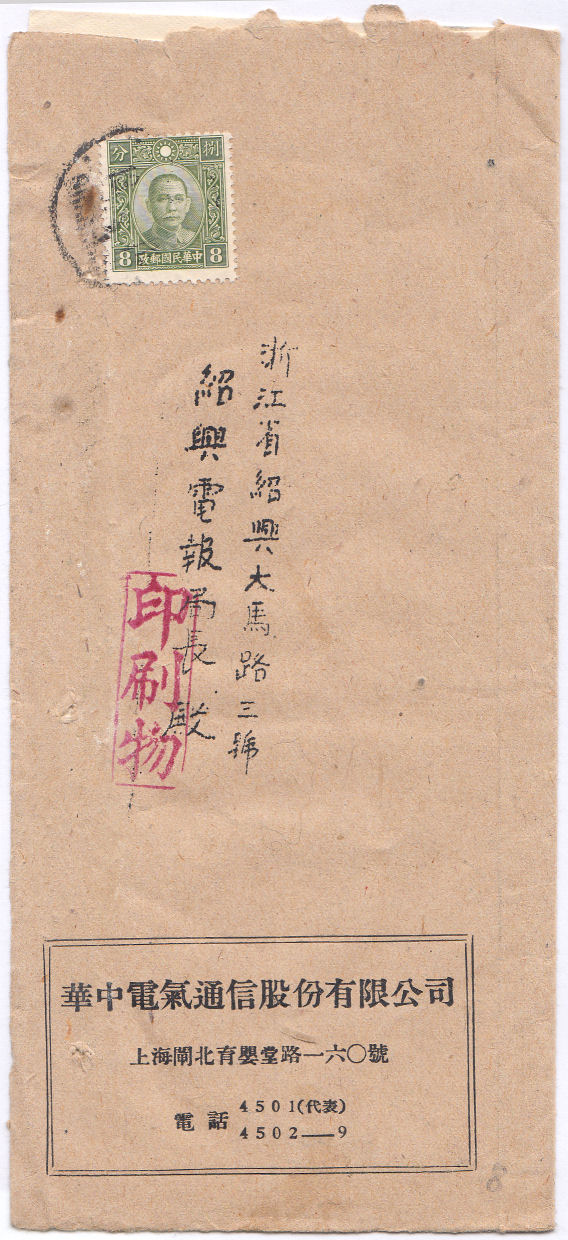
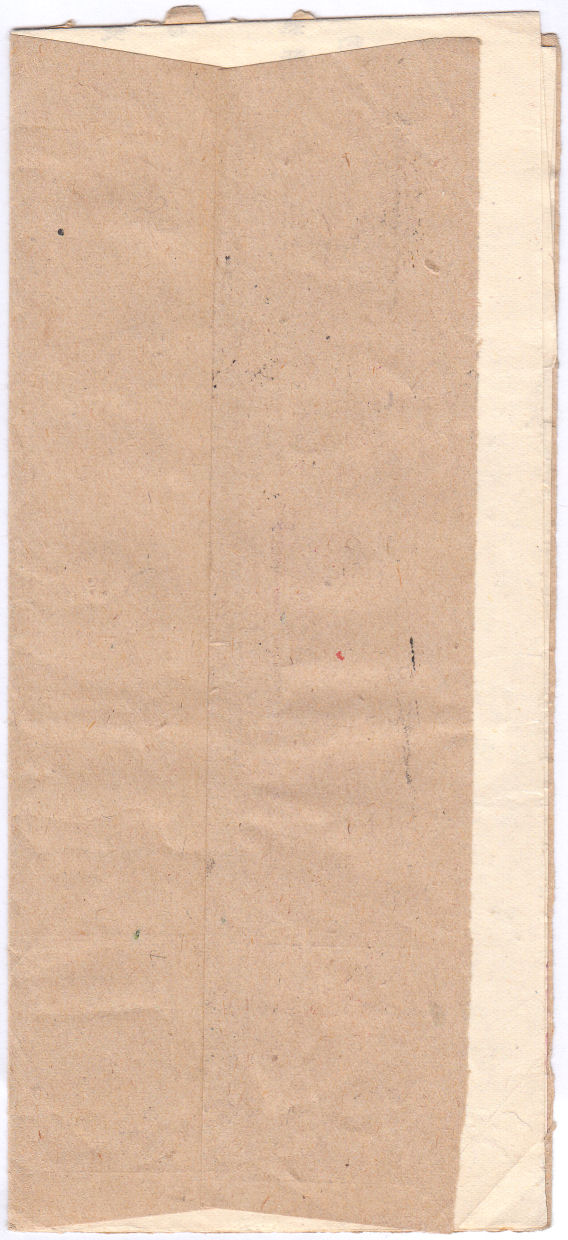 The box at bottom-left has 華中電氣通信股份有限公司 = Huazhong Electric Communication Co., Ltd 上海閘北育嬰堂路 一六Ο號 = No. 160, Yuyingtang Road, Zhabei, Shanghai Phone numbers underneath. 代表 = representative The 印刷物 means Printed matter . |
|
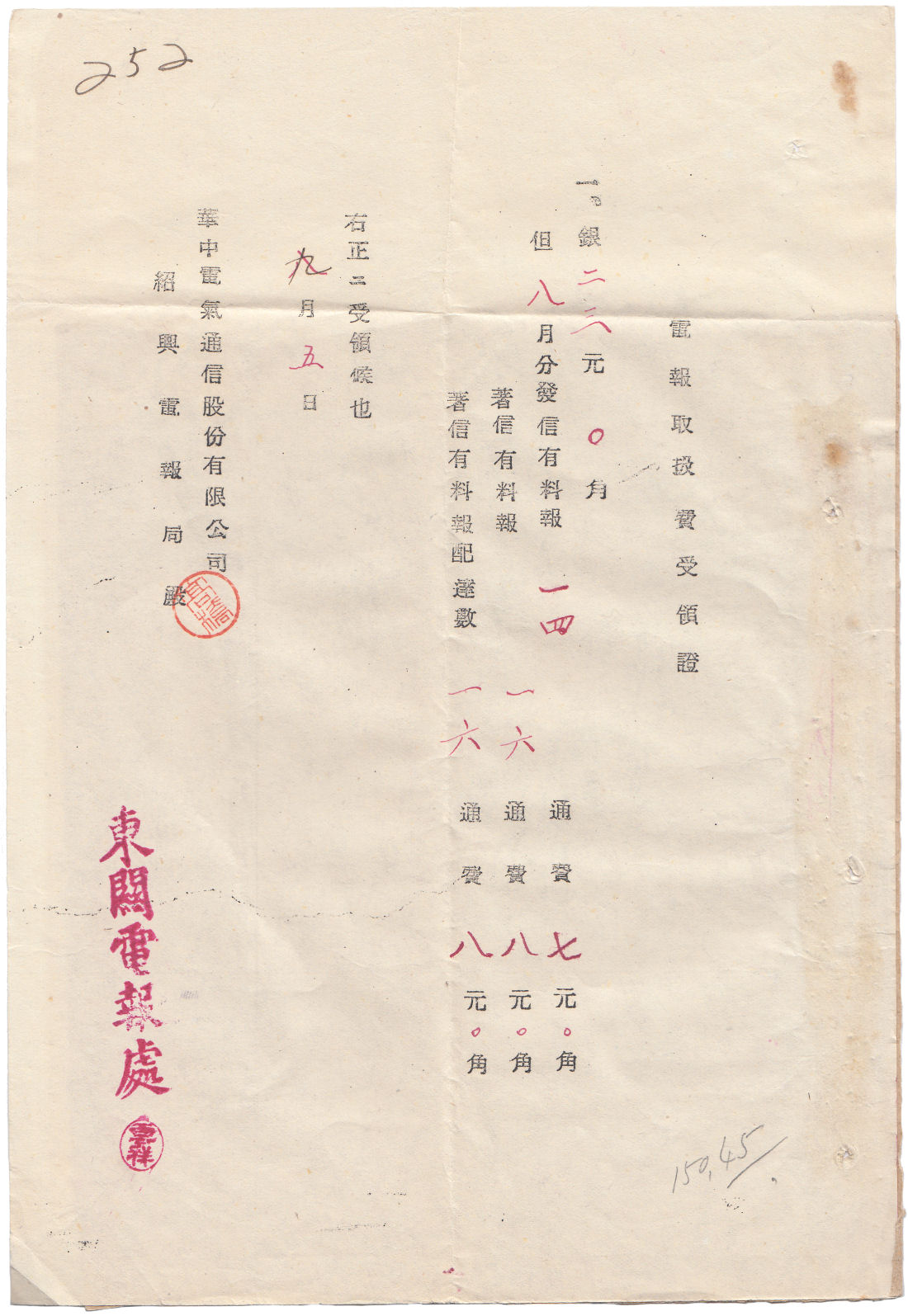 |
5 August (over-writing September), but there is no clear indication |
1941 ? - Another Similar. My Ref. CN-CN-HECC-SH-41-1
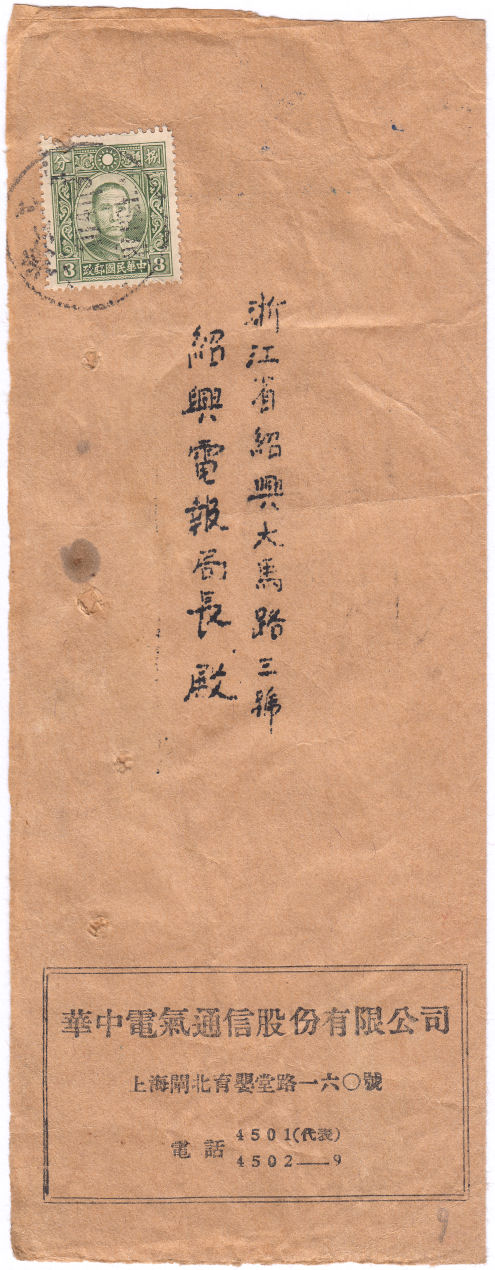 |
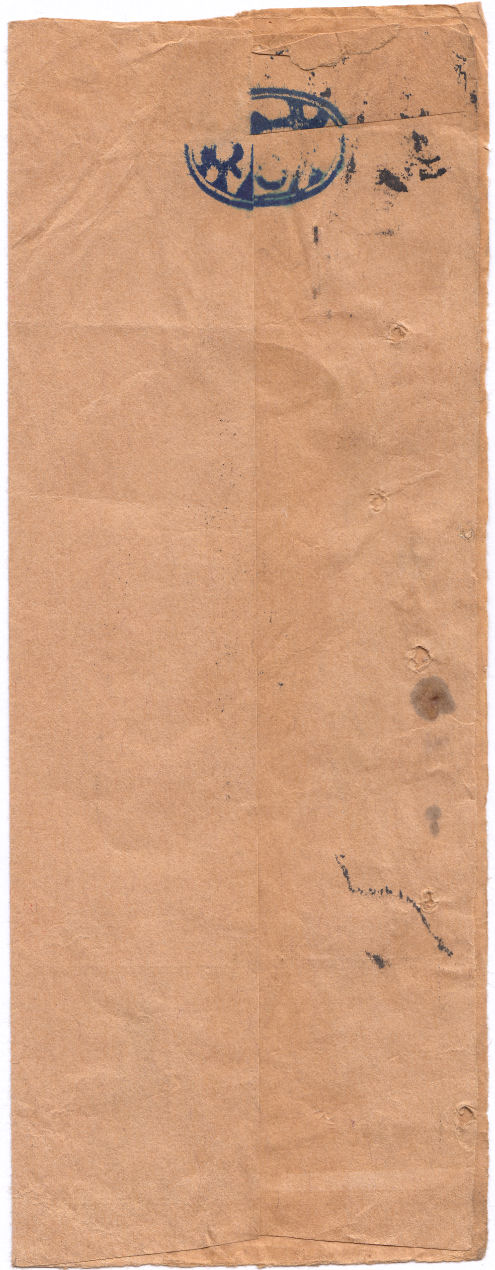 |
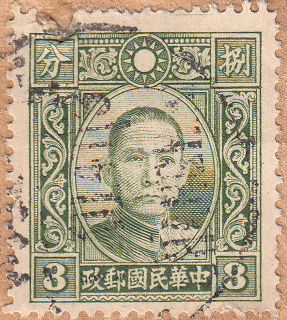 |
The postmark is not very clear, but looks like it may be 1941. |
1940 - My Ref. CN-CN-HECC-HO-40-1
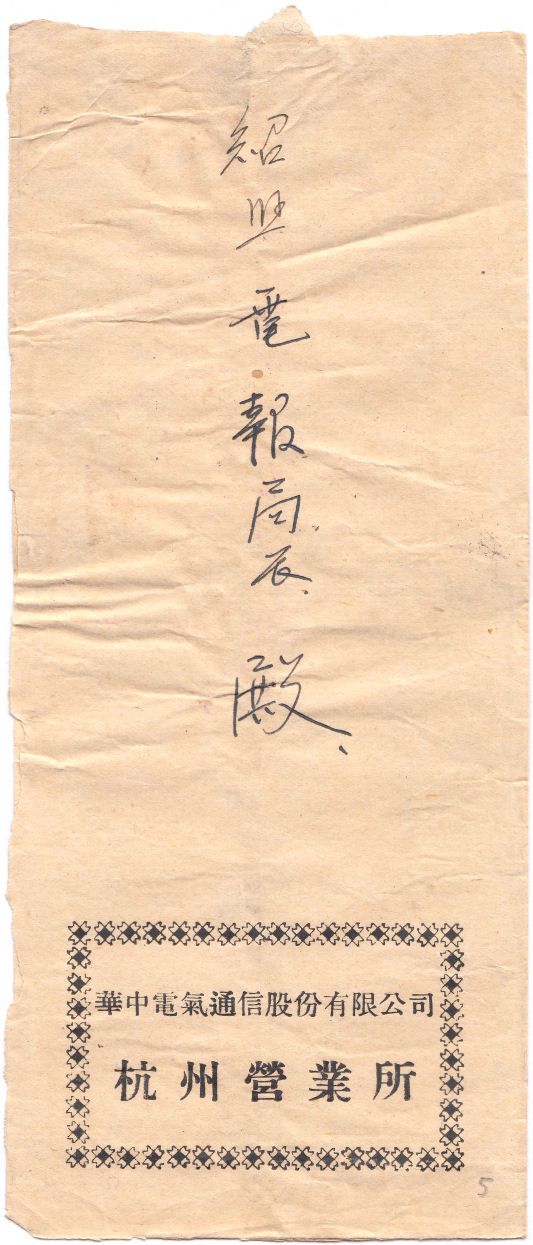 |
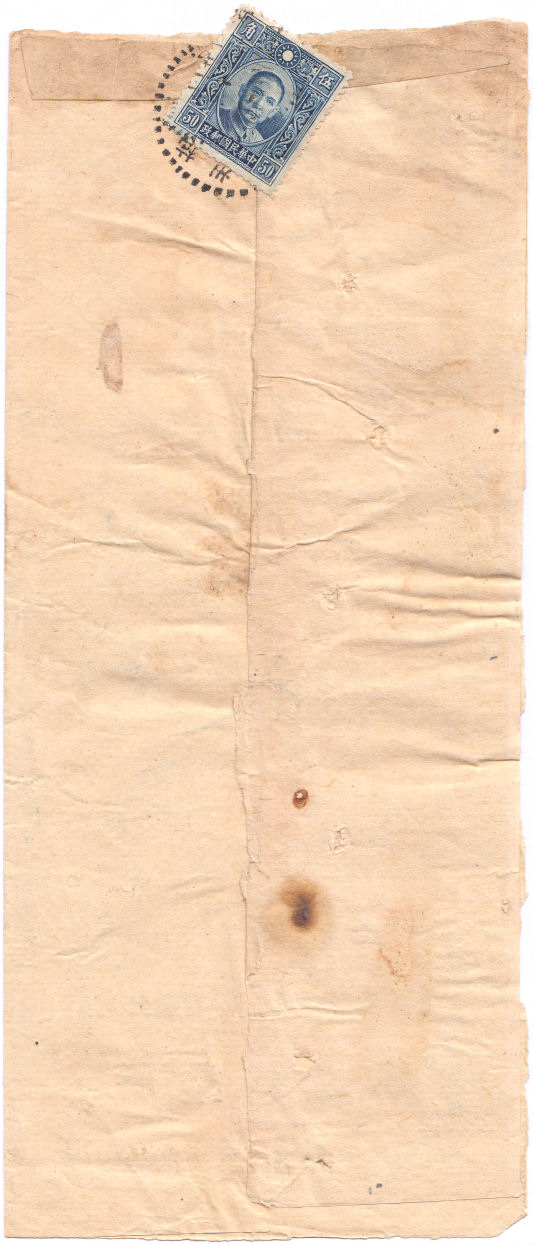 |
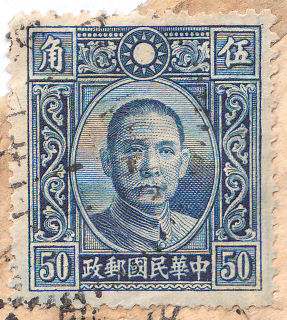 |
Again there is no clear indication of the year on this. And there is no enclosure with this. Again the Scott catalogue comes to the rescue, 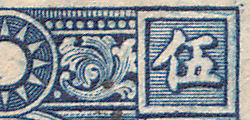 This has the smaller pearls of the Re-engraved type. On the right is the number '5' and at top-left is 角 (Jiǎo), the name of the 10c coin. At the bottom, the two halves of the character are run together. This is referred to as Type III, in a later type they are not joined (1940-41). This is the opposite way round from the 8c shown above. This type was used in 1940. |
7-2-46 交通部上海電信局 / Shanghai Telegraph Administration. - My Ref. CN-STCA-SH-46-2
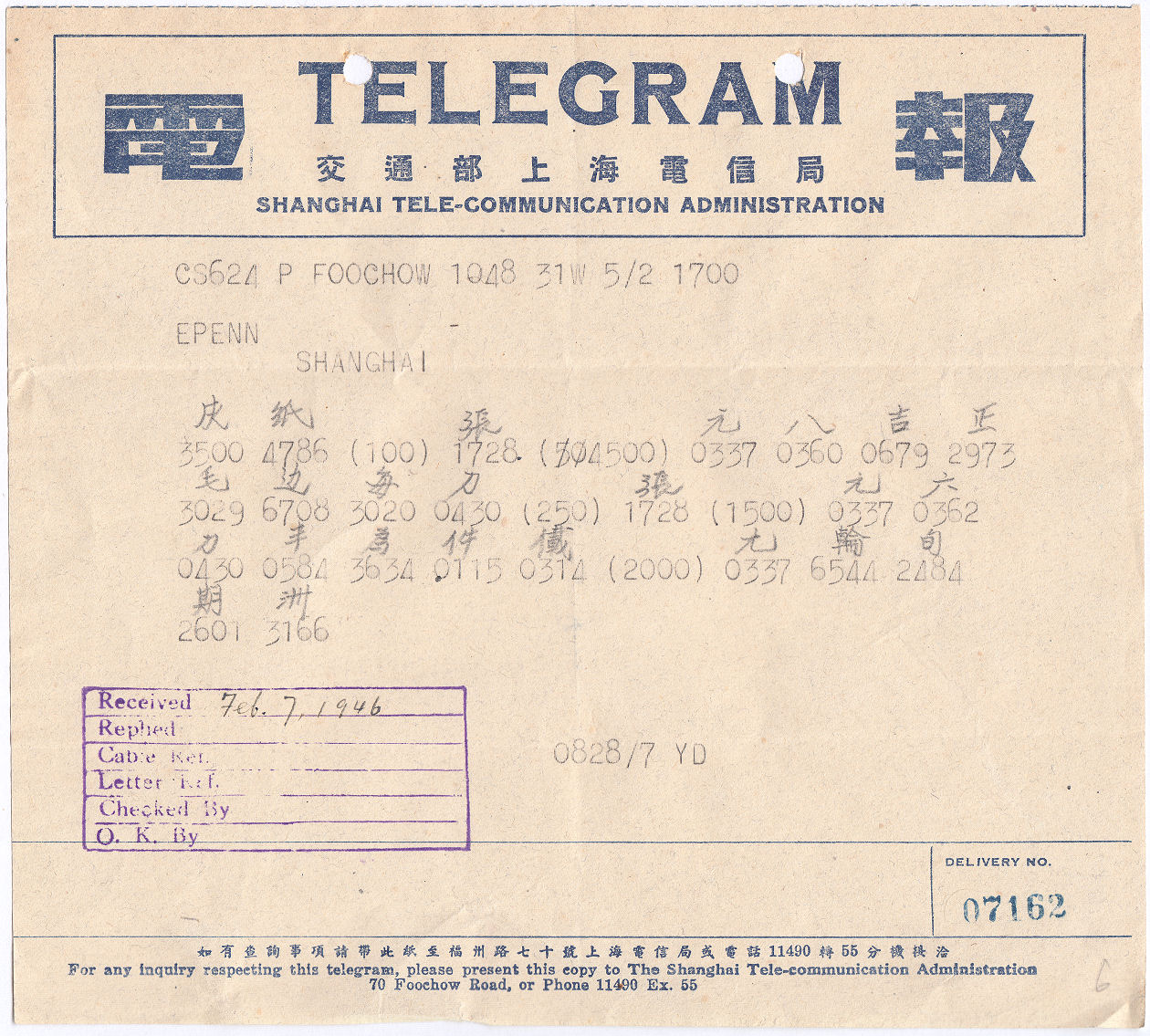
Form 業報2302 - used 18-4-47 - My Ref. CN-STCA-2302-36-3
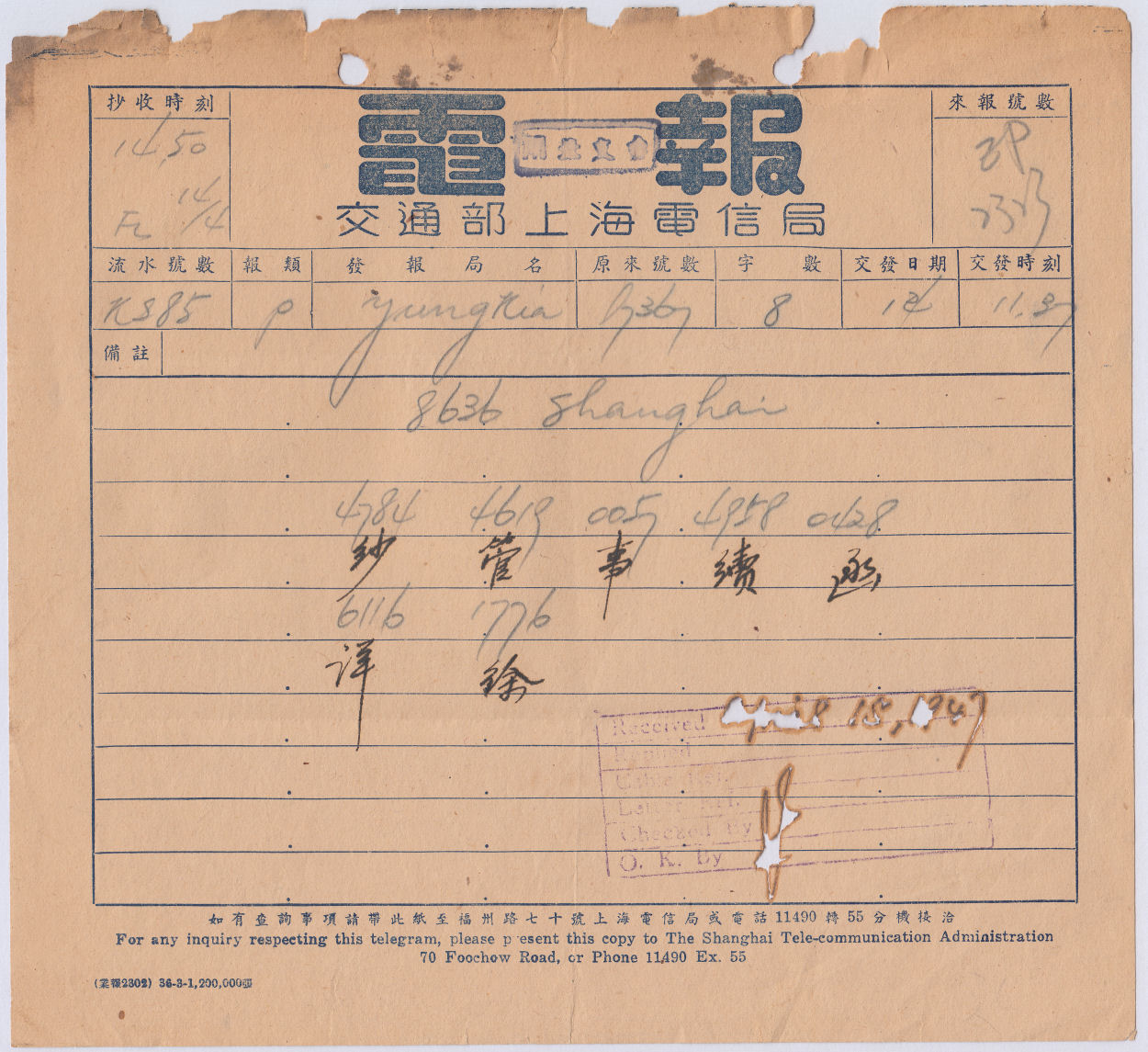
On the bottom-left is "(業報2302) 36-3-1,200,000張", the Form number, date of March 1936?, then 1,200,000 quantity printed, and lastly what seems to be the printers' surname Zhang,
though since the character is Shanghai dialect, I cannot properly represent it in modern font.
The ink used for the date has burned through the paper. I have a similar one from a week before that has done the same. Form 2302.
Form 業報2302 - used 16-12-47 - My Ref. CN-STCA-2302-47-12
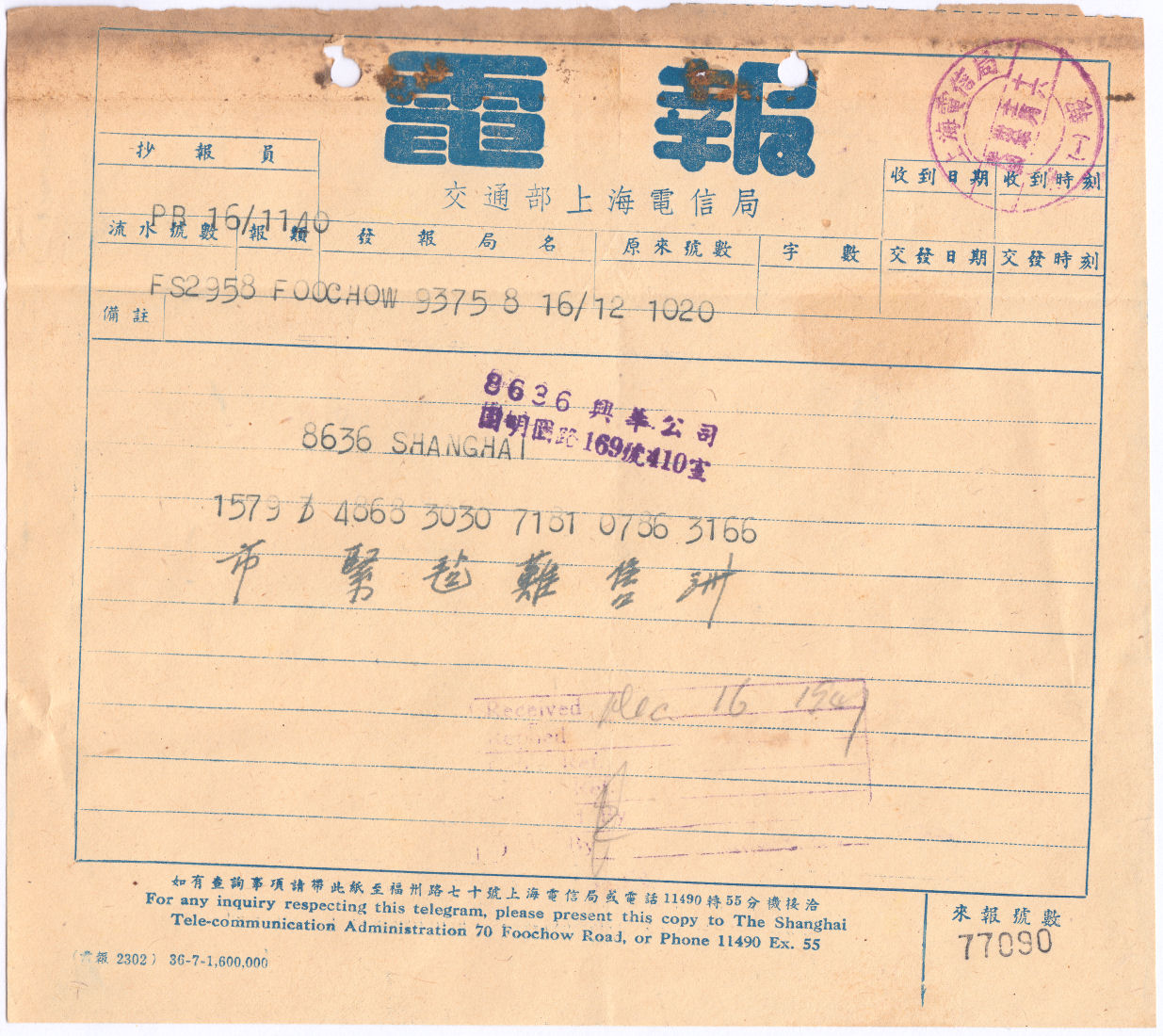
At the top, this has a narrower '交通部上海電信局' (Ministry of Communications, Shanghai bureau). Form 2302.
The bottom imprint has changed to "(業報2302) 36-7-1,600,000", dropping the printers name; and there is a new section on the right with "來報號數" (To report the number).
Form 業報2302 (at top-left) - Used in Shanghai 20-7-51 - My Ref. CN-STCA-2302-51-3
At the top, this has '電報 / 郵電部 - 電信局' = Telegraph / Ministry of Communications - Telecommunications
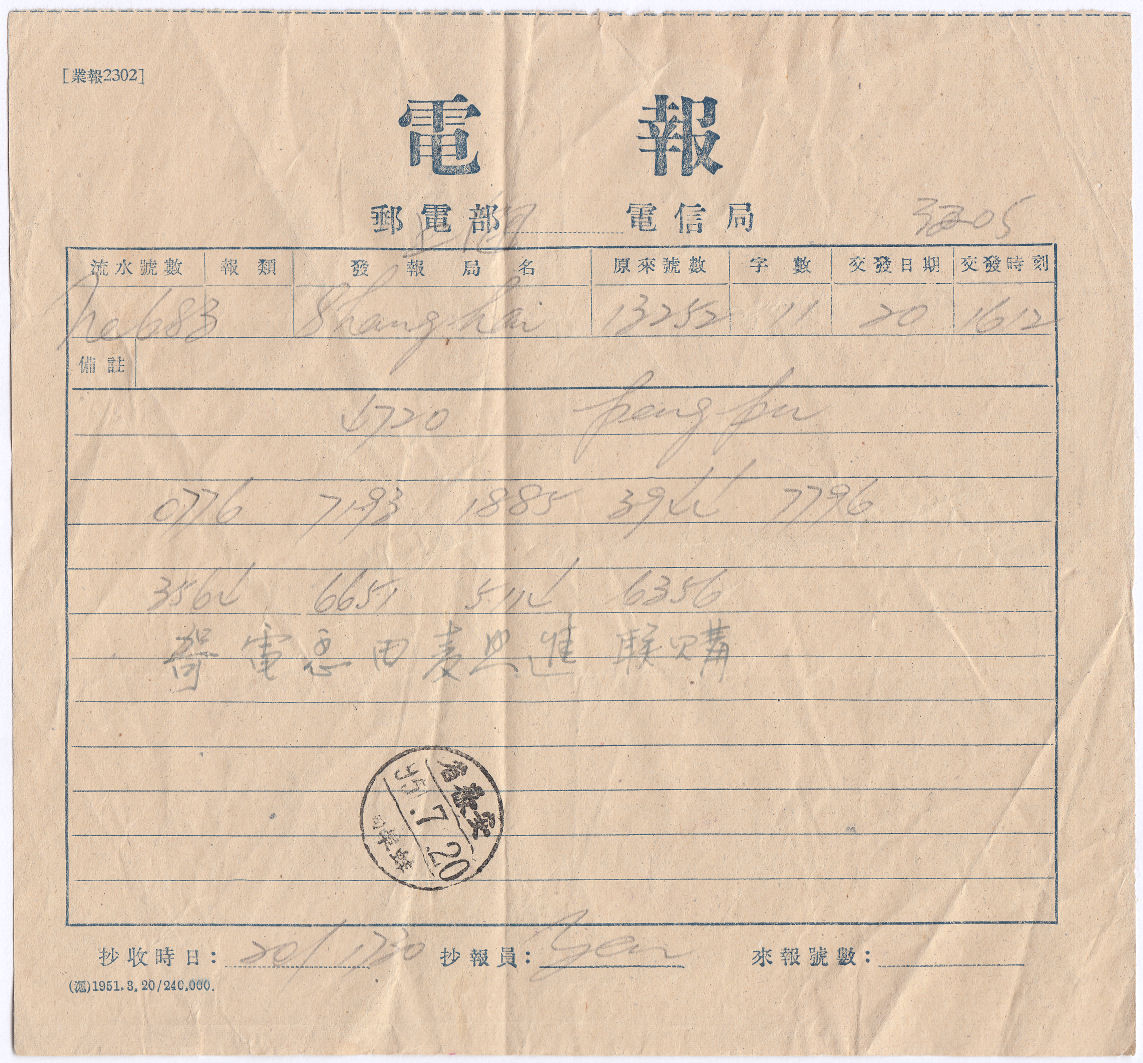
(Form 2302). - Sent from Shanghai. The cancel on this has the Chinese characters written right to left,
so this is "安徽省" [Anhui Province] at the top, and the bottom has "蚌埠" Peng Pu (as written in English near the top of the form). [city is now written 市, but it is clearly not that]
The imprint has changed again, dropping the form number that is now at the top. It reads "(湹)1951.3.20 / 240,000." (湹=chán) suggesting a small printing of 240,000 on 20 March 1951.
The space on the bottom-right for the number was apparently in an inconvenient place.
No form number - 30-9-1950 - My Ref. CN-SIR-Slog1-50-9
At the top, this has '國際電報 / 上海國際電台' = International Telegraph / Shanghai International Radio.
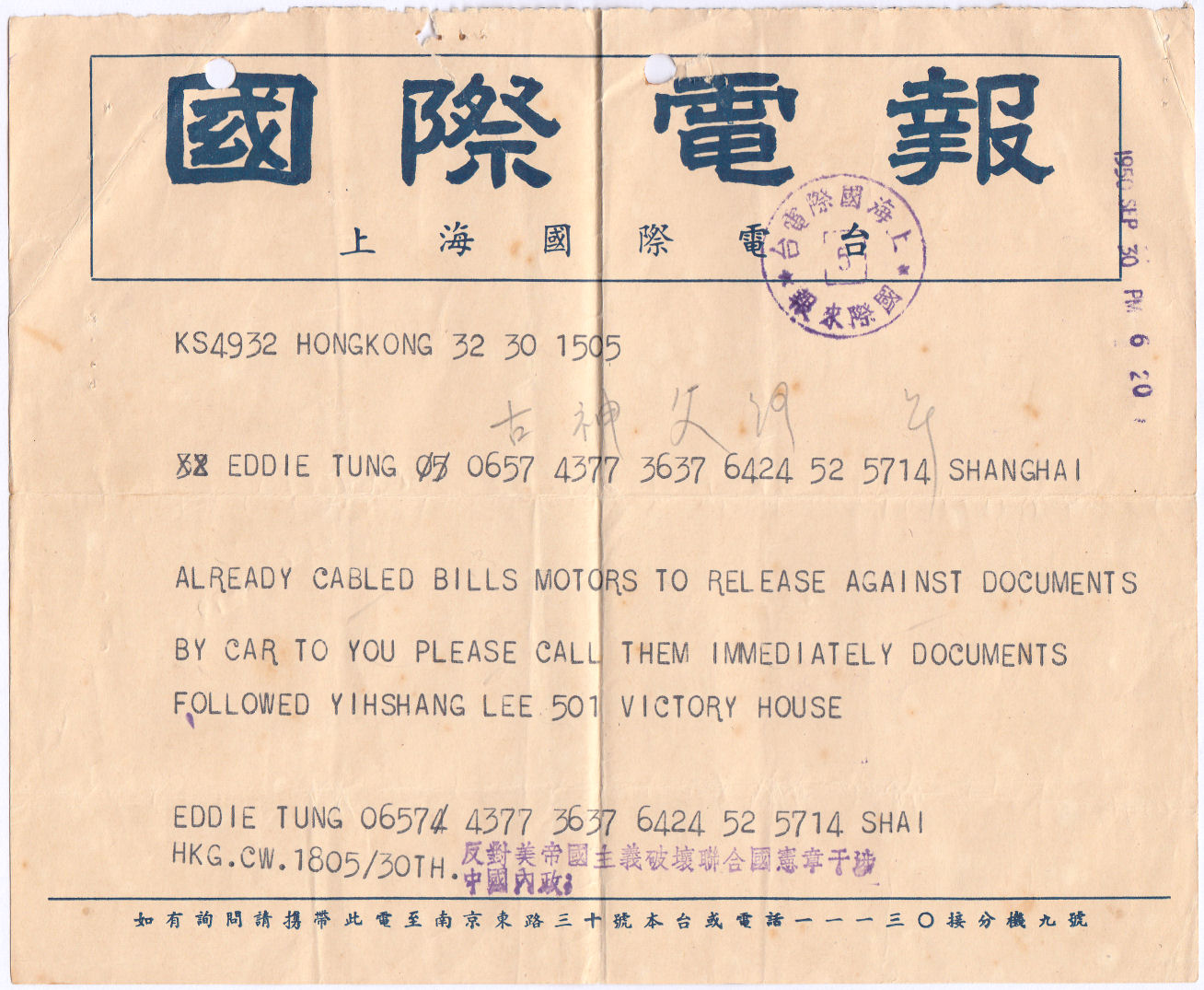
At the bottom it has "如有詢問請 携 帶此電至南京東路三十號本台或電話一一一三0接分 机 九號" (If you have any enquiries, please bring this telegram to 30 Nanjing Road East or telephone 11130, extension 9)
In purple above that is stamped "反對美帝國主義破壞聯合國憲章干渉
中國内政" (Oppose U.S. imperialism and undermine the Charter of the United Nations to interfere in China's internal affairs)
Undated Receiving Form - My Ref. CN-CTA-RF-1
Chinese Telegraph Administration - This has everything in English only. No form number. The year could be 1909. Used in Changsha(长沙), capital of Hunan Province.
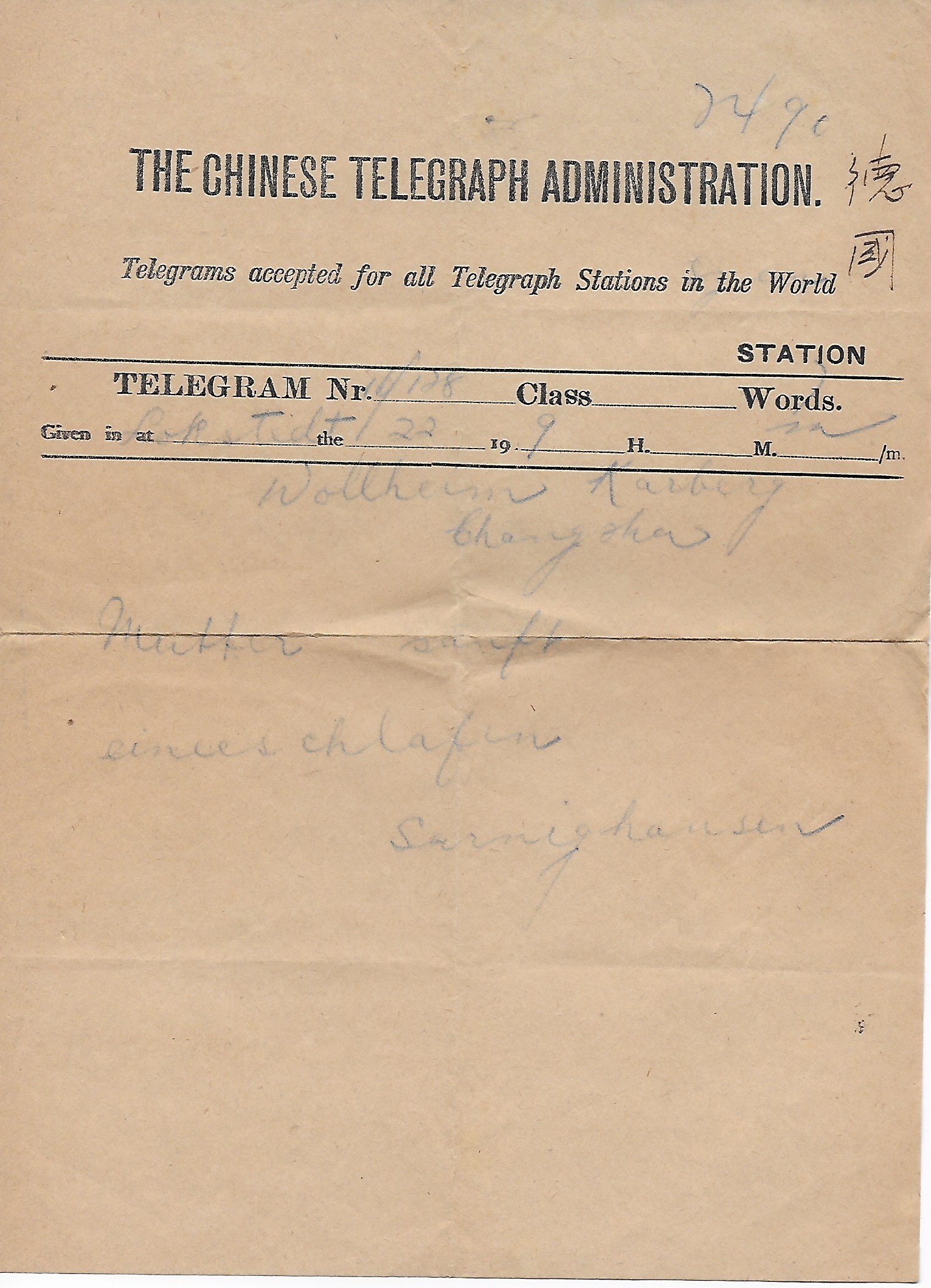
Image courtesy of Michael Schweizer of PhilArena on eBay. Click image for listing.
Undated Receiving Form - My Ref. CN-CTA-RF-2
Chinese Telegraph Administration - This has everything in English and Chinese, but is lacking any indication of the year or form number.
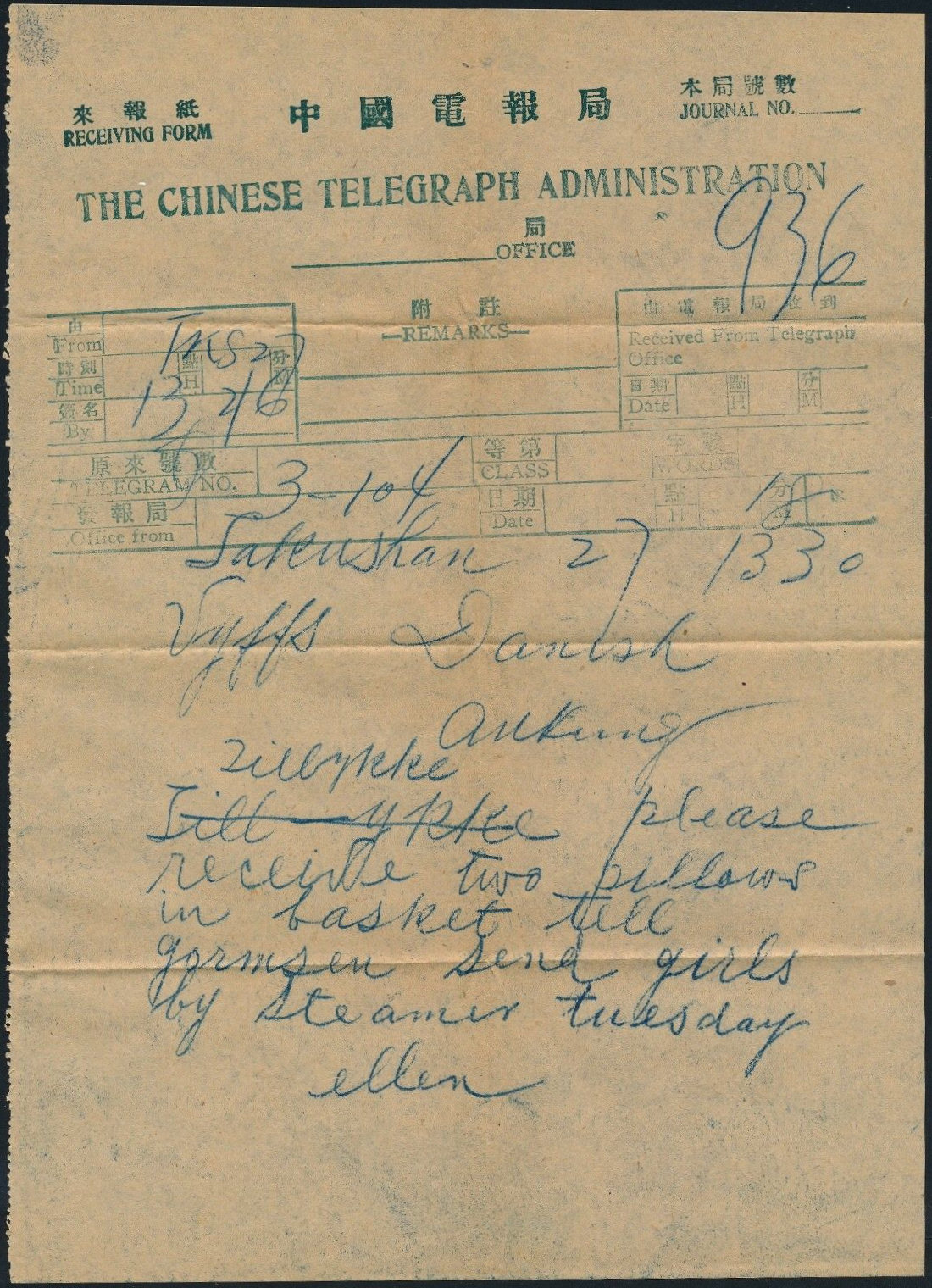
It was part of an eBay lot (113576543062) which has been deleted.
The other part was the associated envelope below, which is also undated. - My Ref. CN_CT_Env-1
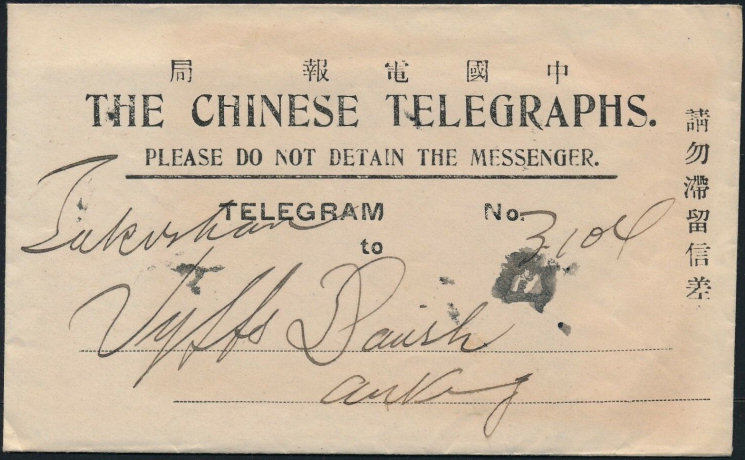
Undated Envelope of the Chinese Telegraph Company. - My Ref. CN_CTCo_Env-1
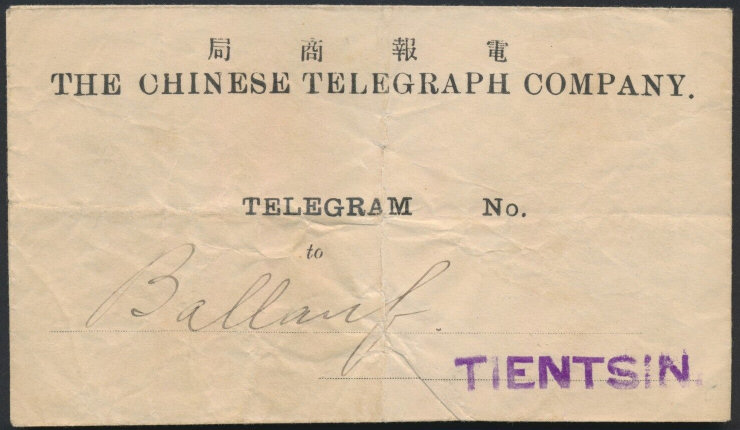
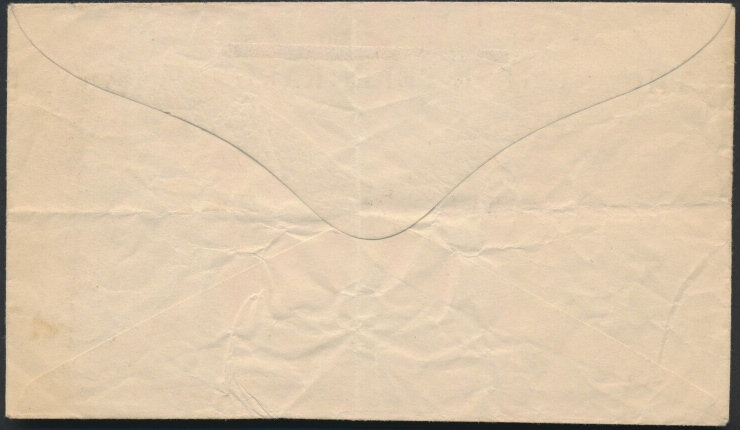
The front is stamped for use in Tientsin. The back is plain. Images courtesy of Hugh Eddison at HJ Eddison Stamps & Postal History on eBay (click image for listing).
Since this is an envelope of a private company, it probably pre-dates the government one above.
The presence of 人民 on later forms, indicates they are of the People's Republic of China.
Old forms were used for a while though until new ones became available.
Undated form 6-3012 used at "XinZhou" (district in Wuhan, 武汉市汉阳区) - My Ref. CN-MPT-3012-Wu-1
At the top is "中华人民共和國邮电部" (Ministry of Posts and Telegraphs of the People's Republic of China)
[The second character used is now obsolete and I had to replace it with the character used on the next form.]
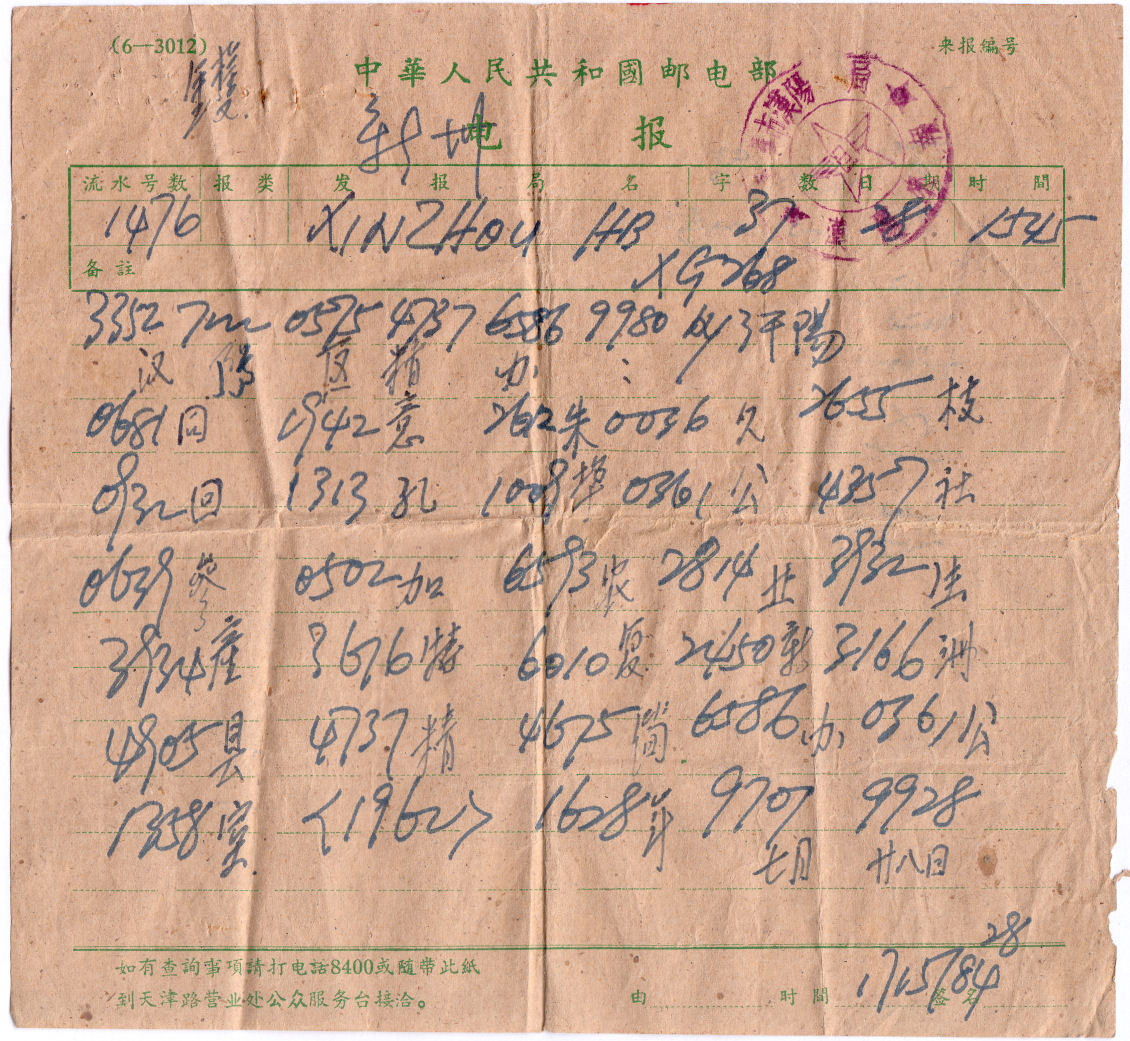
Form 6-3012 - at the bottom-left, this has "如有查詢事項請打电話8400或随带此紙 / 到夫津路营业处公众服务台接洽。"
meaning "For enquiries, please call 8400 or bring along this sheet of paper to the Public Service Counter at Fuk Tsun Road Sales Office."
I presume that is a Wu Han number.
Form 6-3012B (a short version) - 11-6-54 - My Ref. CN-CPT-3012-54-6
At the top, this has ' 中國人民電信 / 電報' = Chinese People Telegraphs / Telegram
In purple is 企業電 = Enterprise Power; 南京 = Nanjing and 九江 = Jiujiang (city).
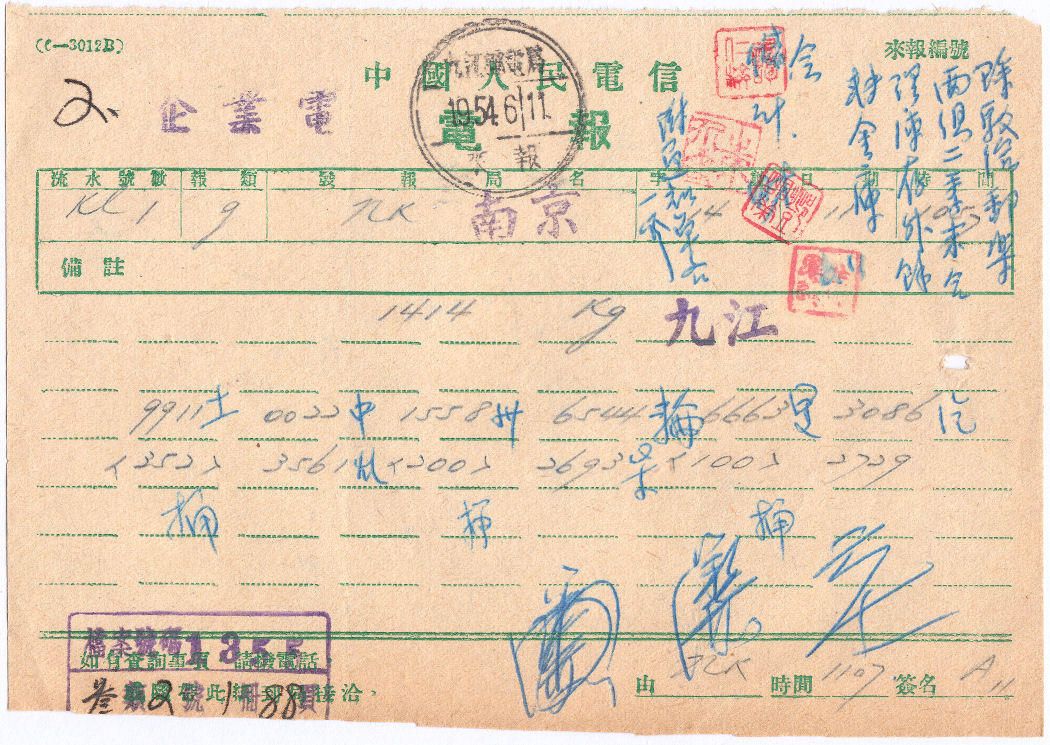
(Form 3012B) received at 九江(Jiujiang) from NanJing (南京)
Form 6-3011A - Used in 江西 (Jiangxi) on 20-3-67 - My Ref. CN-CPPT-3011-67-3
At the top, this has '中国人民邮电 / 電報' = China People's Posts and Telegraphs / Telegram
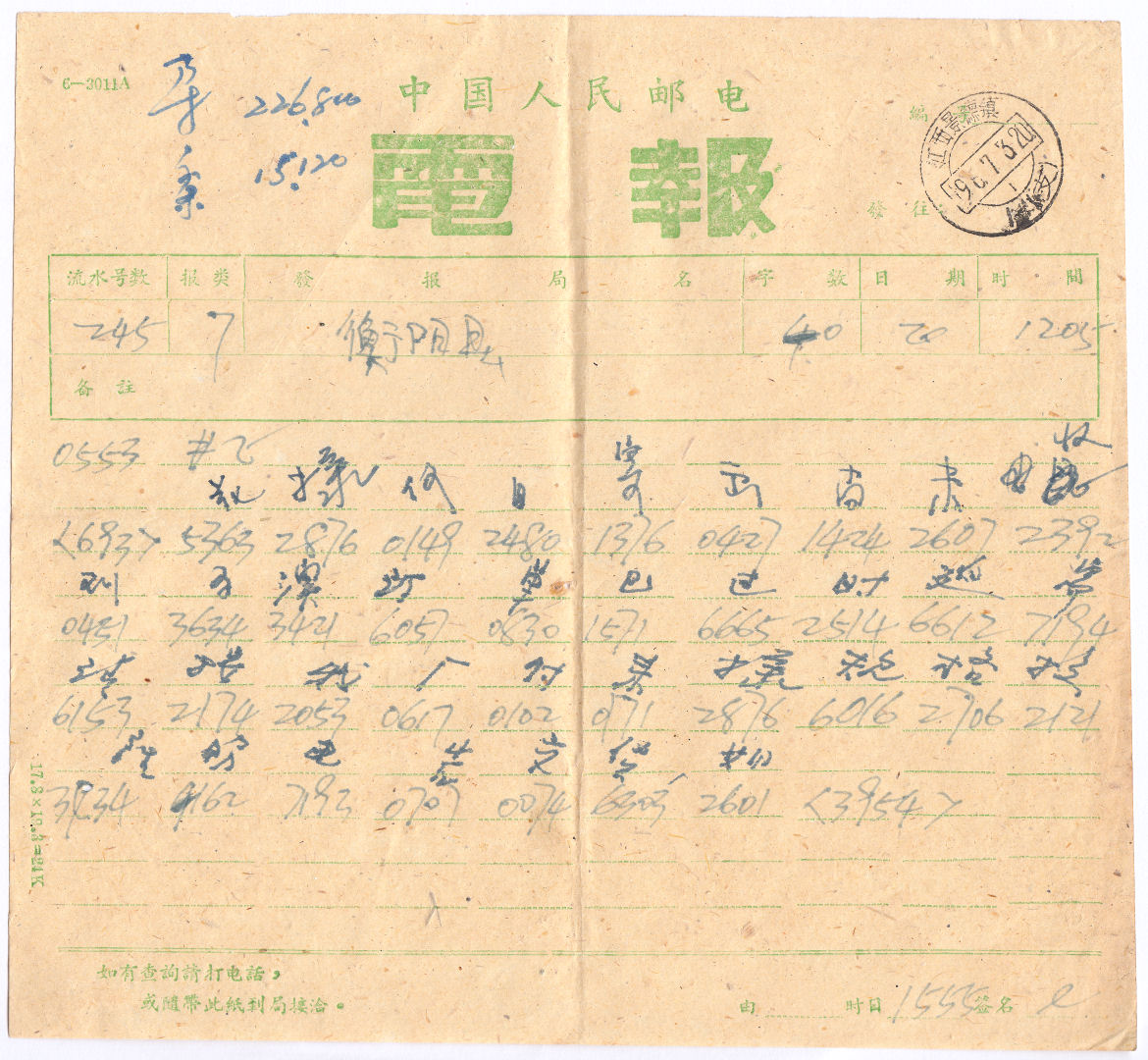
(Form 6-3011A). Imprint at bottom-side of "17.8 x 19.3=24K" shows the approximate size of the sheet in mm.
Used 27-9-54 at Shanghai for a telegram from Chung King (now Chongqing). - My Ref. CN-STB-ACSSC-1954
The Telegram is marked "Alaska Communication System Signal Corps U. S. Army". According to Britannica.com, Chongqing city came under the administration of Sichuan province from this year.
The purple handstamp at the top has large "電報" = Telegram, with "上海電信局" (Shanghai Telegraph Bureau) between them. Under that is "如有查詢事項請帶此紙至福州路 70
號 本局或電話 11490 賻 55 分机接洽" or "If you have any enquiries, please bring this paper to the Bureau at No. 70 Fuzhou Road or call 11490 extension 55 to contact"
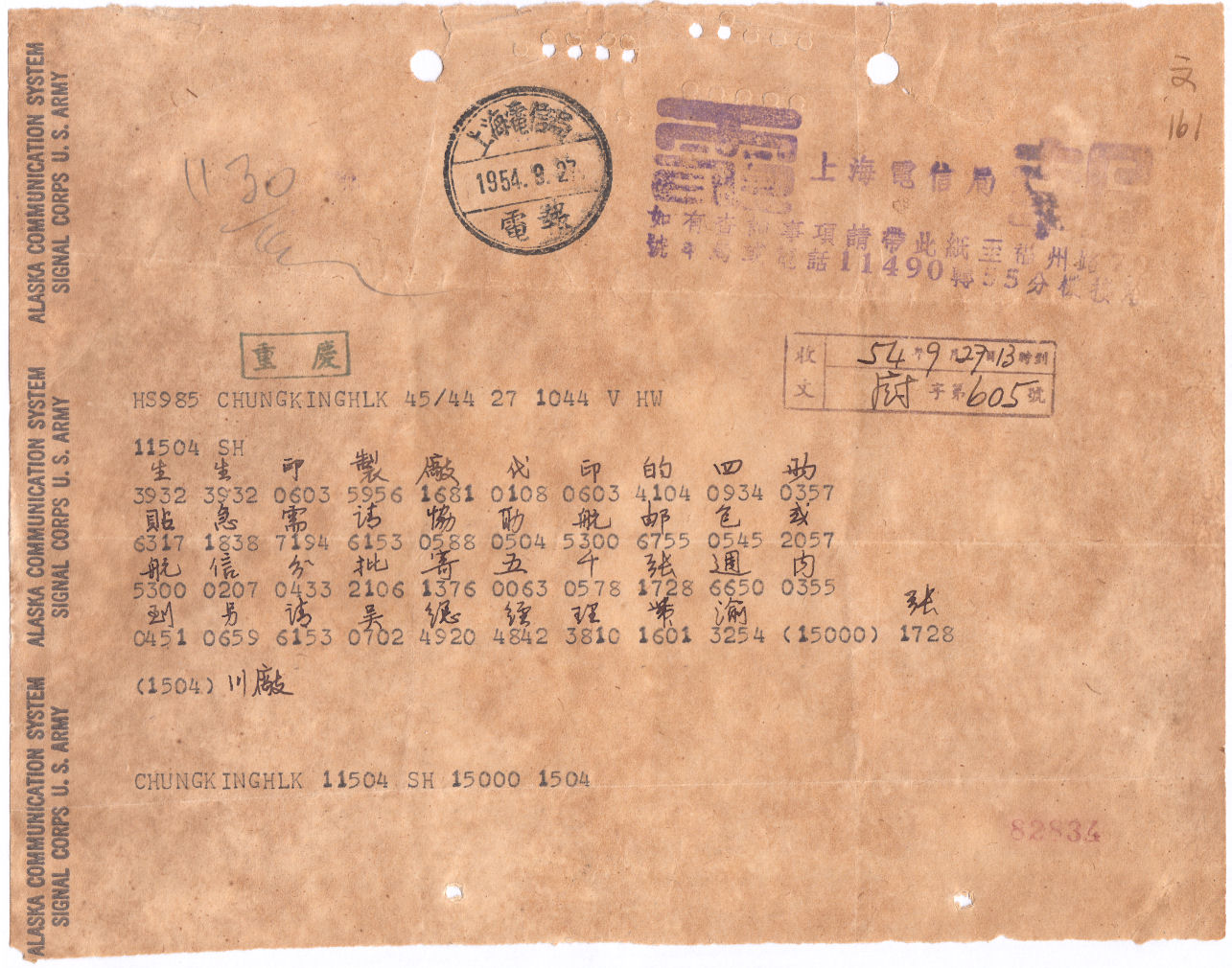
This seems to have the same heading as the one above, but on paper marked for the U. S. Army.
Undated Form 6-3011A - Probably a later one. - My Ref. CN-CPPT_3011A-XB
At the top, this has '中国人民邮电 / 电报' = China People's Posts and Telegraphs / Telegram
The box under that labled "發報局名" gives the "Name of sending office", in this case 呼和浩特市, Hohhot City(inner Mongolia). Below that is "备䚾" which translates as "preparedness/prepare/prepared for"!
Undated Form 6-3011B (shorter than last). - My Ref. CN-CPPT_3011B-XB
At the top, this has '中国人民邮电 / 電報' = China People's Posts and Telegraphs / Telegram
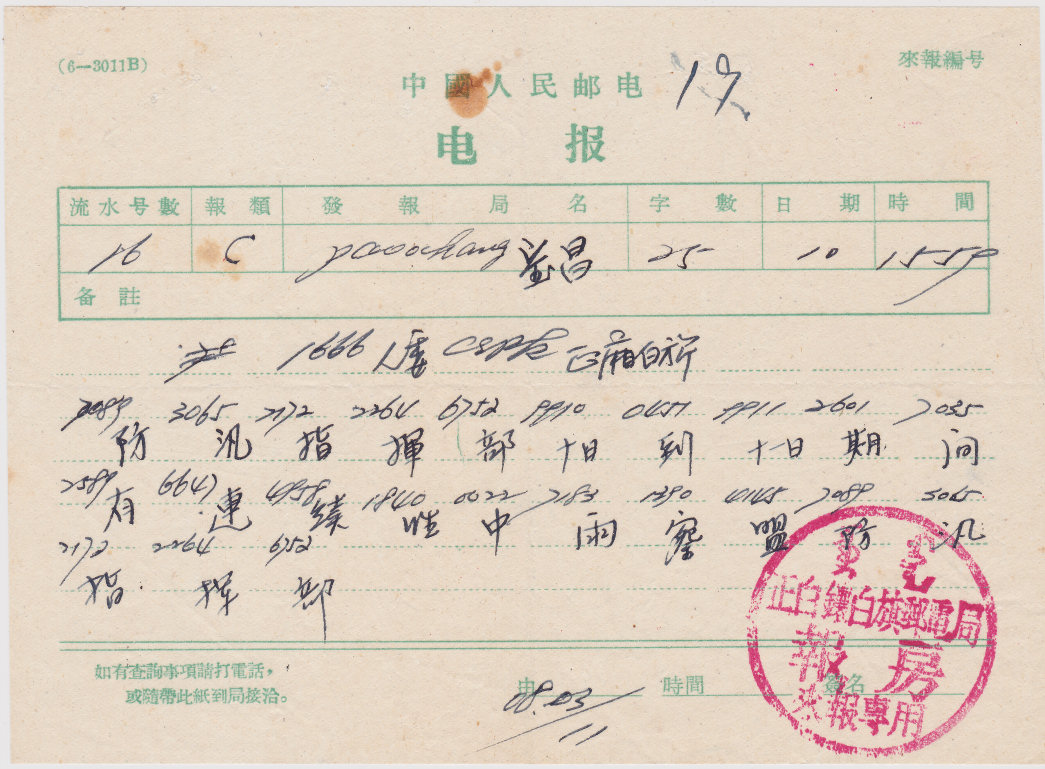
(Form 6-3011B) - at bottom-left this says :
Form 6-3013B in blue - used - My Ref. CN-MPT-3013B-blue
At the top is "中华人民共和國邮电部" (Ministry of Posts and Telecommunications of the People's Republic of China)
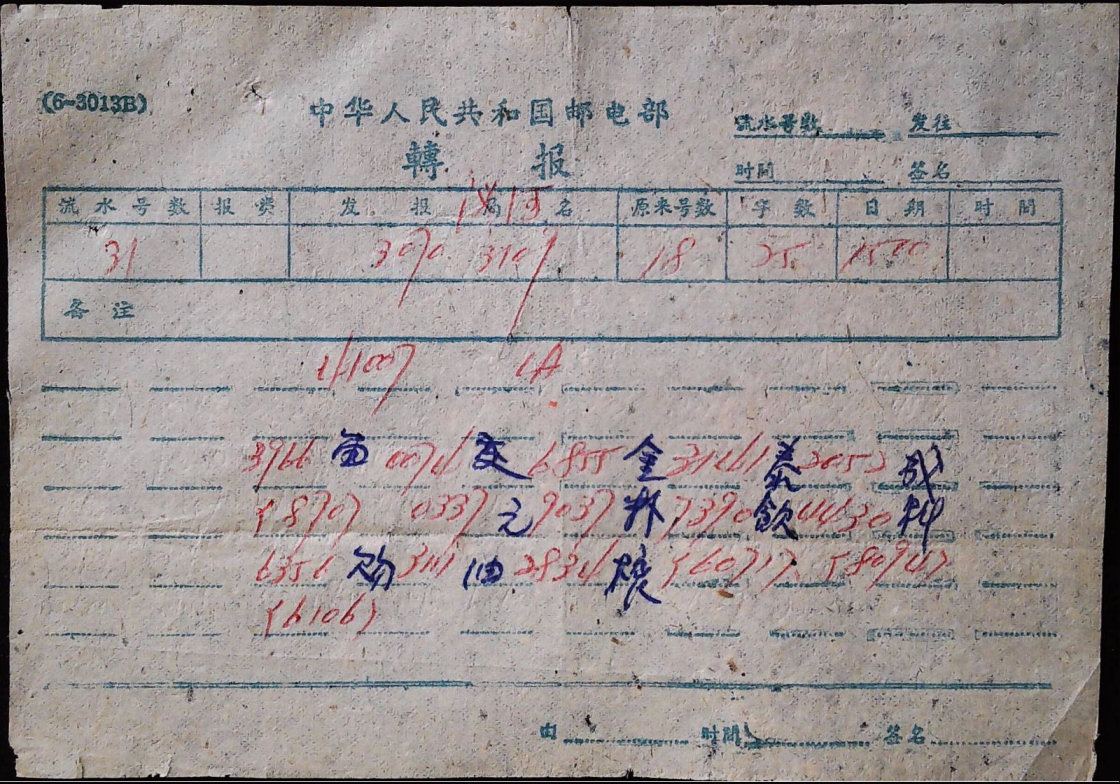
(Form 6-3013B)
Form 6-5012 - used 21-6-63 in 剑河, 员州 (Jianhe, Yuanzhou) - My Ref. CN-MPT-5012-63-6
At the top is "中华人民共和國邮电部" (Ministry of Posts and Telecommunications of the People's Republic of China)
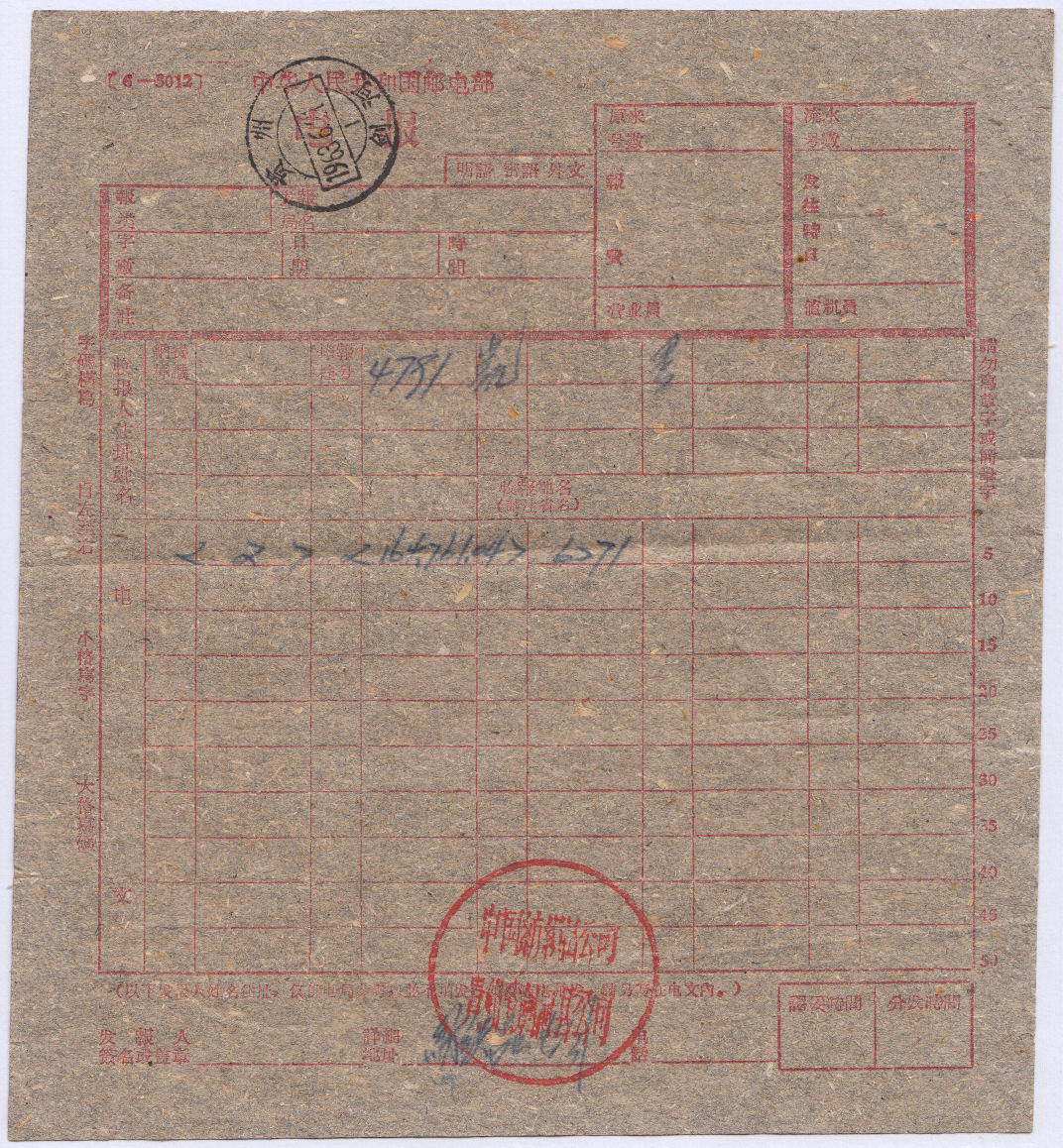
This is a very poor quality of paper, resembling 'chip-board' in consistency.
(Form 6-5012)
Another form 6-5012 - 21-11-63, 5 months after the one above, and used in the same place. - My Ref. CN-MPT-5012-63-3
There are a lot of differences, apart from the "paper". For one thing there is an imprint on the bottom-left side "(黔)63.3./5000x100"
That first character is Guizhou in the Guizhou dialect (贵州 in standard Chinese, Putonghua), so indicating where they were printed (on March 1963).
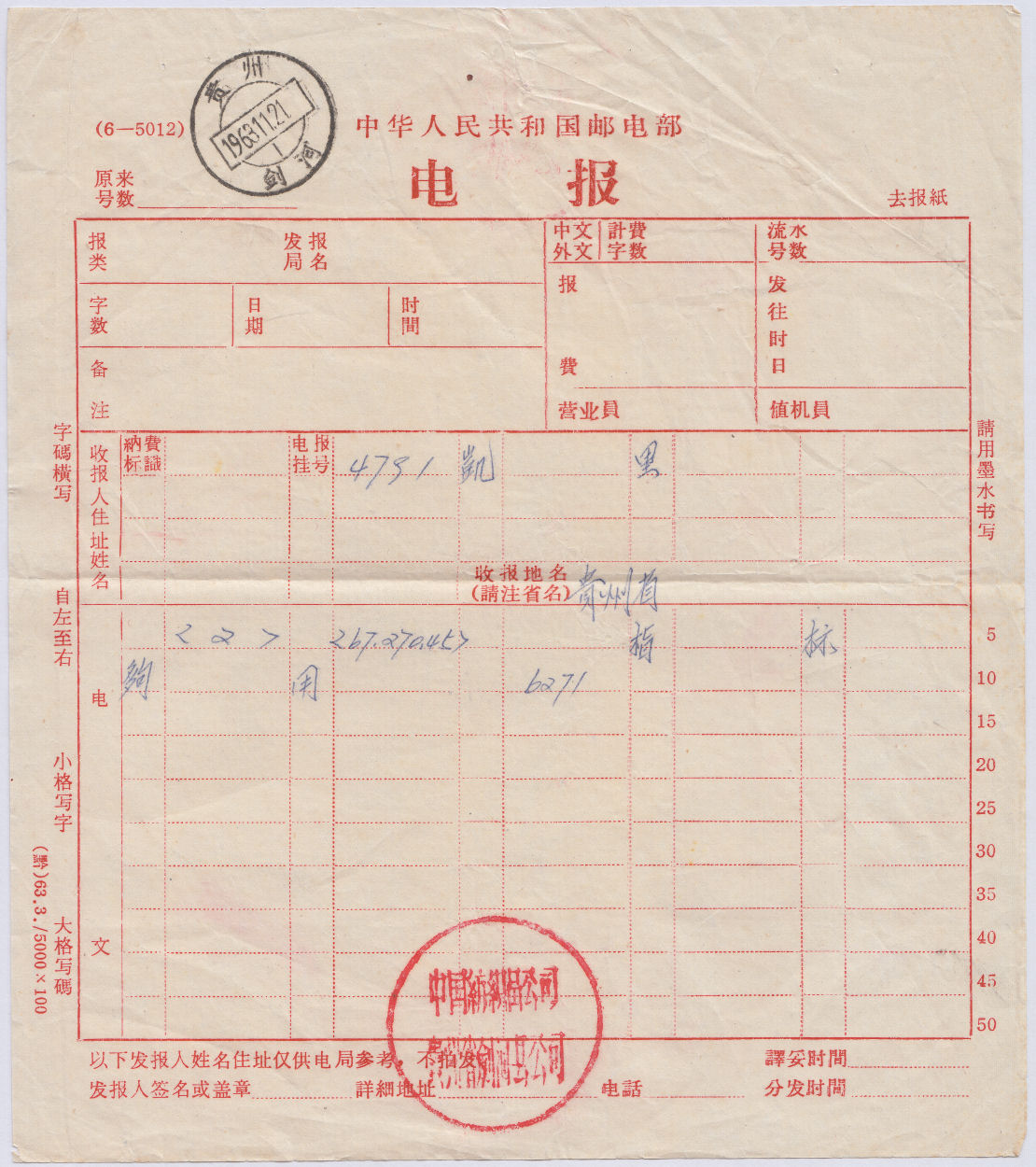
(Form 6-5012)
Form 电統3—A - 12-12-69 - My Ref. CN-MR-3-69-12
Top-left is a box labelled "毛主席語汞" (Chairman Mao's Words)
The form is headed "鉄道部 / 鉄路电报" = Ministry of Railways / Railway Telegraph
The cancel has "申樓電報所" or Shenlou Telegraph Office.
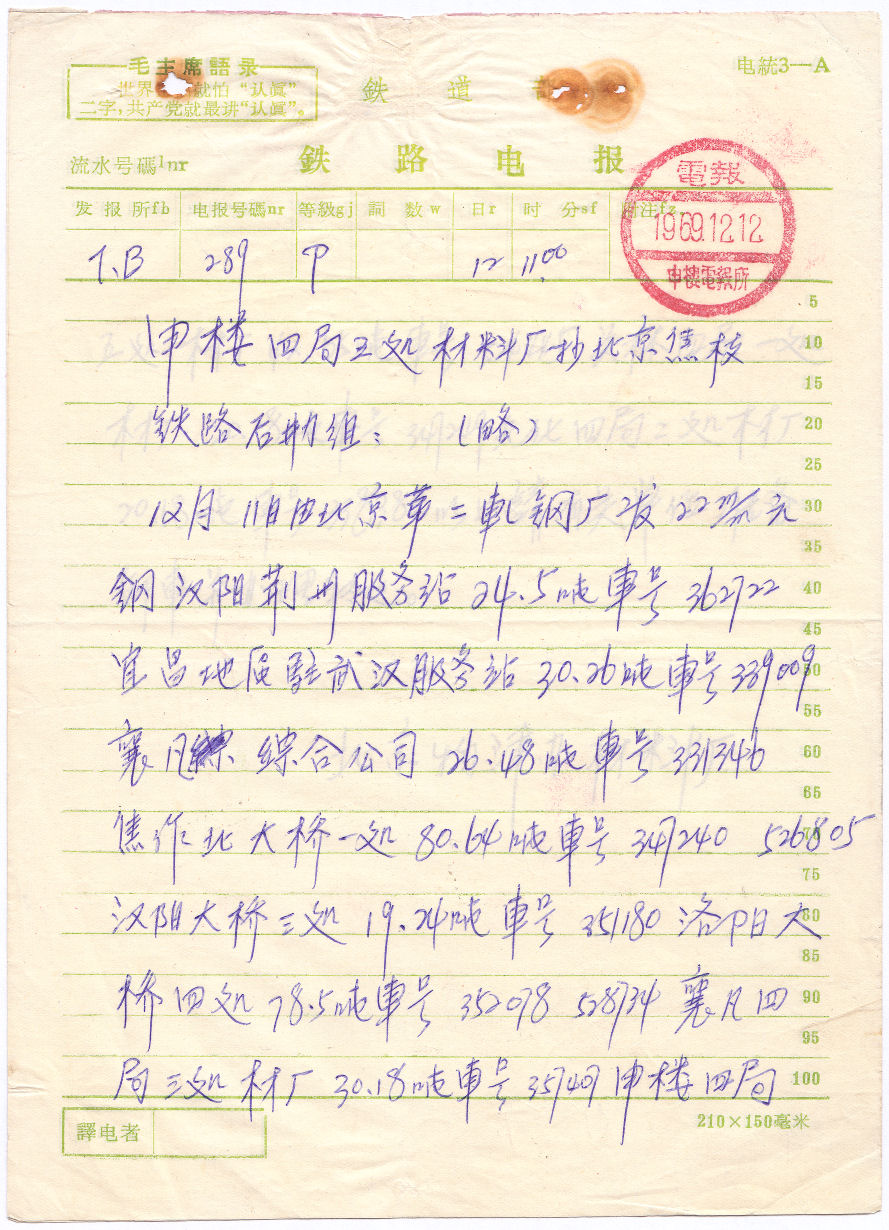
(Form 电統3—A)
Undated Sending Form (电1002) with the box labeled "发報局名" (Name of sending office), prefilled with Guangzhou (广州) - My Ref. CN-MPT-1002-GZ
The "收报地名" (Receiving place name) box has 江西 Jiangxi (province) with 景德镇 (Jingdezhen) after for the city name (市).
At the top is "中华人民共和國邮电部" (Ministry of Posts and Telecommunications of the People's Republic of China)
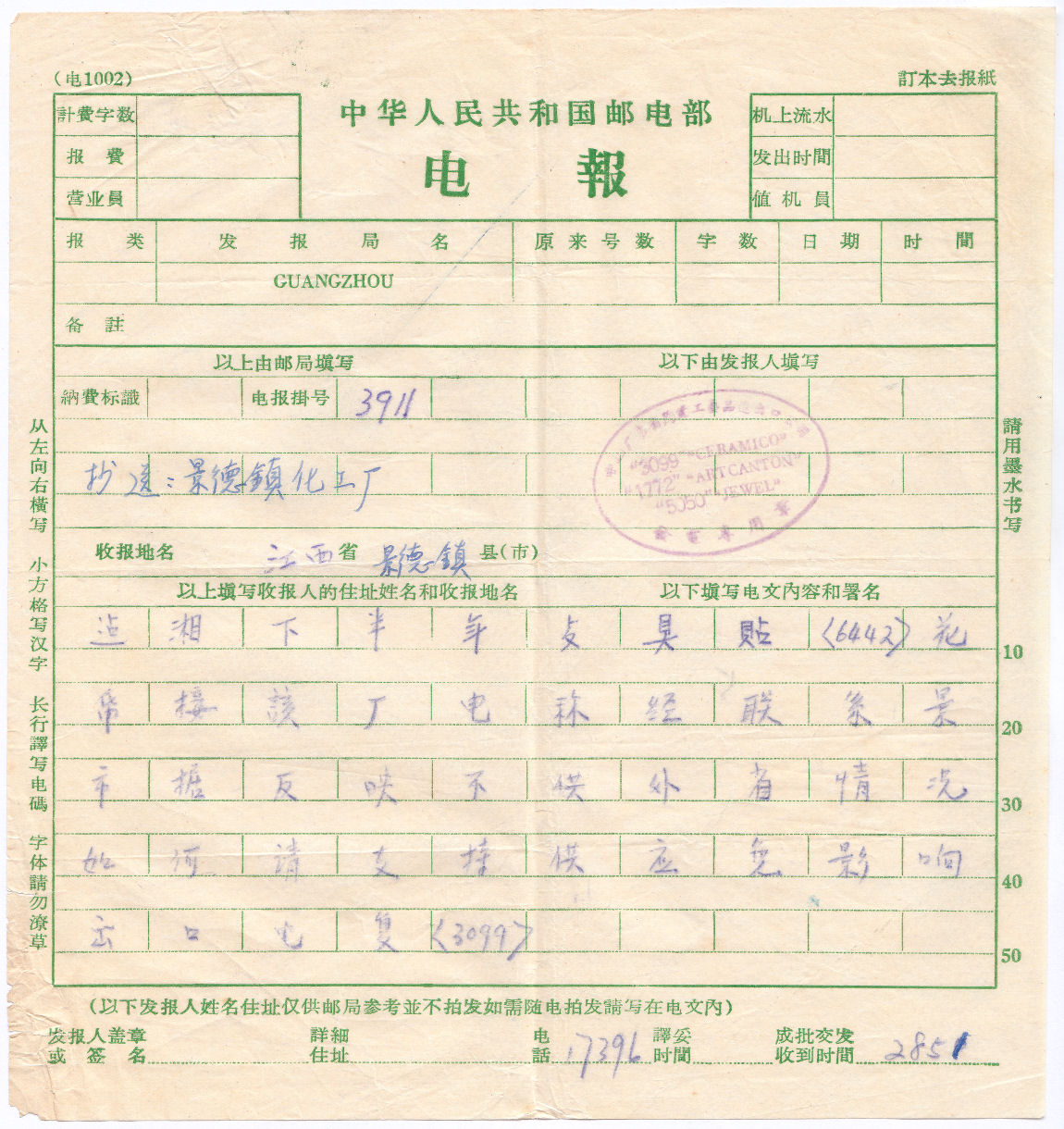
Sending Form (电1002)
Form (电1010)甲 used in 29-4-70 (Guangdong) - My Ref. CN-MPT-1010-70-4
The top says "最高指示: 备战, 备荒, 为人民." (Highest order: war preparations, counter natural disasters, for the people.)
Under that 中华人民共和国邮电部 (People's Republic of China Ministry of Posts and Telecommunications).
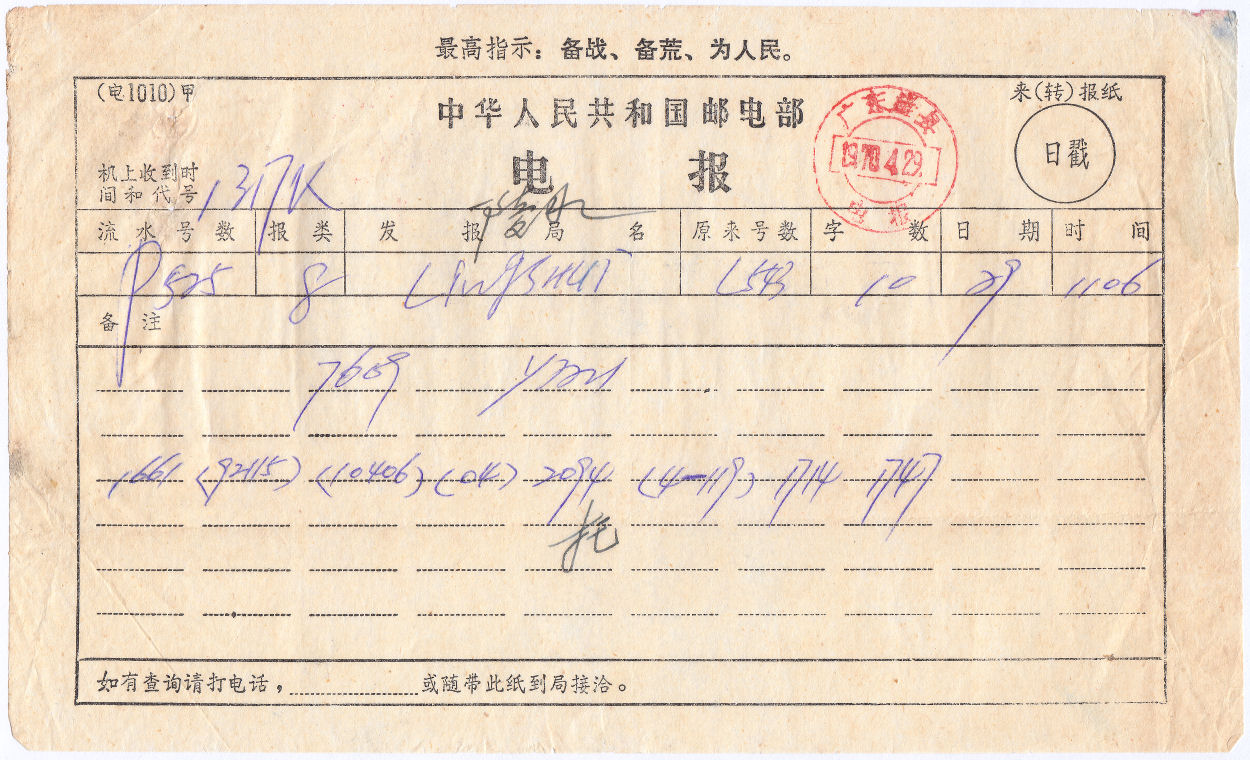
Form (电1010)甲
Undated Form 电1010乚 - My Ref. CN-MPT-1010-426
Marked "中华人民共和国邮电部" (People's Republic of China Ministry of Posts and Telecommunications).
The box at the top contains 毛主席语录 = Quotations from chairman Mao. This reads: "凡是敌人反对的, 我们就要拥护 ; 凡是敌 / 人拥护的, 我们就要反对."
which means "Wherever the enemy opposes, we must support it; wherever the enemy supports it, we must oppose it."
The box marked "流水号数" (Serial number) contains 426, as does the envelope below that contained it.
The box marked "发报局名" (Name of issuing office) contains "桂林" = Guilin.
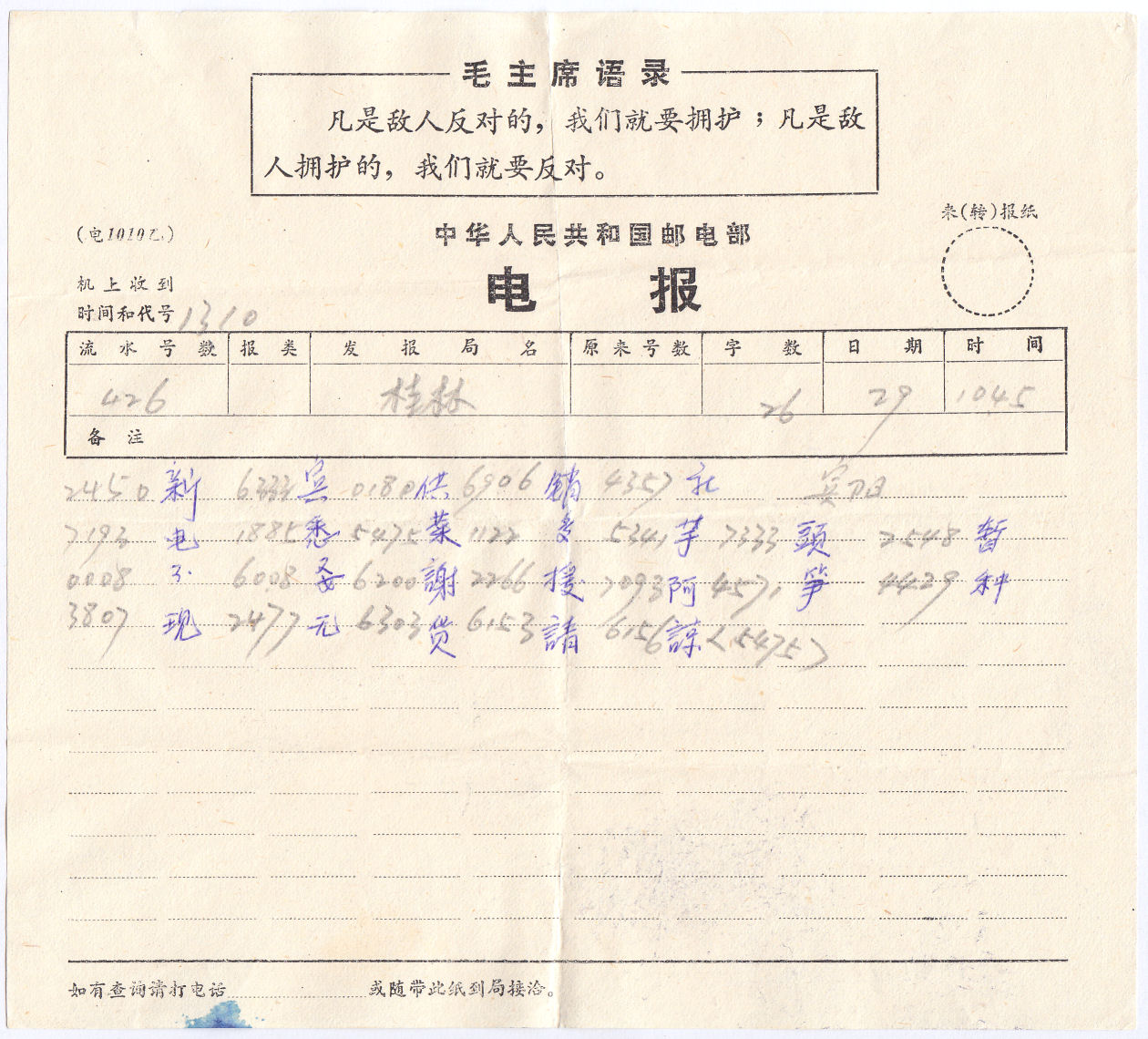
(Form 电1010乚) - This appears to have a place for a date-stamp, but neither this, or another similar, were stamped.
The form above was in this undated envelope with green edging at the top, as shown below :
This is also marked "426".
The box at the top contains a Quotation from chairman Mao.
Below the box is marked as People's Republic of China Ministry of Posts and Telegraphs
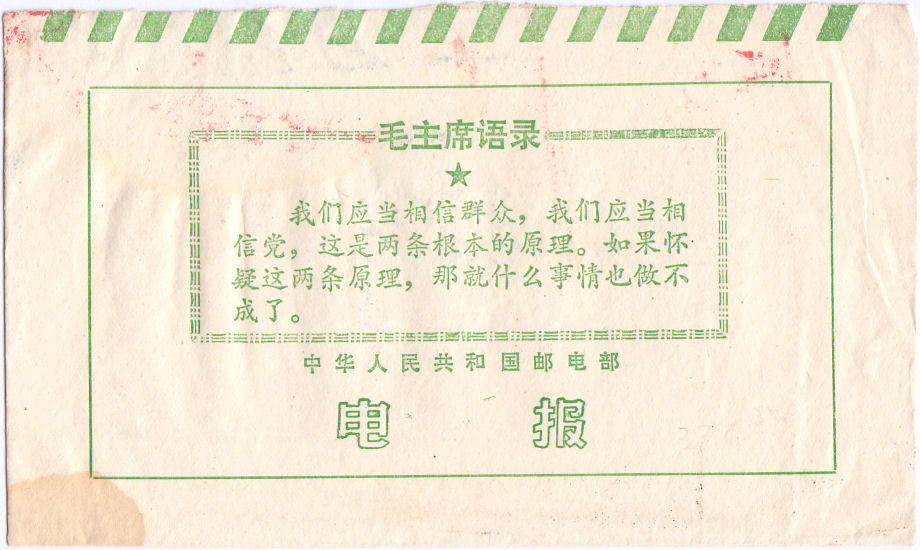
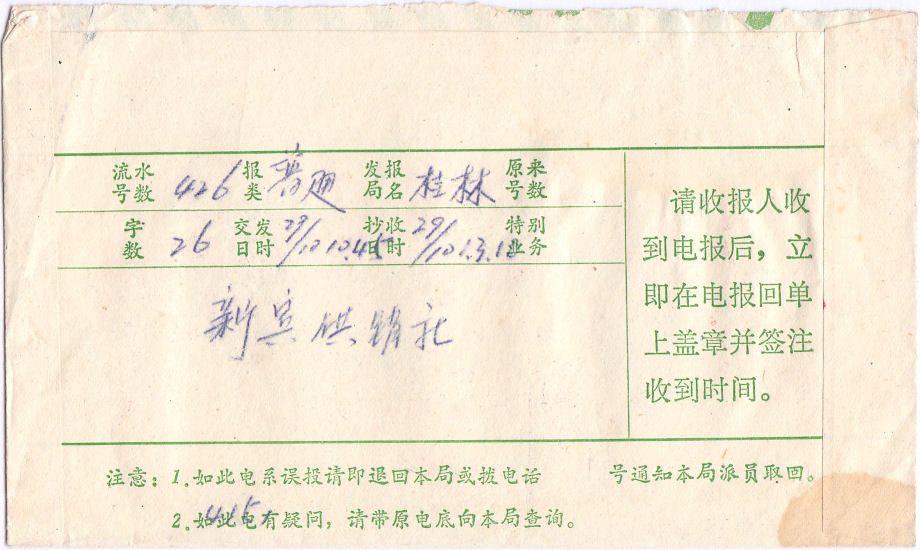
This section will probably be a "work in progress" for some time. Many have no date or form number.
Sometimes they can be tied to contents that have a date and/or form number, but often not.
I will tabulate them as it may help in cross-referencing things.
| P.R.C. Ministry of Posts and Telegraphs | - | ? | green | - | ? | Quotation from chairman Mao | CN-MPT-Env-MQ1 |
| China People's Posts and Telegraphs | 3016 | 4/5/1958 | green | - | ? | - | CN-CPPT-Env-3016-58-5 |
| P.R.C. Ministry of Posts and Telegraphs | YN ? | 27/9/1961 | green | - | Shanghai | Machine sealed - YN | CN-MPT-Env-YN-61-9 |
| P.R.C. Ministry of Posts and Telegraphs | 京拨4 ? | 25/8/1961 | green | Beijing ? | Beijing | 京拨4 | CN-MPT-Env-BJ4-64-8 |
| P.R.C. Ministry of Posts and Telegraphs | 电1015 | 26/9/1964 | black | - | Beijing | - | CN-MPT-Env-1015-64-9 |
| P.R.C. Ministry of Posts and Telegraphs | 电1015 | 16/1/1966 | black | - | Beijing | - | CN-MPT-Env-1015-66-1 |
| P.R.C. Ministry of Posts and Telegraphs | 电1015 | 16/1/1966 | green | Beijing ? | Beijing | BJY | CN-MPT-Env-1015-BJY-66 |
| P.R.C. Ministry of Posts and Telegraphs | 电1015 | 12/3/1966 | green | Beijing ? | Beijing | BJY | CN-MPT-Env-1015-BJY-66 |
| P.R.C. Ministry of Posts and Telegraphs | 电1015 | 19/8/1967 | red | - | Shanghai | Machine sealed, YN, Mao quote | CN-MPT-Env-1015-YN-MQ1 |
| P.R.C. Ministry of Posts and Telegraphs | - | 23/6/1960 | red | Shanghai | Shanghai | Machine sealed, | CN-MPT-Env-SH-2 |
| P.R.C. Ministry of Posts and Telegraphs | 电1015 | ? | red | - | Shanghai | Machine sealed, YN, quote | CN-MPT-Env-1015-YN-Q2 |
| P.R.C. Ministry of Posts and Telegraphs | 电1016 | 12/1964 | black | - | Beijing | (12)64. | CN-MPT-Env-1016-64-12 |
| China People's Telegraphs | - | 16/4/1985 | green | Shanghai | Shanghai | - | CN-CPT-Env-SH-85-4 |
| China People's Telegraphs | 电1201 | 27/8/1985 | red | - | ? | - | CN-CPT-Env-1201-85-8 |
| P.R.C. Ministry of Posts and Telegraphs | 电1201 | 22/3/1991 | red | - | Beijing | from Erewan | CN-MPT-Env-1201-91-3 |
| China People's Telegraphs | 电1201 | 11/9/1991 | red | - | Beijing | from Erewan | CN-CPT-Env-1201-91-9 |
| China People's Telegraphs | 电1201 | 16/5/1987 | green | - | Zhijiang, Hunan | - | CN-CPT-Env-1201-87-5 |
| China People's Telegraphs | 电1201 | 6/6/1991 | green | - | Beijing | from Erewan | CN-CPT-Env-1201-91-6 |
| China People's Telegraphs | - | ? | blue | Shanghai | Shanghai | Letter M | CN-CPT-Env-blue-SH-M1 |
| P.R.C. Ministry of Posts and Telegraphs | 电1201 | 6/6/1991 | green | - | Beijing | from Erewan | CN-MPT-Env-1201-92-2 |
| P.R.C. Ministry of Posts and Telegraphs | - | 16/10/80? | black | - | Hefei, Anhui. | Machine sealed, Mao quote | CN-MPT-Env-80-10-Q3 |
| P.R.C. Ministry of Posts and Telegraphs | 电2019 | ? | black | - | ? | 'pouch type' with a flap | CN-MPT-Env-2019 |
| P.R.C. Ministry of Posts and Telegraphs | - | ? | red | - | Hankou | uses an obsolete 华 | CN-MPT-Env-HK |
| F. P. S. | 电1201甲 | May 1988 | green | - | ? | Negative Star, CH075-5 1988年 | CN-FPS-Env-1201-1988 |
| F. P. S. | 电1201 | ? | green | - | ? | pouch and Mongolian script | CN-FPS-Env-1201-Mon-1 |
| F. P. S. | 电1201 | 25/4/1991 | green | Beijing | Beijing | from Erewan | CN-FPS-Env-1201-91-4 |
| F. P. S. | 电1015 | ? | blue | - | Shanghai | Machine sealed | CN-FPS-Env-1015-blue-1 |
| F. P. S. | - | 14/2/1997 | green | Guangzou | Guangzou | Machine sealed, bar-coded | CN-FPS-Env-GZ-1 |
| F. P. S. | - | ? | red | Guangzou | Guangzou | Urgent | CN-FPS-Env-GZU-1 |
| F. P. S. | - | 3/12/1991 | green | - | ? | plastic envelope | CN-FPS-Env-1201-91-12 |
This undated envelope with no form number, is repeated from just above. - My Ref. CN-MPT-Env-MQ1
The box at the top contains 毛主席语录 = Quotations from chairman Mao. This reads:
我们应当祖信群众, 我们应当祖信党, 这是两条裉本的原理. 如果怀疑这两条原理, 那就什么事情也做不成了.
Which translates as :
"We should believe in the masses, and we should believe in the party. These are two fundamental principles. If you doubt these two principles, then nothing can be done. "
Below the box, 中华人民共和国邮电部 = People's Republic of China Ministry of Posts and Telegraphs


Form 3016 - Date? The form appears to be from a printing of 120,000 on 4 May 1953 - My Ref. CN-CPPT-Env-3016-58-5
The top is marked "中國人民郵電" = Post and Telegraph of P.R.C.
Below that is "城市與鄉村聯繫 , 請用 :" = "To contact the city and the county, please use :"
Below that is "郵轉電報" or "Postal
Telegram". Below that is :
迅速準確 (Fast and accurate); 可靠便利 (Reliable and convenient); 電報傳送 (Telegraph transmission); 掛號郵遞 (Registered mail)
鄉村小鎮 (Villages & towns); 都能通達 (accessible) ; 各郵電局 (Post & Telegraph Offices); 圴可辧理 (Manageable)
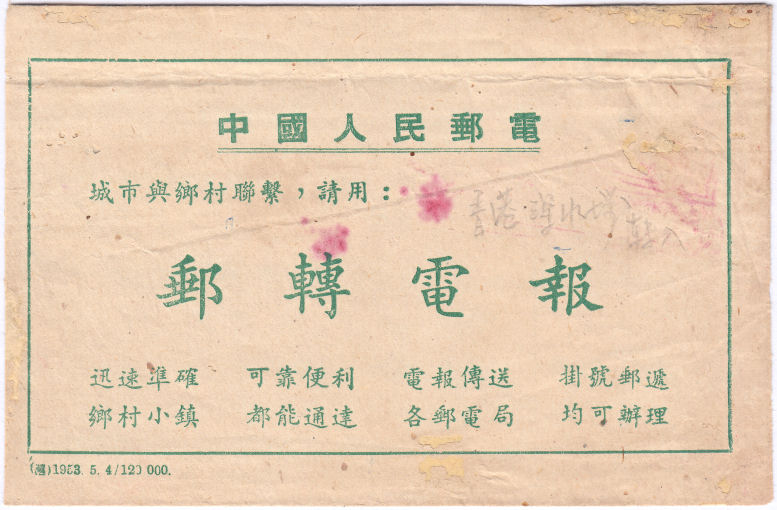
The bottom has an imprint of "(?)1953. 5.4/120,000."
My ? above is because the character is not in the font. I am told it has been replaced by 乡(simplified, which is 鄉 traditional and translates as "village or town".
On the back : Top-left is the Form number 3016, with below "郵轉電報" repeated followed by brackets containing : 報賈巳照國丙電報價目 / 收賈 , 不另加收郵遞資 / 賈 , 并免收譯賈。
meaning "The price of telegrams is charged in accordance with State prices of telegrams. There is no additional charge for postal services, and the translation charge is waived.".
Below that on the left is : "人民郵電 , 為人民服務 。 歡迎各界利用和 批評 !" or
"People's posts and telegraphs, serving the people. Welcome to use and criticize from all walks of life!"
On the right of that is "電報號數" (Number of telegram); followed by "發報局名" (Name of issuing office) which has "洙市步", 洙市 is a city in Jiangsu. 步 I think means near.
And below that is : "收報人姓名住址" (Recipient's name and address)
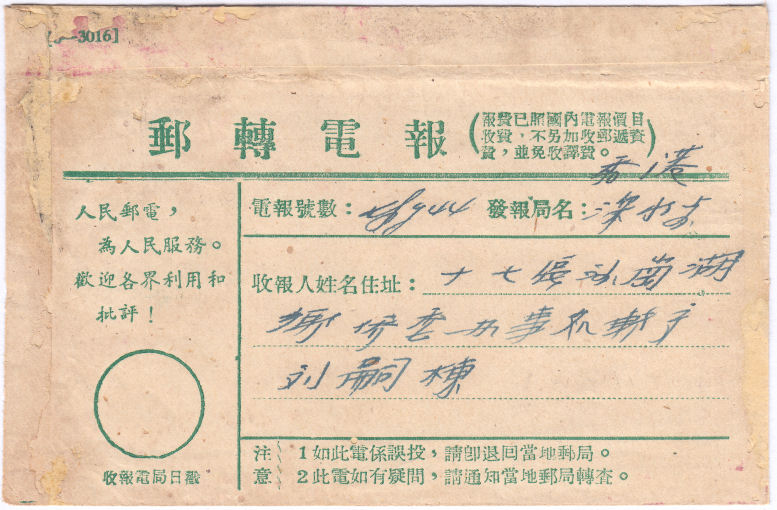
Form 3016
Used 27-9-1961 in Shanghai. - My Ref. CN-MPT-Env-YN-61-9
Machine sealed - front, back and contents.
中华人民共和国邮电部 = People's Republic of China Ministry of Posts and Telegraphs
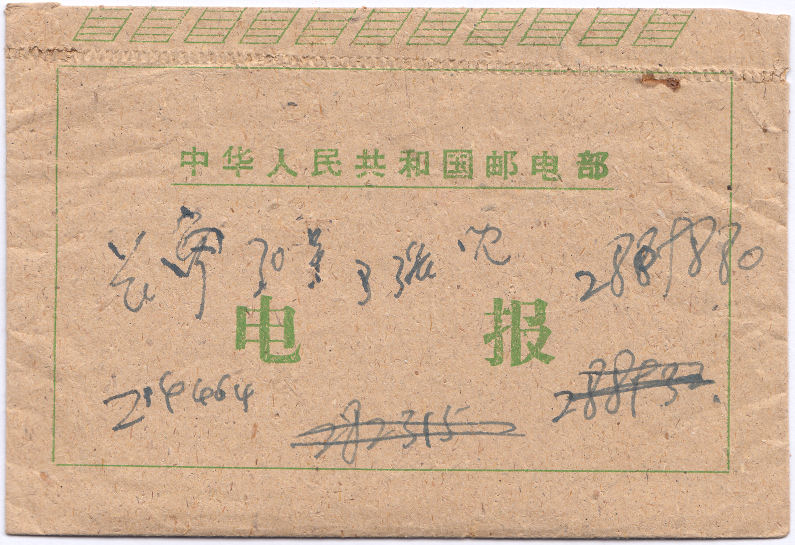
Top-left of the back is marked "电报号数: YN" (Number of telegram: YN)
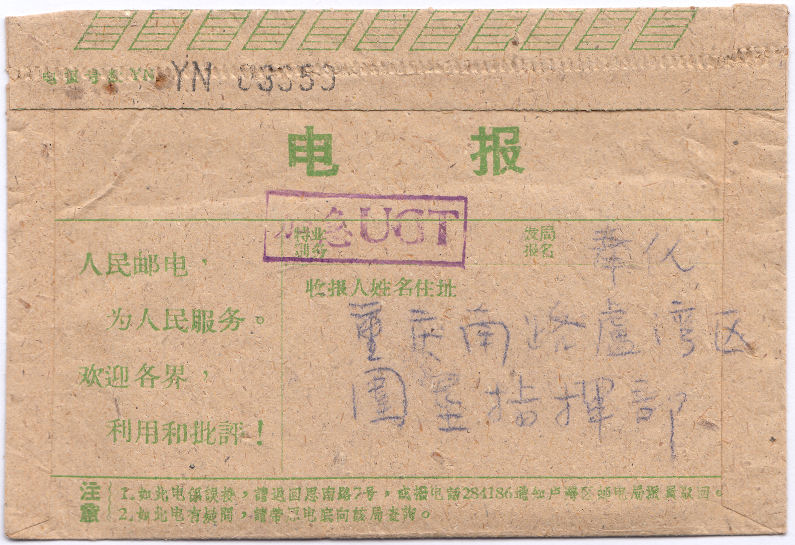
It contained the following, both are stamped UGT :
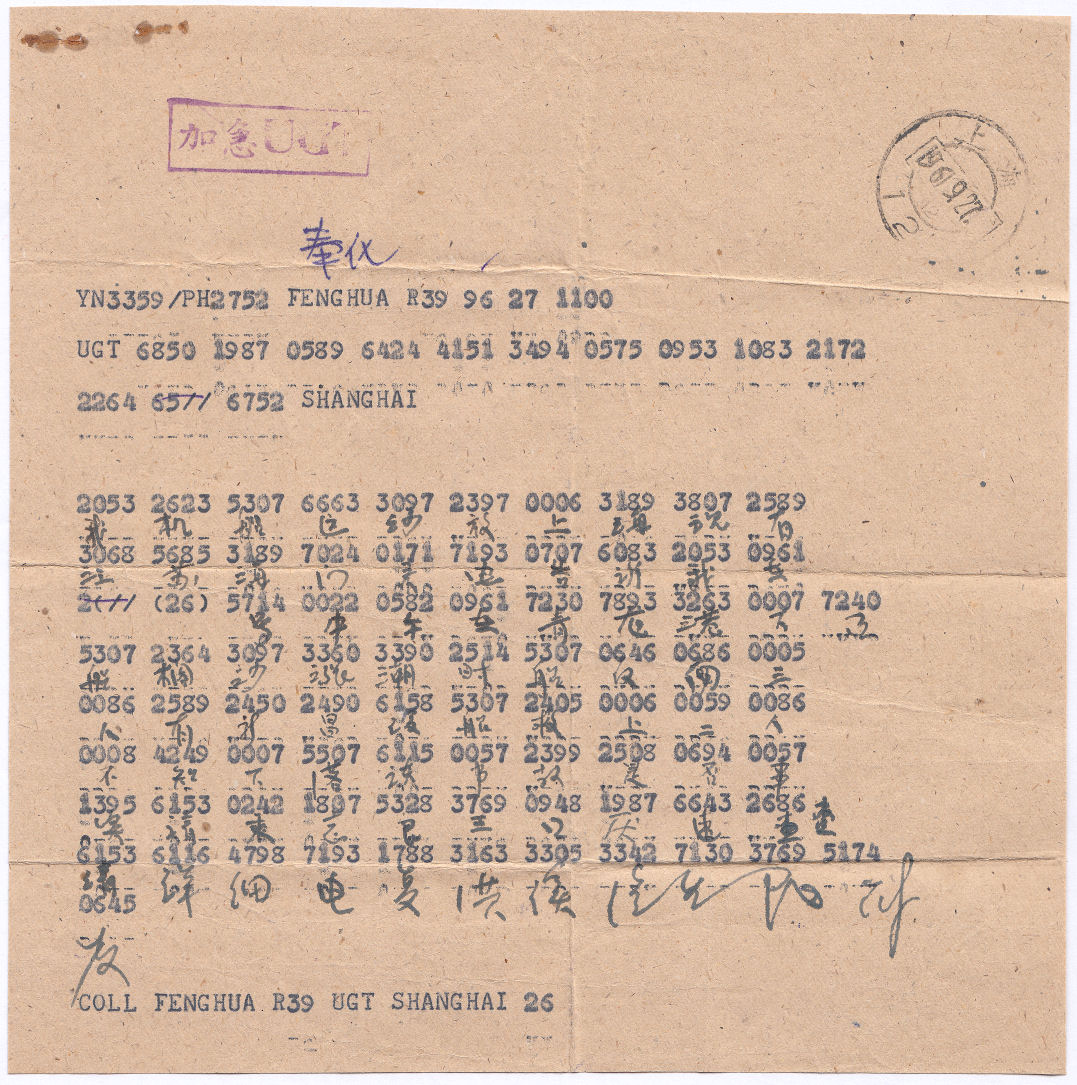
25-8-64 - My Ref. CN-MPT-Env-BJ4-64-8
中华人民共和国邮电部 = People's Republic of China Ministry of Posts and Telegraphs
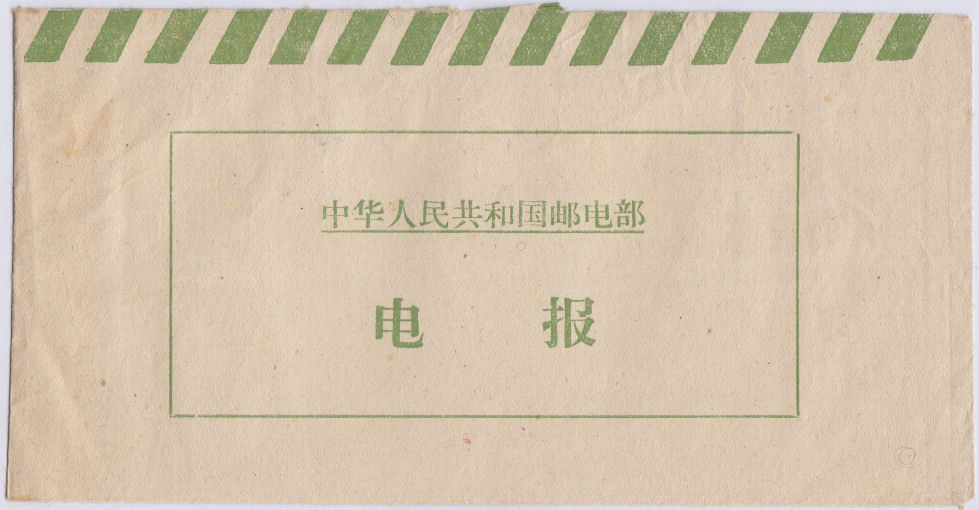
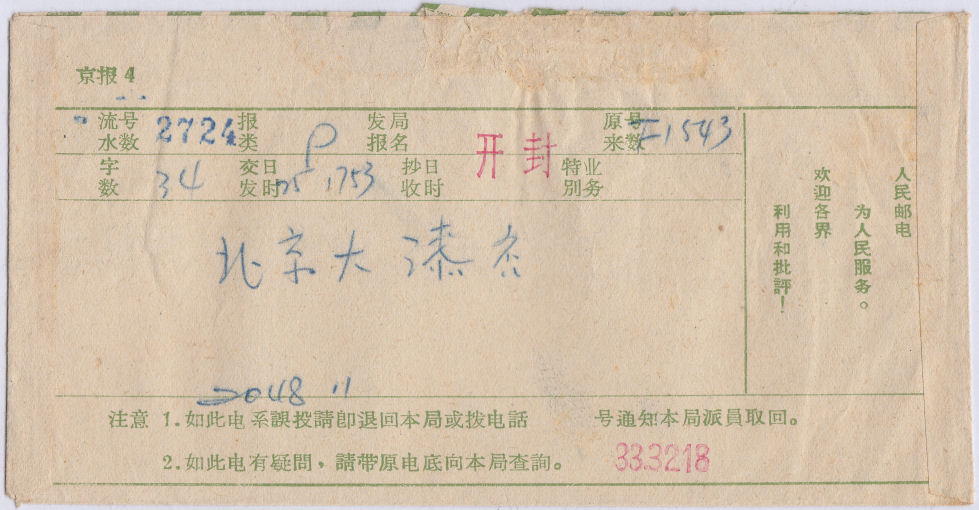
京拨4 at top-left (Beijing Dial 4)
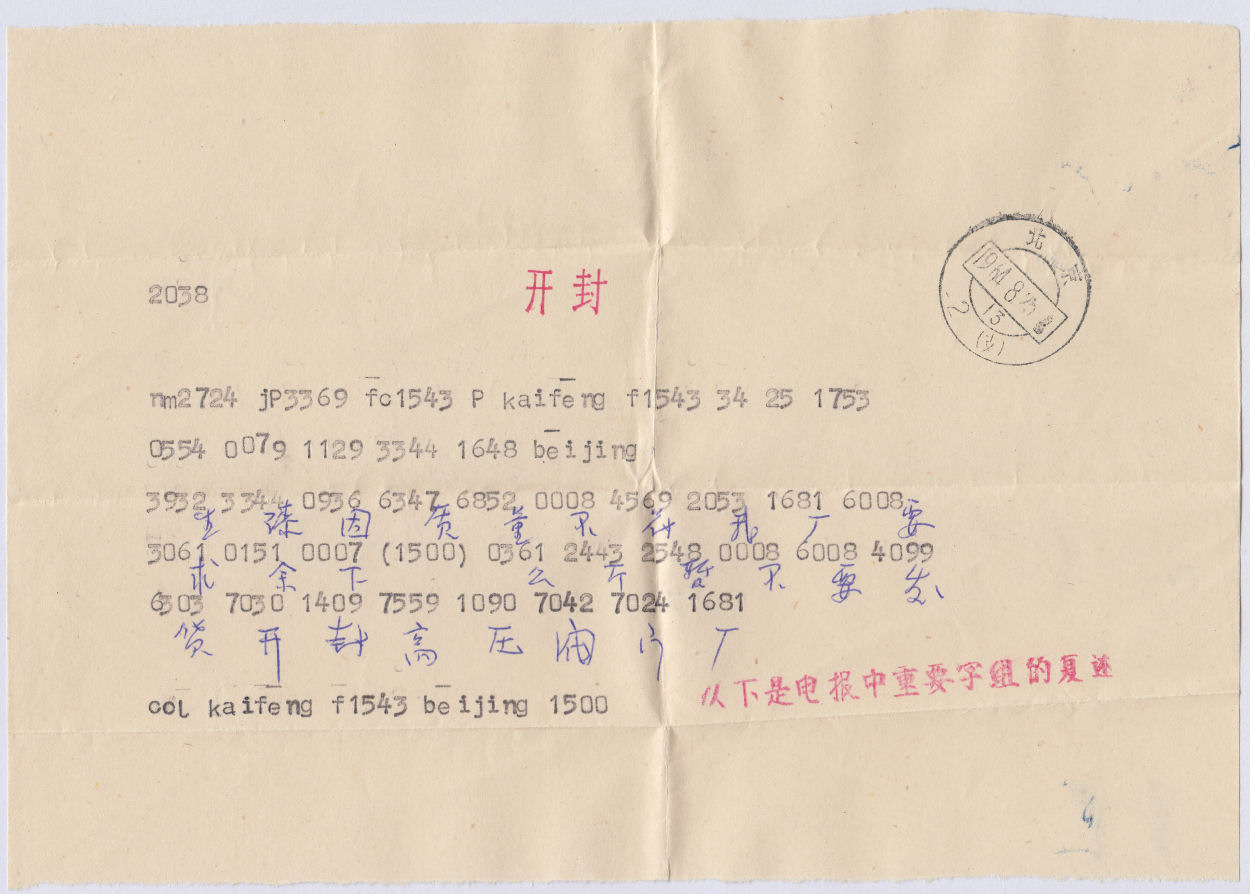
Form 电1015. - 26 September 1964 - Black lettering and edging. - My Ref. CN-MPT-Env-1015-64-9
People's Republic of China Ministry of Posts and Telegraphs
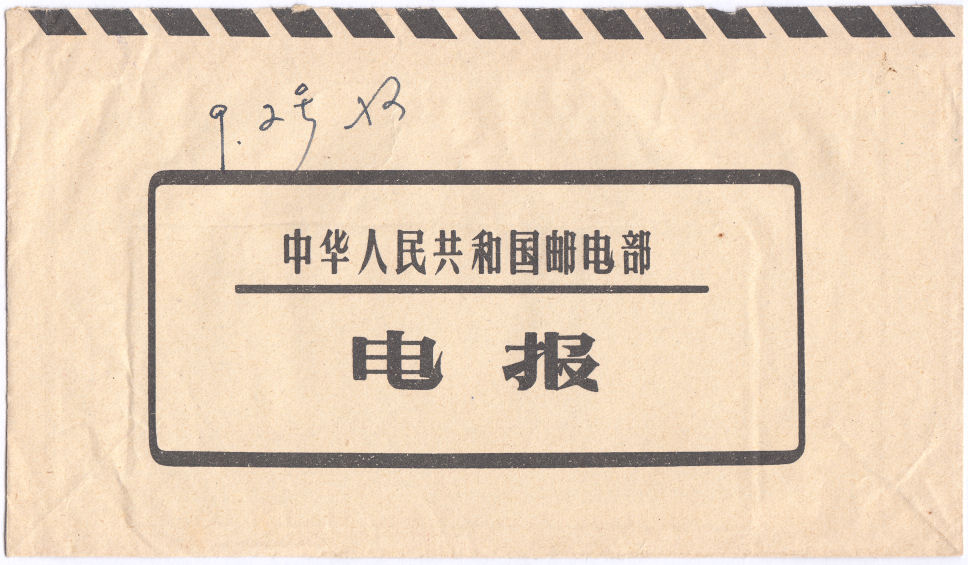
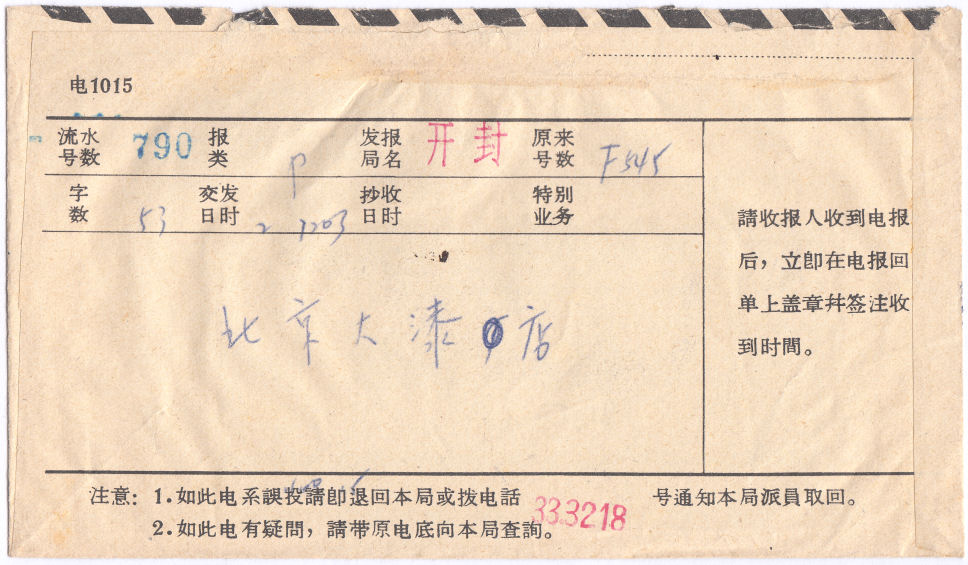
The enclosure (half-size below) is (probably)dated 26/9/1964. Form 电1015.
Form 电1015. - 16-1-66 black edging at the top. - My Ref. CN-MPT-Env-1015-66-1
People's Republic of China Ministry of Posts and Telegraphs
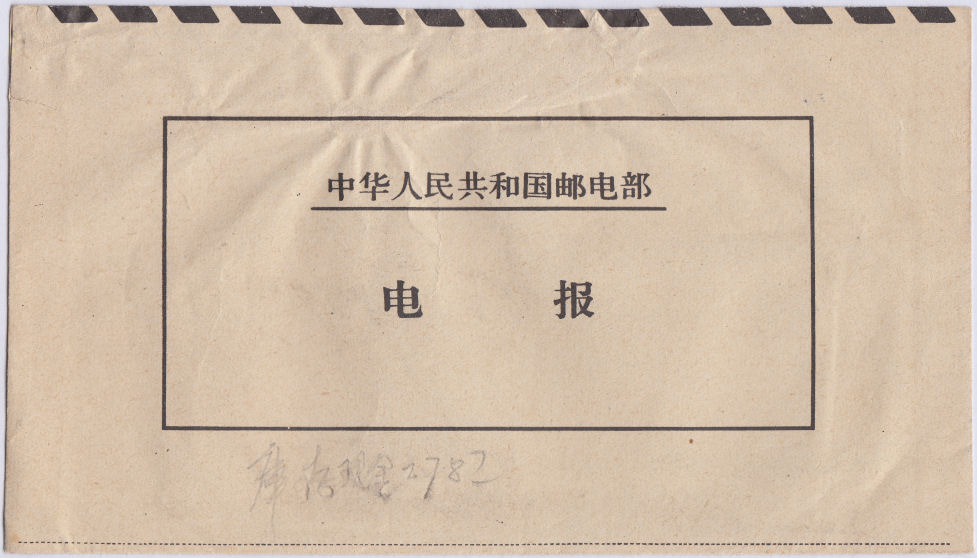
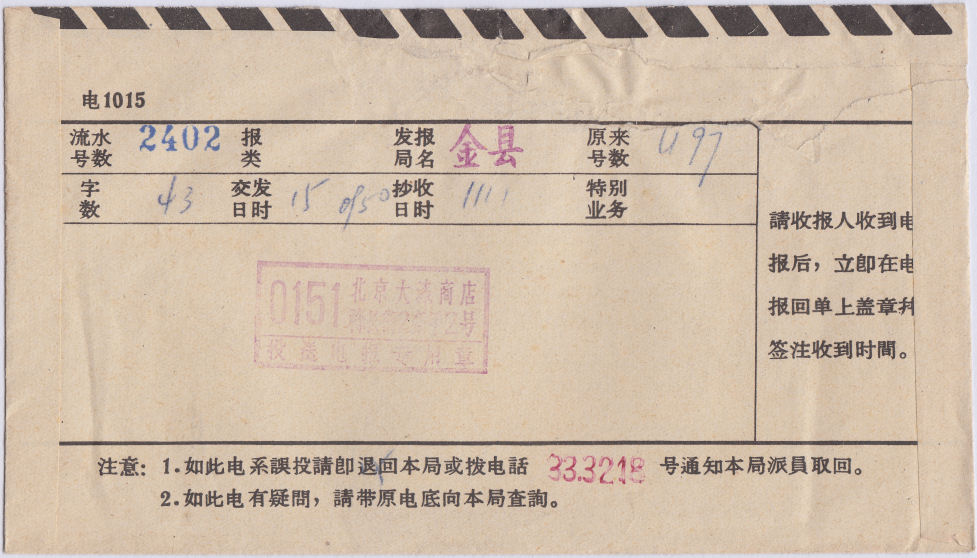
Form 电1015.
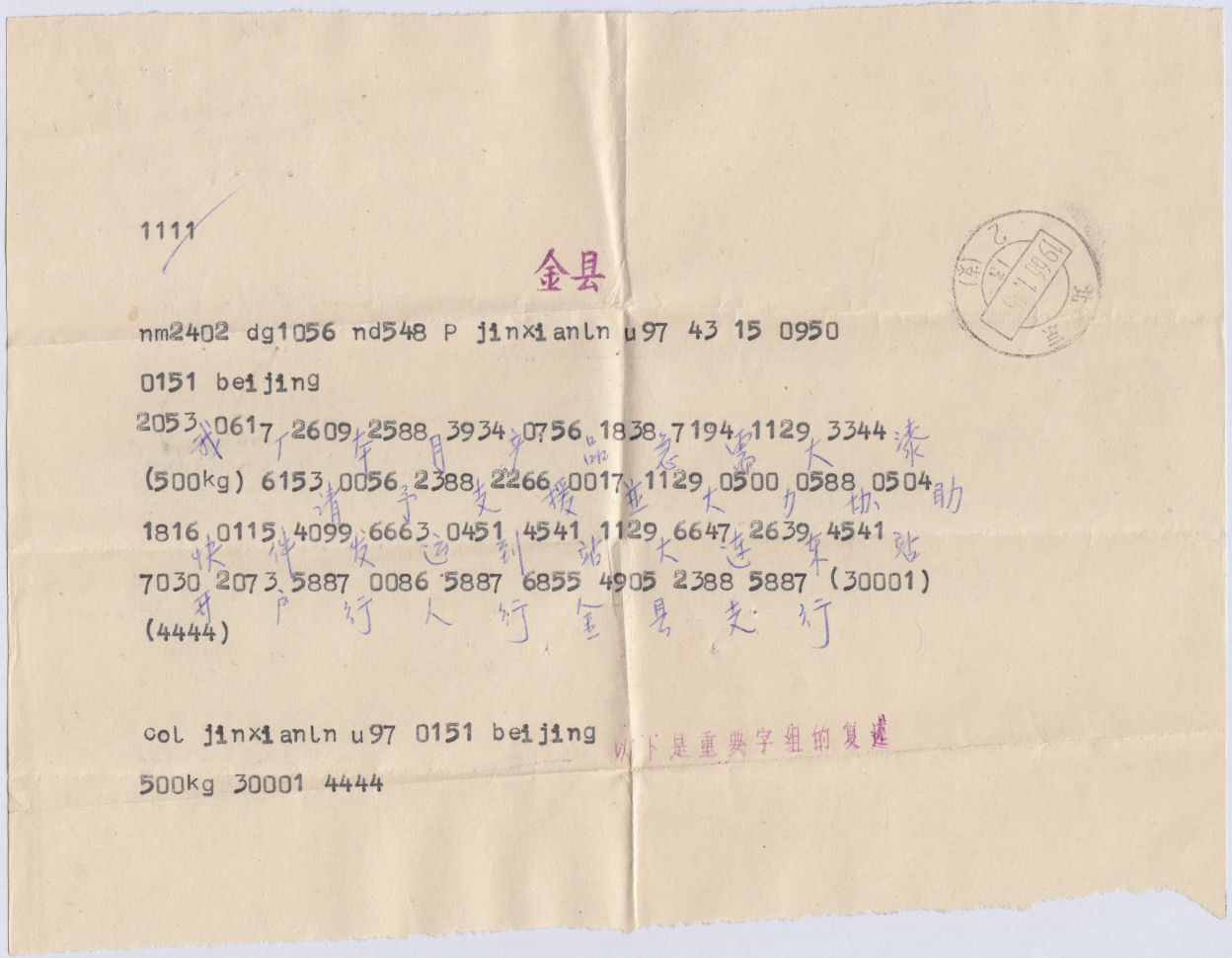
电1015 - 19-9-66 - Green lettering and edging. - My Ref. CN-MPT-Env-1015-BJY-66
People's Republic of China Ministry of Posts and Telegraphs
BJY in oval added on the front at bottom-right.
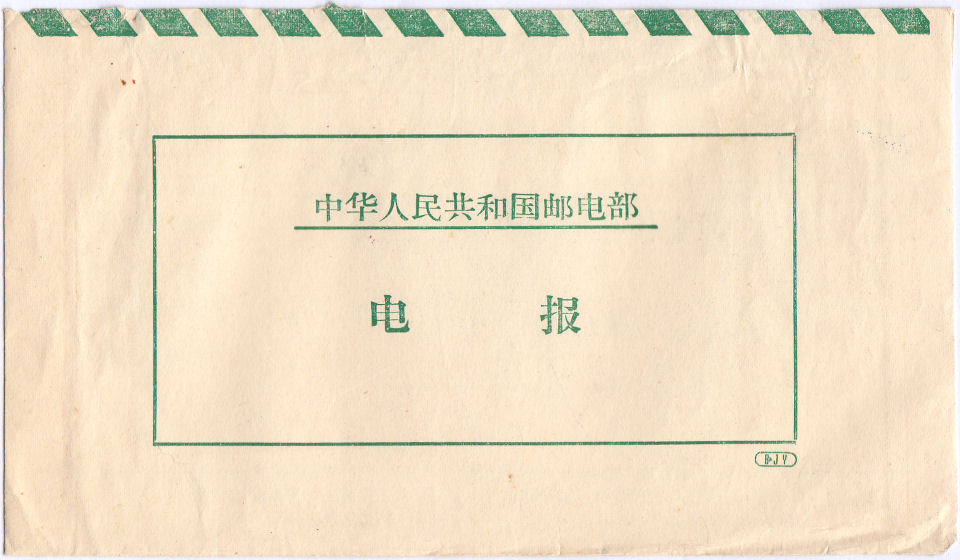
Under the flap at top-left on the back is 电1015
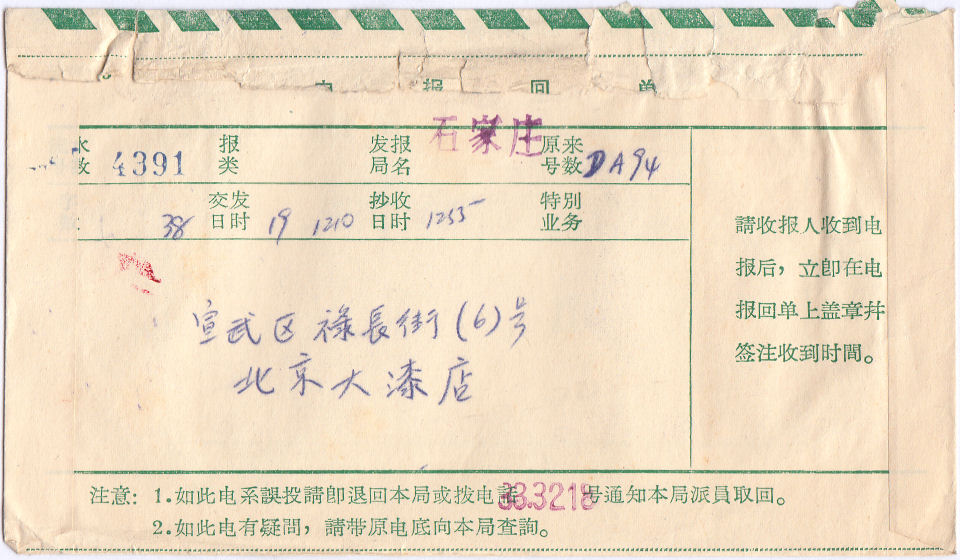
The enclosure has the number 1255, matching the envelope. It is from 石家圧 and has a Beijing handstamp of 19 Sepember 1966.
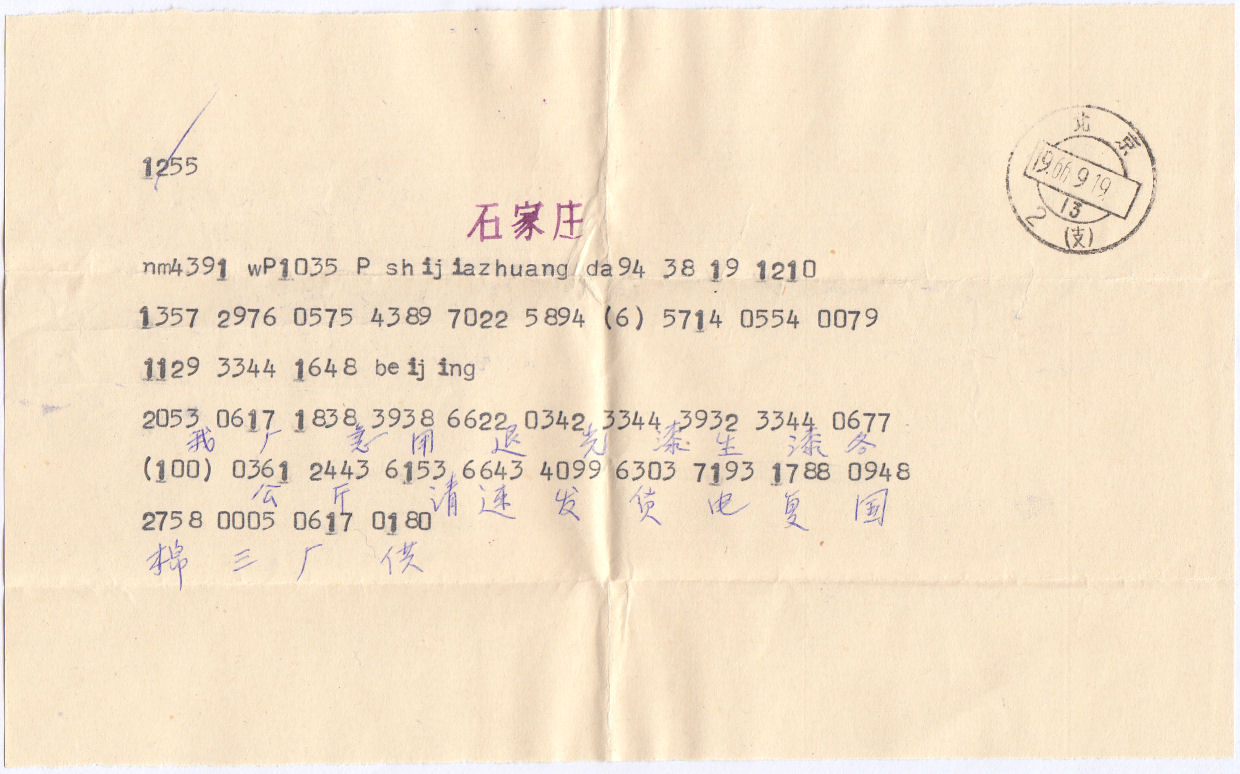
电1015 - Another BJY in oval example. - My Ref. CN-MPT-Env-1015-BJY-66
People's Republic of China Ministry of Posts and Telegraphs
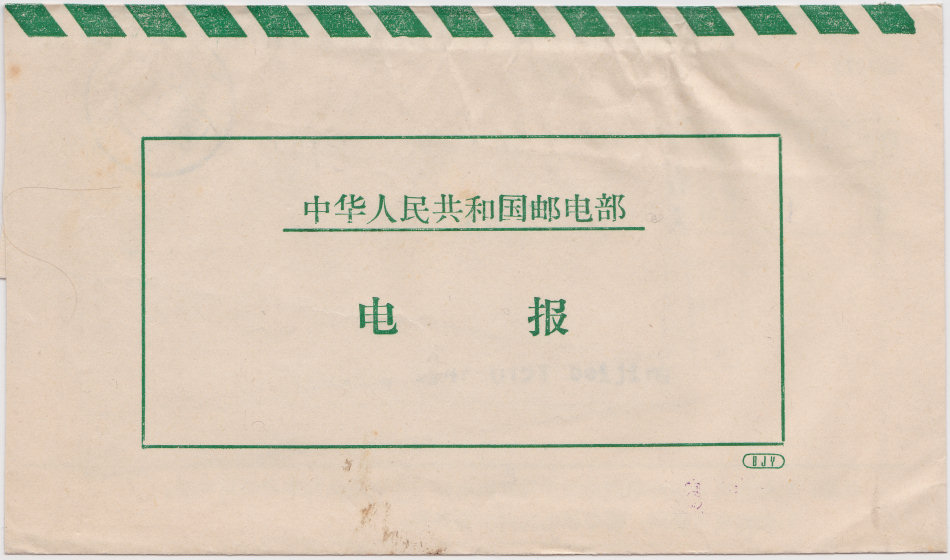
Partially under the flap at top-left on the back is 电1015
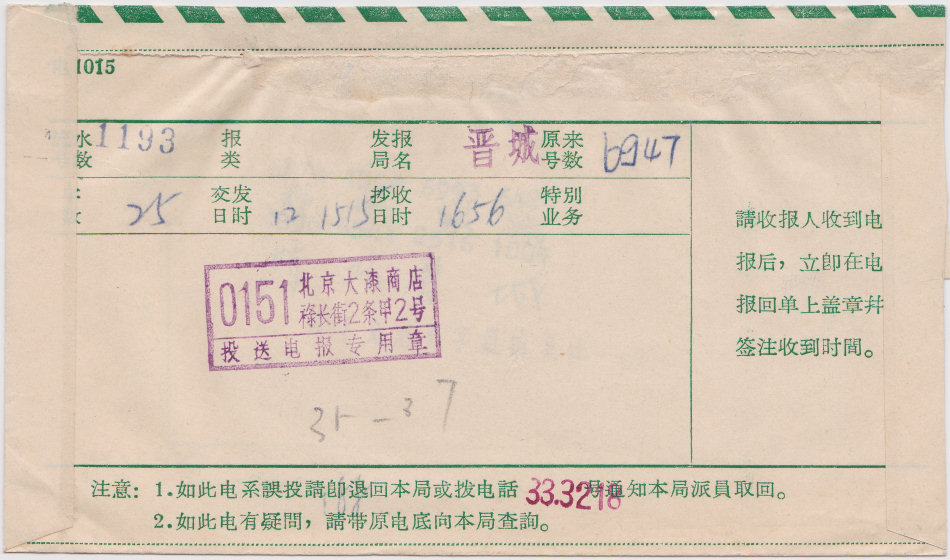
The large purple boxed mark with "0151" is on a number of my envelopes, but this is the clearest, so I will give the details :
The 3 lines of text read "北京大 漆商 店 / 祿长街2条甲2号 / 投送电报专用章"
or "Beijing Paint Shop / No. 2, Section 2, Lu Chang Street / Special chop for sending telegrams"
The enclosure has the number 1656, matching the envelope. It is from 晋城 (Jincheng, Hebei) and has a Beijing handstamp of 12 March 1966.
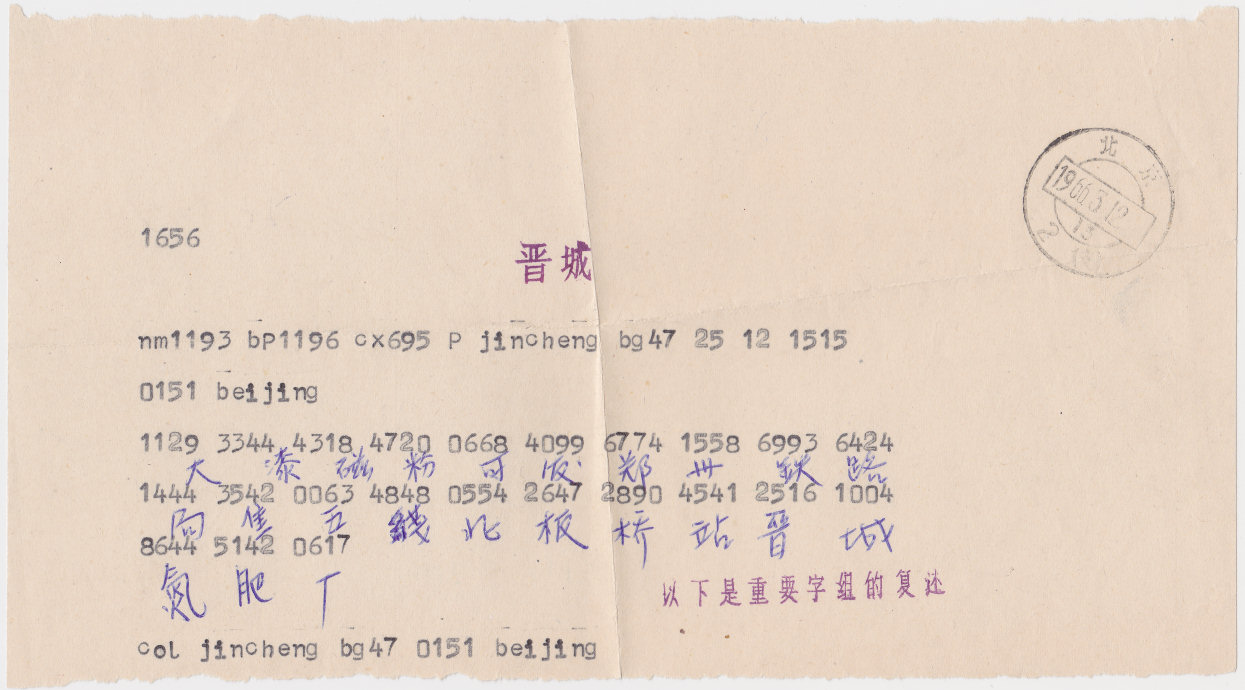
电1015 in Red - 19 August 1967 with a novel sealing mechanism. - My Ref. CN-MPT-Env-1015-YN-MQ1
In the box it says :
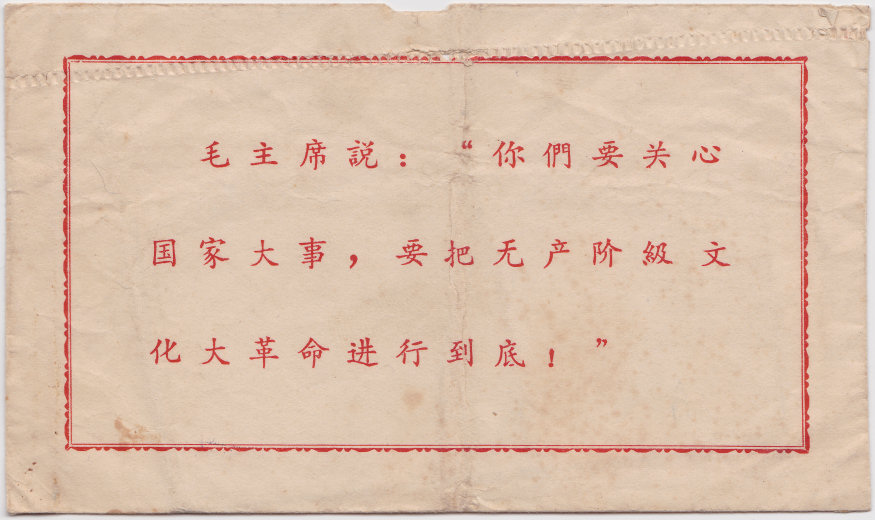
"YN" on the back as well as 电(1015)
People's Republic of China Ministry of Posts and Telegraphs also on the back.
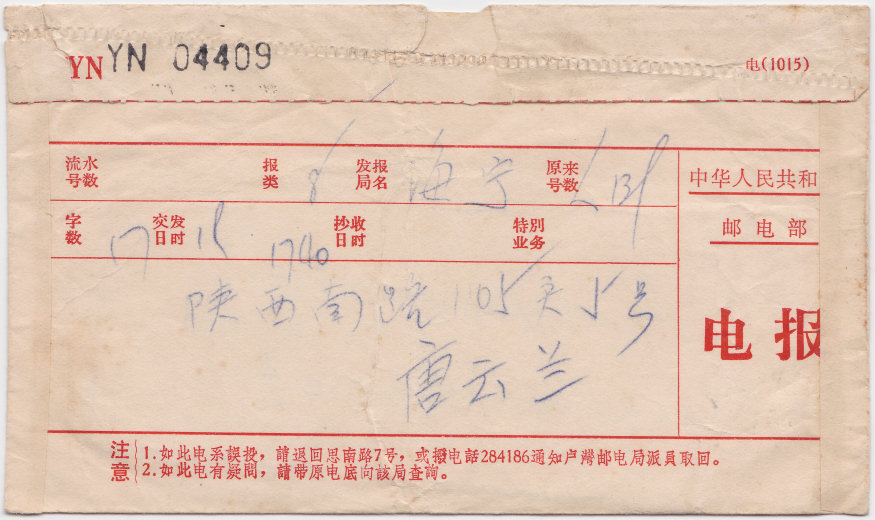
The enclosure has the number 1905, but unfortunately the number is not filled in on the envelope unless it should have been YN04409. However, both 海宁 and 庽云兰 are matched on both.
It has a Shanghai handstamp of 19 August 1967.
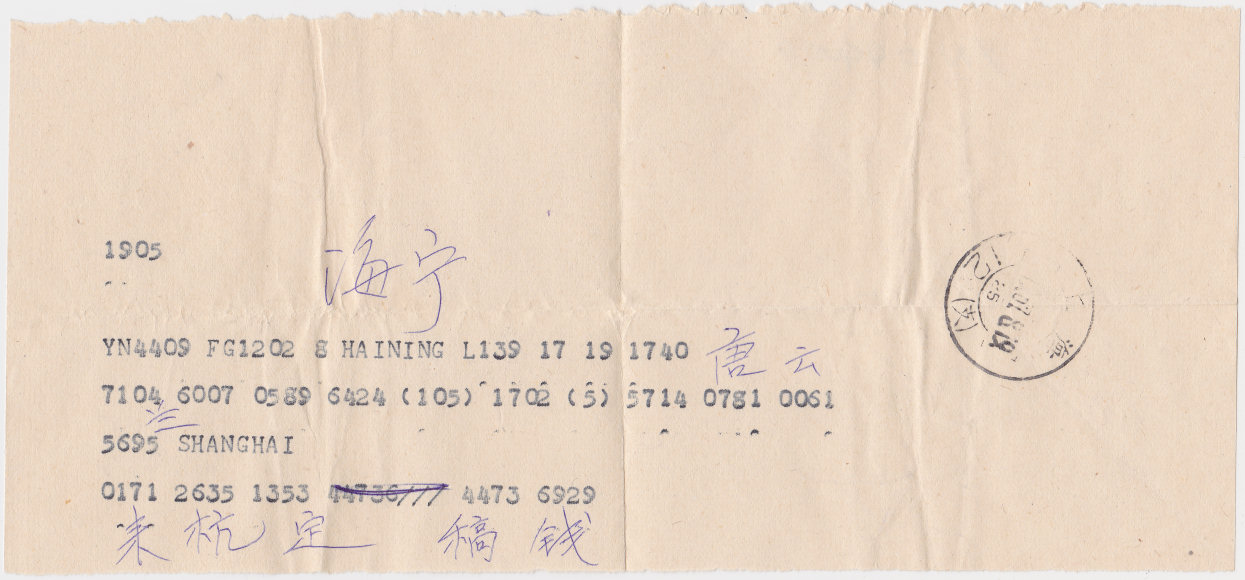
Undated - 电1015 in Red with a novel sealing mechanism still, but new phrase on front - My Ref. CN-MPT-Env-1015-YN-MQ1
with the box headed : "最高指示" or "Highest instruction". The contents read :
Though this sounds like it might be more of Chairman Mao's words, it is not actually attributed to him.
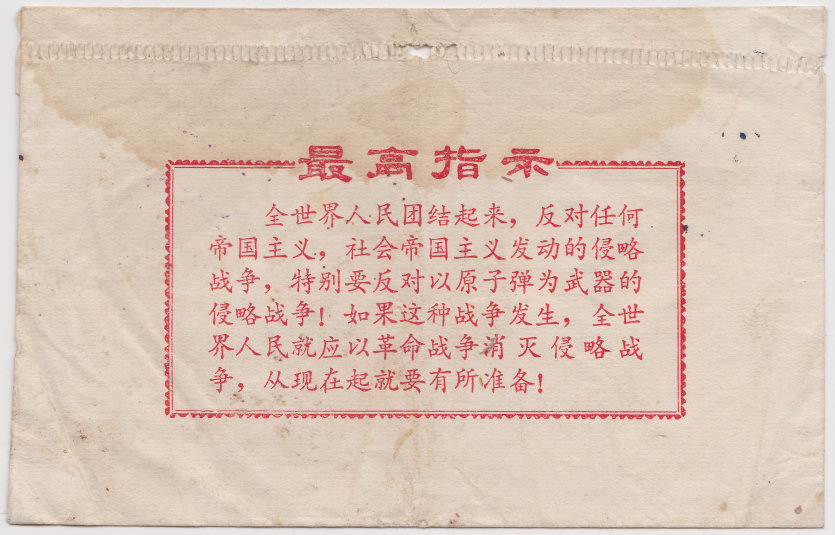
Still "YN" on the back as well as 电(1015)
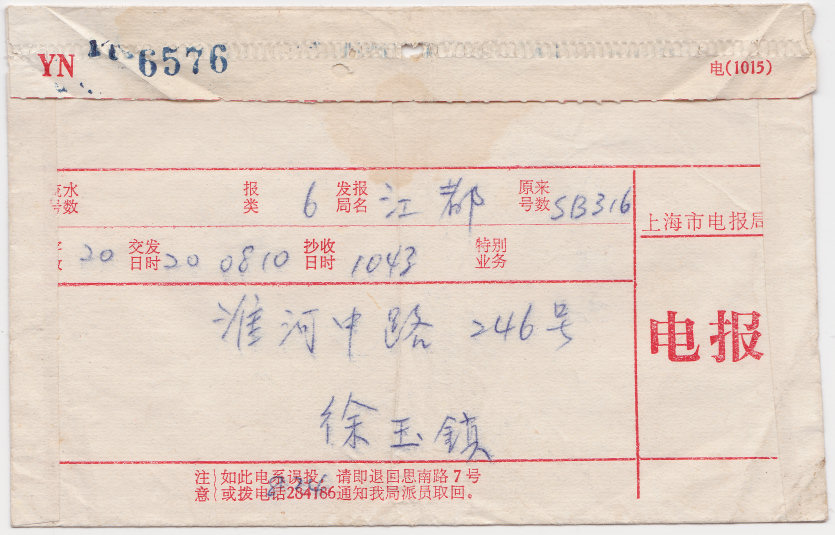
No enclosure.
电1016 - Used in Beijing, December 1964 ? black edging at the top. - My Ref. CN-MPT-Env-1016-64-12
People's Republic of China Ministry of Posts and Telegraphs
Under that is "邮途電報" - (Postal Telegraph).
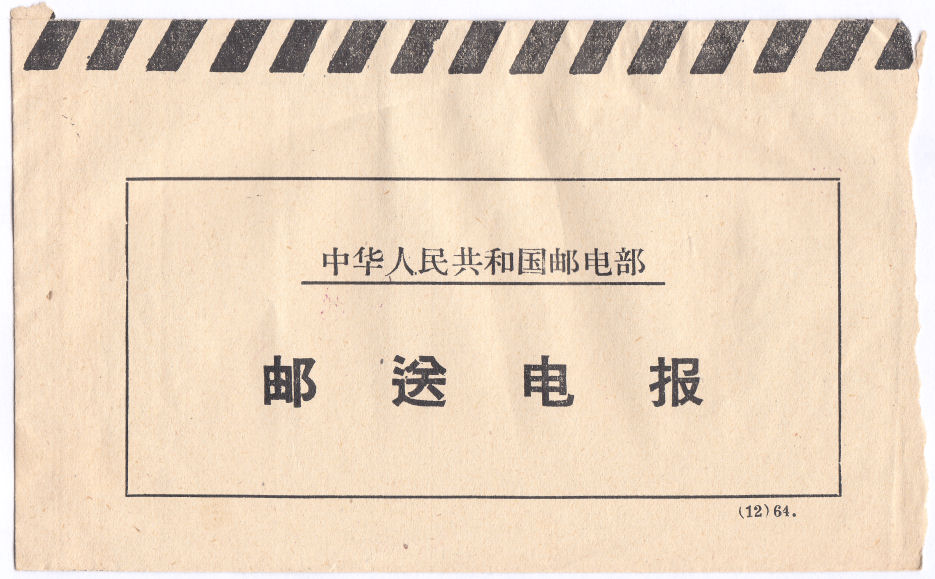
Under the box above is "(12)64." which I am taking to be the date of printing for the envelope.
Under the flap at top-left of the back is 电1016
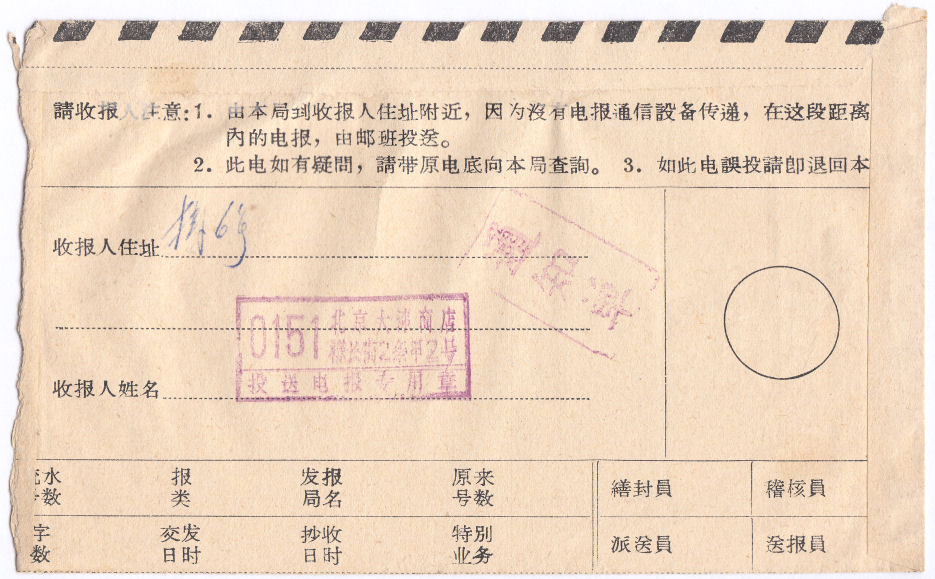
The purple handstamp on the right is "通知单" (notification).
The other is the Beijing 0151 mark detailed above.
No Form number. 16-4-85 similar but registered in Shanghai. - My Ref. CN-CPT-Env-SH-85-4
This is sealed on 3 sides (top glued down) but open at the paperclip end. No enclosure.
中国人民电信 = China People's Telegraph.
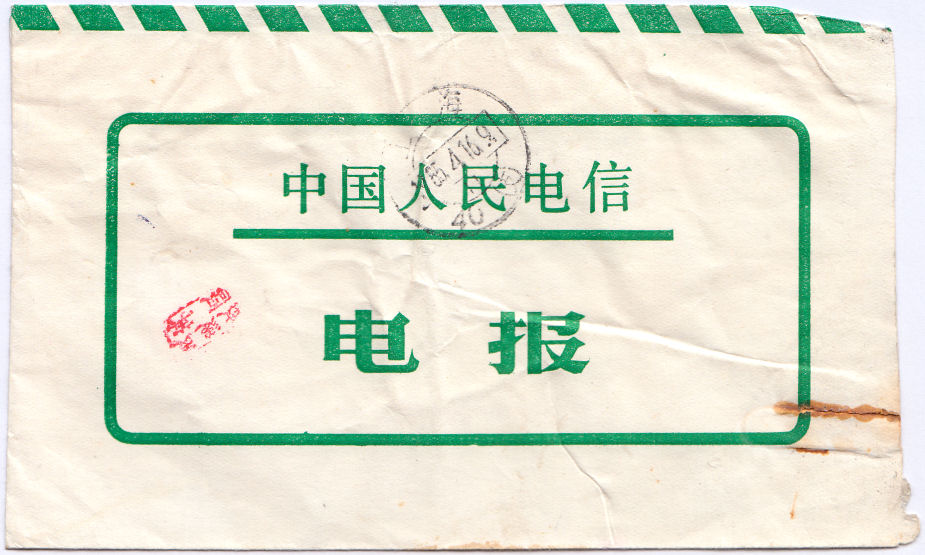
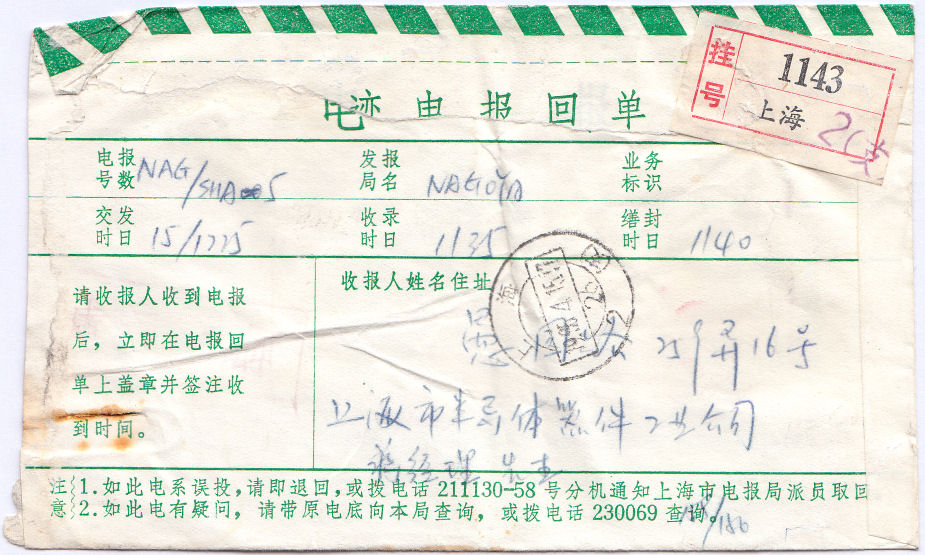
No form number under the flap. Shanghai telephone numbers at the bottom.
Form 电1201. - 27-8-85 red lettering and edging at the top. - My Ref. CN-CPT-Env-1201-85-8
中国人民电信 = China People's Telegraph.
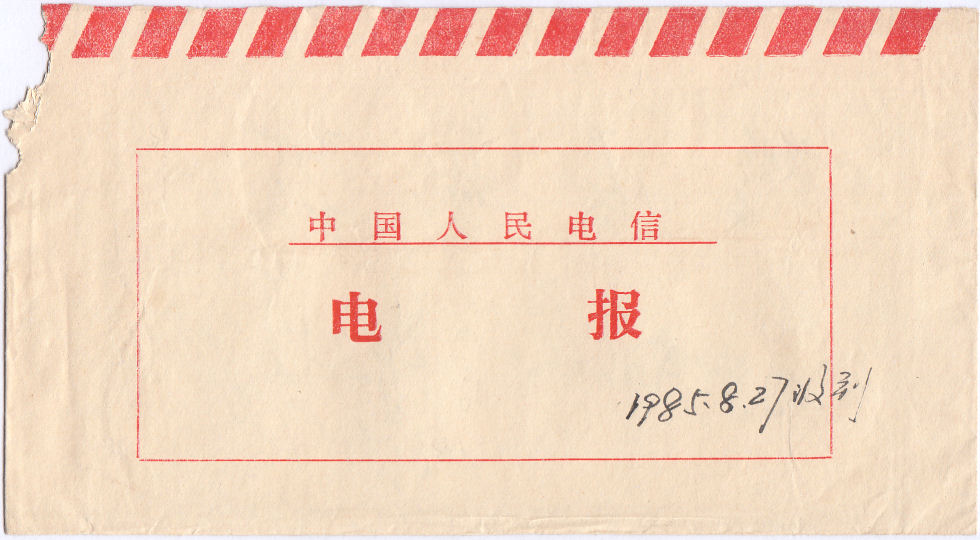
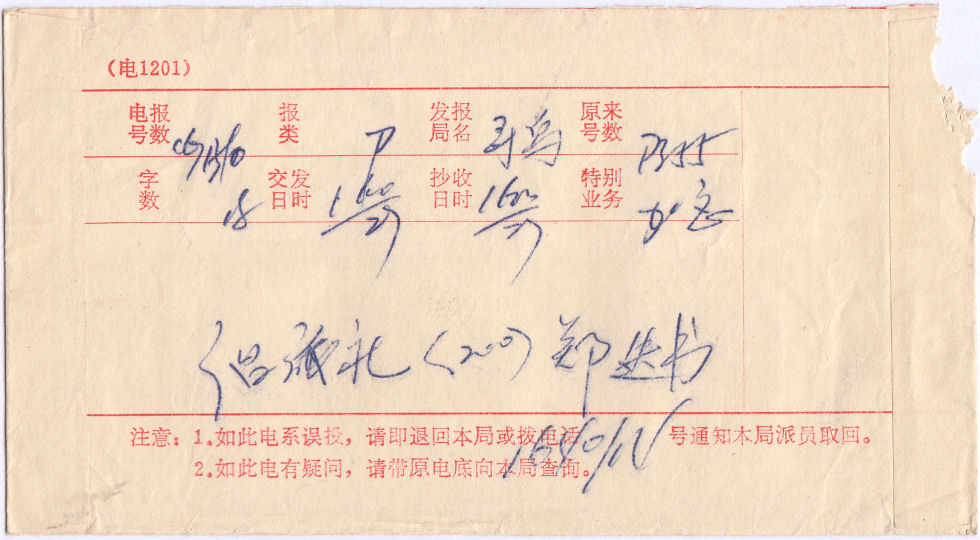
Form 电1201.
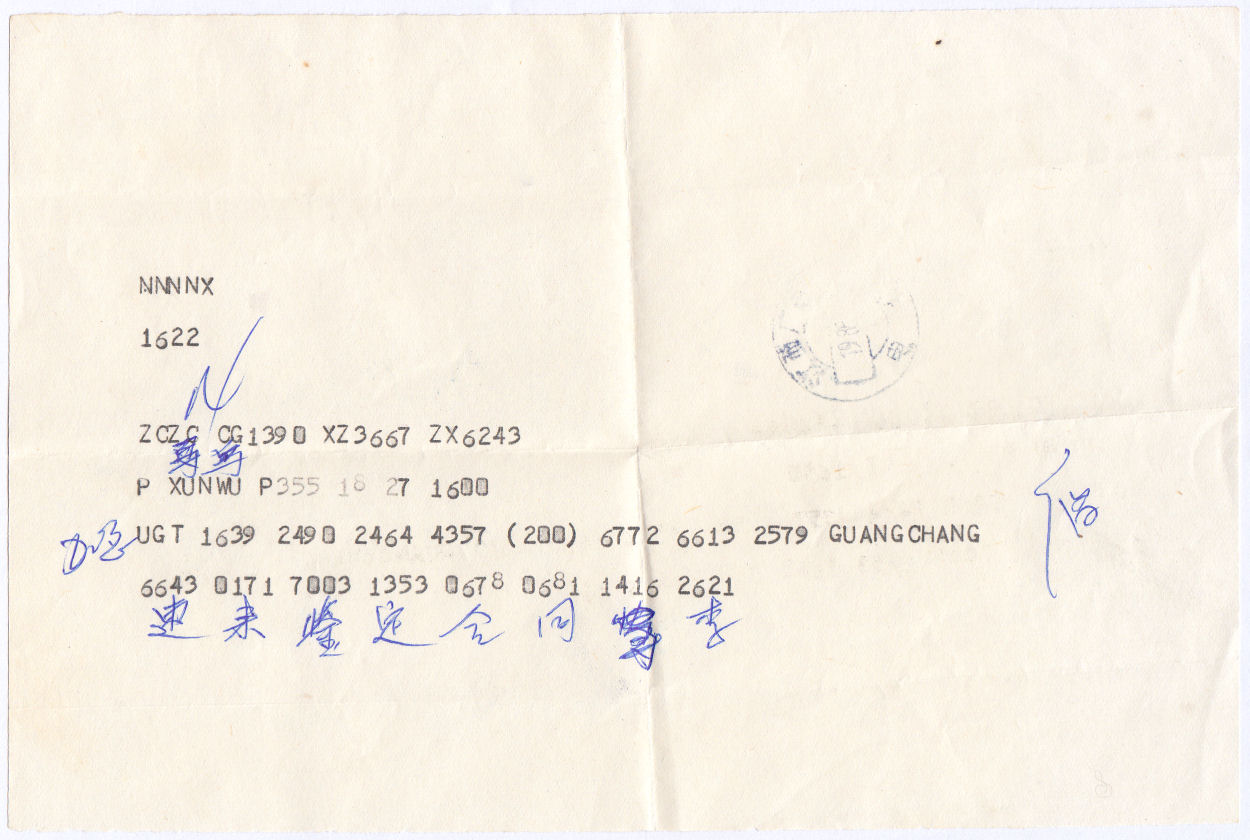
Form 电1201 - Used in Beijing, 22-3-91 much heavier lettering than the last. - My Ref. CN-MPT-Env-1201-91-3
People's Republic of China Ministry of Posts and Telegraphs
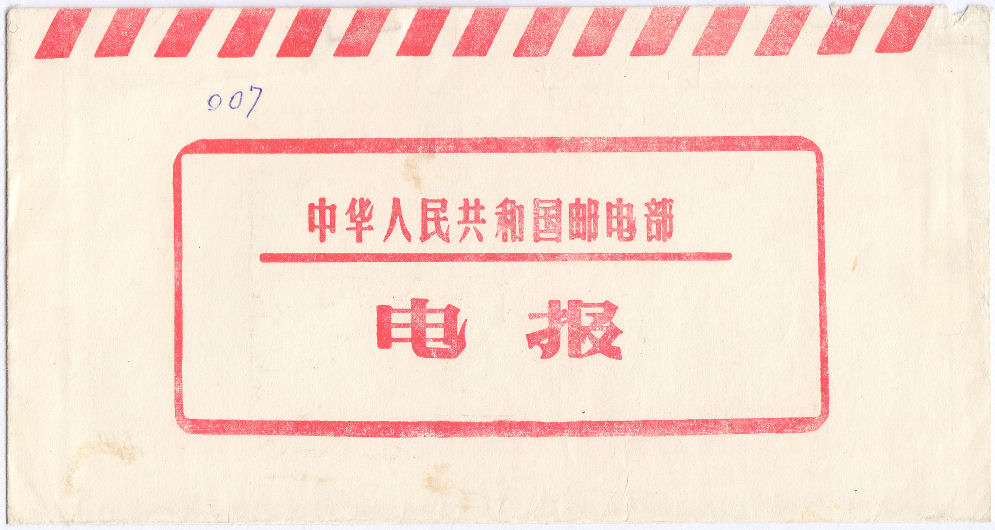
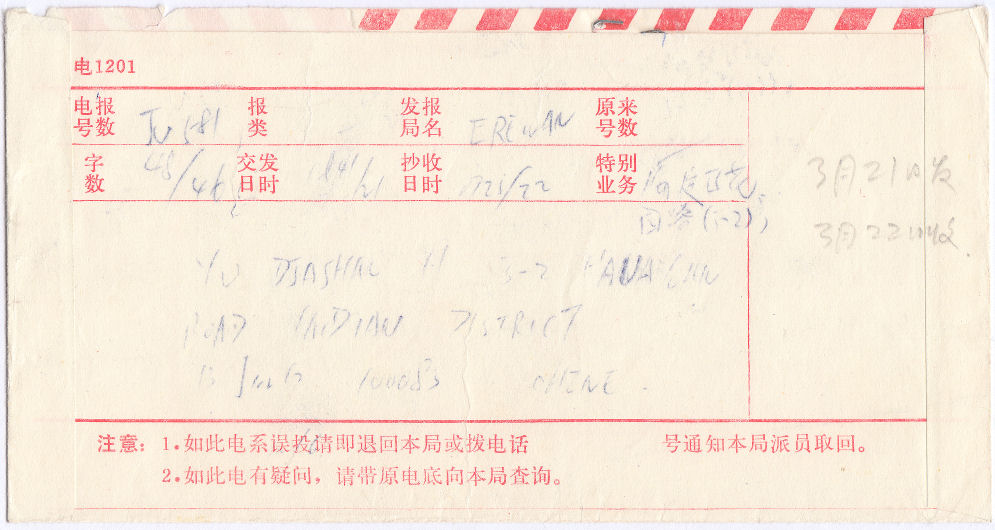
Form 电1201 without brackets.
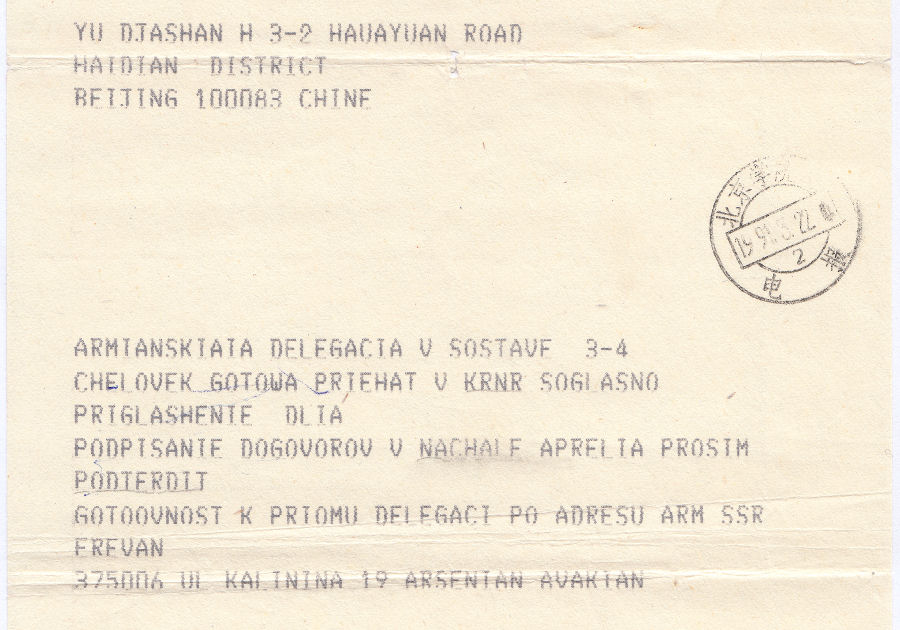
The content is in Anglicised Russian from Erevan (Ереван) about a delegation of 3 or 4 people, 6 months before Armenia became a Republic.
Form 电1201 - 11-9-91 similar to 27-8-85 one above, but smaller red lettering. - My Ref. CN-CPT-Env-1201-91-9
中国人民电信 = China People's Telegraph.
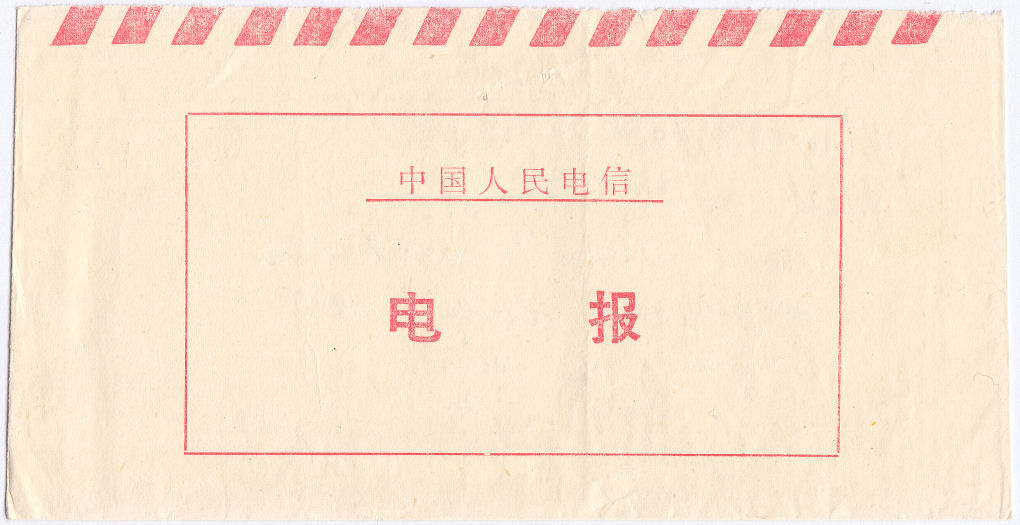
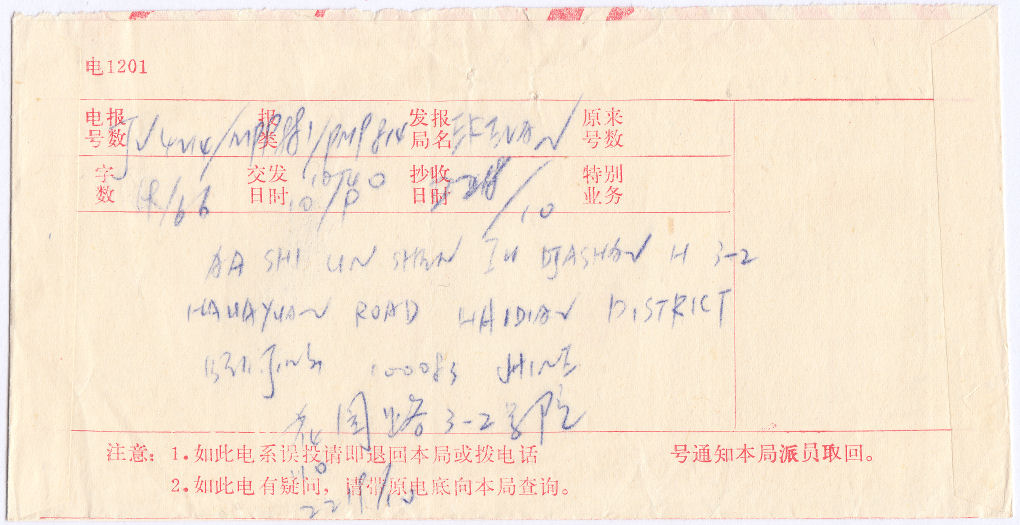
Form 电1201 without brackets.
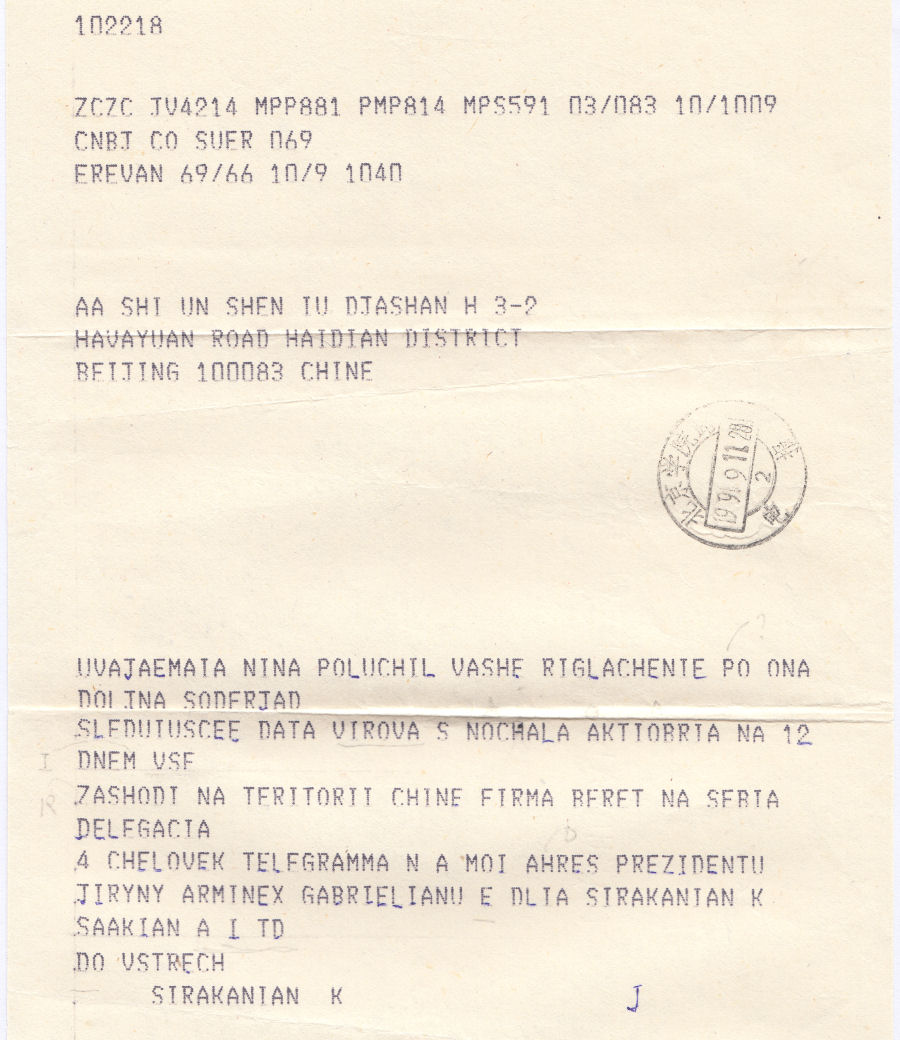
The content is in Anglicised Russian from Erevan (Ереван), 10 days before Armenia became a Republic.
Form 电1201 - 16-5-87 in green - My Ref. CN-CPT-Env-1201-87-5
中国人民电信 = China People's Telegraph.
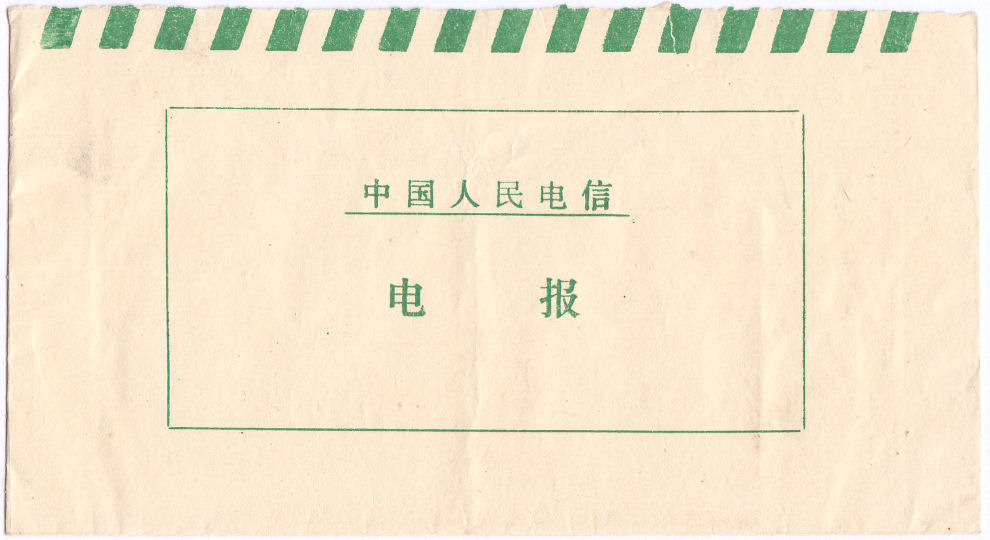
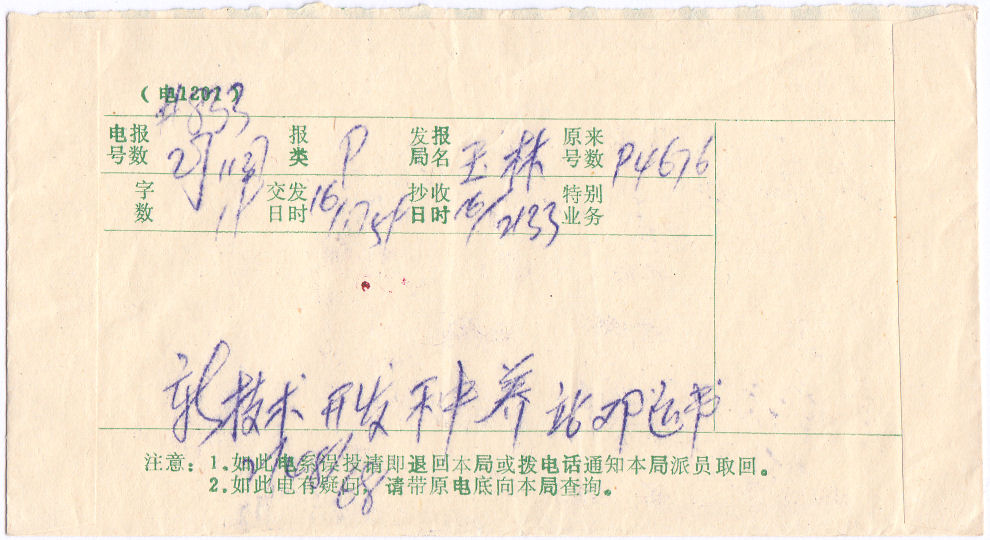
Form (电1201) - The bottom lines of text on the back are closer together than on the earlier type.
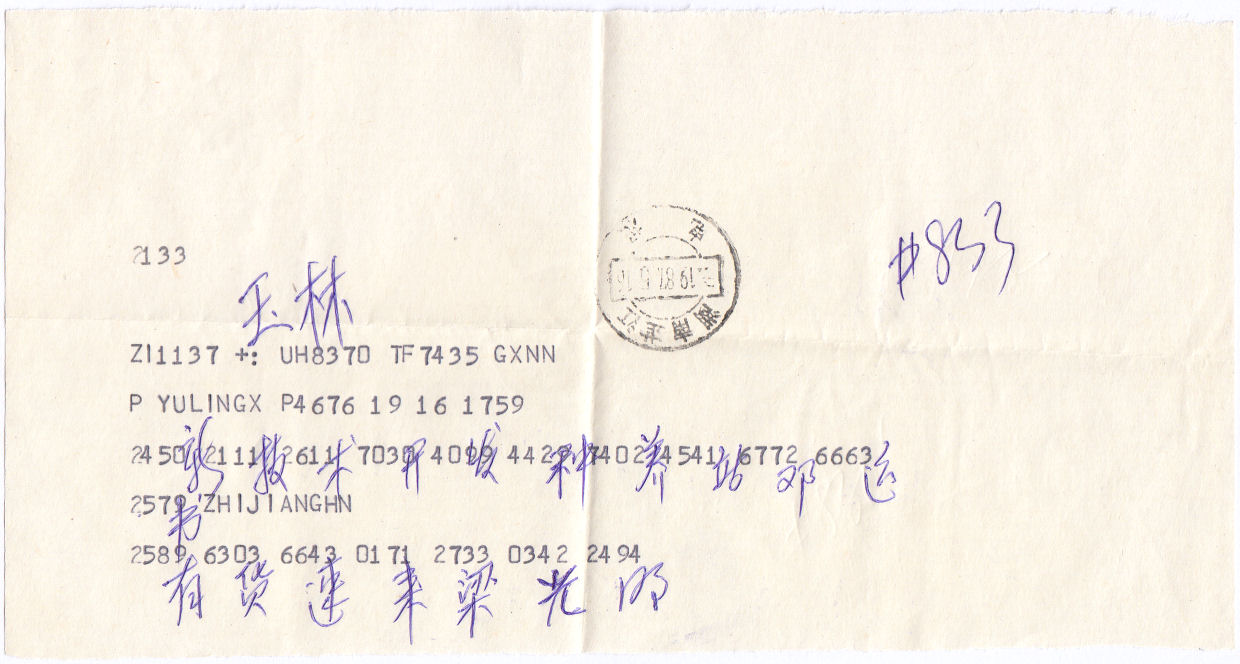
The handstamp is dated 16/5/1987, with "湖南芷江" - (Zhijiang city in Hunan).
Form 1201 - 6-6-91 similar to 16-5-87 telegram, but 电報 (Telegraph) is larger/heavier and without brackets around the form number. - My Ref. CN-CPT-Env-1201-91-6
中国人民电信 = China People's Telegraph.
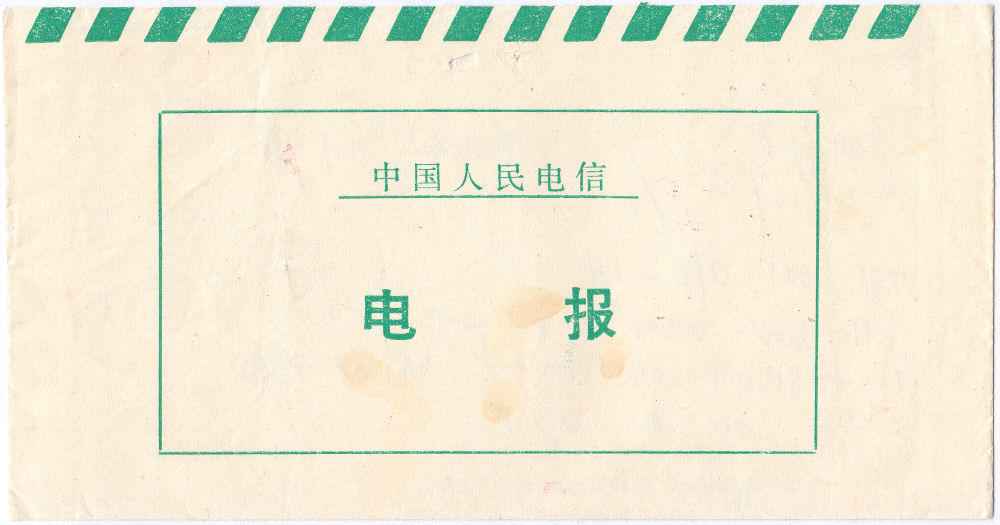
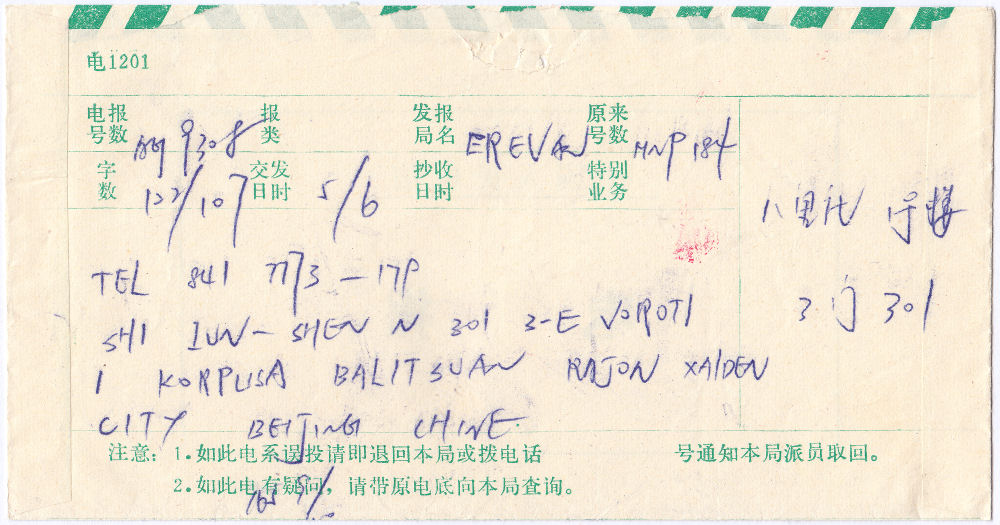
Form 电1201 (without brackets).
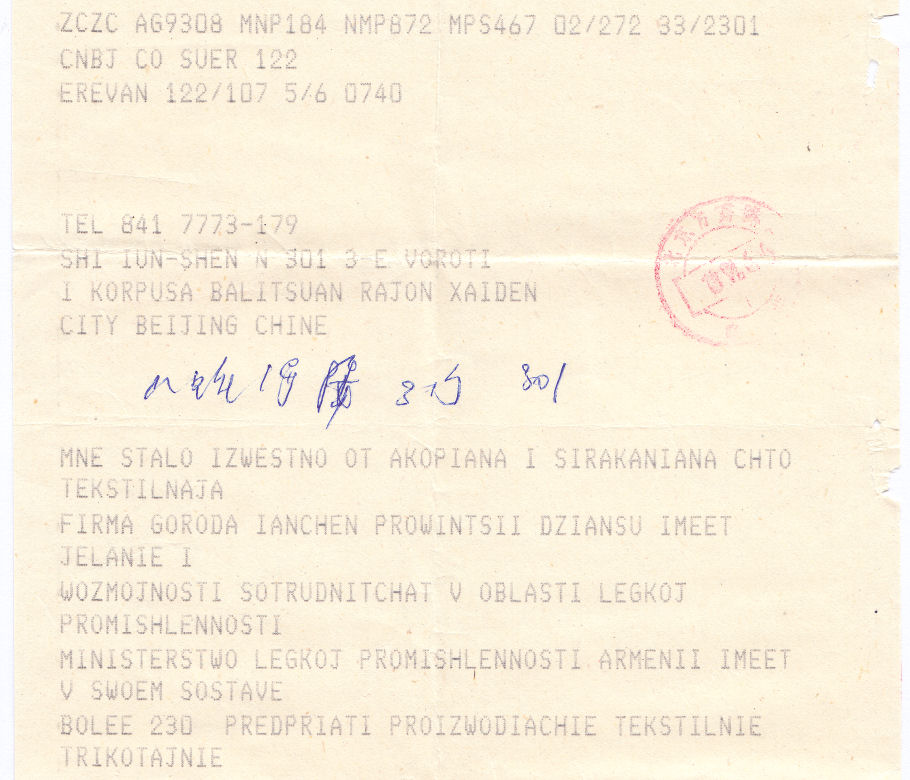
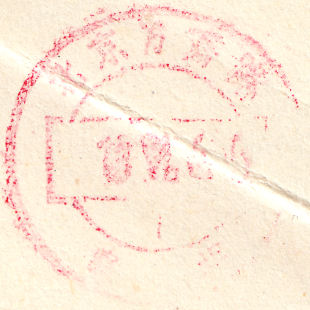
The date is hard to read, but there is a batch of telegrams with red edging, around this date from Erevan (Armenia).
I truncated the contents as it is rather long and in Anglicised Russian like the others.
Used in Beijing 19-2-1992. (from Erewan). Form 电1201. - My Ref. CN-MPT-Env-1201-92-2
People's Republic of China Ministry of Posts and Telegraphs
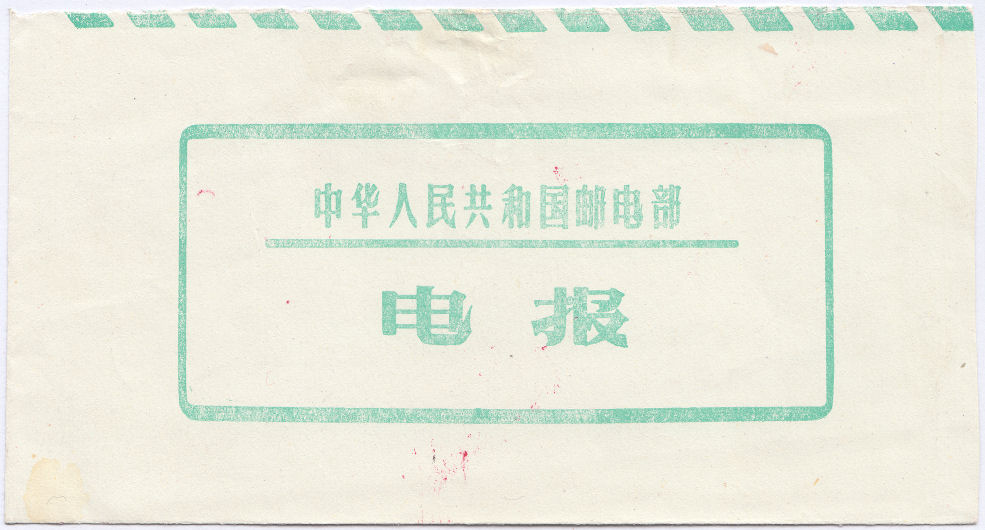
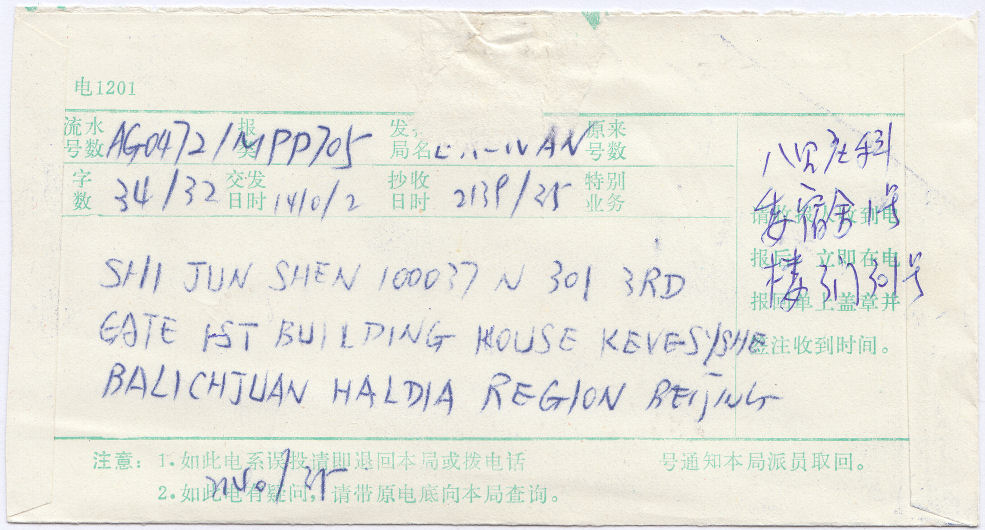
Form 电1201.
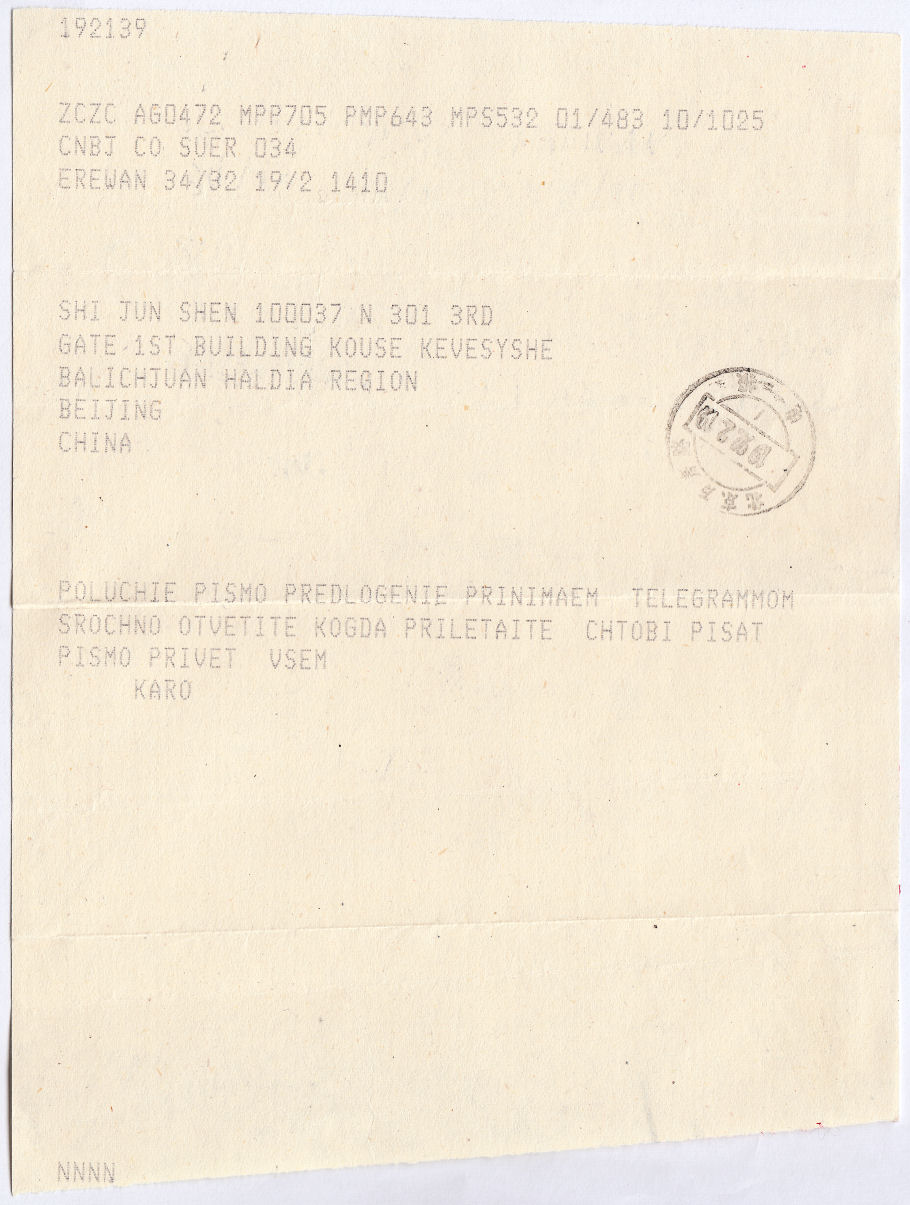
This was to Beijing from Ереван, anglicised as Erewan, which was the capital of the newly independent Republic of Armenia (since 21 September 1991).
The contents are also anglicised Russian, i.e:
Получи Письмо предложение принимаем телеграммом срочно ответьте когда прилетайте чтобы писать письмо привет всем.
Used 16-10-80? in Hefei, Anhui. I have another without enclosure, stamped 24-9-71. - My Ref. CN-MPT-Env-80-10-Q3
No form number. Machine-sealed. People's Republic of China Ministry of Posts and Telegraphs
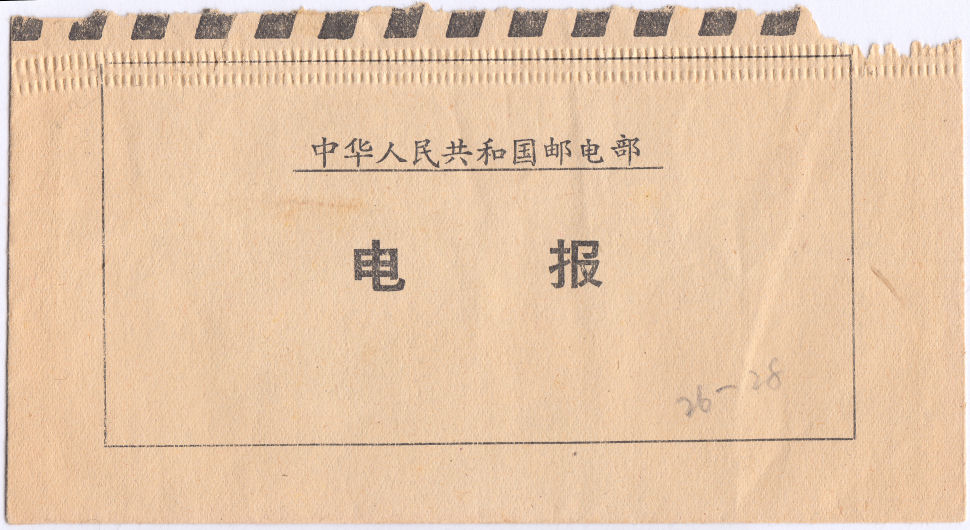
The back has a Mao Zedong (毛澤东) quote on the left side saying :
"我們应該謙虚, 謹慎, 戒驕, 戒躁, 全心全意地为中国人民服务, ..." meaning :
"We should be humble, cautious, abstain from arrogance, abstain from impatience, and serve the Chinese people wholeheartedly, ..."
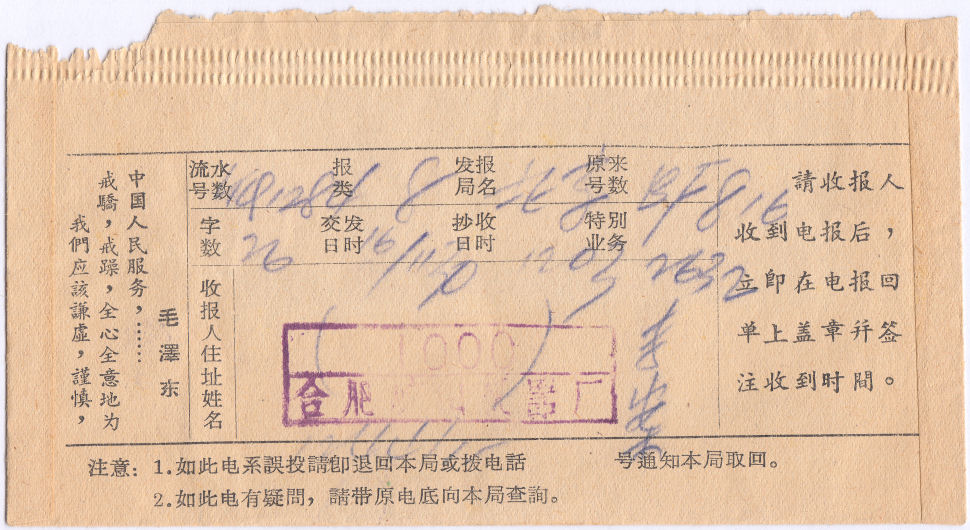
The purple handstamp with "1000" and "合肥 ... 厂" (合肥...) matches the contents (1000) ... HEFEI
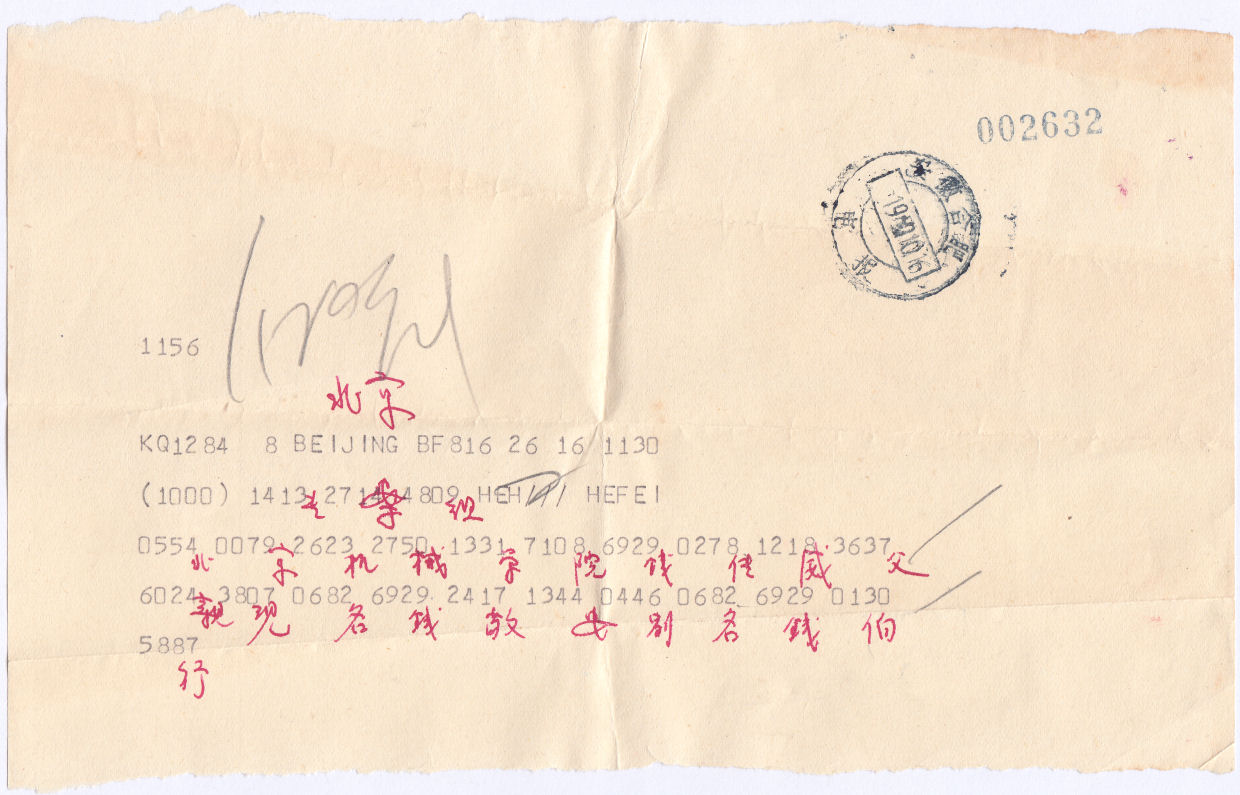
Form 电2019. - Date ? This appears to be a newer 'pouch type' with a flap. - My Ref. CN-MPT-Env-2019
This is the outer surface.
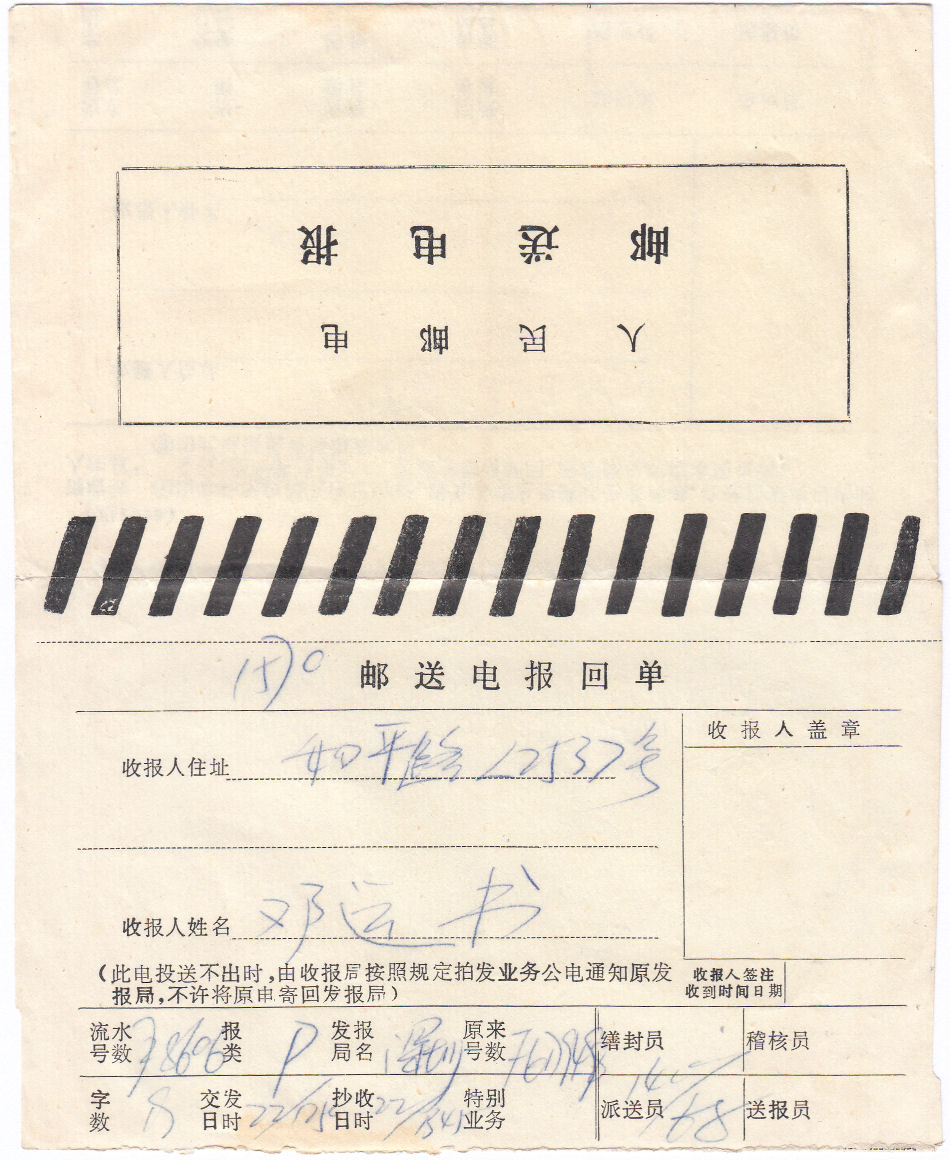
This is the inside, with a pouch for an enclosure.
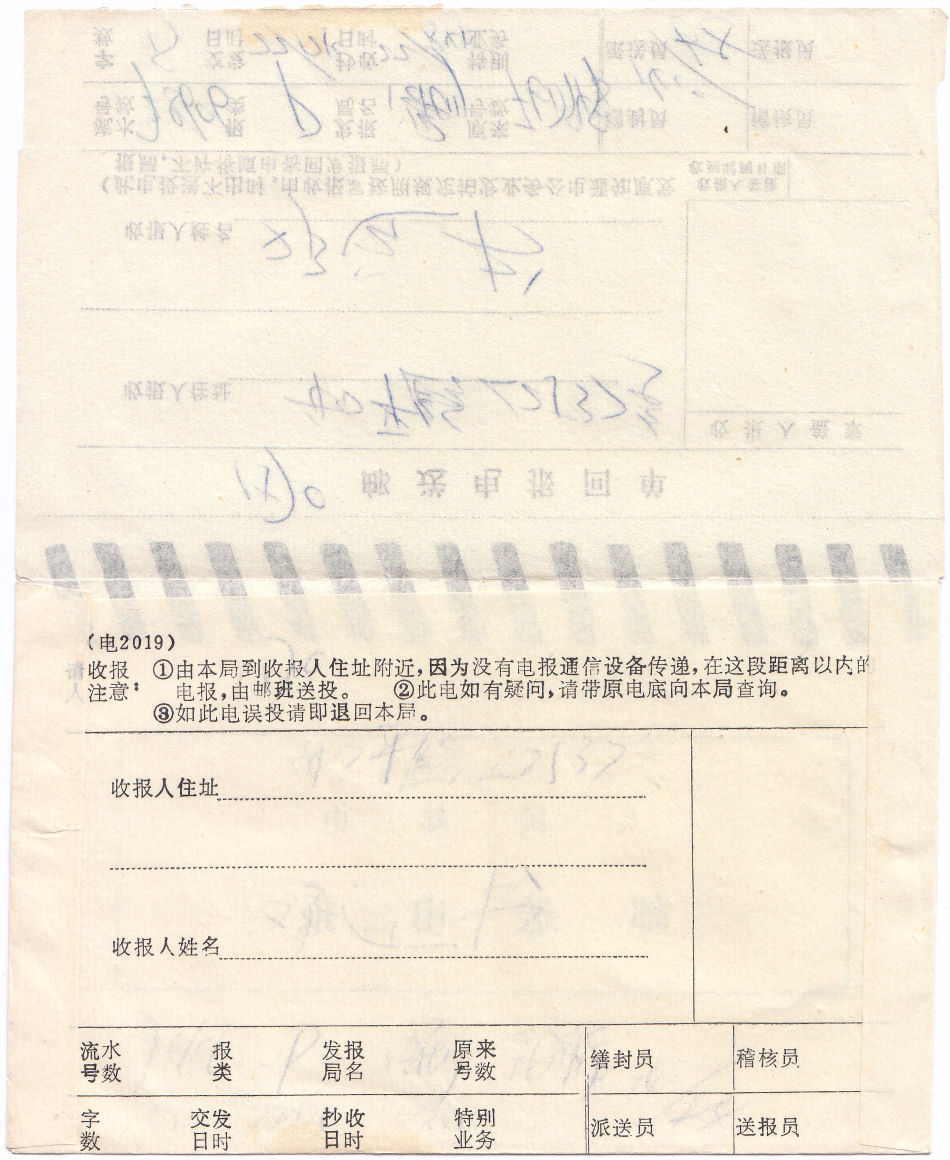
What intrigues me is that there appears to be no way of sealing them, and nothing to indicate how it was delivered.
The enclosure is missing, so I have no knowledge of the year. Form 电2019.
Undated, no form number, used in Hankou. Red edging at the top. - My Ref. CN-MPT-Env-HK
The top has "中华人民共和国邮电部" = People's Republic of China Ministry of Posts and Telegraphs
Note that the second character is an obsolete form, suggesting that this is early..
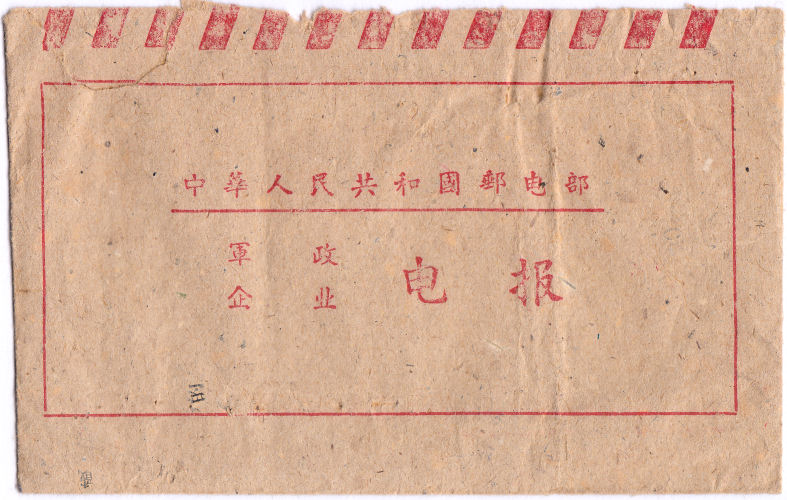
The top of the back has "請收報人注意封囗是否完好" meaning "Please pay attention to whether the seal is intact"
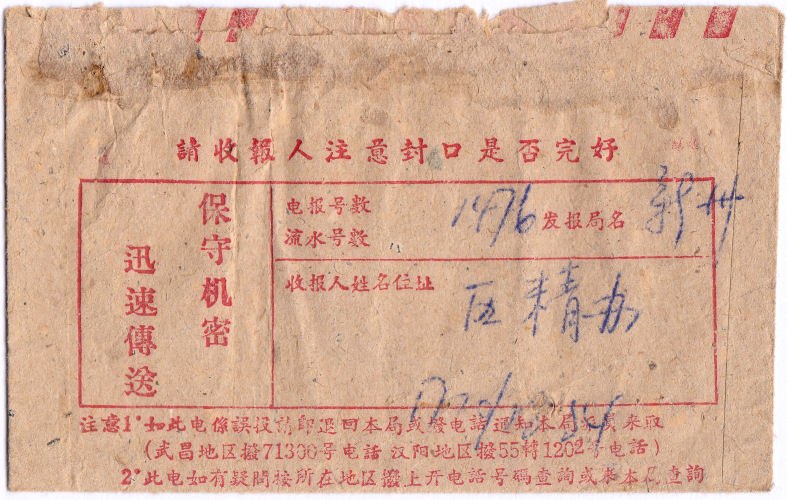
The above is numbered 1476, as are the contents below.
Form 6-3012 - the five-pointed star, marked Hankou on the contents suggests that it is late !

On the right at the bottom is : 由 = by; 时間 = time and 签名 = signature. - Form 6-3012.
These continue with the 电1015 numbering scheme, but lack any designation of administrative authority. I therefore assume that it is a National body and need to call it something.
For lack of anything better, I will call it F.P.S. for Five Pointed Star.
Form 电1201甲 - 5-point Star type. Marked CH075-5 1988年 on the back. - My Ref. CN-FPS-Env-1201-1988
The star is a negative version of the following ones.
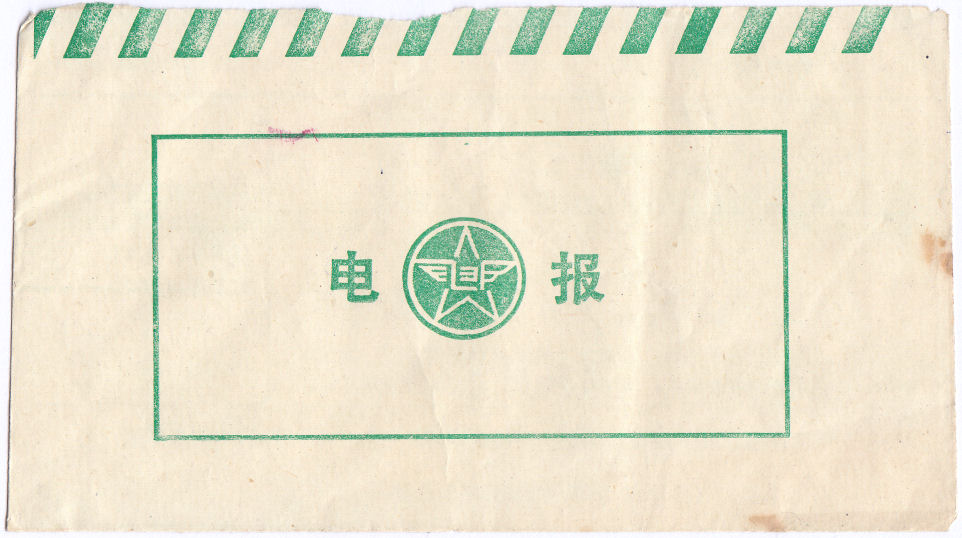
Form 电1201甲
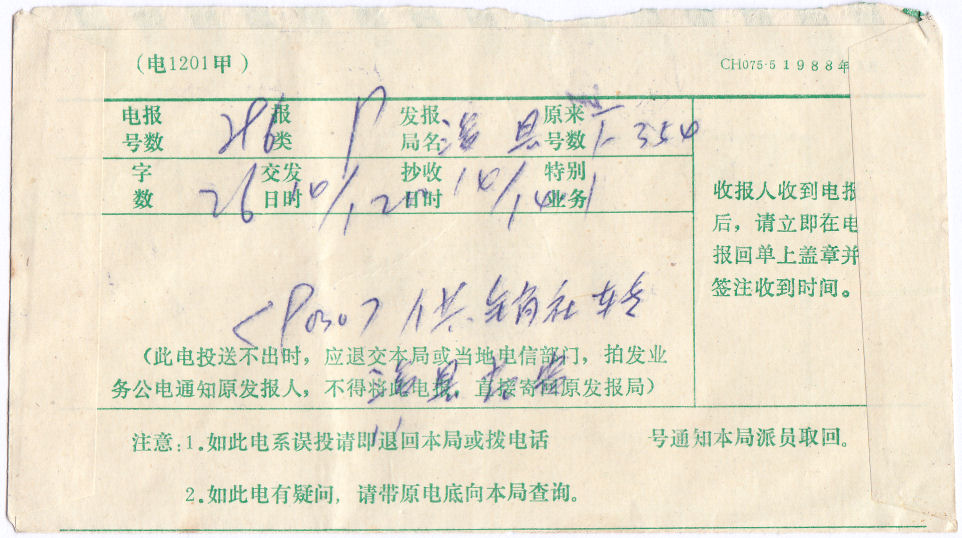
The bottom lines of text on the back are wide apart again. Form (电1201甲).
Date ? This appears to be a newer 'pouch star-type' with a flap. - My Ref. CN-FPS-Env-1201-Mon-1
This is the outer surface.
It is marked 电報回单 meaning Telegram receipt - Still Form 1201 though.
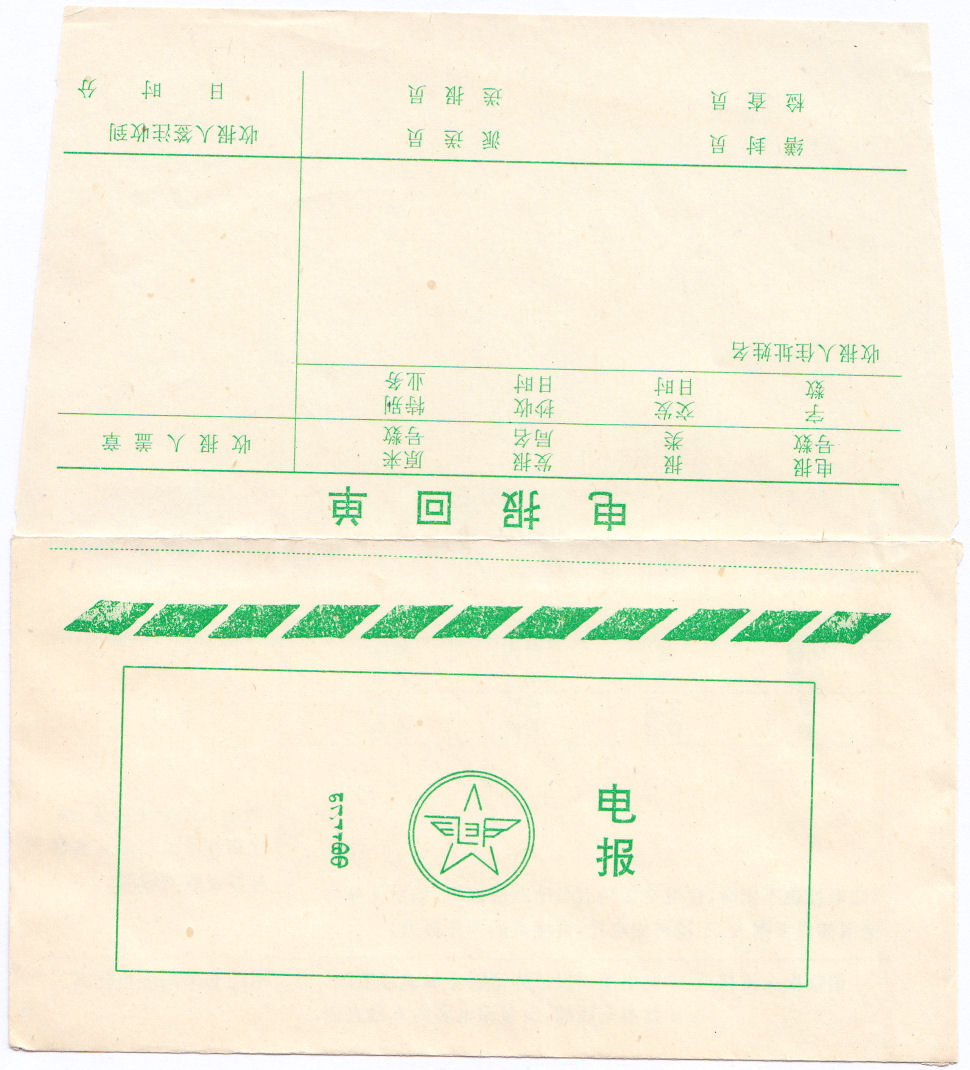
Note the Mongolian script on the left.
This is the inside, with form number 1201 and a pouch for an enclosure.
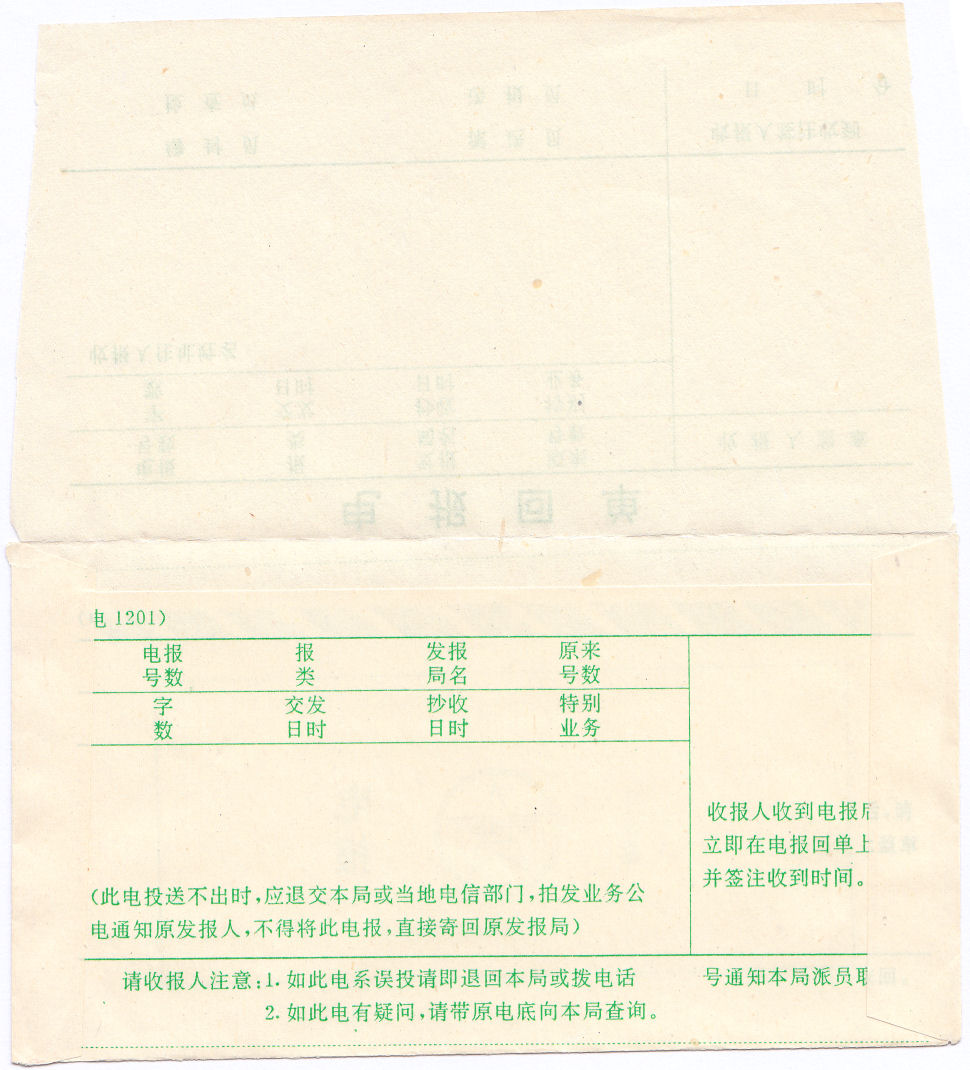
What intrigues me is that (like the black type below) there appears to be no way of sealing them, and nothing to indicate how it was delivered.
The enclosure is missing, so I have no knowledge of the year. Form 电1201.
Undated - 电1015 in Blue with a 5-pointed star and complex machine closure. - My Ref. CN-FPS-Env-1015-blue-1
This is larger than the red ones, but about the same size as the green ones.
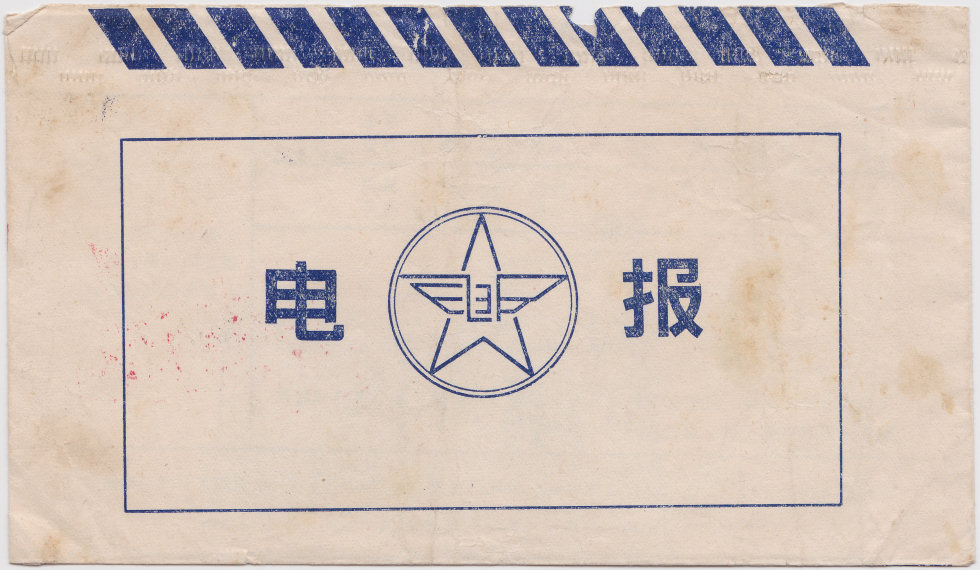
(电1015) - the more complex closure pattern can be seen.
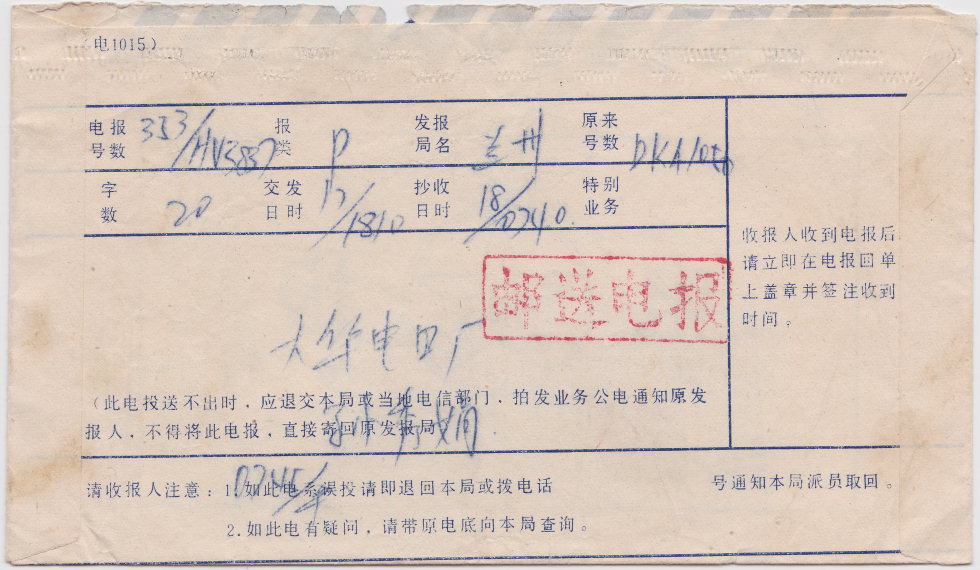
Stamped with boxed "邮送电报" (Mail and telegram). No enclosure.
3-12-91 5-point Star type with plastic envelope. No form number. - My Ref. CN-FPS-Env-91-12
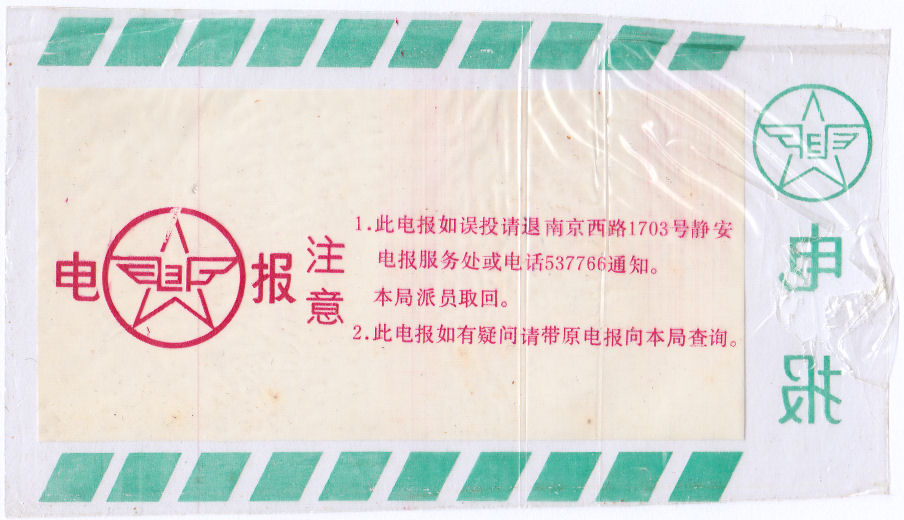
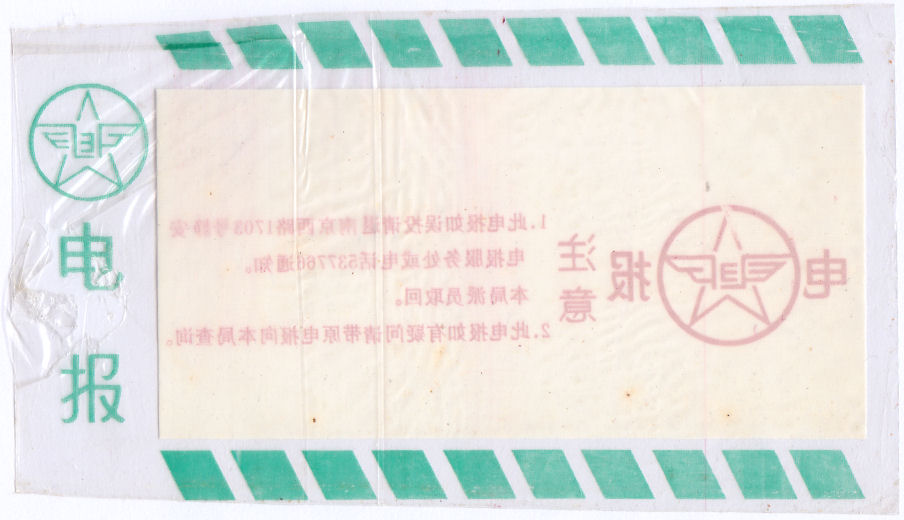
The plastic is transparent with the red on one side and green and a creamy panel for perhaps writing an address, on the other.
The enclosure (half-size below) is dated 3/12/1991.
One thing that I've noticed is that envelopes specifically for Beijing have form numbers,
whereas those specifically for other cities generally do not.
Form 电1201 - 25-4-91 5-point Star type with cut-out in the envelope (no plastic or translucent panel). - My Ref. CN-FPS-Env-1201-91-4
From Erevan.
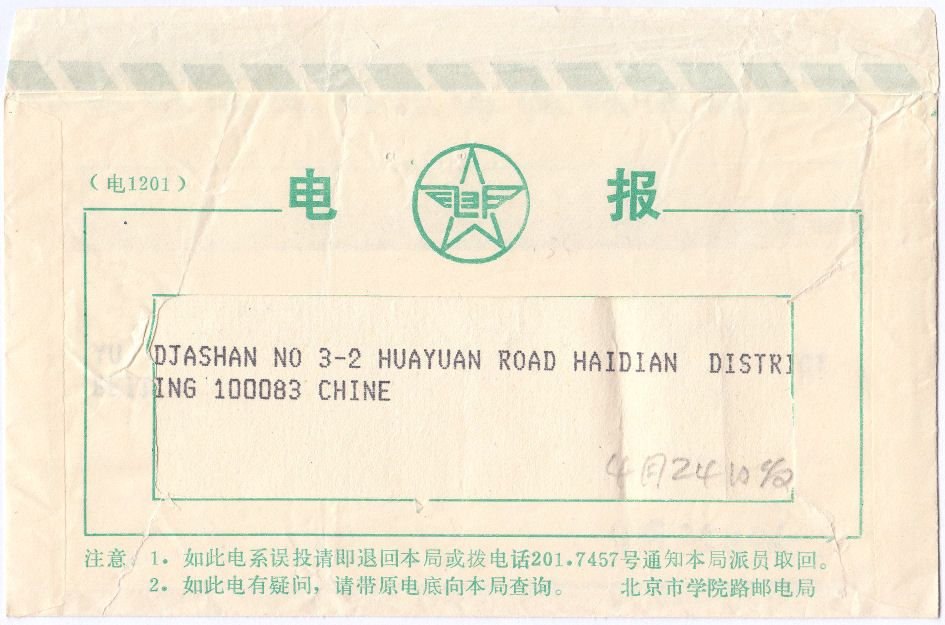
This is shown with the contents inside. Form (电1201) .
Notice that at the end of this (note 2.) it says "北京市学院路邮电局"
(Beijing College Road Post Office)
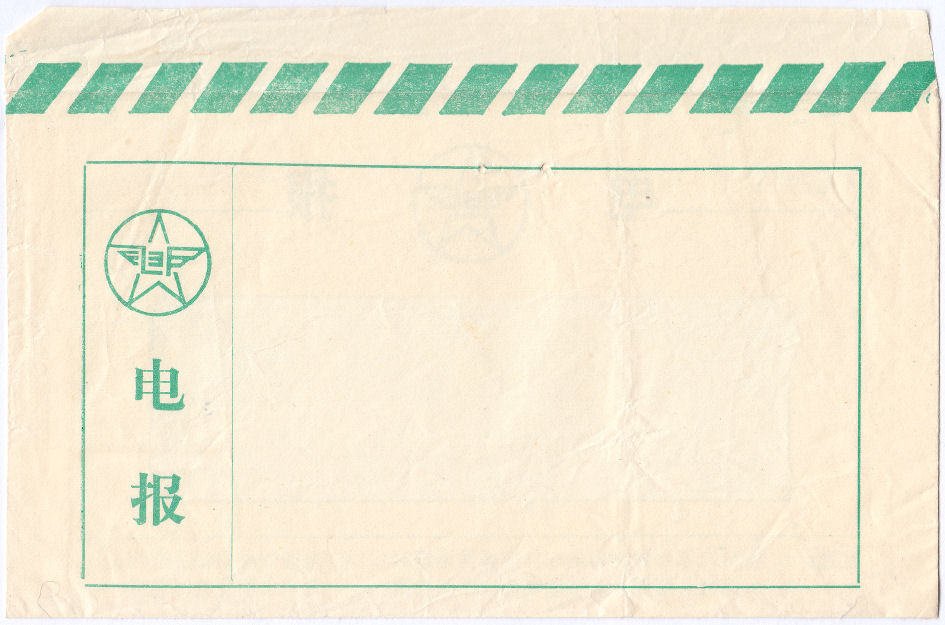
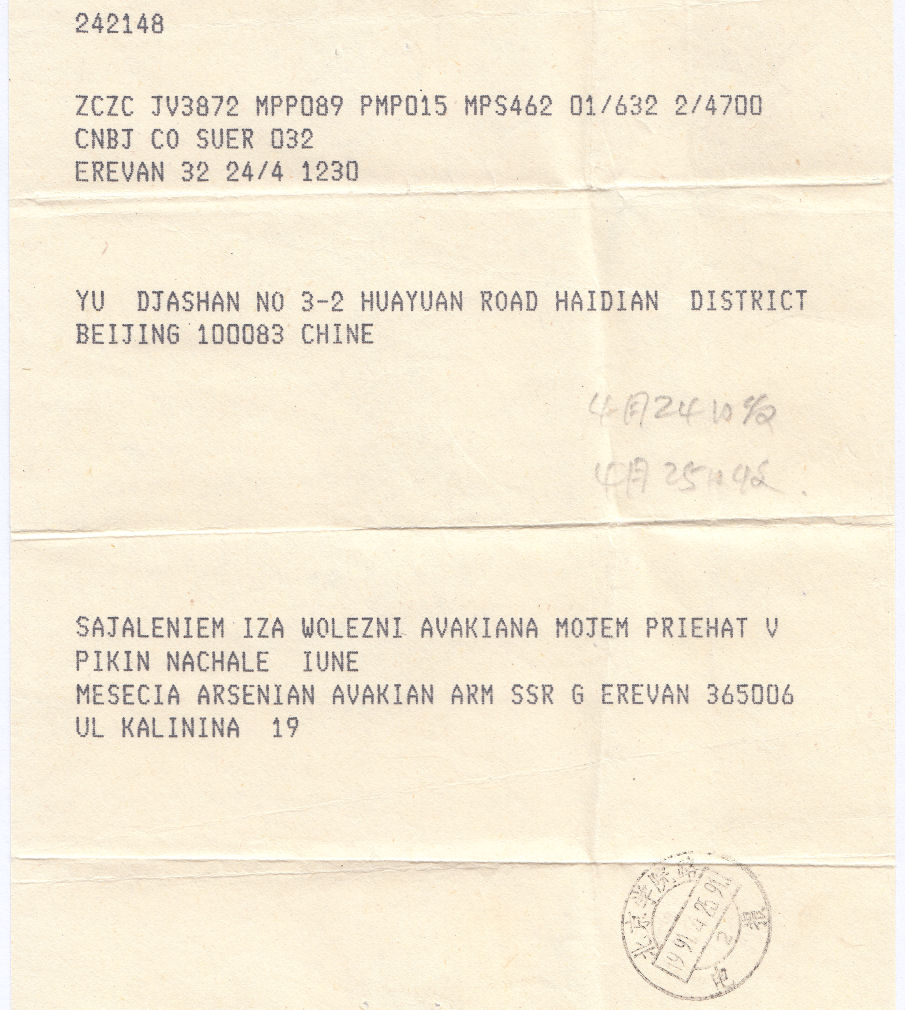
The enclosure (from Erevan) is dated 25/4/1991, arranging a trip to Beijing at the beginning of June.
This has no visible form number, though one may have been lopped off. - My Ref. CN-CPT-Env-blue-SH-M1
中国人民电信 = China People's Telegraph.
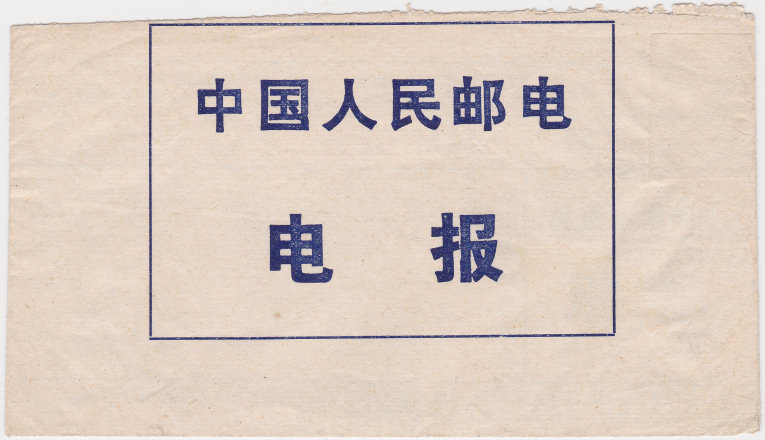
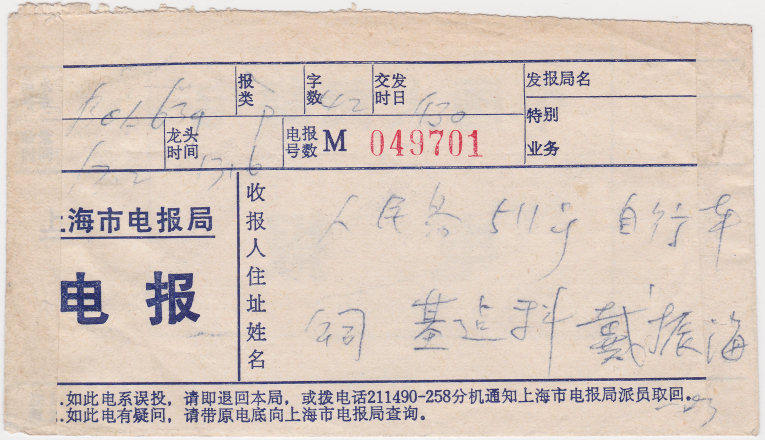
The two notes at the bottom says : "1. 如此电系误投, 请即返回本局, 或拨电话211490-258分机通知上海市电报局派呙取回.
2. 如此电有疑问, 请带原电底向上海市电报局查询."
meaning :
"1. If this telegram has been misdelivered, please return it to our office immediately, or call Shanghai Telegraph Bureau at 211490-258 and ask them to send a representative to retrieve the telegram.
2. If you have any questions about this message, please bring the original telegram to the Shanghai Telegraph Bureau."
23-6-1960 red lettering and edging at the top. Machine-sealed. - My Ref. CN-MPT-Env-SH-2
People's Republic of China Ministry of Posts and Telegraphs
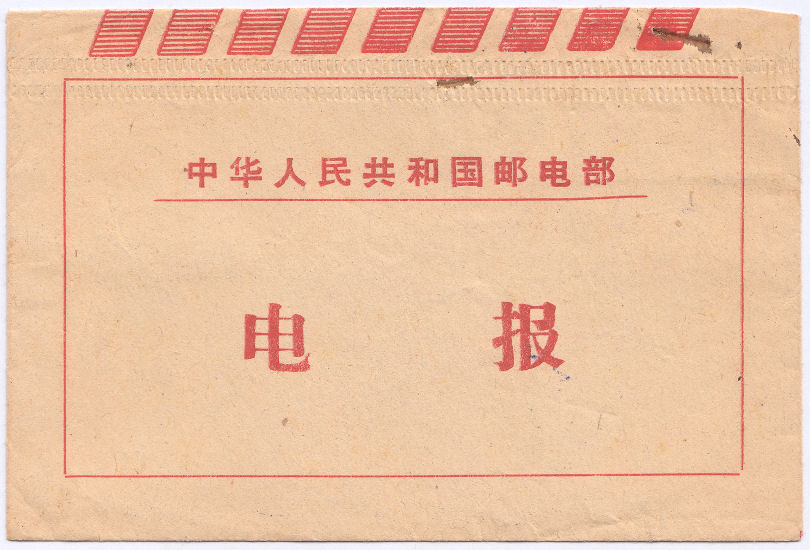
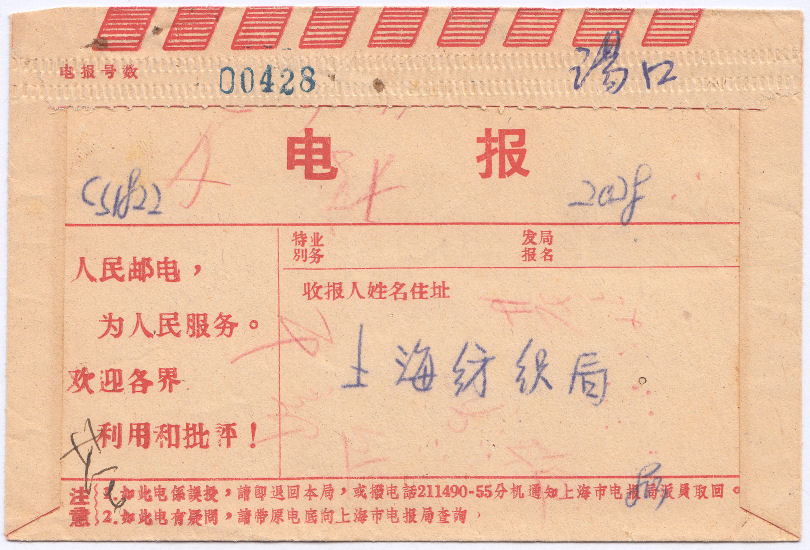
I don't see a Form number. The '电报号数' means Telegram Number. It has a Shanghai phone number.
It has contents also marked "CS1822" used in Shanghai.
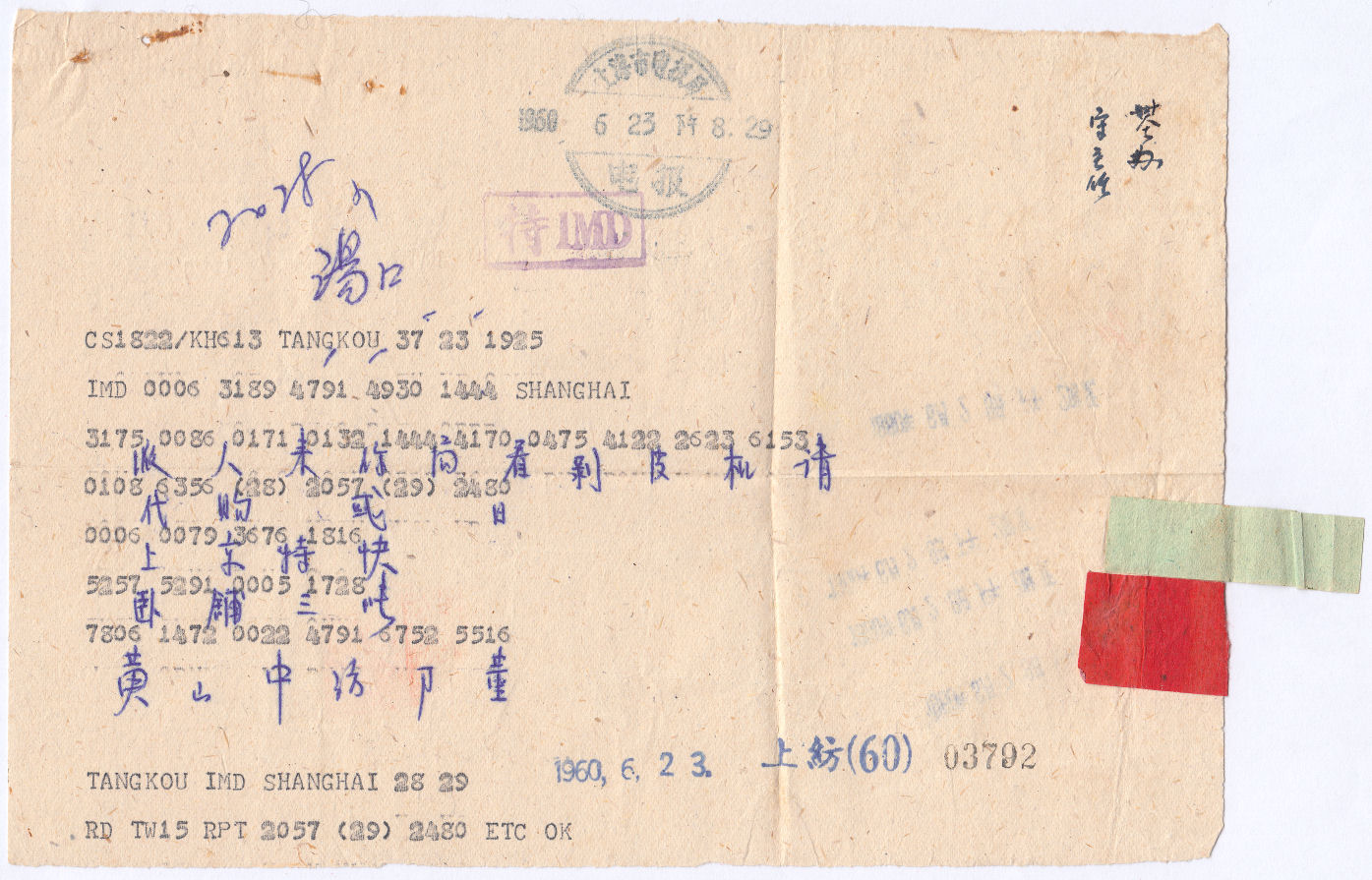
I am not sure of the significance of the red and green tabs on this, it may or may not relate to the colours of the printing on the envelopes.
I have seen similar red tabs on German telegrams of 1924 having diplomatic significance.
Used 13/2/1997 in Guangzou. These had a cellophane(?) window and were machine sealed. Also bar-coded. - My Ref. CN-FPS-Env-GZ-1
F. P. S.
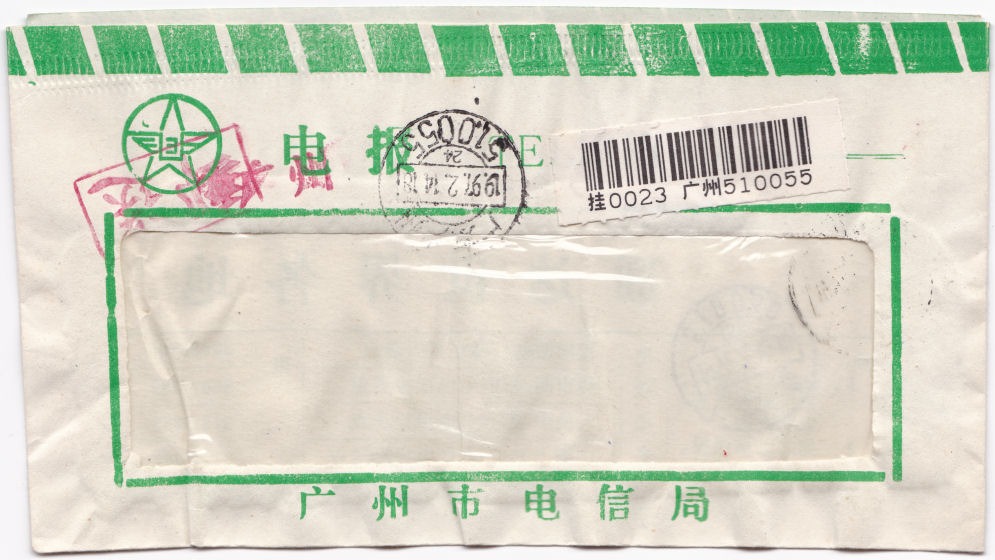
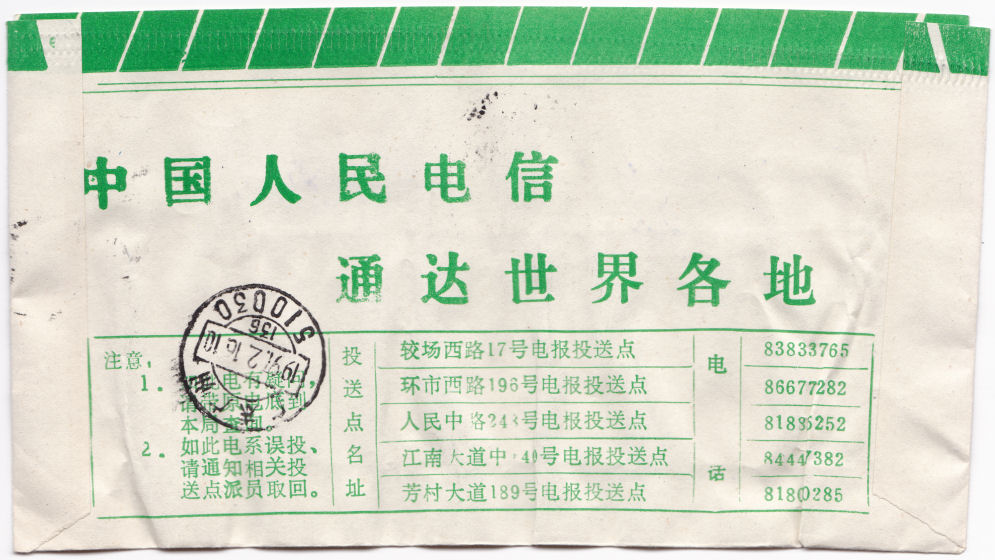
This is undated. No form number and no contents, but was for use in Guangzhou City (广州市). - My Ref. CN-FPS-Env-GZU-1
Marked as an Urgent Telegram.
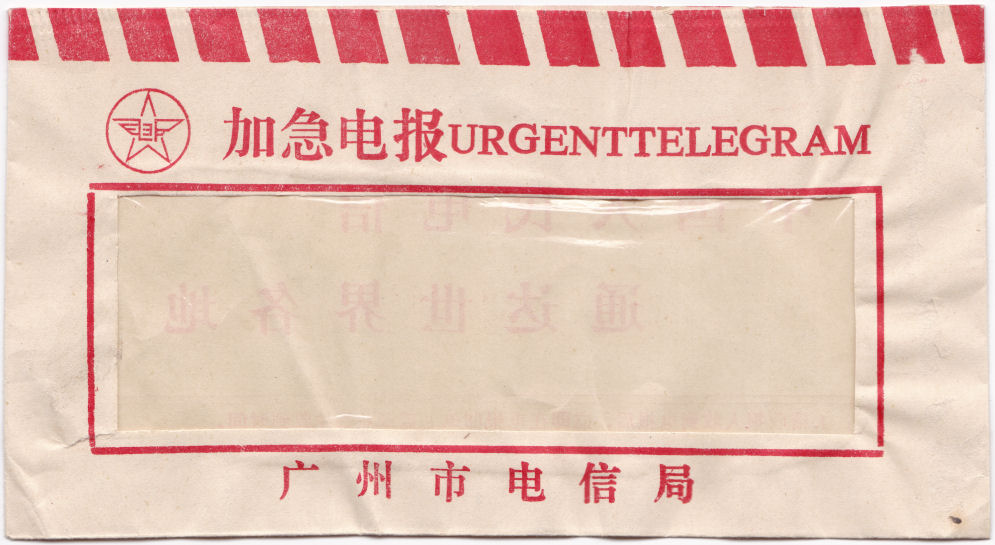
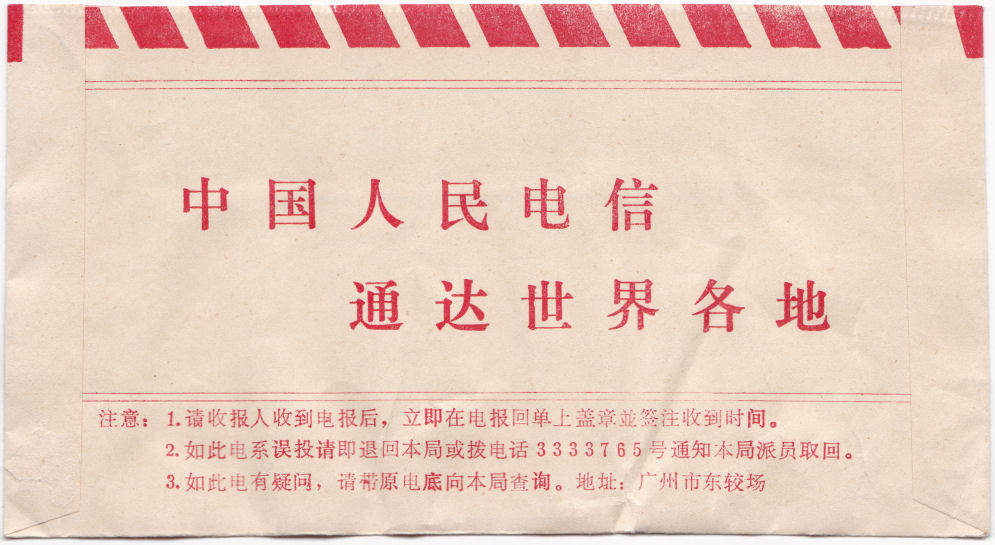
Clearly an Urgent Telegram for use in Guangzhou City, but no date, no form number and no contents.
Some of these have form numbers. Most do not.
They are arranged in probable date sequence.
| Shortcuts to Receipts with Form Numbers | ||
| 电1003 | 电2003 | 电1002 |
18 June 1915.
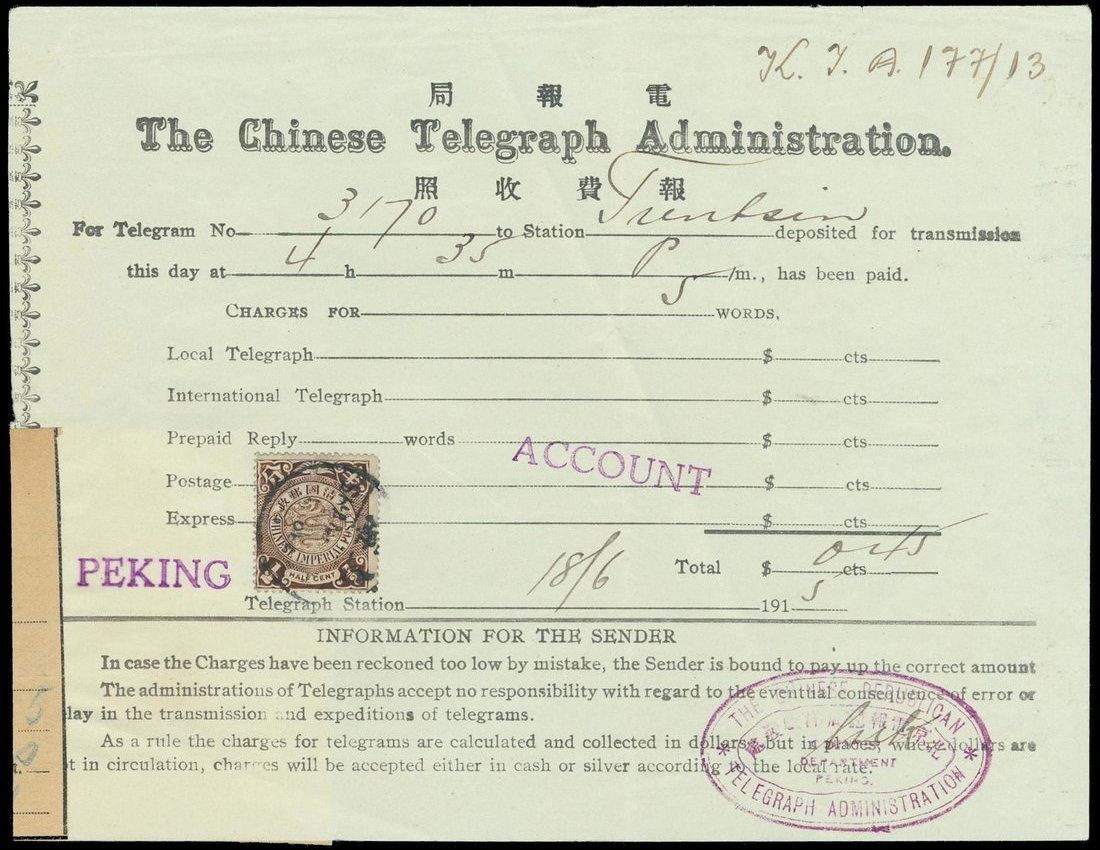
This is stamped "ACCOUNT" and "PEKING". It is for sending a telegram to Tientsin.
The oval stamp at the bottom reads around the outside "The Chinese Republican Telegraph Administration" with "Department Peking" inside.
The image is from an unknown source. Please contact me if yours.
24 December 1920.
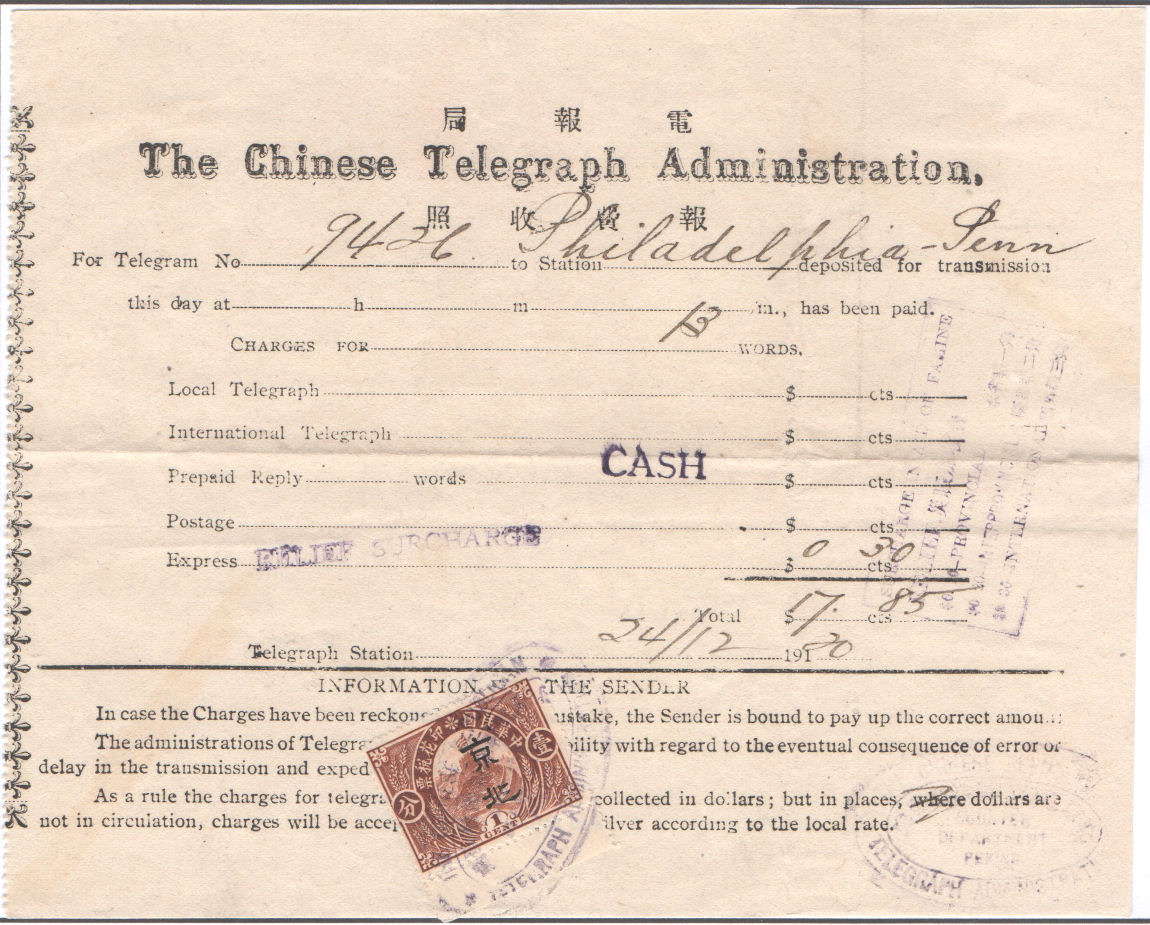
This has simply 'Relief Surcharge' and a virtually illegible explanatory box. The stamp is overprinted for use in Beijing. Courtesy of Les Bottomley.
Unknown date.
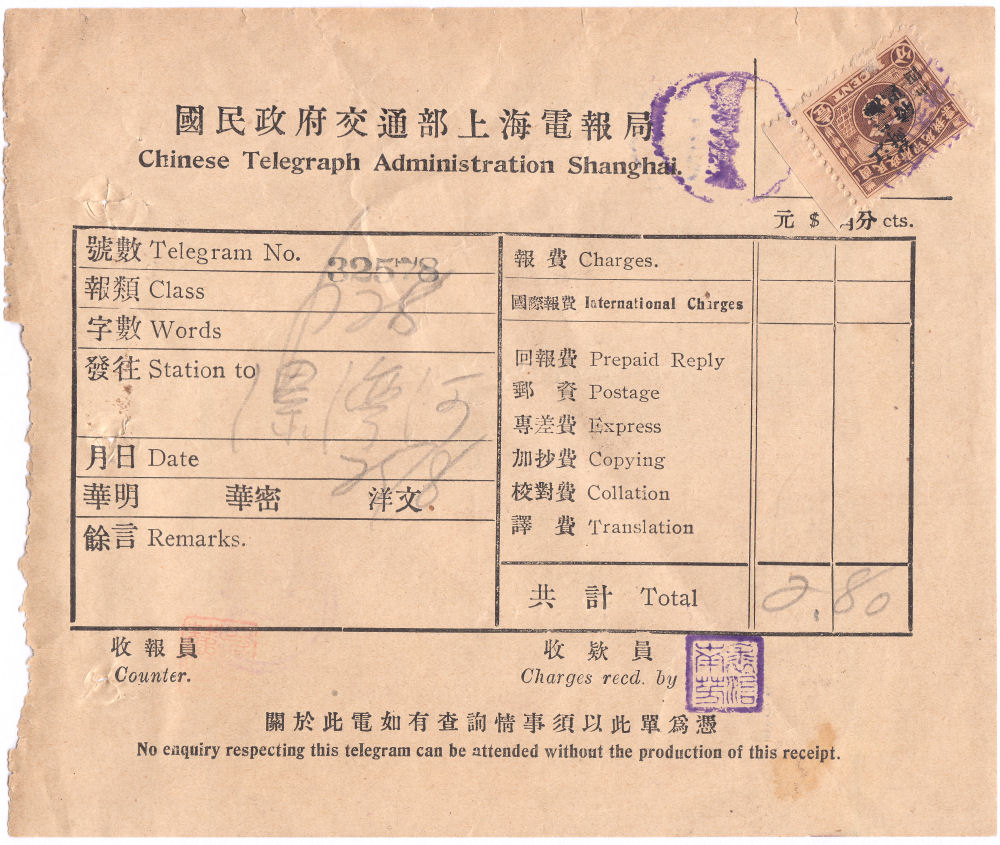
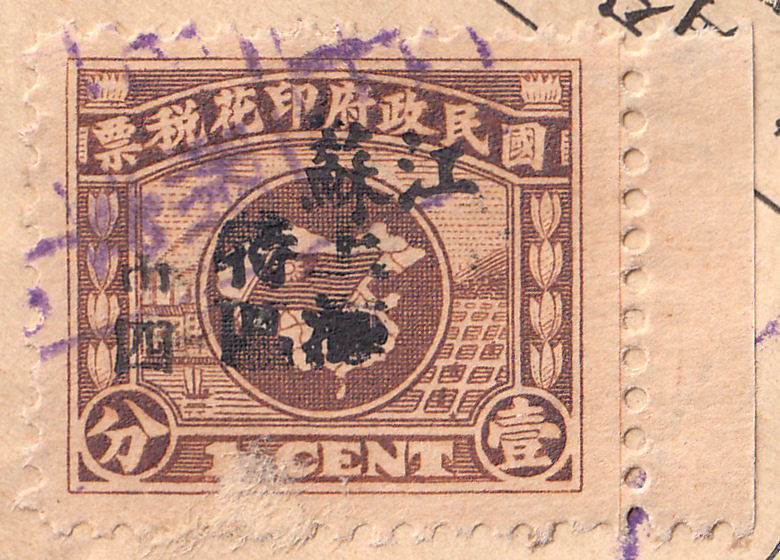
The 1c fiscal is not tied and does not appear to belong on this. It may though indicate the expected type.
27 August 1925.
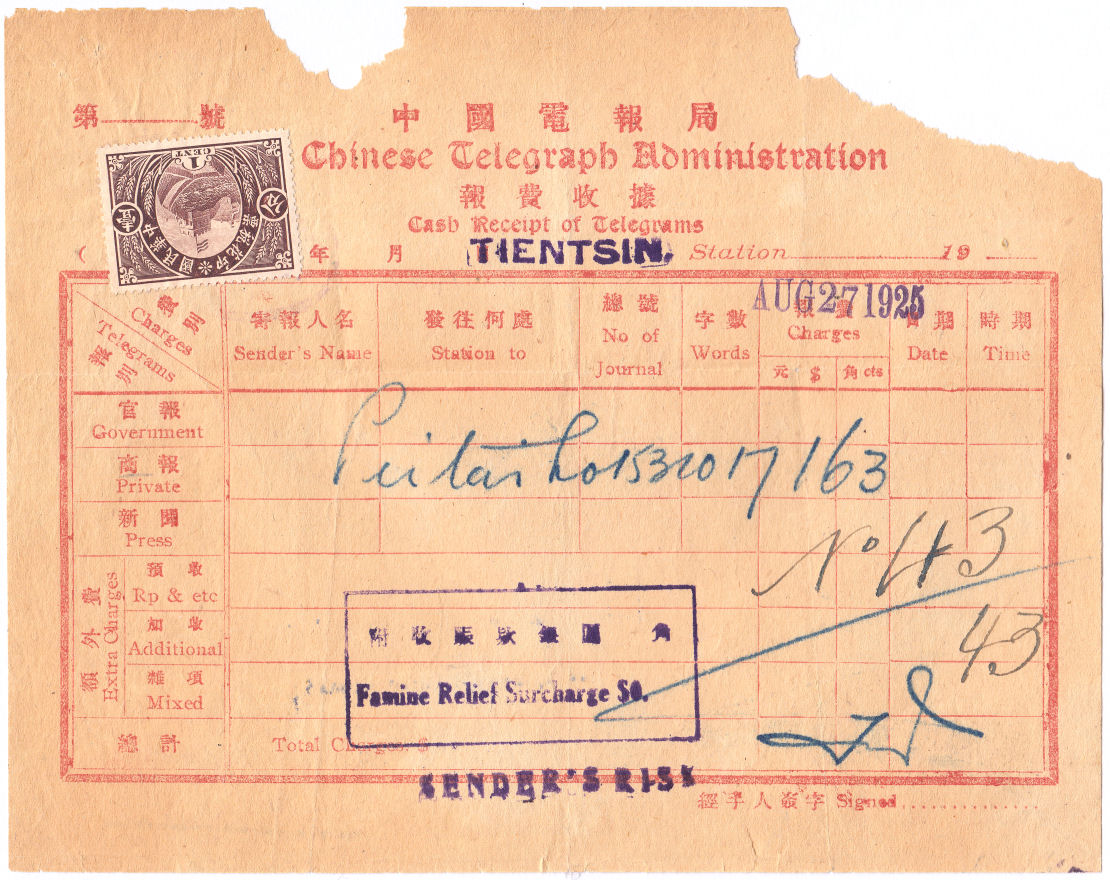
This 1925 receipt has a Famine Relief Surcharge, and the telegram was sent "Sender's Risk".
Form 电1003 - 21-9-1978.
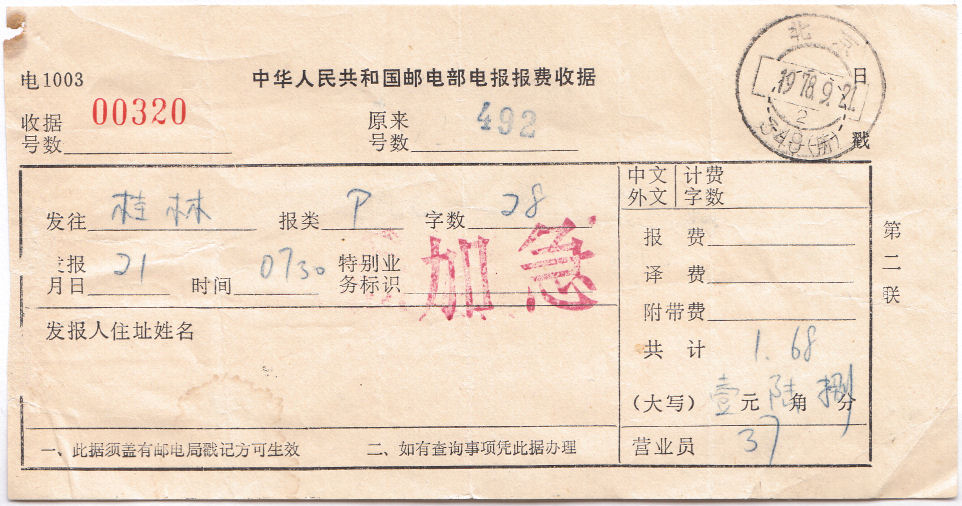
Beijing Expedited Telegraph Receipt. Form 电1003.
Form 电2003 - 17-4-1987.
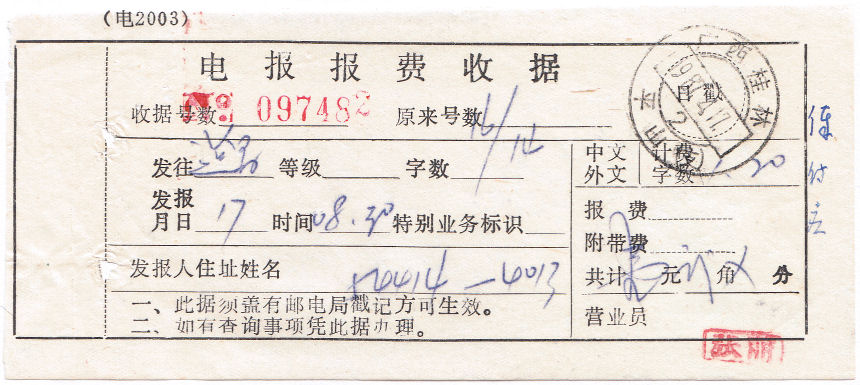
Guangxi Guilin Telegraph Receipt. Form 电2003.
12-8-1987.
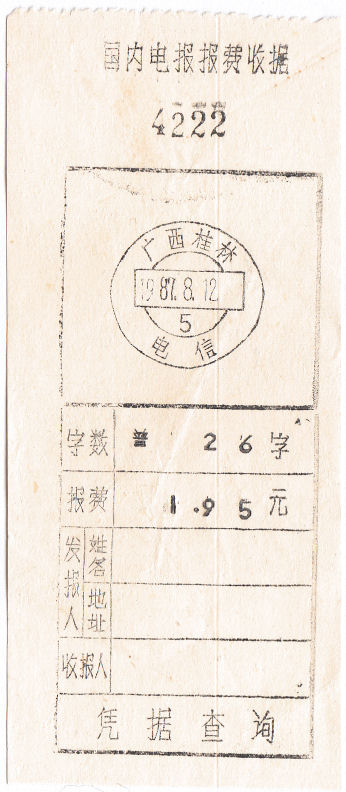
Guangxi, Guilin Telegraph Receipt.
Form 电1002 - 13-5-1993.
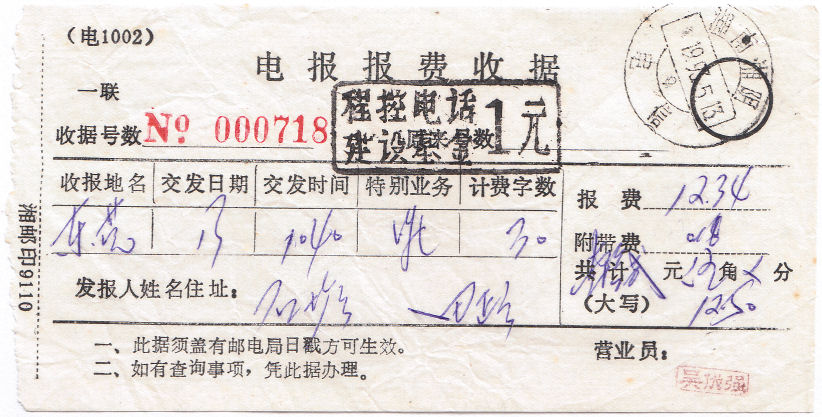
Added charge Telegraph Receipt (Hunan, Xiangyin).
Most of these are marked "Chinese Government Radio Administration" or CGRA (中国政府无线电管理局), set up February 1931.
Most of these examples relate to E. Penn Co. 169 Yuen Ming Yuen Rd (圆明园路). Shanghai.
24 July 1946. This has a tall font for 'RADIOGRAM'.
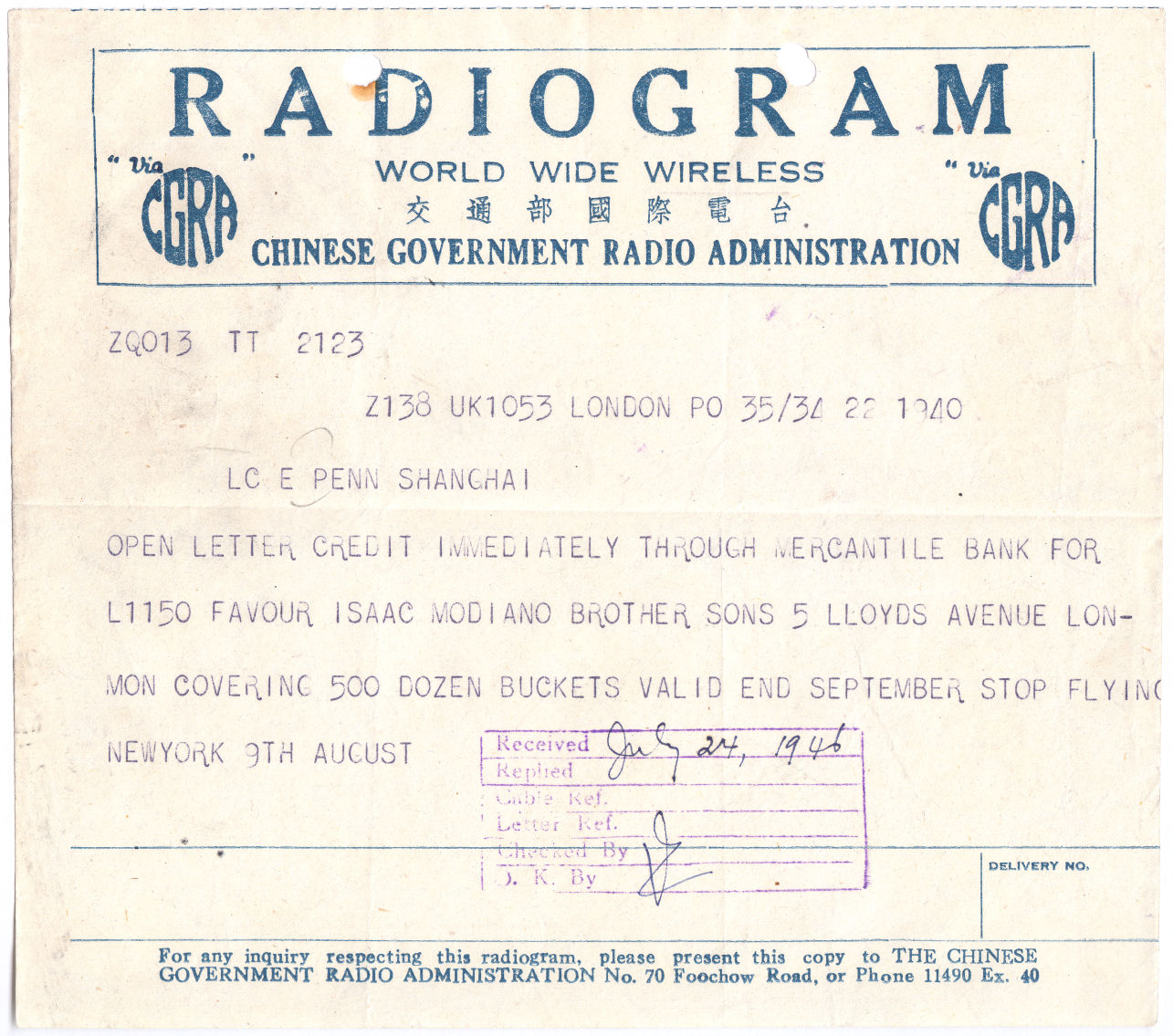
This is on white paper.
16 October 1946. This has a short font for 'RADIOGRAM'.
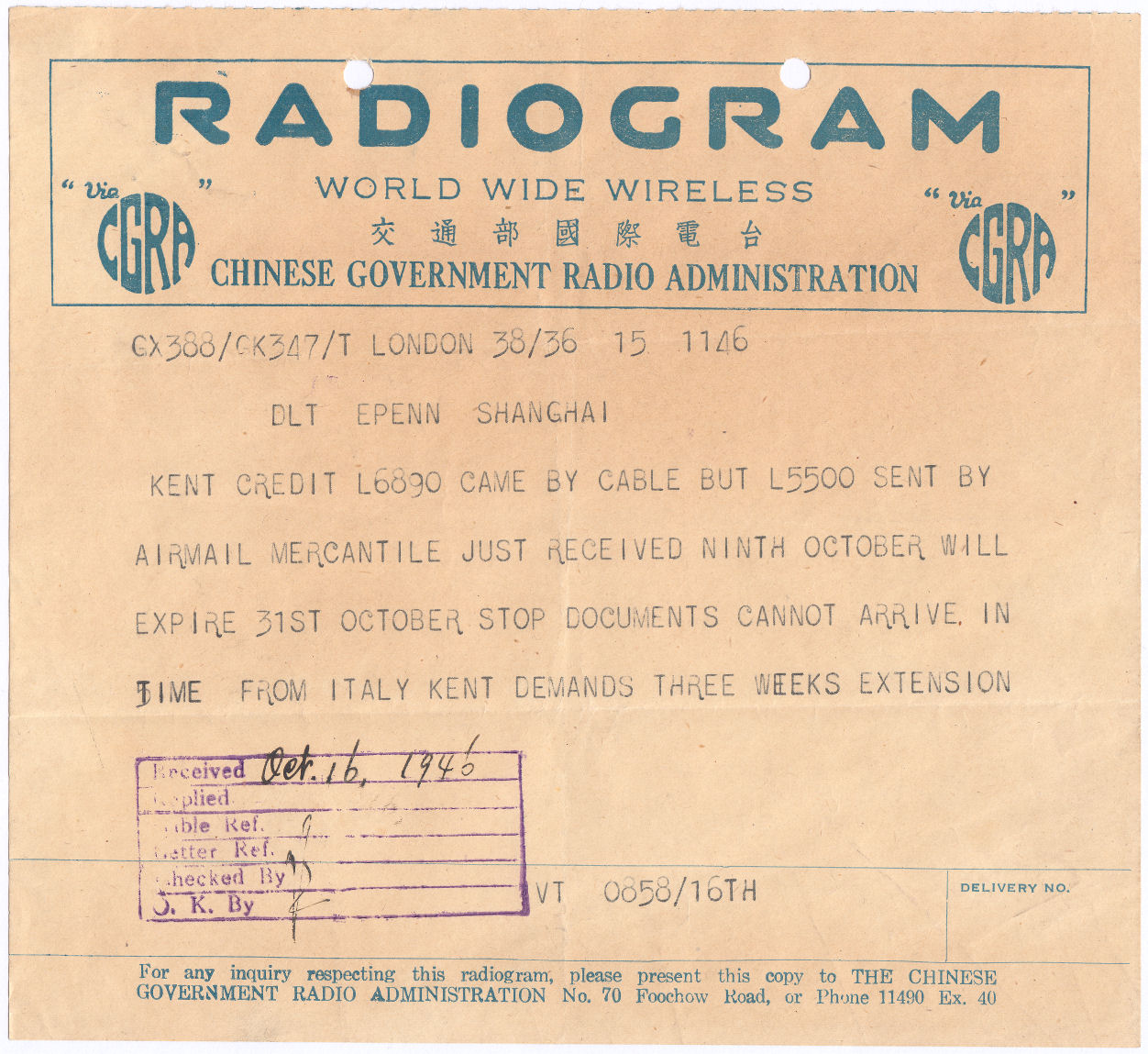
This is blue on yellowish paper.
15 November 1946.
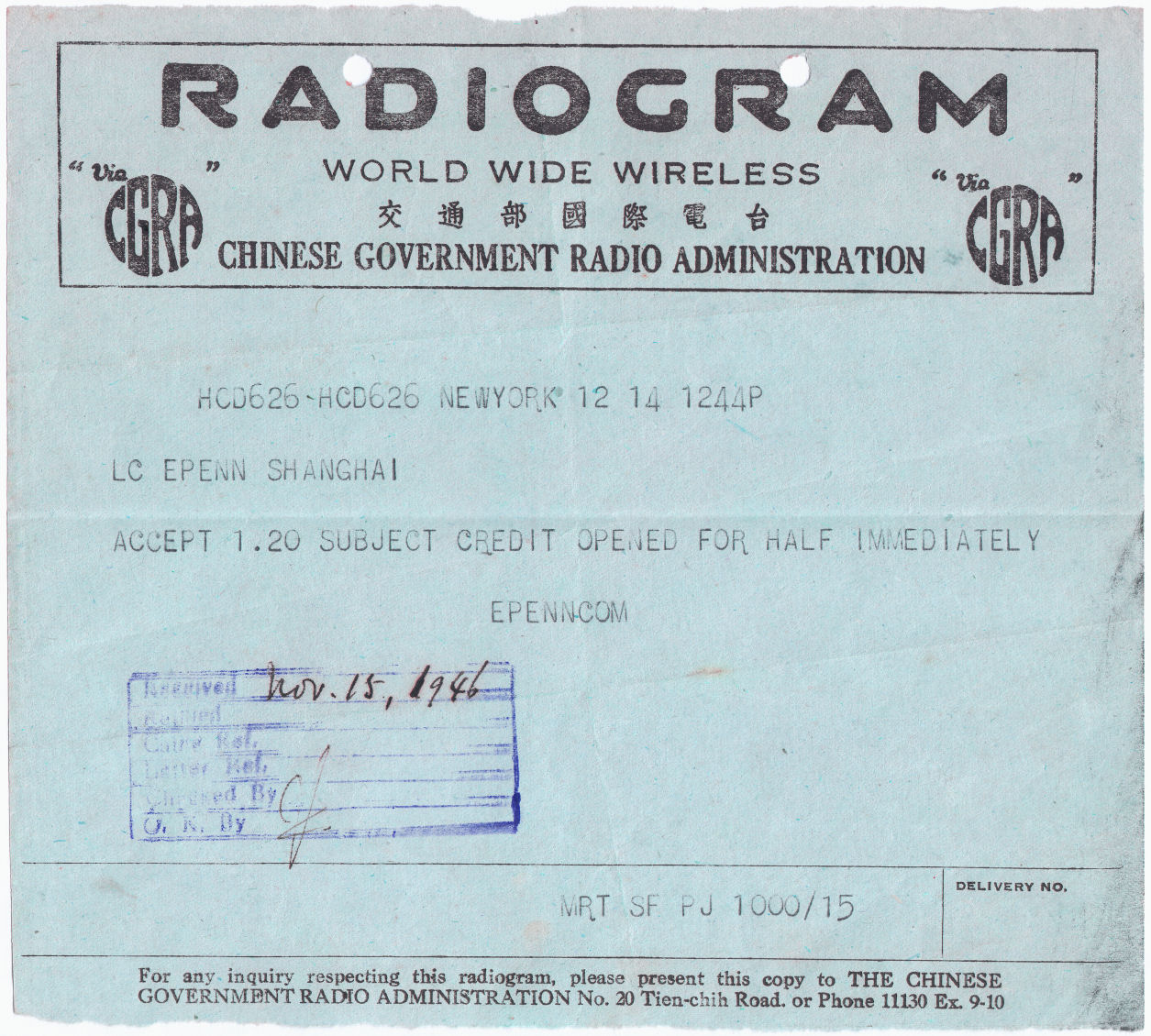
This is black on light blue paper, with a different address and telephone number.
27 February 1946.
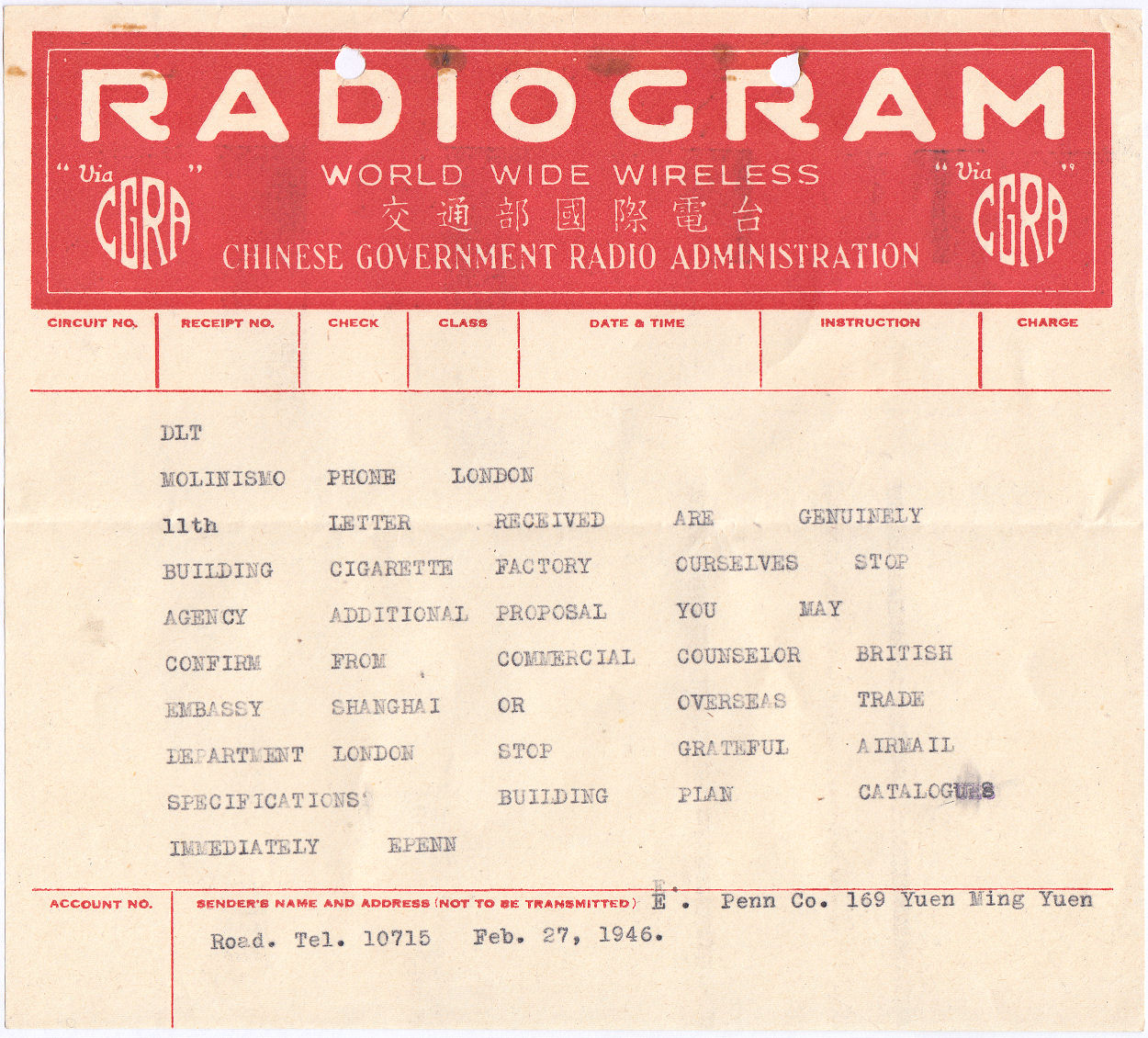
White on red panel at the top.
Date unknown.
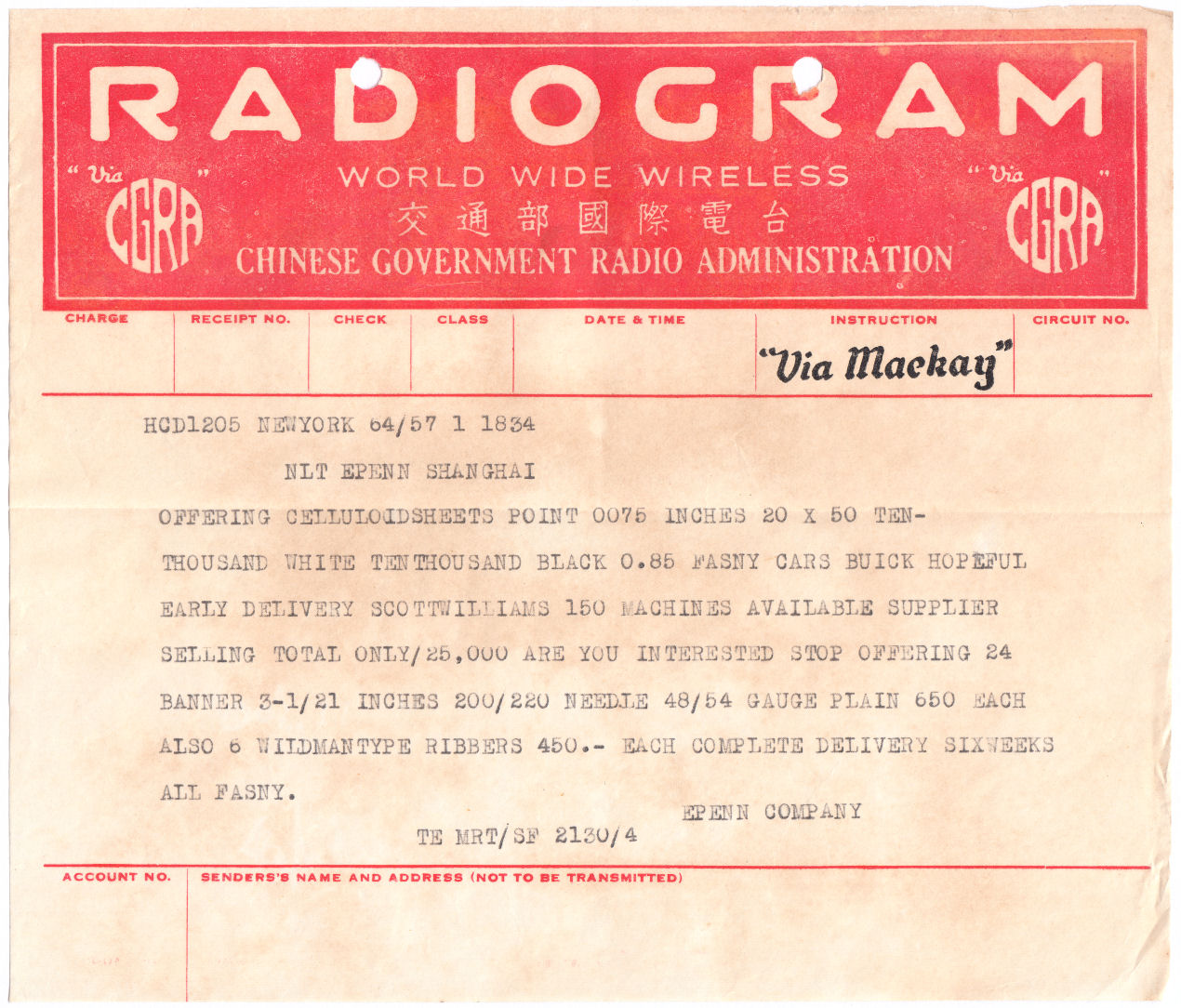
Via Mackay instruction.
26-9-47
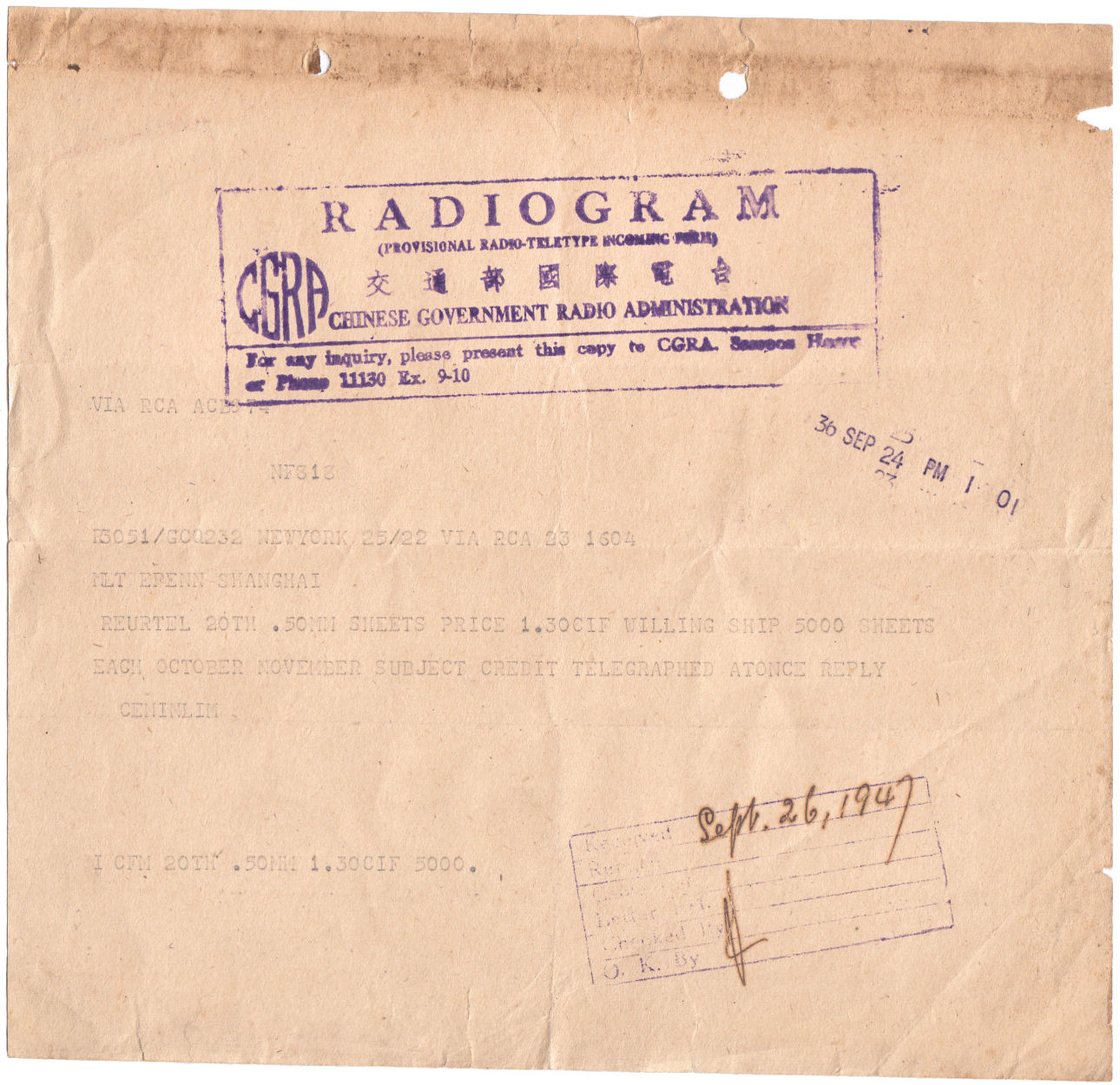
Radiogram (Provisional Radio-Teletype Incoming Form) CGRA Via RCA.
6 April 1946.
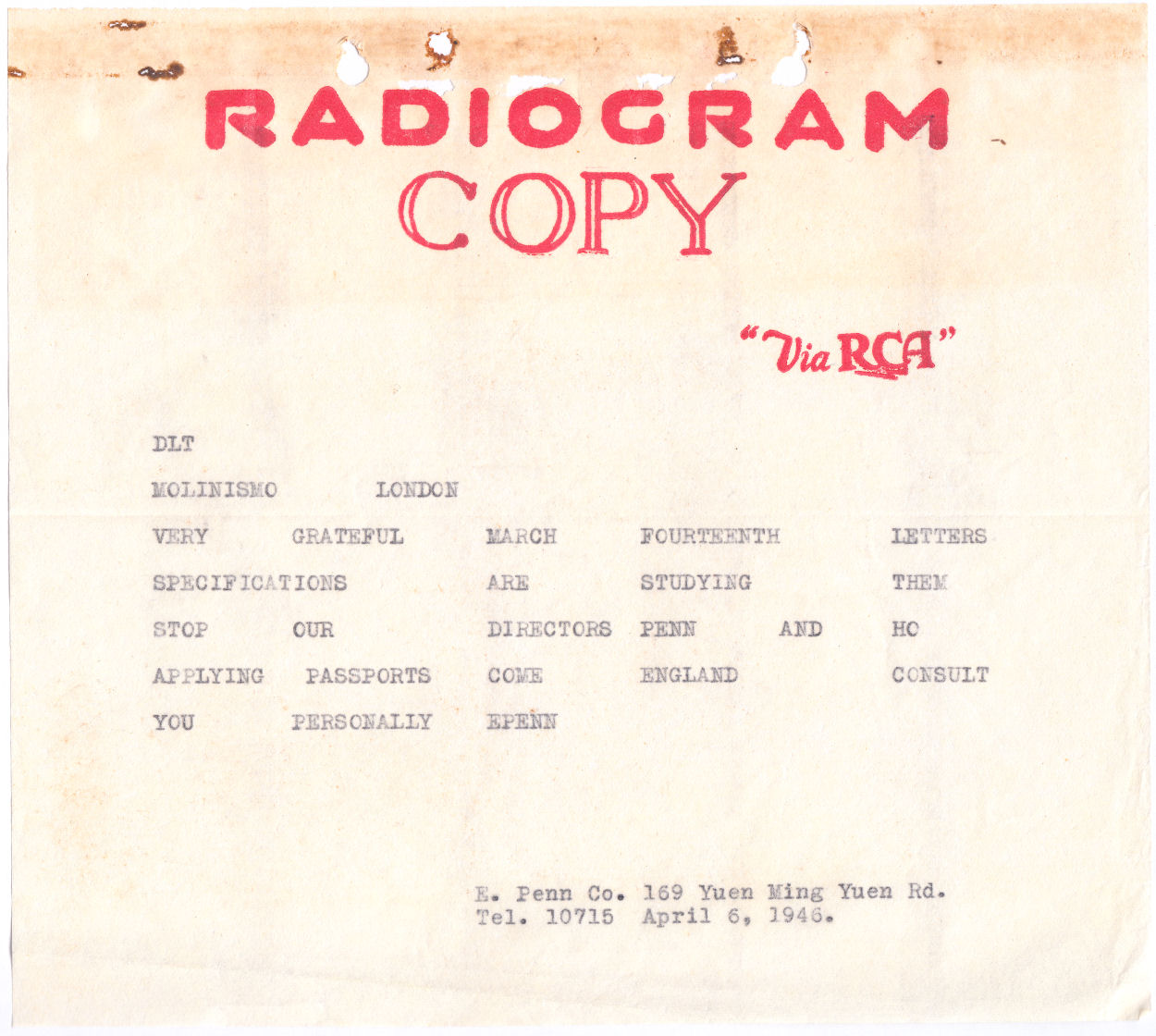
Copy, Via RCA. This is on thin translucent paper.
14 March 1947.
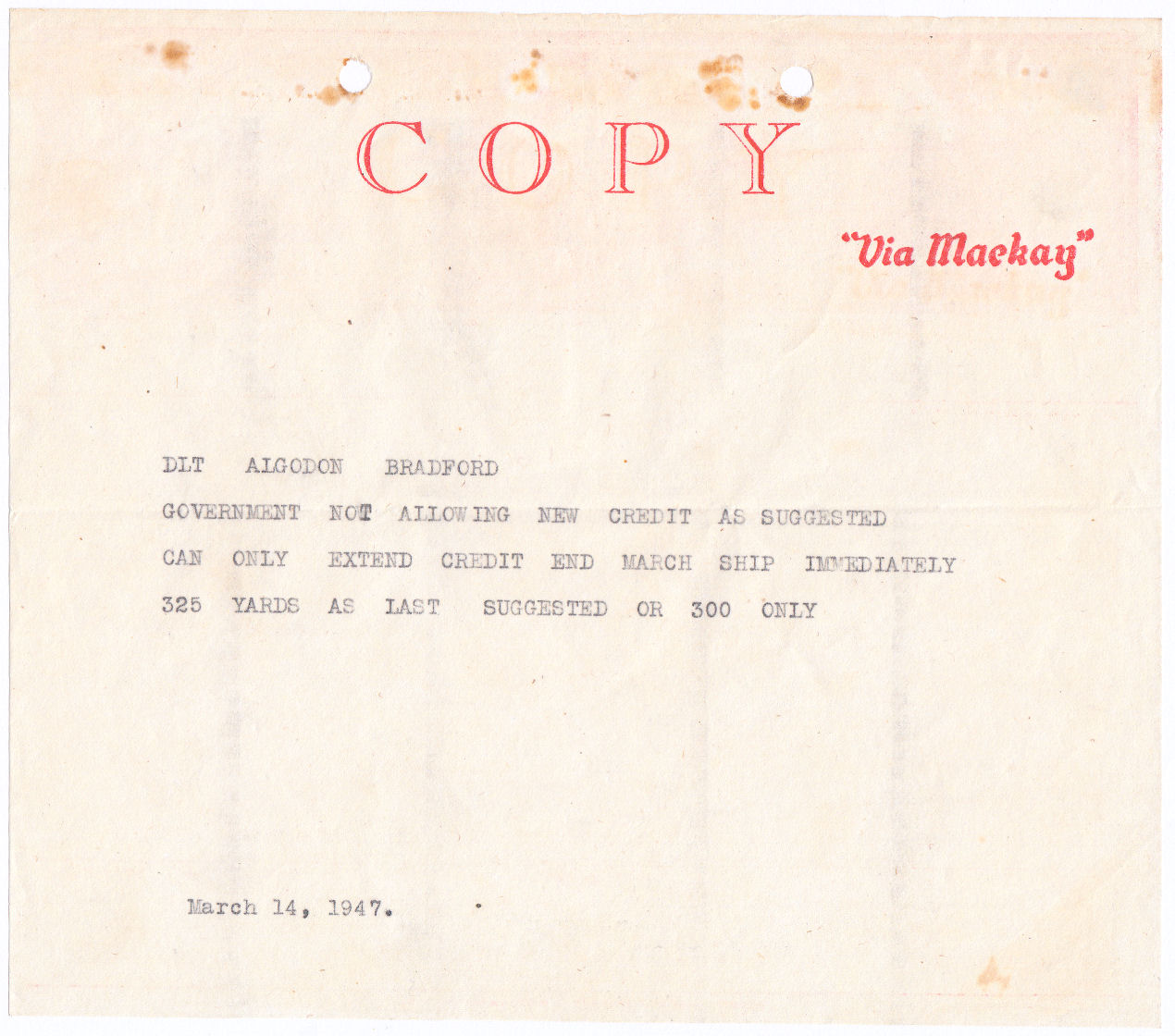
Copy, Via Mackay. This is on thin translucent paper.
17 October 1947.
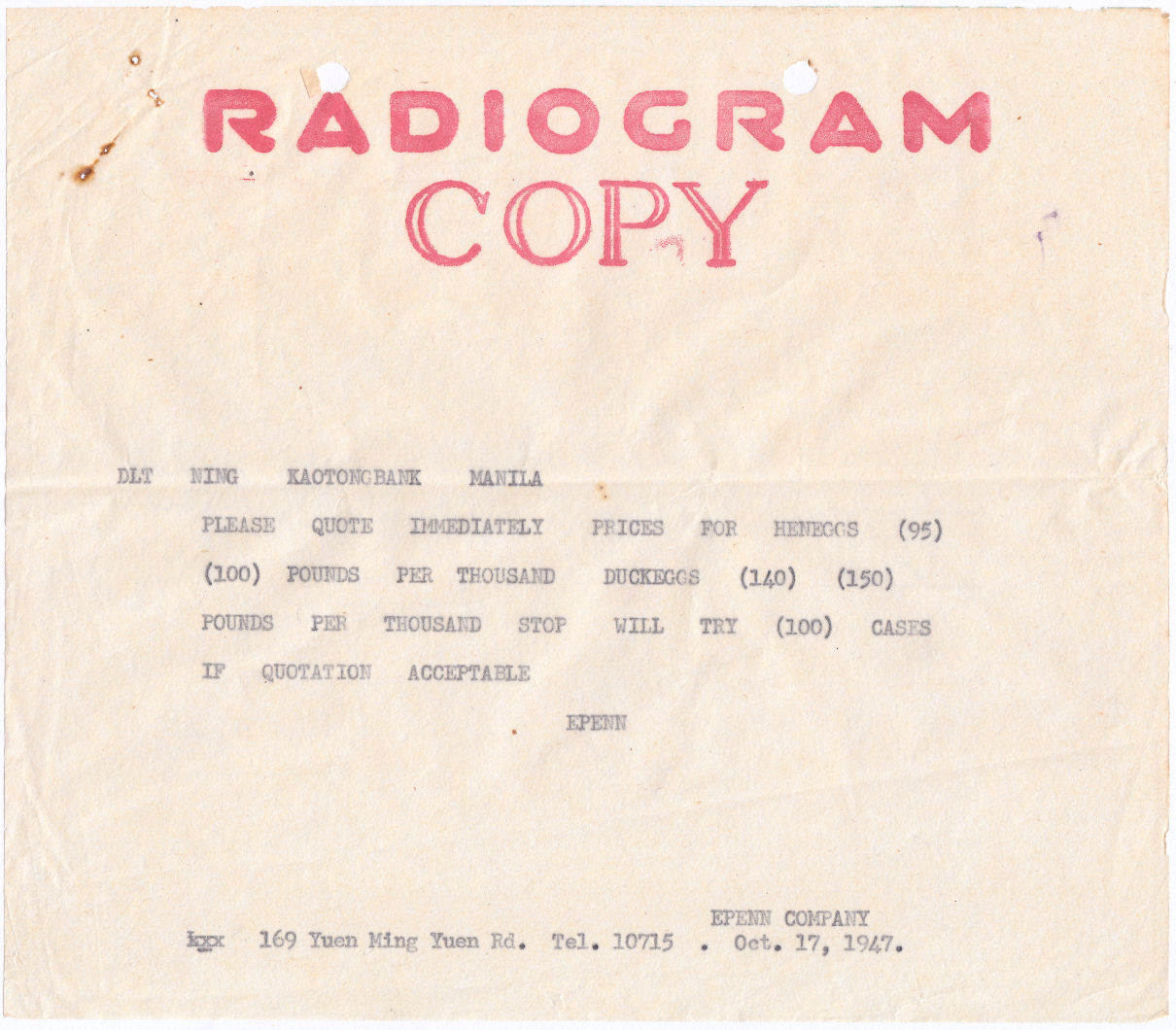
Copy. This is on very thin translucent paper.
1st July 1947.
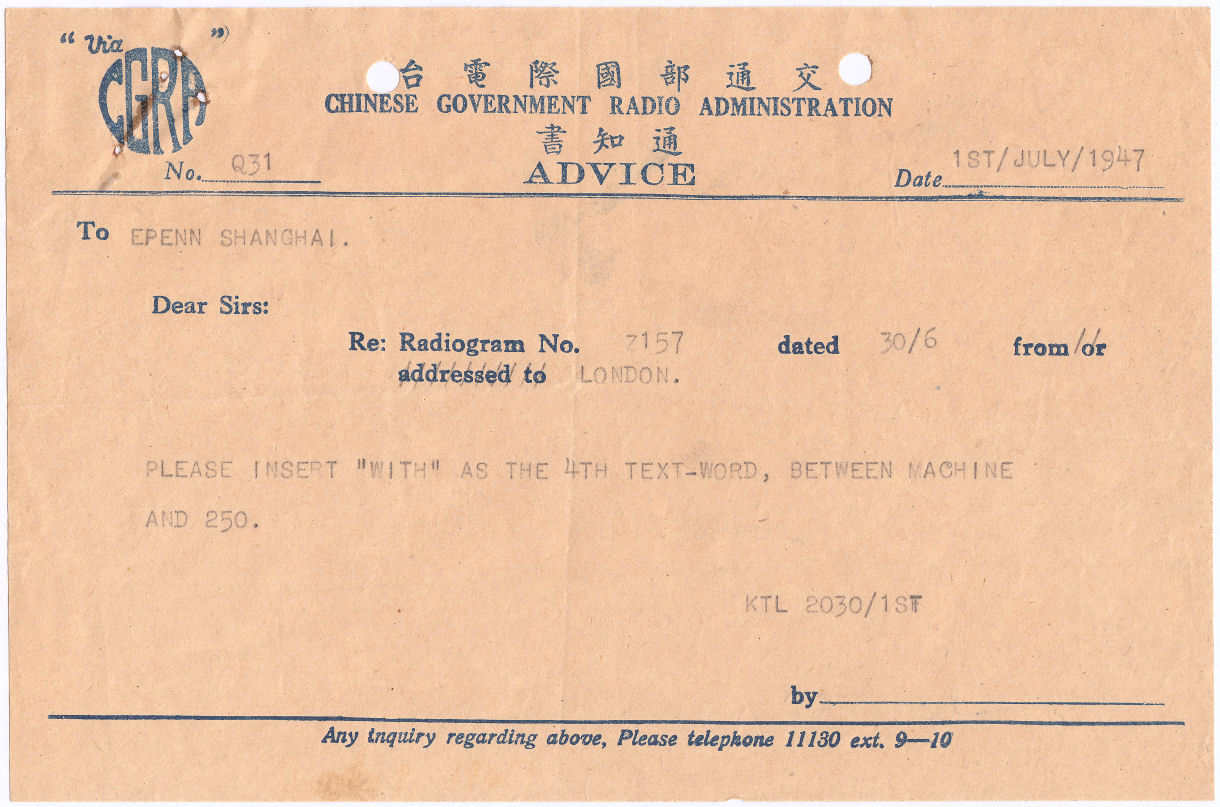
A correction to a Radiogram from London.
Date ? For use in Xinjiang (新疆), Uyghur Autonomous Region (front and back).
电報 = Telegram. The other side of the star logo is the same in (presumably) Uyghur (right to left).
This has 电1001 at the top-left as a form number.
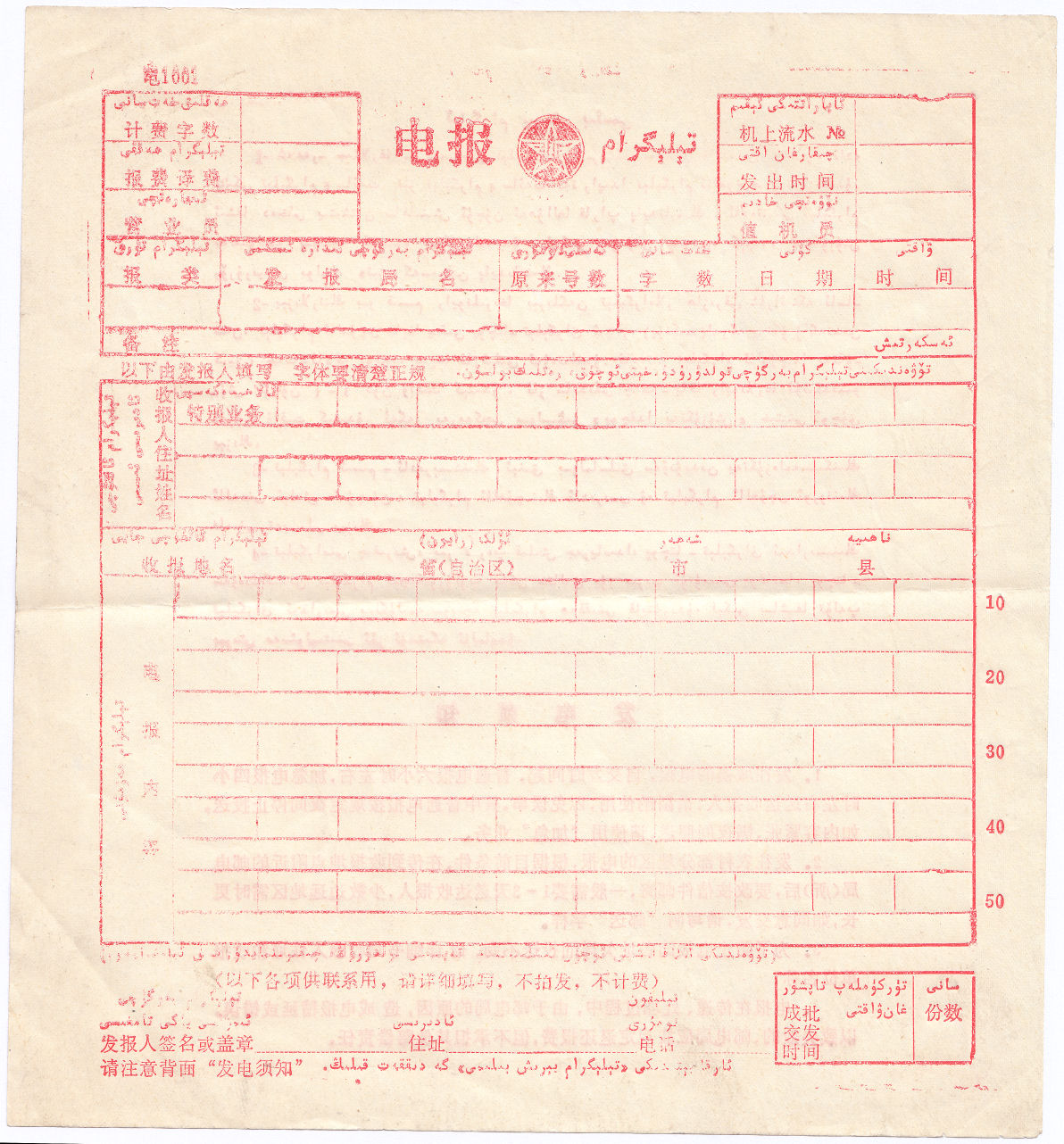
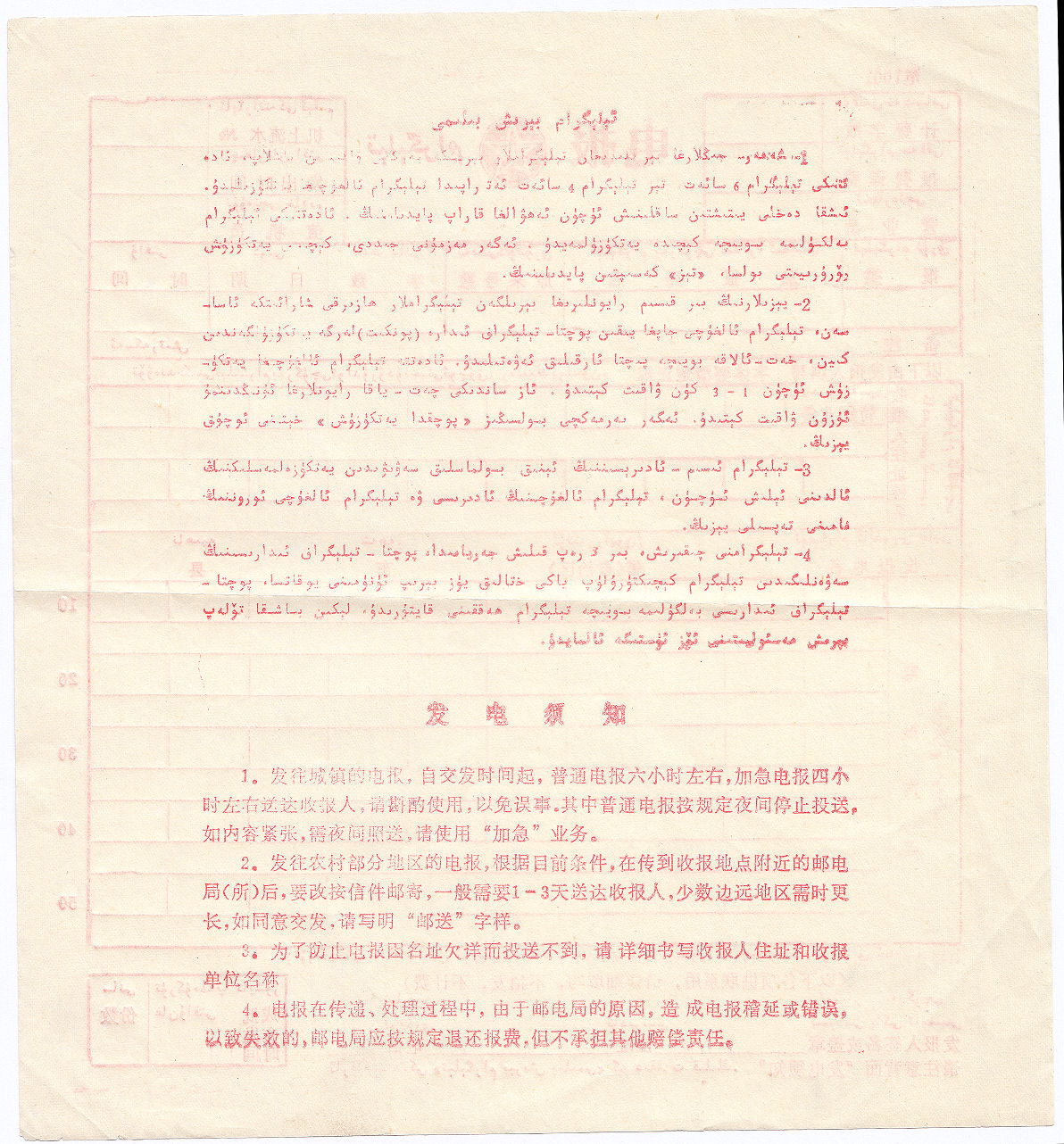
This is on fairly thin paper. I do not know the date of this, but the 5-pointed star logo at the top seems to have started use in 1988. Form 电1001.
Date ? This is very similar to the last, including the form number of 电1001 . However, apart from being better quality, the star logo is a negative version of the last.
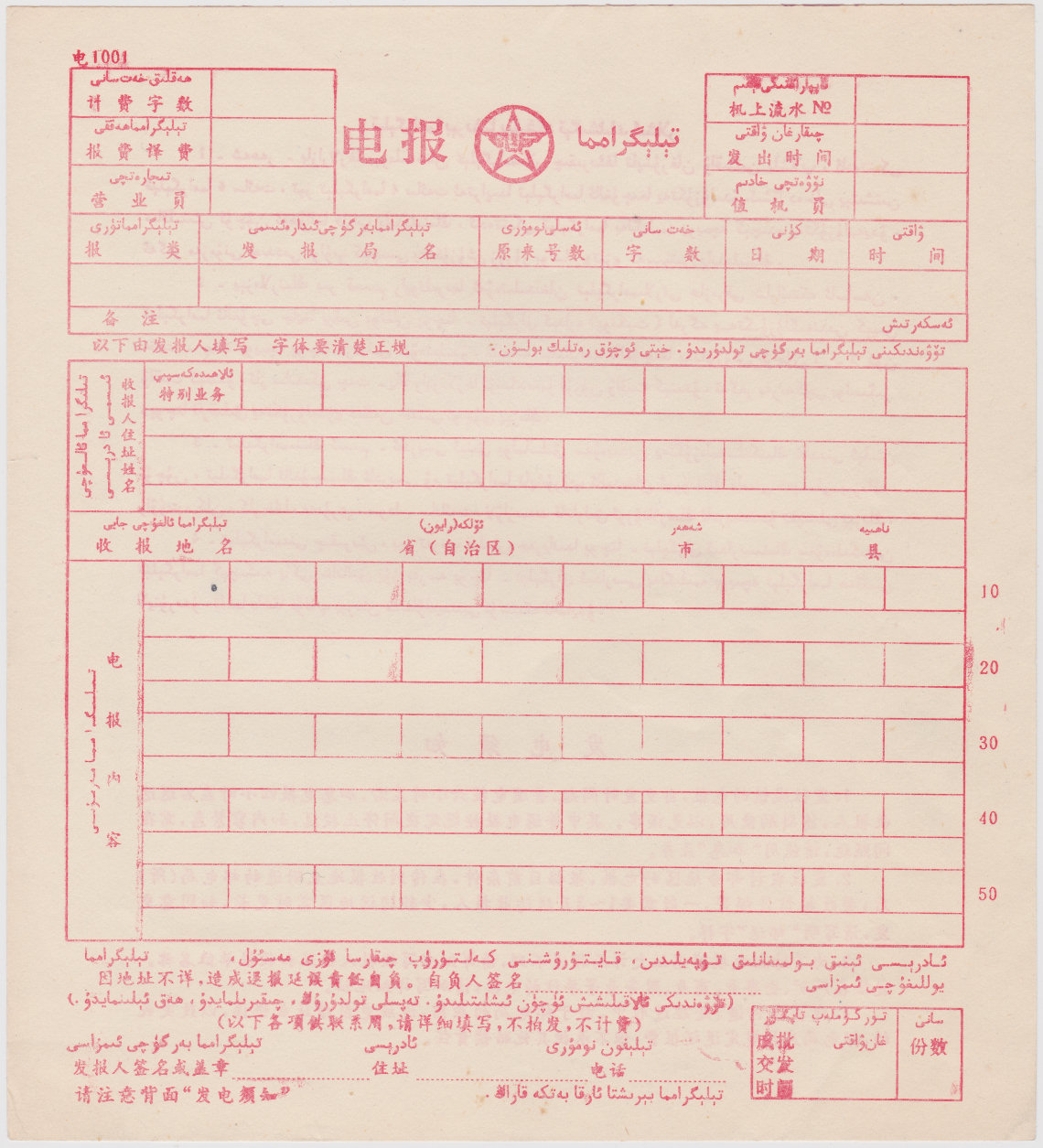
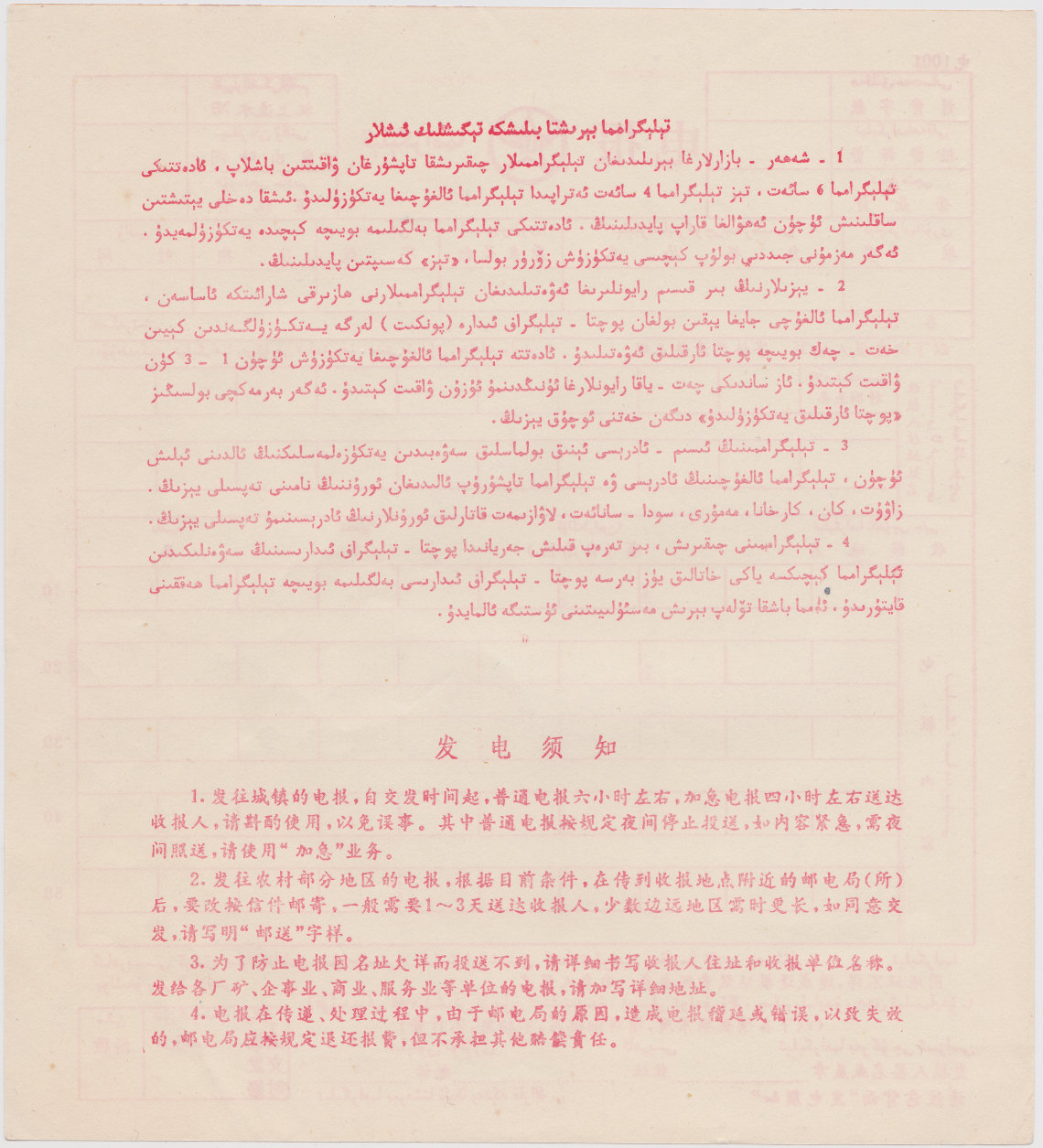
This is better paper. Form still 电1001.
Date ? Along the lines of the last, but in bright pink and including the form number of 电1008.
庆贺电報 = Congratulatory telegram
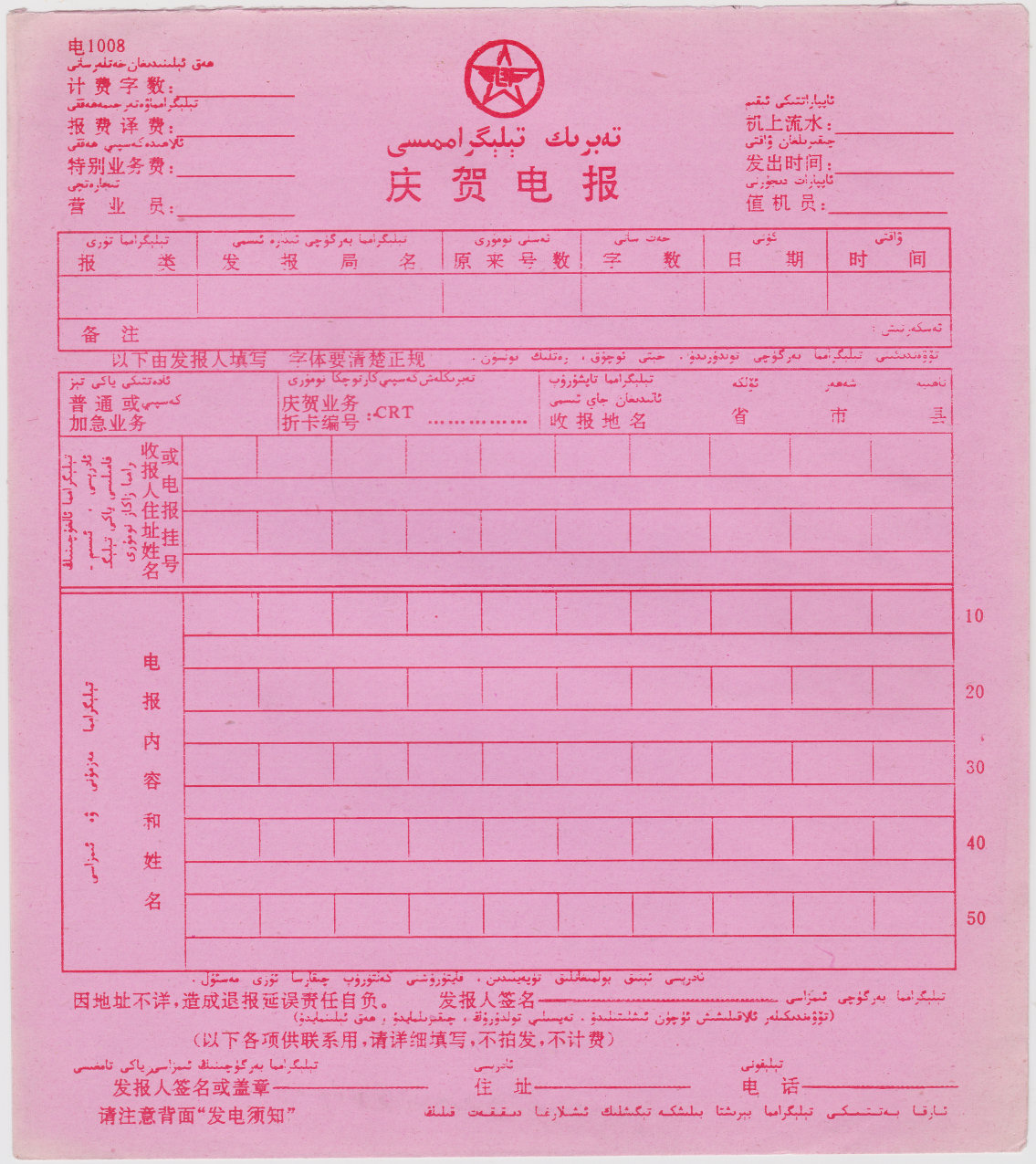
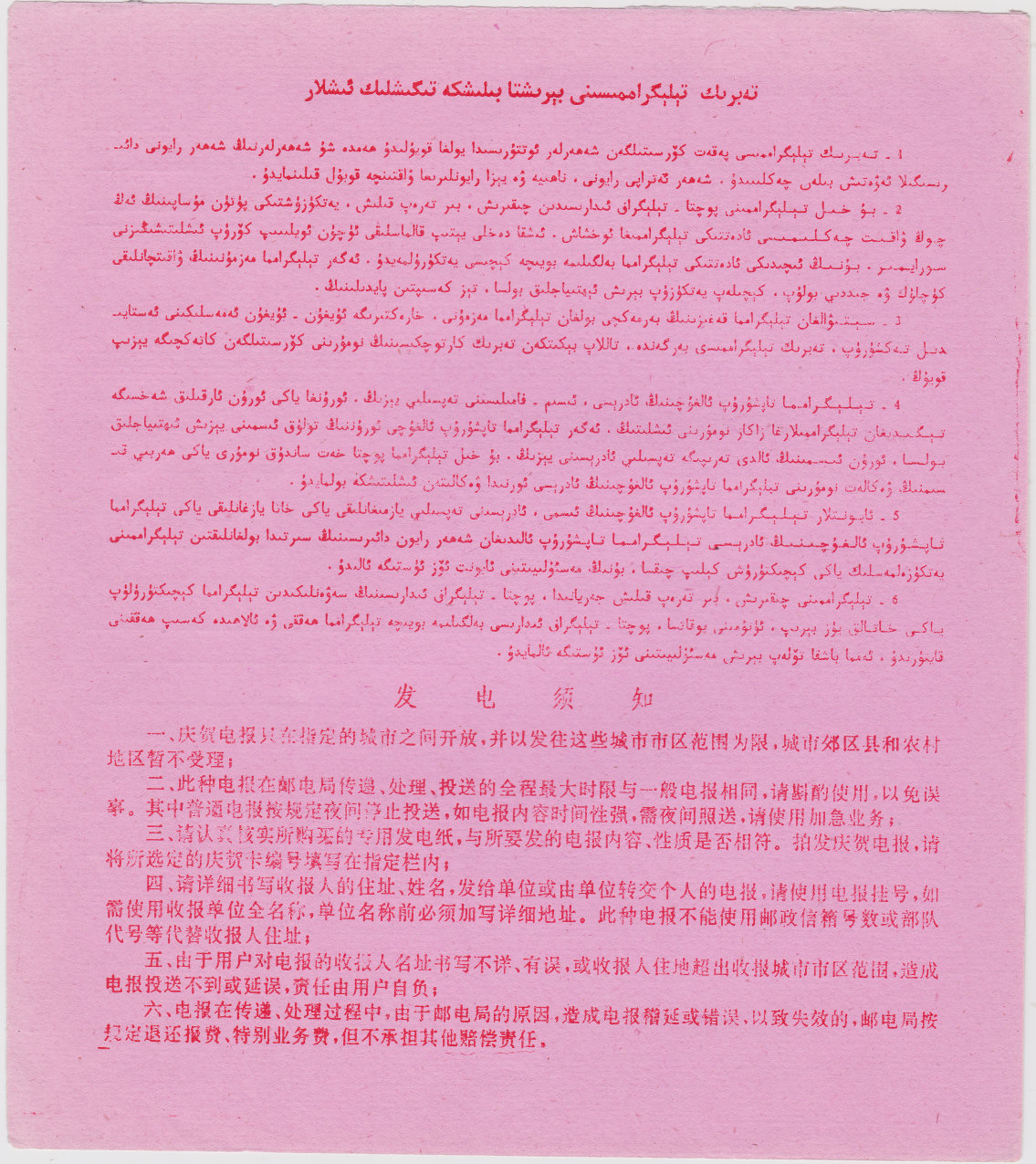
Form number 电1008.
Date ? Along the lines of the last, but in green and including the form number of 电1009.
唁电 = Message of condolences
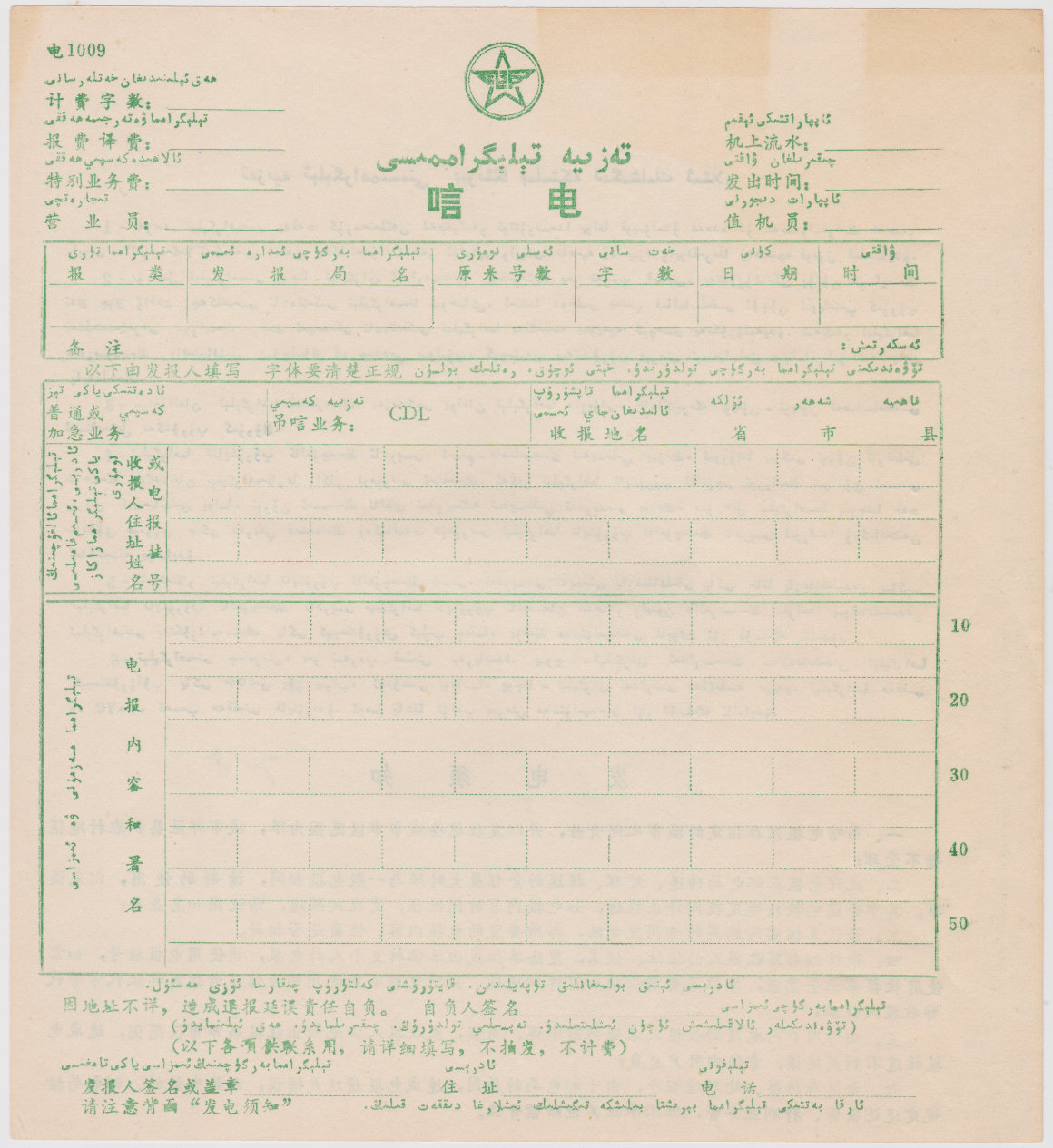
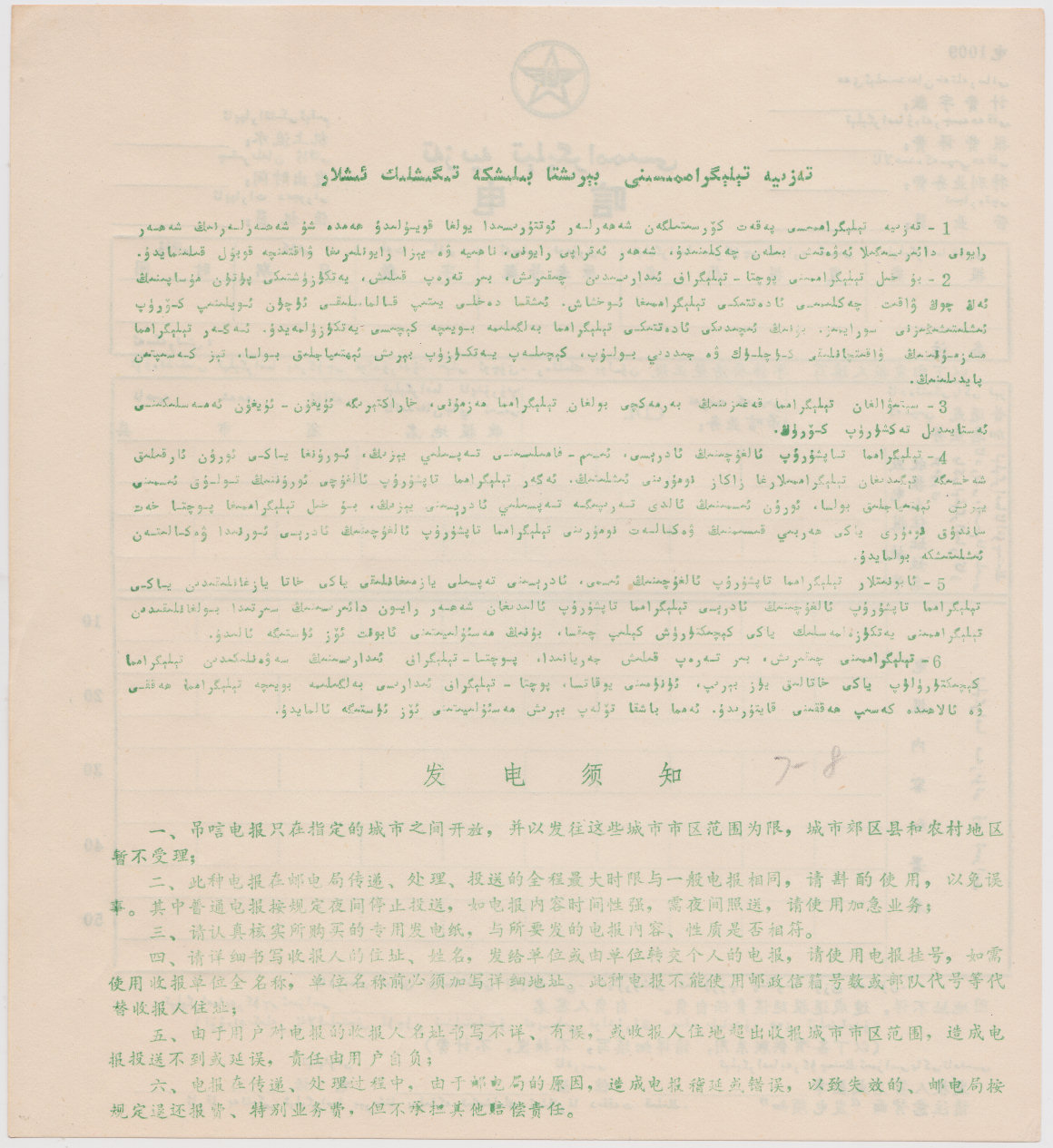
Form number 电1009.
Date ? Along the lines of 电1001, but in blue, with a different Logo, and no form number.
The new Logo represents the Xinjiang Uygur Autonomous Region Telecommunications Company.
电報 = Telegram
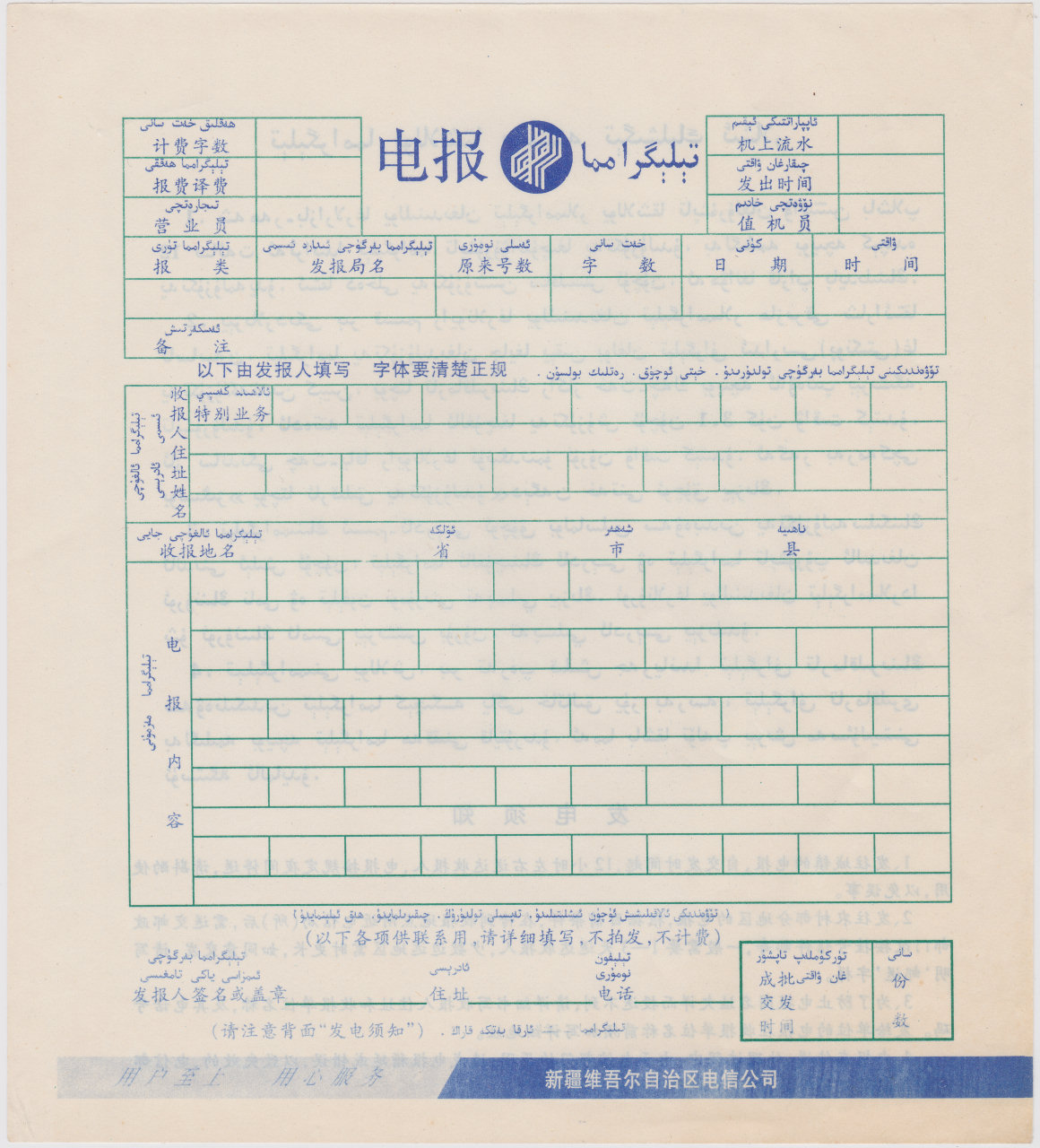
Across the bottom is :
用户至上 用心服务 - 新疆维吾尔自治区电信公司
Meaning : Customer First, Attentive Service - Xinjiang Uygur Autonomous Region Telecommunications Company.
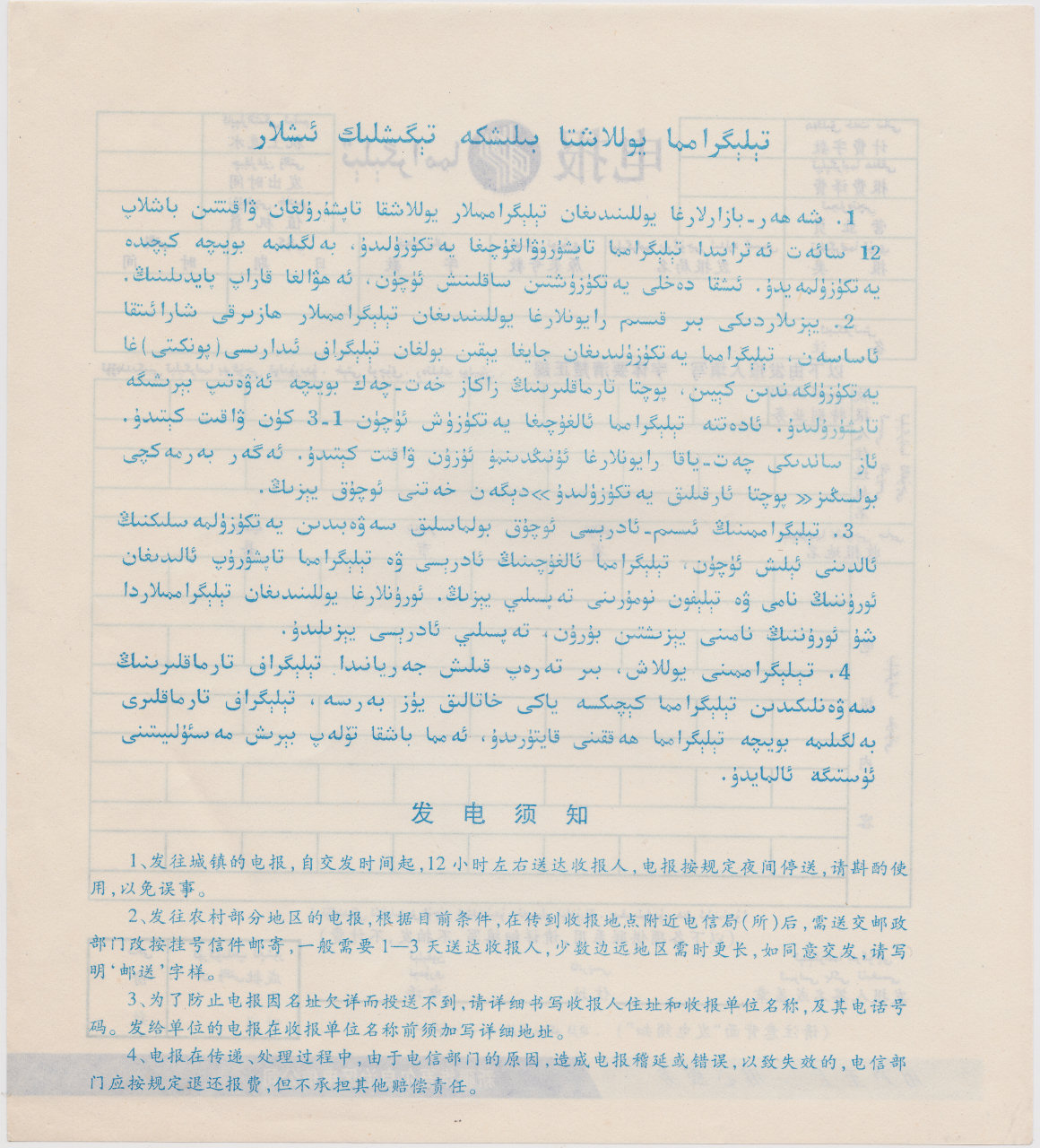
No Form number.
Date ? Form 电1104 - For use in Xinjiang (新疆), Uyghur Autonomous Region.
The top reads: 公电纸 = Public electricity paper (as in reporting a problem?)
Below that is 流水号数 meaning Serial number
Below that are 7 boxes :
报类 = Report class; 收报局名 = Receiving office name; 发报局名 = Issuing office name; 原来号数 = Original number; 字数 = Number of words;
日期 = Date; 时间 = Time.
The last line is 备注 meaning Remarks.
Over on the right is 路由流水 meaning "Routing flow" and 发出时间和伐号 meaning "Issue time and account number"
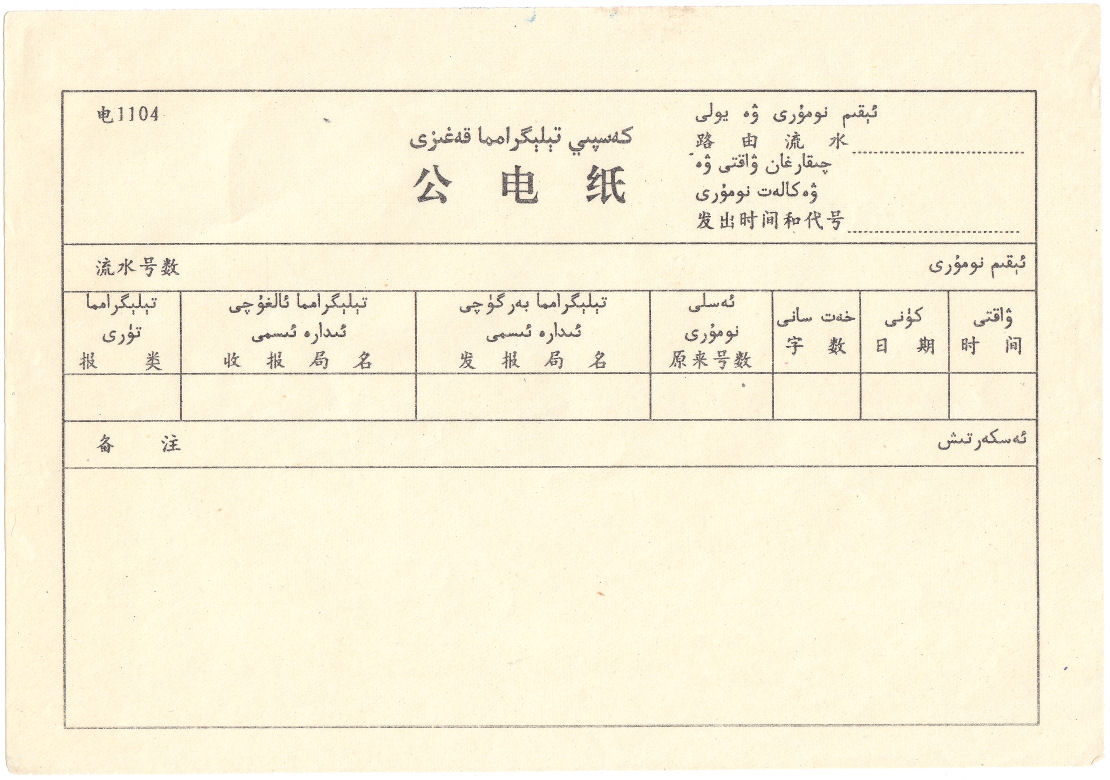
Even after translating the Chinese, I'm still not sure what this was for ! (Form 电1104) - nothing on the back.
Date ? Unused form with return part, for use in Xinjiang (新疆), Uyghur Autonomous Region.
Front
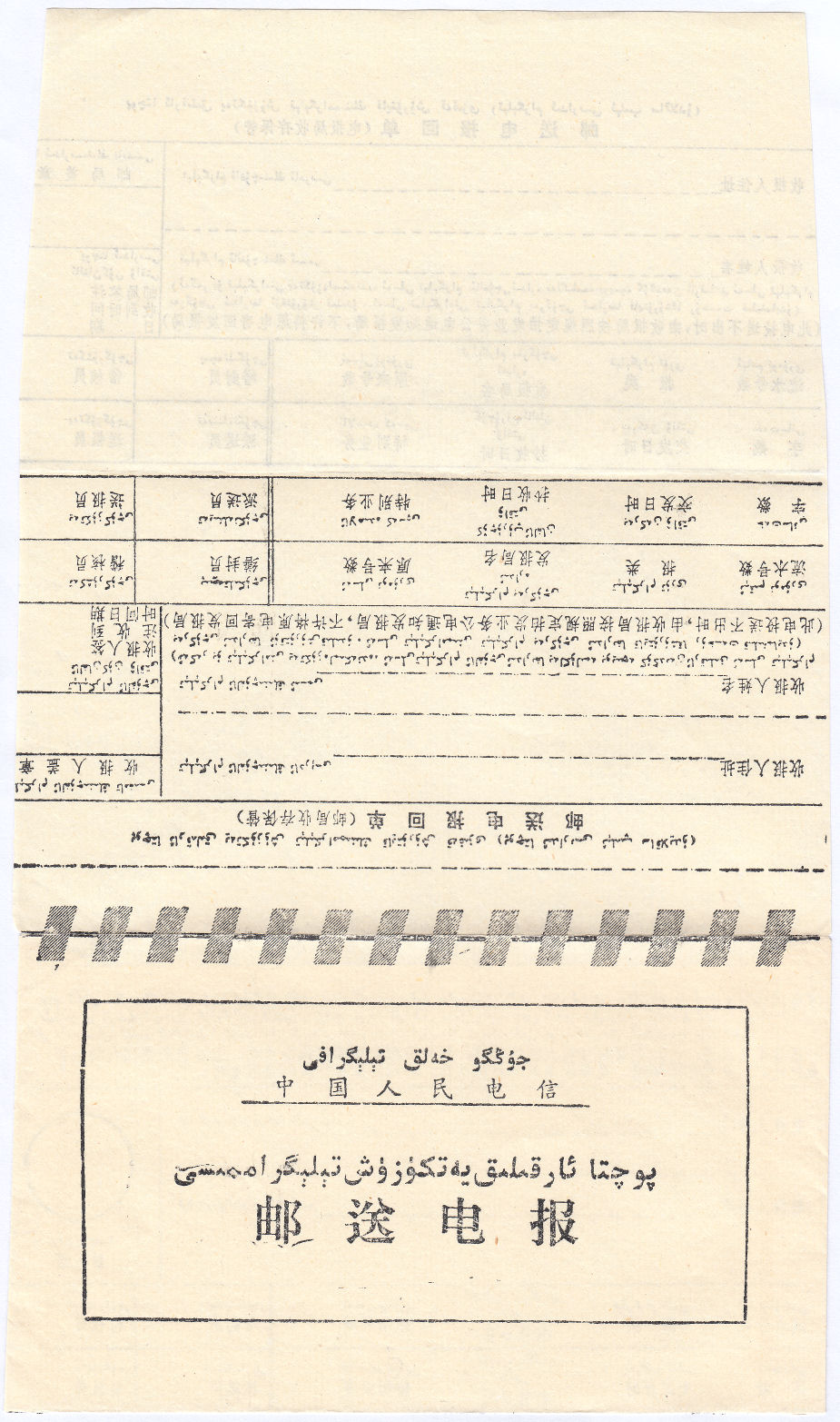
Back
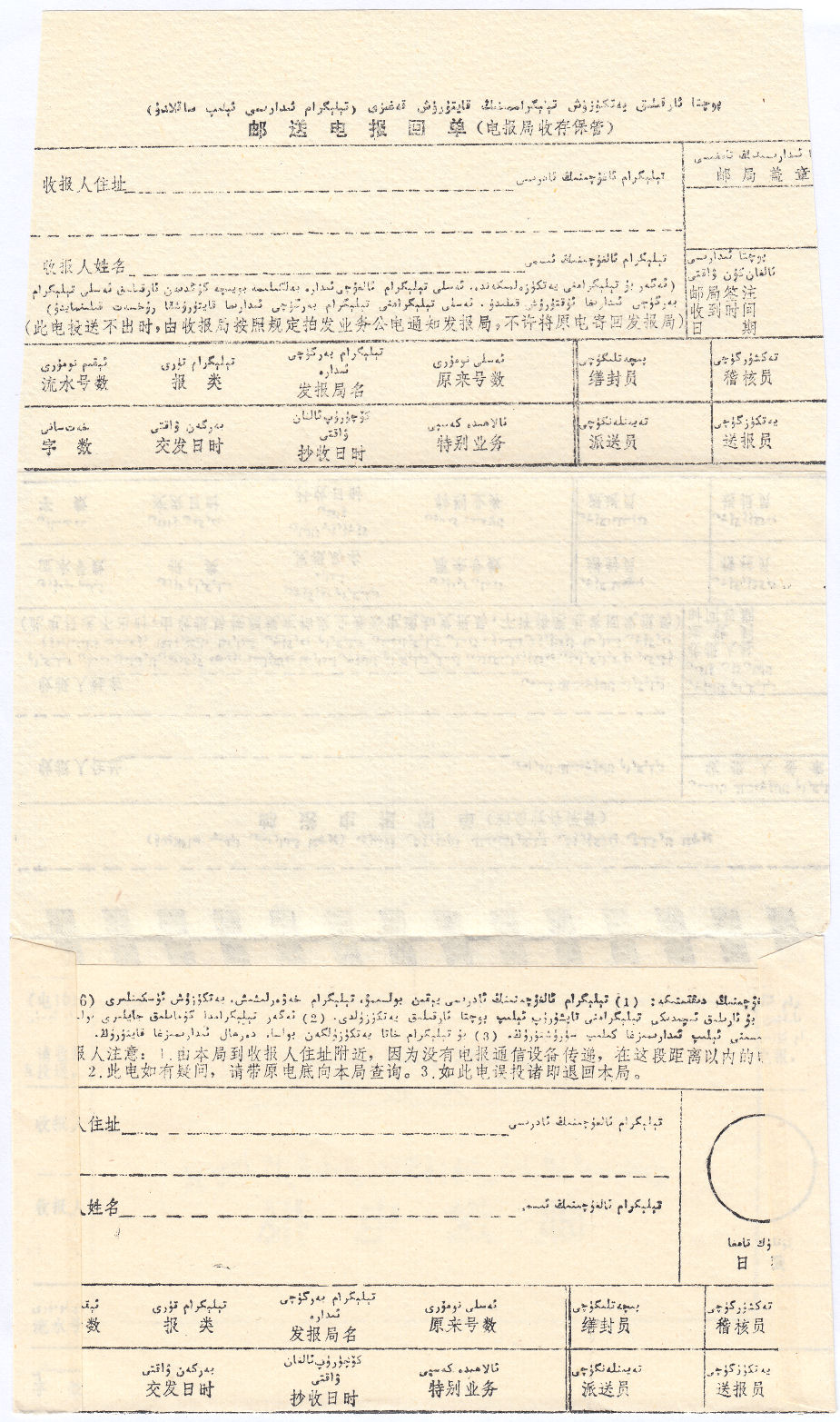
Form 电1016 (under flap, top-left on the lower part of the back)
Date ? Unused form in green with return part, for use in Xinjiang (新疆), Uyghur Autonomous Region.
This has the 5-pointed star.
Front
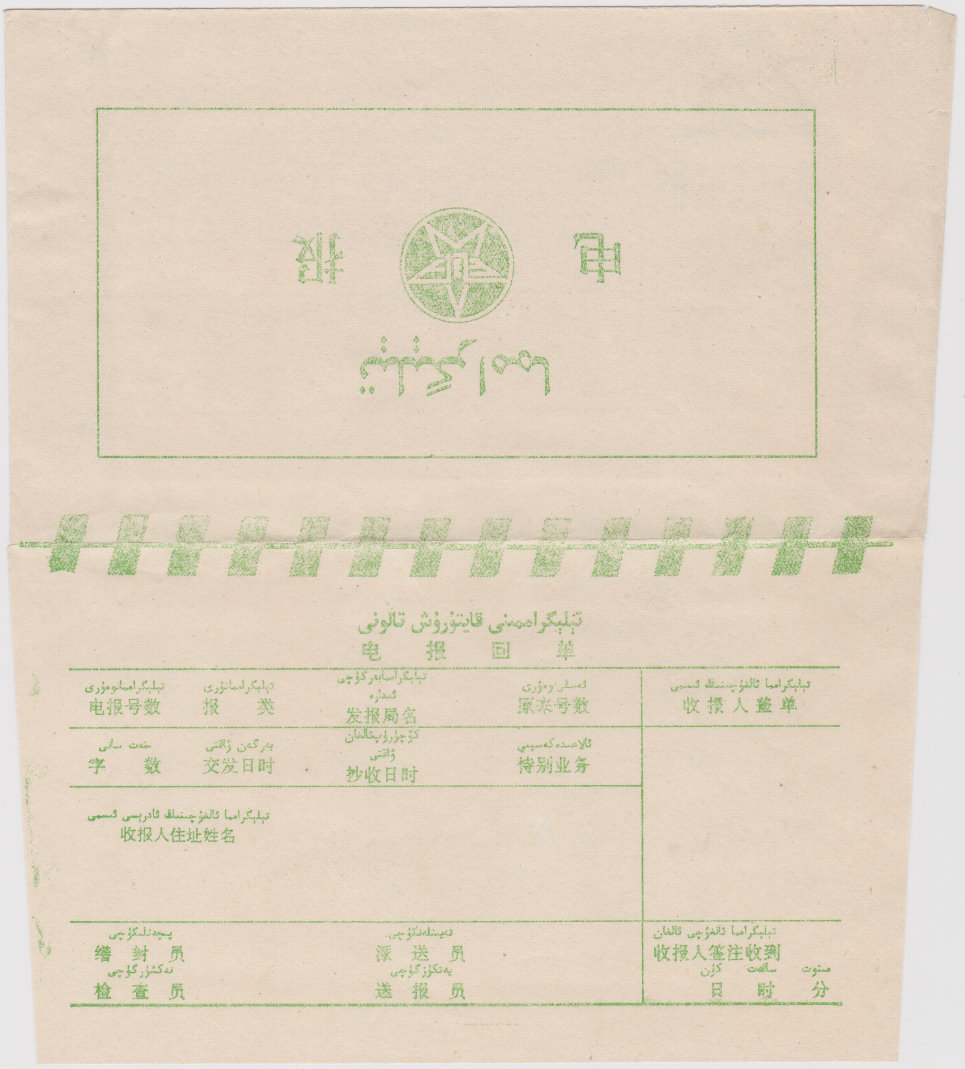
Back
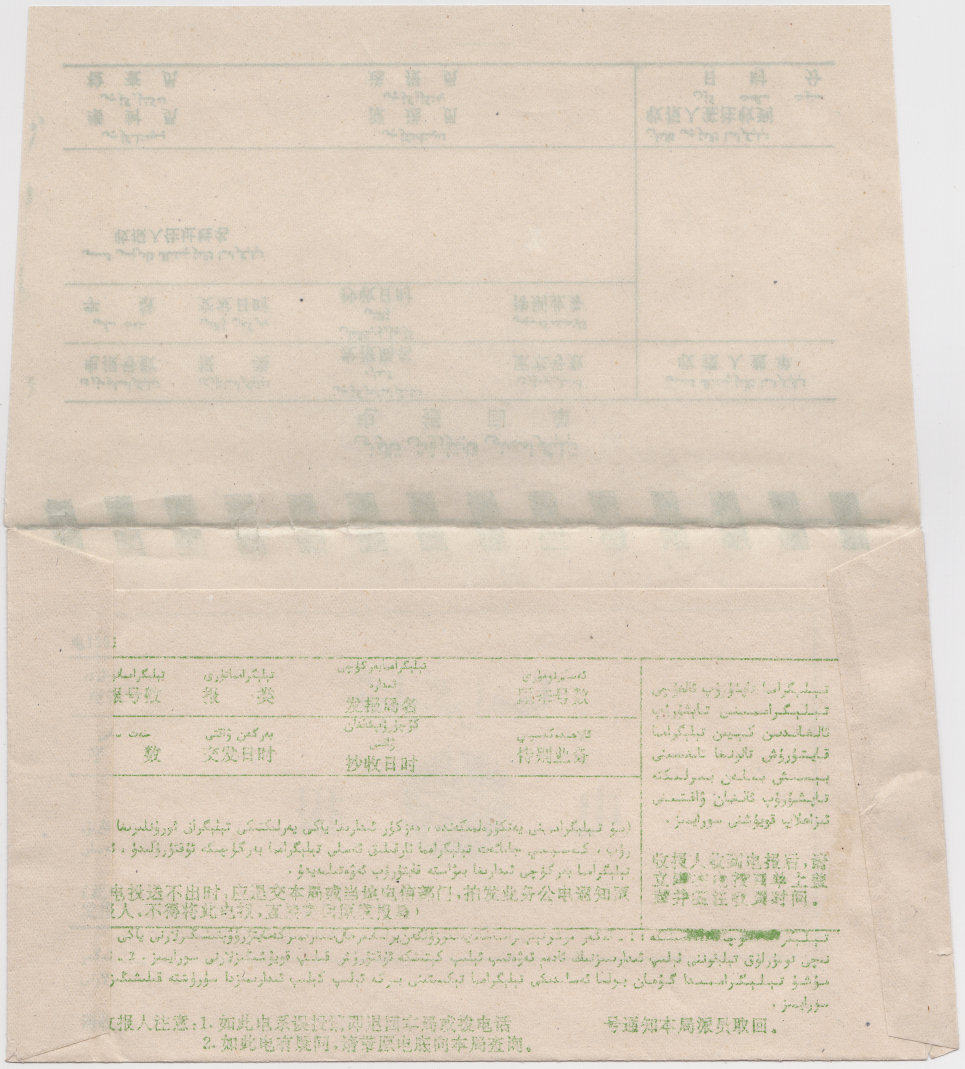
Form 电1306 (I think, again under the flap, top-left on the lower part of the back)
Date ? Used form 1015 with contents, for use in Xinjiang (新疆), Uyghur Autonomous Region.
Thie Uyghur is now in Westernised Script.
Front
The Chinese handwriting is a quotation from Mao Zedong (毛泽东) with his name (signature? Supposedly) on the second line.
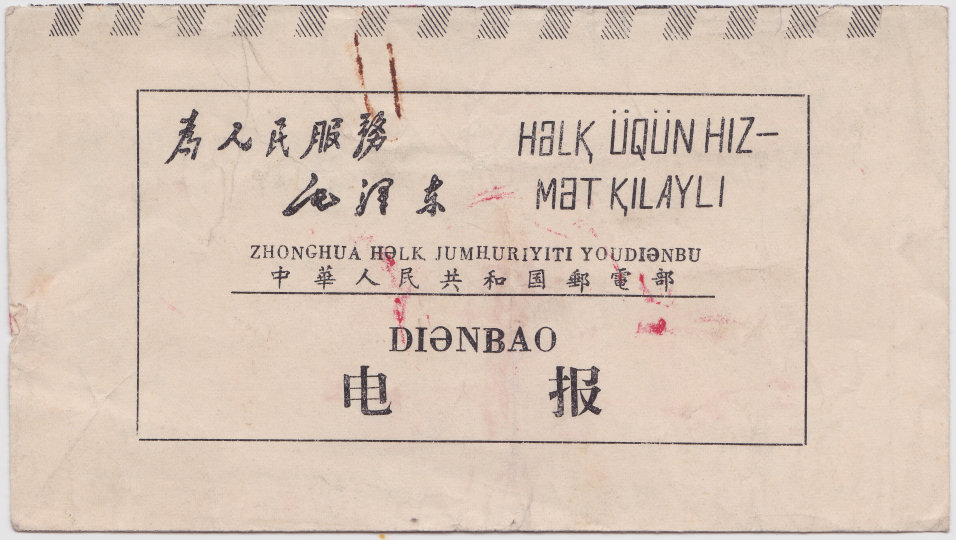
Back - clearly showing the form number 1015.
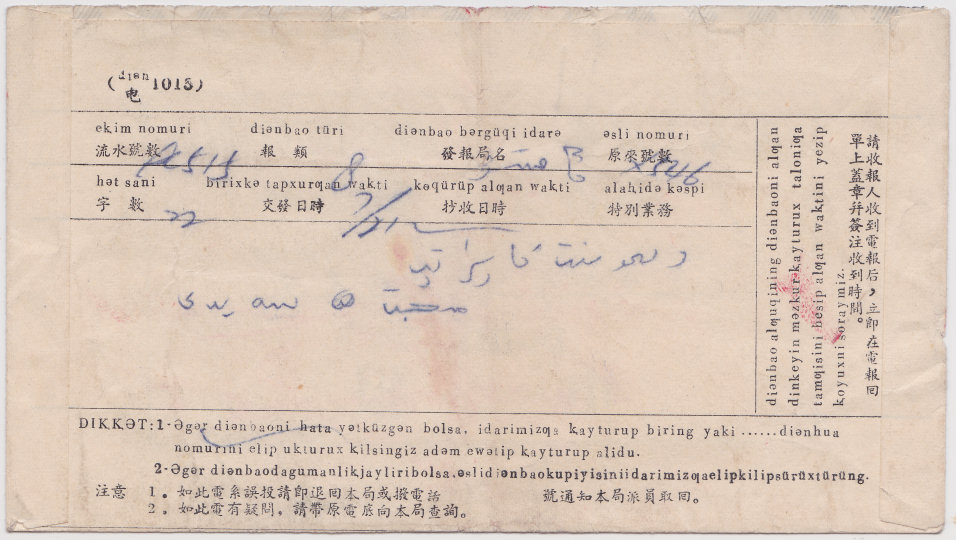
The envelope contains the enclosure below.
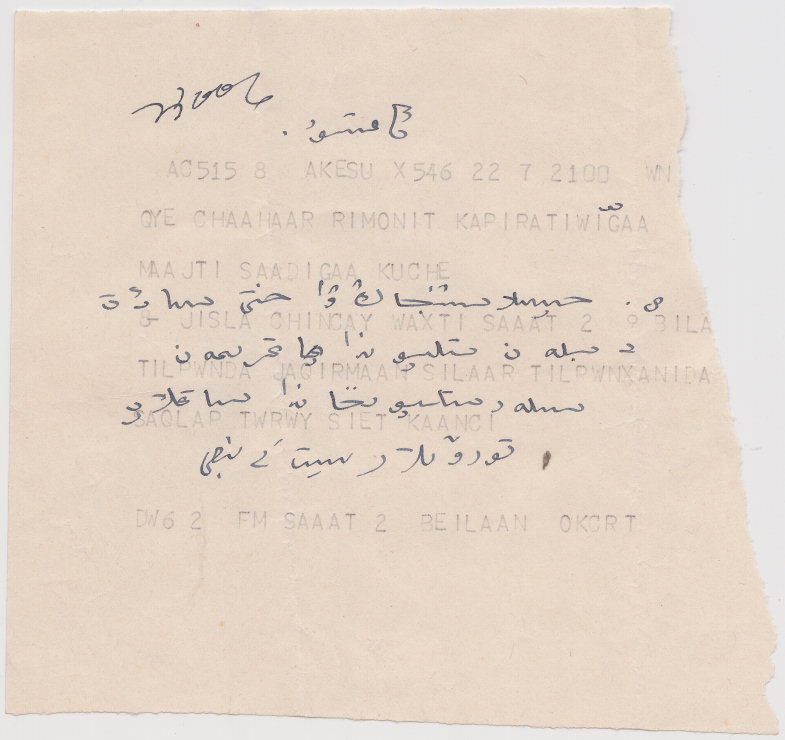
Date ? I also have this, for use in Xinjiang (新疆), Uyghur Autonomous Region.
A transparent plastic bag, open at the top. It may once have been taller.
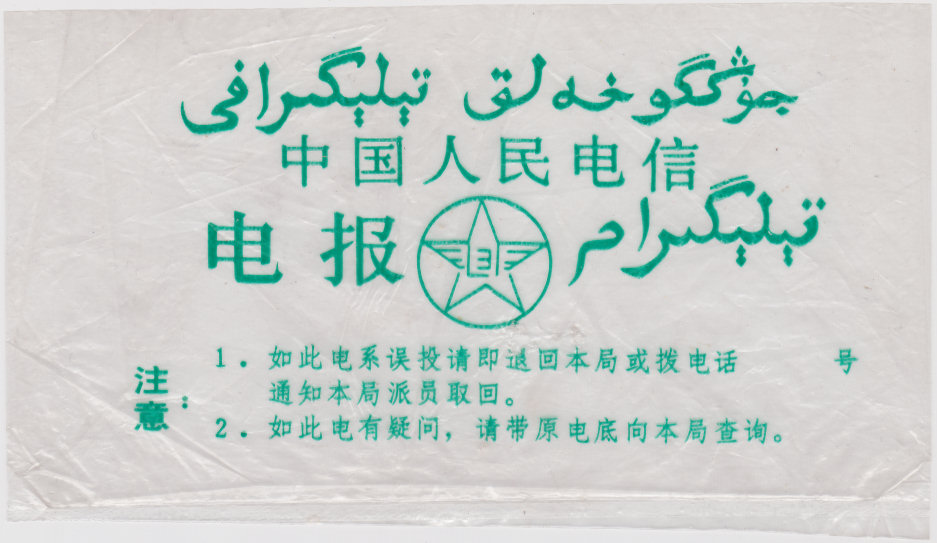
There are two notes on it, similar to some on envelopes. They read :
"1. 如此电系误投请即返回本局或拨电话
通知本局派呙取回.
2. 如此电有疑问, 请带原电底向本局查询."
Meaning :
"1. If this message has been misdirected, please return it to us or call us.
Please notify this office to send a representative to retrieve the message.
2. If you have any questions about this telegram, please bring the original telegram to our office."
To the right is "号" or "No." where a phone number could be added.
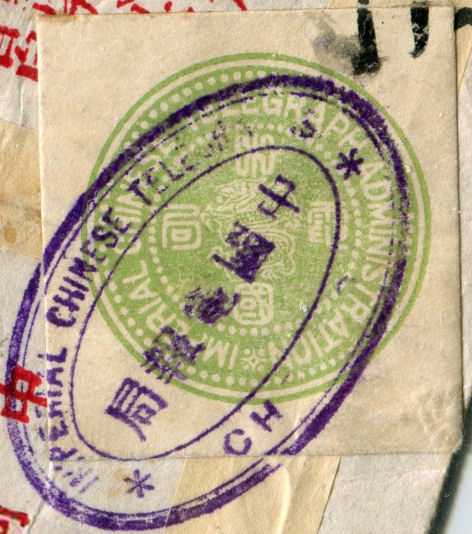
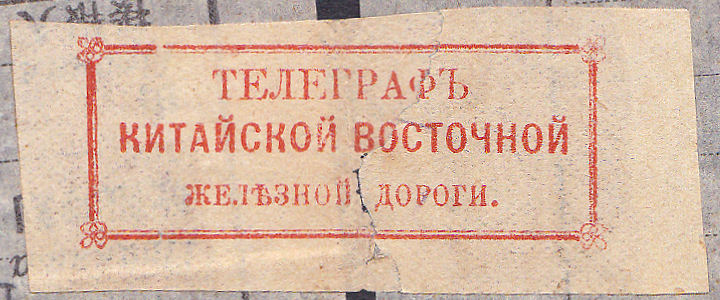
Last updated 9th. July 2024
©Copyright Steve Panting 2012 - 2024 except where stated.
Permission is hereby granted to copy material for which the copyright is owned by myself, on condition that any data is not altered and this website is given credit.